
SPRING 2022 The MIT Press
Dear Friends and Readers,
The MIT Press has deep roots in Kendall Square, from our very first offices in buildin speak for the lar e ad inistrative buildin on the corner of ain and A es streets and our ori inal bookstore near the T stop on Main Street. Kendall has beco e one of the orld s ost vital innovation hubs and the official portal to itself and this ear arks not onl our return but also our th anniversar ith our ele ant ne bookstore at ain treet and th oor offices at road a ith da lin vie s of oston and a brid e e are part of a vibrant post pande ic a akenin ie ed fro endall uare the future looks ver bri ht indeed t is therefore fittin that our prin catalo leads ith books that shed historical li ht on this o ent includin obert uderi s Where Futures Converge: Kendall Square and the Making of a Global Innovation Hub; aren eintraub and ichael uchta s Born in Cambridge: 400 Years of Ideas and Innovators; and aia einstock s bio raph of an science icon Carbon Queen: The Remarkable Life of Nanoscience Pioneer Mildred Dresselhaus
Trade 1-55
Paperback reprints 56-64
Academic Trade 65-77
Textbooks 78-94
Professional 95-115 Distributed by the MIT Press
Afterall Books 116
www.dianalevine.com

Several titles on this list are equally true to our roots and our drive to cross disciplinar boundaries and esche orthodo ies ur le ac of bold sociall en a ed publishin is re ected in books like The Most Human Right: Why Free Speech Is Everything b ric ein e; and ar llen skenderian s There’s Nothing Micro about a Billion Women: Making Finance Work for Women on ho icroloans e po er o en and pro ote sustainable inclusive econo ic ro th
And our ission to publish the best boundar def in orks is evident in ichelle rouin s ne book on the i pact of odern technolo ies on hu an touch and belon in Out of Touch: How to Survive an Intimacy Famine and ulio ttino and ruce au s The Nexus: Augmented Thinking for a Complex World on h toda s co ple proble s de and a radicall ne a of thinkin one in hich art technolo and science conver e
ead be inspired and feel free to send us th anniversar cheer at happ itp it edu
A rand h irector and ublisher he ress
Boston Review 117
Goldsmiths Press 118-120
No Place Press 121-122
Semiotext(e) 123-126 Sternberg Press 127-132
Strange Attractor Press 133-137
Terra Nova Press 138 Urbanomic 139-141
Journals 142-144
The Digital MIT Press 145
Order and Rights Representation Information 146-147
Index 148-150
Recent Highlights 151
Backlist Highlights inside back cover
The MIT Press gratefully acknowledges Books On Books (www.books-on-books.com) for sponsoring the planting of a tree through World Land Trust (www.worldlandtrust.org) in honor of each new book in the Spring 2022 catalog.
Prices subject to change.
Contents
Front Cover:
Picture postcard, Massachusetts Institute of Technology, Cambridge, Mass. Source: The Tichnor Brothers Collection, Boston Public Library. From Born in Cambridge
Amy Brand
Where Futures Converge

Kendall Square and the Making of a Global Innovation Hub
Robert Buderi
The evolution of the most innovative square mile on the planet: the endless cycles of change and reinvention that created today’s Kendall Square.
Kendall Square in Cambridge, Massachusetts, has been called “the most innovative square mile on the planet.” It’s a life science hub, hosting io en oderna fi er akeda and others t s a major tech center, with Google, Microsoft, IBM, A a on acebook and Apple all occup in bi chunks of price office space endall uare also boasts a dense concentration of startups, ith leadin venture capital fir s convenientl located nearb And of course is ust do n the block n Where Futures Converge, Robert Buderi o ers the first detailed account of the uni ue ecos ste that is endall uare chroniclin the endless c cles of change and reinvention that have driven its evolution. uderi ho hi self has orked in endall uare for the past t ent ears tells fascinatin stories of reat innovators and their innovations that stretch back t o centuries efore biotech and artificial intelli ence there as railroad car innovation the first lon distance telephone call the olaroid ca era s once secret no fa ous adiation aborator and uch ore uderi takes readers on a alkin tour of the s uare and talks to do ens of innovators entrepreneurs urban planners, historians, and others. He considers Kendall uare s li itations it s “ entrification one ro ue ” b one description ith little a ordable housin no phar ac and a scarce iddle class and its stren ths the “human collisions” that spur innovation. What’s next for Kendall Square? Buderi speculates about the next big innovative enterprises and outlines lessons for aspiring innovation districts. More important, he asks ho endall uare can be both an innovation hub and a diversit e uit and inclusion hub here s a lot of ork still to do
Robert Buderi is an author, journalist, and entrepreneur. He is the author of Engines of Tomorrow, The Invention That Changed the World, and other books, former Editor-in-Chief of Technology Review, and founder of the media company Xconomy.
history | science
May | 7 x 10, 368 pp. | 49 illus. US $34.95T/$45.95 CAN cloth 978-0-262-04651-0
Trade 1 mitpress.mit.edu | Spring 2022
Born in Cambridge
400 Years of Ideas and Innovators
Karen Weintraub and Michael Kuchta
Anne Bradstreet, W.E.B. Du Bois, gene editing, and Junior Mints: cultural icons, influential ideas, and worldchanging innovations from Cambridge, Massachusetts.
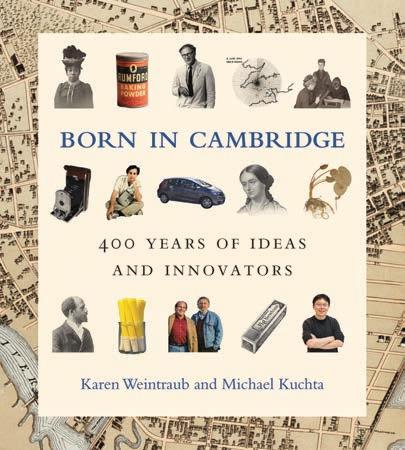
a brid e assachusetts is a cit of “firsts” the first colle e in the n lish colonies the first t o a lon distance call the first le al sa e se arria e n 1632, Anne Bradstreet, living in what is now arvard uare beca e the first published poet in British North America, and in 1959, a brid e based arter s nk arketed the first ello i liter u ois ulia hild o o a and oa ho sk all lived in Cambridge at various points in their lives. Born in Cambridge tells these stories and an others chroniclin cultural icons in uential ideas and orld chan in innovations that all ca e fro one cit of odest si e across the Charles River from Boston. More than 200 illustrations connect stories to Cambridge locations.
a brid e is fa ous for bein ho e to and arvard and these institutions pla a leadin role in an of these stories the develop ent of icro ave radar, for example, the invention of napalm, and obert o ell s poetr orkshop ut an have no academic connection, including Junior Mints, Mount Auburn e eter the first arden ce eter and the public radio show Car Talk. It’s clear that Cambridge has not onl a enius for invention but a enius for reinvention, and authors Karen Weintraub and Michael Kuchta consider larger lessons from Cambridge’s success stories—about urbanism, the roots of innovation, and nurturing the next generation of good ideas.
Karen Weintraub is a journalist, now working as health reporter at USA Today. Her work has appeared in the New York Times, the Washington Post, Scientific American, and STAT and she is the coauthor of The Autism Revolution and Fast Mind Michael Kuchta is an architect and campus planner.
history
March | 8 x 9, 416 pp. | 197 illus.
US $39.95T/$53.95 CAN cloth 978-0-262-04680-0


2 Spring 2022 | mitpress.mit.edu
Carter’s Highlighting Markers were still marketed by the Avery Dennison Company in the early twentyfirst century, though in a di erent form than in the 1960s. Photo by the authors.
The Polaroid Model 95A Land Camera, introduced in 1954 as an updated version of the original instant photography system launched in 1948. Source: Collection of the authors.
“Carbon Queen is a true delight: a powerful story, perfectly told, which is equal parts inspiring and informative. Weinstock’s words e ortlessly capture Dresselhaus’s enthusiasm, tenacity, and genius. A fitting tribute to a scientific legend.”
—Jess Wade, physicist, Imperial College London; author of Nano: The Spectacular Science of the Very (Very) Small
Carbon Queen
The Remarkable Life of Nanoscience Pioneer Mildred Dresselhaus Maia Weinstock

The life of trailblazing physicist Mildred Dresselhaus, who expanded our understanding of the physical world.
As a irl in e ork it in the s ildred “ illie” resselhaus as tau ht that there ere onl three career options open to o en secretar nurse or teacher ut sneakin into useu s purchasin three cent copies of National Geographic and devourin books on the histor of science i nited in resselhaus a passion for in uir n Carbon Queen science riter aia einstock describes ho ith curiosit and drive resselhaus defied e pectations and for ed a career as a pioneerin scientist and en ineer resselhaus ade hi hl in uen tial discoveries about the properties of carbon and other materials and helped reshape our world in countless a s fro electronics to aviation to edicine to ener he as also a trailbla er for o en in and a beloved educator, mentor, and colleague. er path asn t eas resselhaus s ron child hood was impoverished. Her graduate advisor felt educatin o en as a aste of ti e ut resselhaus persisted findin entors in obel ri e innin ph sicists osal n alo and nrico er i ventuall resselhaus beca e one of the first fe ale professors at here she ould spend nearl si decades einstock e plores the basics of resselhaus s ork in carbon nanoscience accessibl and en a in l describin ho she identified ke properties of carbon for s includin raphite buck balls nanotubes and graphene, leading to applications that ranged from li hter stron er aircraft to ore ener efficient and e ible electronics
Maia Weinstock is an editor, writer, and producer of science and children’s media whose work has appeared in Scientific American, Discover, SPACE.com, BrainPOP, and Scholastic’s Science World Deputy Editorial Director at MIT News and a lecturer at MIT on the history of women in STEM, she created LEGO’s “Women of NASA.”
biography | science
March | 5 1/4 x 8, 320 pp. | 30 color illus., 22 b&w illus. US $24.95T/$33.95 CAN cloth 978-0-262-04643-5
3 mitpress.mit.edu | Spring 2022
The Real World of College
What Higher Education Is and What It Can Be Wendy Fischman and Howard Gardner
Why higher education in the United States has lost its way, and how universities and colleges can focus sharply on their core mission.
or The Real World of College end isch an and o ard ardner anal ed in depth intervie s ith ore than students alu ni facult ad inistra tors, parents, trustees, and others, which were conducted at ten institutions ran in fro hi hl selective liberal arts colle es to less selective state schools hat the found challen ed characteri ations in the edia students are not preoccupied b political correctness free speech or even the cost of colle e he are ost concerned about their A and their resu es; the see jobs and earning potential as more important than learnin an sa the face ental health challen es fear that the don t belon and feel a deep sense of alienation iven this dail realit for students has hi her education lost its a isch an and ardner contend that US universities and colleges must focus sharpl on their core educational ission isch an and ardner both reco ni ed authorities on education and learning, argue that higher education in the United States has lost sight of its principal reason for e istin not vocational trainin not the provision of ca pus a enities but to increase hat isch an and Gardner call “higher education capital”—to help students think ell and broadl e press the selves clearl e plore ne areas and be open to possible transfor ations isch an and ardner o er co ent reco endations for ho ever colle e can beco e a co unit of learners ho are open to chan e as thinkers citi ens and hu an bein s
Wendy Fischman is a Project Director at the Harvard Graduate School of Education and lead author of Making Good: How Young People Cope with Moral Dilemmas at Work Howard Gardner is Hobbs Research Professor of Cognition and Education at the Harvard Graduate School of Education and the author of A Synthesizing Mind: A Memoir from the Creator of Multiple Intelligences Theory (MIT Press) and many other books.
education
March | 5 1/4 x 8, 400 pp. | 1 illus.
US $34.95T/$45.95 CAN cloth 978-0-262-04653-4
“In this bold and visionary book, Fischman and Gardner o er transformational solutions to the grave problems facing higher education today. The book’s compelling recommendations are supported by their definitive study of contemporary college life.”
—William Damon, Professor of Education, Stanford University and Director of the Stanford Center on Adolescence; author of The Path to Purpose
“Wendy Fischman and Howard Gardner distill decades of experience into this bracing, often surprising book about what college is, and is for. With rigor and wisdom, they burn away myths and challenge every American to recommit to truly higher learning.”
—Eric Liu, CEO, Citizen University
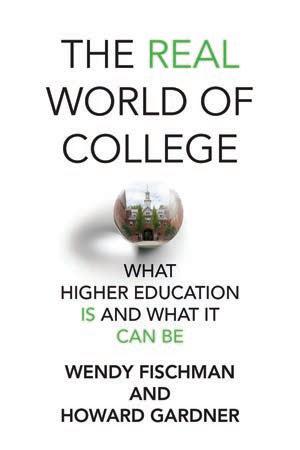
4 Spring 2022 | mitpress.mit.edu
The Nexus
Augmented Thinking for a Complex World—The New Convergence of Art, Technology, and Science Julio Mario Ottino
 with Bruce Mau
with Bruce Mau
Why today’s complex problems demand a radically new way of thinking—one in which art, technology, and science converge.
oda s co ple proble s de and a radicall ne a of thinkin one in hich art technolo and science conver e to e pand our creativit and au ent our insi ht reativit ust be co bined ith the abilit to e ecute; the innovators of the future will have to understand this balance and manage such co ple ities as cli ate chan e and pande ics he place of this convergence is the Nexus. In this provoca tive and visuall strikin book ulio ario ttino and ruce au o er a uide for navi atin the intersections of art technolo and science
The Nexus brings together word and image to prepare us individuals and or ani ations alike for the chal len es and opportunities of the t ent first centur Compelling historic examples illuminate the present, from the Renaissance, when the domains were one, to the t entieth centur ith intense collective creative outpourin s fro places as di erent as the auhaus and ell abs eaders ust be able to rasp si plicit in co ple it and co ple it in si plicit and e brace the po erful idea of co ple entarit here opposin e tre es coe ist and our thinkin e pands nnovation needs more than managing. Managers use maps; leaders develop compasses.
Julio Mario Ottino is an academic thought leader, author, artist, and internationally recognized researcher whose work has been featured in Nature, Science, and Scientifi c American. A Guggenheim Fellow, he is the founding Codirector of Northwestern University’s Institute on Complex Systems. Bruce Mau is a designer, artist, entrepreneur, author, and educator. He has designed and coauthored books with, among others, Rem Koolhaas (S,M,L,XL). For many years, he designed all of the books published by Zone Books, the Getty Research Institute, and the Gagosian Gallery.
design
| business
April | 8 x 9, 360 pp. | 120 color illus., 30 b&w illus.
US $44.95T/$59.95 CAN cloth 978-0-262-04634-3
5 mitpress.mit.edu | Spring 2022
The New Fire
War, Peace, and Democracy in the Age of AI
Ben Buchanan and Andrew Imbrie
AI is revolutionizing the world. Here’s how democracies can come out on top.
Artificial intelli ence is revolutioni in the odern orld t is ubi uitous in our ho es and offices in the present and ost certainl in the future oda e encounter AI as our distant ancestors once encountered fire f e ana e A ell it ill beco e a force for ood li htin the a to an transfor ative inventions f e deplo it thou htlessl it ill advance be ond our control f e ield it for destruction it ill fan the a es of a ne kind of ar one that holds de ocrac in the balance As A polic e perts en Buchanan and Andrew Imbrie show in The New Fire, few choices are more urgent—or more fascinating—than ho e harness this technolo and for hat purpose he ne fire has three sparks data al orith s and co putin po er hese co ponents fuel viral disin for ation ca pai ns ne hackin tools and ilitar eapons that once see ed like science fiction o autocrats A o ers the prospect of centrali ed control at ho e and as etric advanta es in co bat t is eas to assu e that de ocracies bound b ethical constraints and disjointed in their approach, will be unable to keep up ut such a d stopia is hardl preordained o binin an incisive understandin of technolo ith shre d eopolitical anal sis uchanan and brie sho ho A can ork for de ocrac ith the ri ht approach technolo need not favor t rann
Ben Buchanan is Assistant Teaching Professor at the Georgetown University School of Foreign Service, where he is also a Senior Faculty Fellow and Director of the CyberAI Project at the Center for Security and Emerging Technology. He is the author of The Hacker and the State and The Cybersecurity Dilemma Andrew Imbrie is Senior Fellow at Georgetown’s Center for Security and Emerging Technology. The author of Power on the Precipice, he served as a member of the policy planning sta and speechwriter to Secretary John Kerry at the US Department of State and as a professional sta member on the Senate Foreign Relations Committee.
political science | technology
March | 6 x 9, 344 pp. | 8 illus.
US $29.95T/$39.95 CAN cloth 978-0-262-04654-1
“
The New Fire is an essential guide to the age of artificial intelligence written by two of its leading scholars. Ben Buchanan and Andrew Imbrie help the reader understand the incredible promises and daunting perils of AI, while exploring the dramatic impact it could have on geopolitics in the decades ahead.”

—Madeleine Albright, former US Secretary of State
“The New Fire provides a brilliant, exceedingly readable examination of the impact of artificial intelligence on all imaginable endeavors from war and peace to politics. It is equal parts highly informative, wonderfully descriptive, and more than a bit terrifying!”
—General David Petraeus, US Army (Ret.), former Commander of the Surge in Iraq, US Central Command, and Coalition and US Forces in Afghanistan and former Director of the CIA
“Mixing technical depth, history, ethical philosophy, and penetrant analysis, Buchanan and Imbrie o er a comprehensive perspective on the promise and perils of machine learning and artificial intelligence.”
—Vint Cerf, Internet Pioneer
6 Spring 2022 | mitpress.mit.edu
“A fascinating book. . . . I finished it feeling more hopeful than I have felt in decades of studying the psychological impact of technology.”
—Larry D. Rosen, coauthor of The Distracted Mind: Ancient Brains in a High Tech World
“A fascinating book that examines how modern technology can assist in our pursuit to meet human needs for love, connection, and fulfillment. Weaving personal anecdotes with scientific research, it is full of rich wisdom for how to survive and thrive in a world of advancing technologies and a pandemic.”
—Susan Sprecher, Distinguished Professor, Illinois State University
Out of Touch
How to Survive an Intimacy Famine Michelle Drouin

A behavioral scientist explores love, belongingness, and fulfillment, focusing on how modern technology can both help and hinder our need to connect.
Millions of people around the world are not getting the ph sical e otional and intellectual inti ac the crave hrou h the onders of odern technolo e are connecting with more people more often than ever before; but are these connections what we long for? Pandemic isolation has made us even more alone. In Out of Touch rofessor of s cholo ichelle rouin investi ates hat she calls our inti ac fa ine e plorin love belon in ness and fulfill ent and considerin h relationships carried out on technolo ical platfor s a leave us starvin for ph sical connection rouin puts it this a hen ost of our interactions are throu h social edia e are takin tin hits of dopa ine rather than the hu e shots of o tocin that an inti ate in person relationship ould provide rouin e plains that inti ac is not ust se althou h of course se is an i portant part of inti ac ut ho i portant rouin reports on surve s that illennials perhaps distracted b constant inder s ipin have less se than previous enerations he discusses pandemic puppies, professional cuddlers, the i portance of touch “desire discrepanc ” in arria e and the value of friendships nline datin she su ests i ht ive users too an options; and the internet facilitates “infidelit related behaviors ” o e techno logical developments will help us develop and maintain intimate relationships—our phones, for example, can be bridges to emotional support. Some, on the other hand, i ht leave us out of touch rouin e plores both of these possibilities.
Michelle Drouin is a behavioral scientist and expert on technology, relationships, couples, and sexuality whose work has been featured or cited in the New York Times, CBS News, CNN, NPR, and other media outlets. She is Professor of Psychology at Purdue University–Fort Wayne and Senior Research Scientist at the Parkview Mirro Center for Research and Innovation.
psychology
February | 5 1/4 x 8, 288 pp. | 4 illus.
US $27.95T/$36.95 CAN cloth 978-0-262-04667-1
7 mitpress.mit.edu | Spring 2022
The Most Human Right Why Free Speech Is Everything
 Eric Heinze
Eric Heinze
A bold, groundbreaking argument by a worldrenowned expert that unless we treat free speech as the fundamental human right, there can be no others.
hat are hu an ri hts Are the laid out definitivel in the s niversal eclaration of u an i hts or the ill of i hts Are the ite s on a checklist di nit ustice pro ress standard of livin health care, housing? In The Most Human Right ric ein e e plains h lobal hu an ri hts s ste s have failed nternational or ani ations constantl report on how governments manage human goods, such as fair trials, humane conditions of detention, healthcare, or housing. But to appease autocratic regimes, experts have i nored the pri ac of free speech ein e ar ues that oods beco e ri hts onl hen citi ens can clai the publicl and fearlessl free speech is the funda ental ri ht ithout hich the ver concept of a “ri ht” akes no sense.
ein e ar ues that throu hout histor countless s ste s of ustice have pro ised hu an oods hat then akes hu an ri hts di erent hat ust hu an ri hts have that other s ste s have lacked ein e revisits the origins of the concept, exploring what it means for a nation to protect human rights, and what a citi en needs in order to pursue the e e plains ho free speech distinguishes human rights from other ideas about justice, past and present.
Eric Heinze is Professor of Law and Humanities in the University of London and an internationally recognized authority on free speech and human rights. He is the author of Hate Speech and Democratic Citizenship, The Concept of Injustice, and other books. He is a frequent guest speaker on radio, television, and online, and his opinion pieces have appeared in the Guardian, the Washington Post, and many other publications.
political science
April | 6 x 9, 200 pp. | 2 illus.
US $27.95T/$36.95 CAN cloth 978-0-262-04645-9
8 Spring 2022 | mitpress.mit.edu
There’s Nothing Micro about a Billion Women
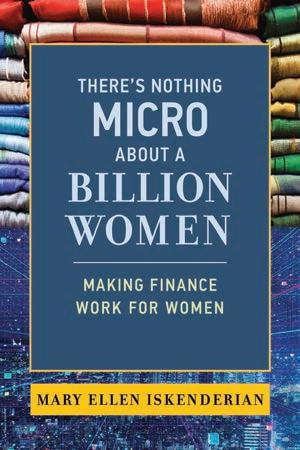
Making Finance Work for Women
Mary Ellen Iskenderian
Why it takes more than microloans to empower women and promote sustainable, inclusive economic growth.
earl one billion o en have been co pletel e cluded fro the for al financial s ste ithout even a bank account in their o n na es the lack the basic services ost of us take for ranted secure a s to save one pa bills and et credit clusion fro the for al financial s ste eans the are econo ic outsiders unable to benefit fro or contribute to econo ic ro th icrofinance has been hailed as an economic lifeline for women in developing countries— but as ar llen skenderian sho s in this book it takes ore than icroloans to e po er o en and promote sustainable, inclusive economic growth. skenderian ho leads a nonprofit that orks to ive o en access to the financial s ste ar ues that the bankin industr should vie these one billion “unbanked” o en not as charit cases but as a business opportunit a lucrative ne arket of s all business o ners heads of households and purchasers of financial products and services skenderian sho s ho financial inclusion can be transformative for the lives of women in developing countries, describing, among other things, the infor al one lenders and savin s clubs o en have relied on the need for both financial and di ital literac and access as obile phones beco e a eans of bankin and the i portance of o en s propert ri hts he oes on to ake the business case for financial inclusion e plorin the a s that financial institutions are adapting to help women build wealth, access capital, and ana e risks anks can do the ri ht thin and ake one hile doin so and all of us can benefit
Mary Ellen Iskenderian is President and CEO of Women’s World
Banking, a global nonprofit devoted to giving more low-income women access to financial tools and resources they need for both security and prosperity.
business | economics
March | 6 x 9, 232 pp.
US $29.95T/$39.95 CAN cloth 978-0-262-04644-2
9 mitpress.mit.edu | Spring 2022
Power On!
Jean

 J. Ryoo
J. Ryoo
and
 Jane Margolis illustrated by Charis JB
Jane Margolis illustrated by Charis JB


A diverse group of teenage friends learn how computing can be personally and politically empowering and why all students need access to computer science education.
his livel raphic novel follo s a diverse roup of teena e friends as the discover that co putin can be fun creative and e po erin a lor hristine Antonio and on see like t pical oun teens the co unicate via endless te tin the share okes the orr about startin hi h school and the have each other s backs ut hen a raciall biased artificial intelli ence s ste causes har in their nei hborhood the suddenl reali e that tech isn t as neutral as the thou ht it as ut can an al orith be racist And hat is an al orith an a n school the decide to e plore co putin classes ith i ed results ne class is onl about t pin he class that Christine wants to join is full, and the school counselor su ests that she take a class in “ ouris and ospitalit ” instead eall ut Antonio s class see s le it hristine finds an after school pro ra and the decide to teach the others hat the learn su er vacation, all four have discovered that computing is both personall and politicall e po erin
Interspersed through the narrative are text boxes with computer science explainers and inspirational profiles of people of color and o en in the field includin atherine ohnson of Hidden Figures fa e Power On! is an essential read for oun adults eneral readers educators and an one interested in the po er of computing, how computing can do good or cause har and h addressin underrepresentation in co putin needs to be a top priorit
young adult fiction | graphic novels






April | 6 3/4 x 10, 144 pp.
US $19.95T/$25.95 CAN paper 978-0-262-54325-5
Jean J. Ryoo (she/her) is an avid reader of manga and manhwa, as well as an educational researcher/writer committed to ensuring all students experience meaningful and empowering learning, both in and out of school. Jane Margolis is a UCLA educational researcher and author who has been a longtime advocate for ending inequality and segregation in computer science education, for which she won the 2016 White House Champion of Change award. Charis JB (she/her) is a Black-biracial Latinx artist whose work often centers around issues related to race and gender equality, sexual identity, class, and more.
10 Spring 2022 | mitpress.mit.edu

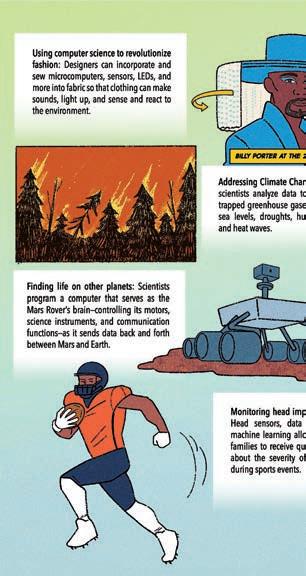






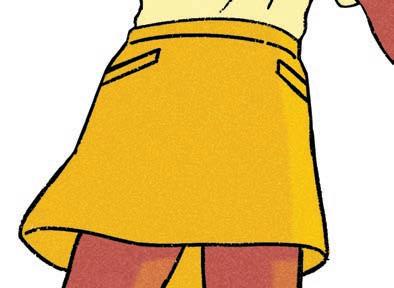





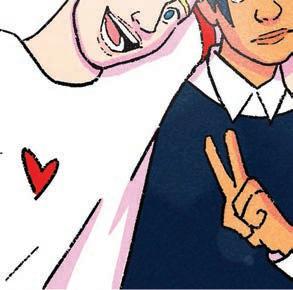




90 91
The Intermittent Fasting Revolution
The Science of Optimizing Health and Enhancing Performance
Mark P. Mattson
How intermittent fasting can enhance resilience, improve mental and physical performance, and protect against aging and disease.
ost of us eat three eals a da ith a s atterin of snacks because e think that s the nor al health a to eat his book sho s h that s not the case he hu an bod and brain evolved to function ell in envi ron ents here food could be obtained onl inter it tentl hen e look at the eatin patterns of our distant ancestors, we can see that an intermittent fasting eating pattern is nor al and eatin three eals a da is not In The Intermittent Fasting Revolution, prominent neurosci entist ark attson sho s that inter ittent fastin is not onl nor al but also ood for us; it can enhance our abilit to cope ith stress b akin cells ore resilient t also i proves ental and ph sical perfor ance and protects against aging and disease.
Intermittent fasting is not the latest fad diet; it doesn’t dictate food choice or uantit t doesn t ake one for the pharmaceutical, processed food, or health care industries. Intermittent fasting is an eating pattern that includes frequent periods of time with little or negligible a ounts of food t is often acco panied b ei ht loss but attson sa s studies sho that its re arkable beneficial e ects cannot be accounted for b ei ht loss alone.
Mattson—whose pioneering research uncovered the a s that the brain responds to fastin and exercise—explains how thriving while fasting became an evolutionar adaptation e describes the specific a s that inter ittent fastin slo s a in ; reduces the risk of diseases includin obesit Al hei er s and diabetes; and i proves both brain and bod perfor ance e also o ers practical advice on adoptin an inter ittent fasting eating pattern as well as information for parents and ph sicians
Mark P. Mattson, currently Adjunct Professor of Neuroscience at Johns Hopkins University, was previously Chief of the Laboratory of Neurosciences at the National Institute on Aging in Baltimore.
health and fitness
February | 5 1/4 x 8, 248 pp. | 20 illus.
US $27.95T/$36.95 CAN cloth 978-0-262-04640-4
“An excellent book, full of very valuable information to improve health and longevity from one of the pioneers and leaders of the ‘intermittent fasting revolution.’”
—Valter D. Longo, Director of the University of Southern California Longevity Institute, author of the international bestseller The Longevity Diet
“This timely book, which includes both historical antecedents as well as the very latest research, is an authoritative and yet accessible introduction to intermittent fasting. Dr. Mattson has done more than any other scientist to illuminate this critically important topic and we are fortunate to have this succinct synopsis of decades of research.”
—Ken Ford, Founder and Director, Institute for Human and Machine Cognition
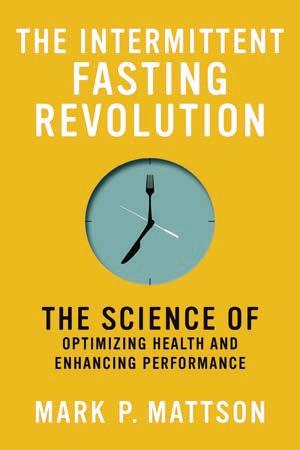
12 Spring 2022 | mitpress.mit.edu
The Parent Trap
How to Stop Overloading Parents and Fix Our Inequality Crisis
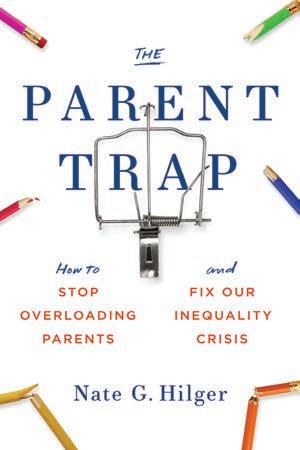 Nate G. Hilger
Nate G. Hilger
How parents have been set up to fail, and why helping them succeed is the key to achieving a fair and prosperous society.
e people reali e that raisin children is the sin le lar est industr in the nited tates et this vital ork receives little political support and its pri ar orkers parents labor in isolation f the ask for help the are ade to feel inade uate; there is no centrali ed or ani ation to represent their interests; and there is virtuall nothin spent on research and development to help them achieve their goals. It’s almost as if parents are set up to fail—and the result is lost opportunities that li it children s success and ake us all orse o n The Parent Trap, Nate Hilger combines cuttin ed e social science research revealin historical case studies and on the round investi ation to recast parentin as the hidden crucible of ine ualit arents are e pected not onl to care for their children but to help the develop the skills the ill need to thrive in toda s socioecono ic realit but most parents, including even the most caring parents on the planet are not trained in skill develop ent and lack the resources to et help o do e fi this he solution il er ar ues is to ask less of parents not more. America should consider child development a public invest ent ith a onu ental pa o e need pro ra s inspired b edicare call the a il care to drive this invest ent o ake it happen parents need to become an interest group that can wield its political po er on behalf of children ho ill al a s be the largest bloc of disenfranchised people in this countr
The Parent Trap e poses the true costs of our societ s unrealistic e pectations around parentin and la s out a profoundl hopeful blueprint for refor
Nate G. Hilger is an economist and data scientist in Silicon Valley. His work on the origins of success in children has been featured in the New York Times, the Washington Post, and other media outlets.
current affairs | politics
April | 6 x 9, 304 pp. | 8 illus.
US $29.95T/$39.95 CAN cloth 978-0-262-04668-8
13 mitpress.mit.edu | Spring 2022
Atlas of Perfumed Botany


Jean-Claude Ellena illustrated by Karin Doering-Froger translated by Erik Butler
A cartography of fragrance that charts the botany and geography of perfume composition.

or perfu e akers each s ell carries ith it a multitude of associations and impressions that ust be carefull anal ed and understood before the sum of all its parts emerges. All perfumers have their o n idios ncratic ethods dra n fro their individual olfactor e periences for classif in fragrances. In Atlas of Perfumed Botany, virtuoso perfu er ean laude llena leads readers on a poetic eo raphic and botanical ourne of perfu e discover llena o ers a varied and fascinatin carto raph of fra rances tracin historical connections and cultural e chan es ull pa e entries on plants ranging from bergamot to lavender are acco panied b detailed and vivid full color botanical illustrations.
Jean-Claude Ellena, the “nose” of the luxury brand Hermès for fourteen years, has been the Creative Director of Fragrance at the perfume house Le Couvent since 2019. Karin Doering-Froger, a faculty member at the Atelier de Sèvres, has illustrated many novels and travel guides, including Atlas de cités perdues and Atlas de contrées rêvées
nature
April | 7 x 9 1/2, 168 pp. | 36 illus.
US $29.95T/$39.95 CAN cloth 978-0-262-04673-2
14 Spring 2022 | mitpress.mit.edu
Illustrations by Karin Doering-Froger from Atlas of Perfumed Botany
Sexus Animalis
There Is Nothing Unnatural in Nature
Emmanuelle Pouydebat illustrated by Julie Terrazzoni translated by Erik Butler
An illustrated guide to the amazingly multifarious sex lives of animals, from elephants and bonobos to butterflies and bedbugs.

here a be nothin unnatural in nature but nature still encompasses much that seems fantasti call stran e the a a in l ultifarious se lives of animals, for example. Sexus Animalis tells us ever thin e never drea ed e anted to kno about the reproductive s ste s enital or ans and se ual practices of ani als fro elephants ho asturbate ith their trunks to fruit ies ho produce sper ato oa t ent ti es their si e n the ani al kin do e find heterose ual lesbian a and bise ual behavior as ell as ono a pol a and pol andr not to ention fellatio and an varieties of erections and orgasms. anuelle ou debat a natural histor researcher tells us about gutter penises, double penises, detachable penises and corkscre shaped penises as ell as va inas built for stora e and clitorises ith thorns erhaps unsurprisin l there s ore data about ani al penises than ani al va inas and clitorises he e plains ho the ostrich achieves an erection, describes the courtship of p cha eleons and recounts ho the fe ale short beaked echidna chooses a partner he reports on sexual assault among animals—there’s evidence that half of fe ale allards are se uall assaulted and e plains ho asturbation helps s uirrels avoid se uall transmitted diseases. It seems that animals have been composing their own Kama Sutra throughout the ages. trikin color illustrations acco pan the te t
Emmanuelle Pouydebat is a permanent researcher employed by the CNRS (French National Center for Scientific Research), working at the Muséum National d’Histoire Naturelle in Paris. She is the author of Atlas of Poetic Zoology (MIT Press).
nature | science
March | 7 x 9 1/2, 184 pp. | 65 color illus., 14 b&w illus.
US $29.95T/$39.95 CAN cloth 978-0-262-04658-9
Illustrations by Julie Terrazzoni from Sexus Animalis © CNRS - Délégation Paris-Centre




15 mitpress.mit.edu | Spring 2022
Rewilding










The Radical New Science of Ecological Recovery The Illustrated Edition

 Paul Jepson and Cain Blythe
Paul Jepson and Cain Blythe
How rewilding has transformed the conservation movement, combining radical scientific insights with practical innovations.
Progressive scientists and conservation professionals are pursuin a radical ne approach to restorin ecos ste s re ildin recoverin the ripple e ect enerated b the interactions a on plant and ani al species and natural disturbances re ildin seeks to repair ecos ste s b re ovin the fro hu an en ineerin and reassembling guilds of megafauna from a mix of surviving wild and feral species and de do esticated breeds includin elk bison and feral horses ritten b t o leaders in the field this book o ers an abundantl illustrated guide to the science of rewilding. It shows in fascinatin detail the a s in hich ecolo ists are reasse blin ecos ste s that allo natural interactions rather than human interventions to steer their environmental trajectories. e ildin looks into a past in hich industriali ation and lobali ation do n raded grasslands, describes current projects designed to recover self illed ecos ste s and envisions the future with ten predictions for a rewilded planet t sho s ho re ildin is shakin up conservation science and polic brin in ne hope and rene ed purpose to e orts to revive essential ecological processes. Color illustrations capture o ents of beaut in nature and o er enli htenin info raphics and visuali ations

Paul Jepson is Nature Recovery Lead with Ecosulis Ltd. and former director of the University of Oxford’s MSc in Biodiversity, Conservation, and Management. During a forty-year career in conservation, he has worked in the UK, Brazil, and countries in Asia. Cain Blythe, Managing Director of Ecosulis Ltd., specializes in habitat restoration, particularly through the adoption of natural regeneration techniques, nature recovery, and the use of technology in conservation.
science | nature
April | 6 1/2 x 9, 224 pp. | 110 color illus.







US $29.95T/$39.95 CAN cloth 978-0-262-04676-3
For sale in North America only
The

including the northern Rockies. ark ecologists gradually started to recognize that this absence was having detrimental impacts on the ecosystem. In particular, elk grazing was causing the decline of upland aspen woodlands and riverine co onwoods, and in the absence of wolves increased coyote populations resulted in intensive predation on smaller species. Back in the 1940s, Aldo Leopold, the doyen of US conservation, had proposed reintroducing wolves to Yellowstone, but the park ecologists not only presented a clear scientific rationale for not doing so they were actually involved in the extermination of the wolves on the grounds that they wished to protect more desirable species such elk and deer.
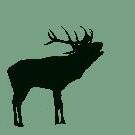
A second major driver for reintroducing wolves was the 19 Endangered Species Act. This created a federal mandate to recover populations to a level where the grey wolf could be removed from the protected species list. The northern Rockies were identified as an area for recovery and the US Fish and Wildlife Service (USFW) appointed ountain Wolf Recovery team to develop a plan. There then followed twenty years of scientific and ecological impact studies, as well as a good deal of legal wrangling, before the first 66 wolves were released 1995.

Social surveys showed that a majority of people, both in urban and rural areas, were in favour of reintroduction, with visitors to Yellowstone being particularly supportive. However, ranchers were vehemently against the idea, arguing that they would not be properly compensated for lost livestock, and mounted legal challenges. To overcome some of the resistance, the USFW decided to introduce a different sub-species of wolf to that which had been extirpated years earlier. In so doing, they were able to class the reintroduction as nonessential experiment, which allowed much more exibility in the approaches they could take to manage potential con icts with livestock farmers.
between predators and prey) affects the complexity and structure of the ecological system, and the ecosystem processes (e.g. decomposition and nutrient cycling) that arise from chemical, physical, and biological interactions between the living and non-living components of the environment.





Three American ecologists, Nelson Hairston, Frederick E. Smith, and Lawrence B. Slobodkin, introduced the theory in the 1960s, but the growing number of rewilding projects is prompting scientists to extend the theory. The term ‘trophic’ refers to nutritional (food) resources, and the concept has traditionally been expressed as series of levels with predators at the top, then herbivores, followed by primary producers (such as plants). Whereas ‘cascade’ implies (and initially referred to) top-down effects, it now refers to effects that cascade through networks in multiple directions. By way of example, the reintroduction of wolves to Yellowstone described in Chapter 4 is a classic case of a top-down trophic cascade. However, when we consider a large herbivore such as the bison, the relationship between trophic layers becomes more intertwined and extends into complex network of trophic interactions.
Jens-Christian Svenning, who heads the Centre for Biodiversity Dynamics in Changing World at Aarhus University
in Denmark, is leading contributor to trophic cascade theory and its application to rewilding. In key 2016 paper entitled ‘Science for a wilder Anthropocene: Synthesis and future directions for trophic rewilding research,’ Svenning and colleagues broke from the tradition of viewing only carnivores as apex consumers. Although large carnivores sit above large herbivores (which they eat) in classic trophic hierarchies, the team noted that mega-herbivores are at the apex of complex cascading effects via food consumption (grazing) and production (in their dung and bodies), and some herbivores (e.g. elephant, rhino) are only weakly affected by top-down predation. This insight was key theme of Shaun Carroll’s book and award-winning film The Serengeti Rules By complicating the traditional pyramidal representation of trophic hierarchy, scientists have given form to the idea of interacting trophic webs with functional species creating cascading effects in different directions through the networks.


16 Spring 2022 | mitpress.mit.edu
Rewilding’s practical origins 84 Chapter Wolf reintroductions in the Yellowstone ecosystem Yellowstone wolf National ark, rewilded wolf packs killed and displaced coyotes, allowing red foxes to recover, and it was increase in elk kills range of scavengers including gri ly bear, cougar, wolverine, Yellowstone is famously the world’s first national park (established in 1 2) and its spectacular geysers, scenery, and wildlife have made it a major recreational destination. During the 19 0s and 0s, ecological science gained in uence in government conservation institutions, and the focus of US conservation expanded from individual species to managing the wider ecosystem. This created the impetus for reater Yellowstone Ecosystem with the national park at its core, containing habitat su cient to support the population range of species such as the grizzly bear. At this time, however, wolves were absent from the park, having been ‘cleaned out’ across vast swathes of North America by the mid-1900s,
reintroduction of wolves into the ellowstone ecosystem was a key inspiration
merican conservationists
coined
term rewilding
the cores, corridors,
carnivores strapline
ached
continental-scale
owever,
ect
radical
actions
applied scientists
bureaucratic institutions
scienti
nature
ellowstone
nest examples
reintroducing carnivores
return degraded habitats
healthy
functioning
Rewilding’s practical origins 869 Chapter The significance of the Yellowstone wolf introductions The reintroductions played a seminal role in the emergence of rewilding as a new conservation agenda. They were key inspiration for Dave Foreman’s vision for rewilding North America and also for a continental wildlands project proposed in the late 1990s by ichael Soul John Terborgh, and Reed Noss, three founders of the in uential discipline of conservation biology. Their rewilding agenda was founded on three scientific premises:
for the
who
the
and
and
they a
to their
rewilding agenda.
in contrast to the previous examples, this pro
originated not from the
ideas and
of
but from within the
of
c
management.
is now cited as one of the
of how
can help
to a
and
ecosystem.
1 The evidence of top-down regulation of ecosystems by predators such as wolves. 2 The theory of island biogeography, which demonstrated a relationship between the size of an island and the number of species. As we saw earlier, this theory predicts that as natural ecosystems become islands in a sea of cultivation the number of species will fall to a lower e uilibrium, causing local extinctions. 3 Connecting natural areas through corridors will help overcome such island effects and create the space for wide-ranging predator populations. ore specifically, the Yellowstone renewed scientifi interest in the role of apex predators and top-down cascades through food webs in the assembly and functioning of ecosystems (more in Chapter 6) highlighted the complex biological, social, and political challenges associated with predator reintroductions positioned the wolf, species with deep and con icting cultural connotations, as symbol of rewilding, thereby making it political aligned rewilding with wilderness concepts and the aspiration of recovery of ecosystems to state where they would look a er themselves. wolves released Yellowstone wolf population of Elk numbers decrease and grazing patterns change avoid dense cover to lower ris of ambush and open areas where they can be run down by predators hange in el gra ing patterns leads to recovery of aspen, willow, and cottonwood trees eleased from gra ing, riverside willows grow taller, which in turn leads to recovery of aquati ecosystems This then supports the resurgence of beavers, which had also become extinct in the region 300 66 Yellowstone trophic cascade By the population of wolves in and the beneficial impacts on the ecosystem were clear for all to see. Rewilding’s practical origins 9411 Chapter Trophic cascade THEORY Trophic cascade theory has emerged as one of the key conceptual resources in rewilding science. The theory seeks to understand interactions between organisms through the lens of food chains. It investigates how the presence or absence of interactions (for example,
YELLOWSTONE TROPHIC CASCADE
Beavers build dams, lodges, and channels to create a watery environment full of willows and aquatic plants for them to feed on They gnaw and fell engineering projects This produces complex and dynamic wetland and river systems The diverse plants capture sunlight and draw up nutrients, which support and cascade through an ecological web of fish, amphibians, birds, insects, and other life The wetland systems that beavers engineer lead to the recovery of ecological processes such as filtration and water management This produces valuable services to human society water quality and natural flood management NATURA L STIFENE AMUH N B NEFTS Functional species that produce significant cascade effects through modifying habitats are termed North America, is the beaver. Beavers are able to transform ditches running through agricultural mammals, which also have benefits to human society (blue arrows). In Europe, generating value for something of an ‘ambassador’ species for rewilding. ECOSYSTEM ENGINEERS
Star Power
ITER and the International Quest for Fusion Energy Alain Bécoulet

translated by Erik Butler foreword by Dennis G. Whyte
A concise and accessible explanation of the science and technology behind the domestication of nuclear fusion energy.
“This book is a welcome overview of the role of hydrogen fusion in our transition to a zero-carbon emission world. Making this topic accessible to all is no small feat, but Alain Becoulet has done just that!”
—Bernard
Bigot, DirectorGeneral, ITER
Organization
Nuclear fusion research tells us that the Sun uses one ra of h dro en to ake as uch ener as can be obtained b burnin ei ht tons of petroleu f nuclear fusion the process that akes the stars shine could be do esticated for co ercial ener production the orld ould ain an ine haustible source of ener that neither depletes natural resources nor produces green house gases. In Star Power Alan coulet o ers a concise and accessible pri er on fusion ener e plainin the science and technolo of nuclear fusion and describin the assive international scientific e ort to achieve co erciall viable fusion ener coulet dra s on his ork as ead of n ineerin at nternational her onuclear peri ental eactor to e plain ho scientists are tr in to “put the sun in a bo ” e surve s the histor of nuclear po er be innin ith post orld ar e orts to use ato s for peaceful purposes and describes ho ener is derived from fusion, explaining that the essential principle of fusion is based on the capacit of nucleons protons and neutrons to asse ble and for structures ato ic nuclei in spite of electrical repulsion bet een protons, which all have a positive charge. He traces the evolution of fusion research and development, mapping the generation of electric current though fusion.
he pro ect arks a iant step in the develop ent of fusion ener ith the potential to de onstrate the feasibilit of a nuclear fusion reactor Star Power o ers an introduction to hat a be the future of ener production.
Alain Bécoulet is Head of Engineering for ITER, an international nuclear fusion research and engineering demonstration project in France. Previously, he was Director of the French Magnetic Fusion Research Institute.
science | physics
February | 5 1/4 x 8, 216 pp. | 10 illus.
US $28.95T/$38.95 CAN cloth 978-0-262-04626-8
17 mitpress.mit.edu | Spring 2022
Astroquizzical
Solving the Cosmic Puzzles of Our Planets, Stars, and Galaxies
The Illustrated Edition
Jillian Scudder
Exploring the family tree of the cosmos, from humans on Earth to stars and galaxies to the first atoms of the Big Bang; with striking color illustrations.
ookin up at the ni ht sk e see not onl stars t inklin in their constellations and planets cau ht id orbit but our cos ic fa il tree e are here on arth because billions of ears a o the Big Bang created the atoms that, over unimaginable periods of time, formed the stars and galaxies. Generations of stars that burned, exploded, or collided long before our planet was formed created the carbon of our bodies and the iron in our blood. In Astroquizzical astroph sicist illian cudder takes readers on a curiosit driven ourne throu h outer space travelin back in ti e fro arth to the stars and galaxies to the cosmic explosions of the Big Bang.
cudder proceeds astro ui icall ues tion b uestion ans erin and e plainin such ueries as “ hat color is the universe ” “ o all planets spin the sa e a ” and “ o an ala ies are there ” Alon the a she proposes a series of thought experiments, including “What would happen if we split the sun in half?” and “What happens to time dilation at the speed of light?” She covers meteors, the aurora, and the oon arth s cos ic co panion ; upiter s stripes and Pluto’s mountains; red dwarfs, brown dwarfs, and white dwarfs; the deaths of stars and the abundance of galaxies; and much more. trikin color i a es illustrate astroph sical marvels.
Jillian Scudder, an astrophysicist, is Assistant Professor of Physics at Oberlin College. Her writing on science has appeared in Forbes Medium The Conversation, the Independent, and Quartz

science

February | 7 1/2 x 9 3/4, 224 pp. | 100 illus.
US $29.95T/$39.95 CAN cloth 978-0-262-04672-5

For sale in North America only
ASTROQUIZZICAL
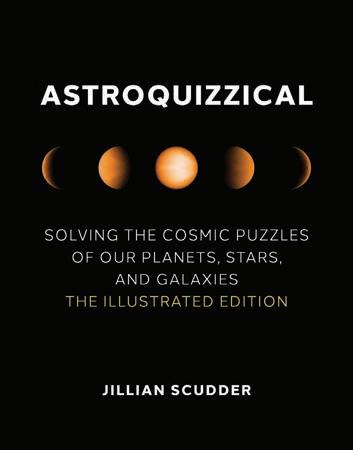
INTRODUCTION TIMELINE





astroquizzical adj expressing curiosity in the astrophysical wonders of the universe It often said by astrophysicists that every one of us should feel strong connection to the stars. Without generations of stars that burned, exploded, or collided before our planet was formed, the carbon that our bodies are made of, the iron in our blood, and the gold and silver of our precious objects would simply not exist. In a very tangible way, those stars made possible for us to be here to look at them. Without them, we could not possibly have evolved on our watery world. But truly exploring how we are linked to them—and how they have led to our own lives on planet Earth—can be an arduous task, even for the curious-minded among us. While there are many ties between us and the stars, such information is often forgotten or hard to nd. This book explores the ties that link us not just to the stars, but to the universe as whole —our cosmic family. Without our parent planet to call home, we would not exist. Without a star, the Sun, our planet would not exist. Without a galaxy, our star would not exist. And without the lamentary nature of structure in the earliest universe, our galaxy would not exist. Each of them paved the way for another generation—building up the groundwork for Welcome to your cosmic family tree! You are living, in company with almost every other human, on the surface of the planet Earth, the only planet in the vast universe known to host intelligent life of any kind. And you are doing so because billions of years ago the Big Bang created the atoms that over unimaginable periods of time formed the stars and galaxies that you can still see from your home. In this book we will use this family tree structure to travel out into space and at the same time back in time through the cosmic generations, from our Earth (parent) and its sibling planets to the Sun and stars (grandparents), the Milky Way and other galaxies (great grandparents) and on to the very creation of our universe (great-great grandparents). This will help us to discover our unique place in the cosmos, and to understand little more of what it really means to stare up into the night sky and gaze at the stars.
This journey will also encourage you to be more ‘astroquizzical,’ by asking questions of our universe and its ancient stars, conducting ‘thought experiments’ that explore the workings of our planet and its distant relatives, and seeking answers to the many mysteries of space from the clues we can discover on a trail that leads to the very beginning of time.
WHAT COLOR IS THE UNIVERSE?

The human eye has an unusual sensitivity pattern to light. We’re pretty good at seeing things in the yellow-green range, but once you get into reds and blues our eye suddenly gets extremely bad at registering deep reds and dark purples, and our brain translates those colors into ‘black’ or, more accurately, as ‘there is no light here that can deal with’. To anything outside the range of visible light, we are completely blind. This odd sensitivity pattern means that it’s quite dif cult to make a camera with exactly the same sensitivity as our eye. If you want to make color picture from an image coming from space telescope, there an additional challenge to overcome. All the cameras attached to telescopes are just photon counters (the photon is the smallest quantity of light—one individual packet or particle). If photon makes through the telescope and into the camera, it adds to the number of photons that arrive from that patch of the sky. This means that the only images you can make are intensity maps—black and white images. For scienti purposes, astronomers are generally more interested in measuring the amount of very speci color slices of light that arrive at the telescope. In order to limit the kind of light that actually makes to the telescope’s camera, lters are usually put in front of it. The lter works in the same way as red-blue 3D glasses and images: the red lens lets through only the red light, and the blue lens lets through only the blue, so each eye gets different picture, and your brain reconstructs the depth of the image.

An astronomical lter is usually constructed to let in light from very speci physical process—for instance, the color of light that hydrogen produces when is in a very hot environment. Hydrogen here creates deep-pink color, so instead of red or blue lter we’d have deep-pink one. This would let in only light that is produced by that hydrogen, and we can map the locations of that gas on the sky. This image is still entirely in black and white, but it is the astronomer’s map to untangling what’s happening in that part of the sky.
ARE ‘FALSE-COLOR’ IMAGES FALSE? To reconstruct colorful image out of this black and white one is no simple task. Given that we’re detecting light at much better sensitivities than the human eye, and that we’re usually doing in discrete chunks instead of one (very complex) curve as the eye does, putting these chunks of light back into a single image tricky business. Even when all the light taken from the narrow range that we can see, must still be reconstructed and tweaked to re ect the brilliance of the colors we’ve observed. While the general term for this style of image is ‘false color’, the colors here aren’t actually ‘false’. The deep-pink glow of hydrogen will remain deep pink, and the glow of oxygen, brilliant aqua, will stay that color.





CAN WE SEE MORE STARS FROM JUPITER? THOUGHT EXPERIMENT: 01



The combination of having lot more material than the Earth, and being much less densely packed, means that Jupiter takes up a lot more physical space than the Earth does. In terms of volume, Jupiter is more than 1,300 times larger. Our rst thought experiment considers whether, with planet that large, it would be possible to see more stars in the night sky from the top of Jupiter’s atmosphere than we could observe from the surface of our parent planet.
1. Star-gazing from Earth On Earth, we see xed number of stars at night because there only 180 degrees of sky to look at. Of full circle, half falls below our feet, and half is sky. The ground of our planet appears at to us because the curve of the Earth’s sphere so gentle. Our half-circle of sky is what falls above our local, mostly at, surface. As the Earth revolves, our personal patch of surface points towards different stars in the sky, which causes some stars to rise and others to set our visible sky. As you move north or south on the planet, the position of the stars shifts the sky. In the northern hemisphere, the North Star will appear higher or lower the sky as you move north
18 Spring 2022 | mitpress.mit.edu
Images of our cosmic relatives come to us from beyond our planet’s surface. Pictures from the Hubble Space Telescope, for instance, have revealed that the world beyond Earth is vivid and highly detailed one. But this vividness can present puzzle. BEYOND OUR SIGHT ‘Exaggerated’ color images can be used to extend our sight much beyond what we can actually see. Perhaps galaxy is rather unimpressive in visible light, but has stunning brilliance in the ultraviolet or X-ray. To our eyes this is dark; but black and white image from telescope sensitive to that light can be added to our collection, allowing us to construct an image. In these cases, color too blue for human eyes often added as a vivid blue or purple, and a color too red for us is added as bright red or purple. Hubble captures billowing clouds of cold interstellar gas and dust rising from tempestuous stellar nursery located in the Carina Nebula, 7,500 light-years away. The image rendered with six colors, each color coming from its own black and
white photograph of the sky. In other words, the images come out of the telescope as black and white, but each is assigned color composite image correspond to the glow of hydrogen (pink), oxygen (blue), nitrogen (green), and sulfur (red).
16 17
Oxygen
history The
OF THE UNIVERSE The Big Bang: the universe comes into existence The Cosmic Microwave Background is produced (the universe becomes transparent to light) The oldest stars in the Milky Way form The oldest observed galaxy (to date) Stars form in galaxies at the highest rate in cosmic
Sun forms 0 years 10 seconds–15 minutes 375,000 years c. 180 million years c. 200 million years 400 million years 3.5 billion years (10.3 billion years ago) 9.2 billion years (4.57 billion years ago) 9.3 billion years 13.77 billion years
2.
change
gentler
The
you would still
still only
because
sphere
requires you change
would have 3.
The
you
you
on
could
Here you would
because your
would
you. You
about
location
01 • GAS CLOUD 1,300 TIMES LARGER THAN EARTH angle Jupiter distance angle
or south entirely different stars to someone at the South Pole ), as there no overlap between their 180 degrees some of the same stars as and
Star-gazing from Jupiter Going from Earth to the much larger Jupiter, the only
that the curve of Jupiter’s sphere even
than the Earth’s.
atmosphere below
locally look at, meaning that you’d
see 180 degrees of sky. However,
the
of the planet so much larger,
of angle of view angle a So, you
View from Deimos
only way
would be able to see more stars
were
such small planet or moon that you
see the curve of dropping away from you.
have more than 180 degrees of sky,
horizon
always be circle below
would be able to see stars by looking up, horizontally, and at an angle down beyond your feet.
miles (12 kilometers) across, might work as
for this act of extreme stargazing!
“In concise, entertaining and accessible language, An Infinity of Worlds ushers readers to the forefront of cosmology. Will Kinney takes on some of the most controversial issues of current research, and treats them with uncommon subtlety and nuance. An excellent read.”
—Brian Greene, Professor of Physics and Mathematics, Columbia University; author of The Elegant Universe
An Infinity of Worlds
Cosmic Inflation and the Beginning of the Universe Will Kinney

What happened before the primordial fire of the Big Bang: a theory about the ultimate origin of the universe.
n the be innin as the i an an uni a inabl hot fire al ost fourteen billion ears a o in hich the first ele ents ere for ed he ph sical theor of the hot nascent universe—the Big Bang—was one of the most conse uential develop ents in t entieth centur science
And et it leaves an uestions unans ered h is the universe so bi h is it so old hat is the ori in of structure in the cosmos? In An Infinity of Worlds ph sicist ill inne e plains a ore recent theor that a hold the answers to these questions and even explain the ulti ate ori ins of the universe cos ic in ation before the pri ordial fire of the i an inne ar ues that cos ic in ation is a transfor a tional idea in cos olo chan in our picture of the basic structure of the cosmos and raising unavoidable uestions about hat e ean b a scientific theor e e plains that in ation is a re arkable unification of inner space and outer space in hich the ph sics of the ver lar e the cos os eets the ph sics of the ver s all ele entar particles and fields closin in a full circle at the first o ent of ti e ith uantu uncertaint its funda ental feature this ne picture of cos ic ori ins introduces the possibilit that the ori in of the universe was of a quantum nature. inne considers the conse uences of eternal cos ic in ation an e co e to ter s ith the possibilit that our entire observable universe is one of infinitel an forever hidden from our view?
Will Kinney is Professor in the Department of Physics at the University at Bu alo, the State University of New York.
science | physics
March | 5 1/4 x 8, 264 pp. | 42 illus.
US $24.95T/$33.95 CAN cloth 978-0-262-04648-0
19 mitpress.mit.edu | Spring 2022
A World of Women
J. D. Beresford
introduction by Astra Taylor
When a plague wipes out most of the world’s male population and civilization crumbles, women struggle to build an agrarian community in the English countryside.
a ine a pla ue that brin s societ to a standstill b killin o ost of the en on arth he fe en ho survive descend into lecher and atavism. Meanwhile, a roup of o en acco pa nied b one virtuous ale survivor leave the recka e of London to start fresh, establishin a co unall run agrarian outpost. But their se ist societ hasn t permitted most of them to learn an useful skills ill the commune survive their first inter his is the bleak orld i a ined in b n lish riter eresford one that has particular resonance for the planet s residents in the s his edition of A World of Women o ers t ent first centur readers a ne look at a ne lected classic eresford introduces us to the solidl bour eois pri and proper oslin fa il As once bustlin ondon shuts down—Parliament closes, factories grind to a halt, nature reclaims stone and steel—the paterfamilias Mr. Gosling adopts a life of libertinism while his daughters in the countr side stru le to achieve a radicall trans formed and improved, egalitarian and feminist future.
J. D. Beresford (1873–1947) was a British writer of science fiction and horror. His novel The Hampdenshire Wonder was much influenced by H. G. Wells, and in 1914 Beresford published the first critical study of Wells.
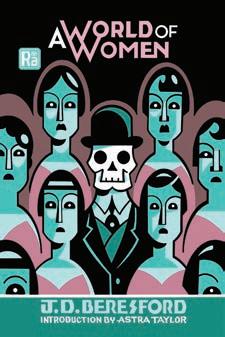
The World Set Free
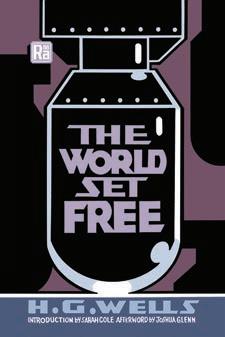
H. G. Wells
introduction by Sarah Cole afterword by Joshua Glenn
In a novel written on the eve of World War I, H. G. Wells imagines a war “to end all wars” that begins in atomic apocalypse but ends in an enlightened utopia.
Writing in 1913, on the eve of World War I’s mass slaughter and long before World War II’s mushroom cloud finale ells imagined a war that begins in ato ic apocal pse but ends in a utopia of enlight ened world government. Set in the 1950s, Wells’s neglected novel The World Set Free describes a con ict so horrific that it actuall is the war that ends war.
ells the first to i a ine a “uraniu based bo b” o ers a prescient description of atomic warfare that renders cities unlivable for ears “ hole blocks of buildin s ere ali ht and burnin fiercel the tre blin ra ed a es lookin pale and hastl and attenuated in co parison ith the full bodied cri son lare be ond ” ra in on discoveries b ph sicists and chemists of the time, Wells foresees both a world po ered b clean plentiful ato ic ener and the destructive force of the neutron chain reaction.
With a cast of characters including Marcus arenin the oral center of the narrative; ir in a proto re iteer; and bert the visionar oun ritish onarch ells dra ati es a orld stru lin for sanit ells s supposedl happ endin a planetar overn ent presided over b uropean en a not appeal to conte porar readers but his an uish at the orld s self destructive tendencies ill strike a chord
H. G. Wells (1866–1946) was a prolific and best-selling author of novels, short stories, and social commentary. Among his best-known works are The Time Machine, The Invisible Man, The War of the Worlds, and The Island of Doctor Moreau
Radium Age Series
Under the direction of Joshua Glenn, the MIT Press’s Radium Age is reissuing notable proto-science fiction stories from the underappreciated era between 1900 and 1935, with new contributions by historians, science journalists, and science fiction authors.
science fiction
May | 5 1/4 x 7 3/4, 282 pp.
US $19.95T/$25.95 CAN paper 978-0-262-54336-1
Radium Age series
Radium Age series
science fiction March | 5 1/4 x 7 3/4, 344 pp. US $19.95T/$25.95 CAN paper 978-0-262-54335-4
20 Spring 2022 | mitpress.mit.edu
The Clockwork Man
E. V. Odle
introduction by Annalee Newitz
In the first-ever novel about a cyborg, a machineenhanced man from a multiverse of the far future visits 1920s England.
n s n land a stran e bein crashes a villa e cricket a e After so e litch erk atte pts to communicate, this creature reveals that he is a achine enhanced human from a multiverse thousands of ears in the future he mechanism implanted in his skull has alfunctioned sending him tumbling through time onto the green rass of the cricket field Apparentl in the future at the behest of fed up women, all men will be controlled b an e bedded “clock ork ” ca ou a ed with hats and wigs.
Published in 1923, The Clockwork Man the first c bor novel tells the stor of this odd ti e traveler s visit Spending time with two village couples about to e bark upon arried life the lock ork an arns that because en of the t entieth centur are so violent se ist and selfish in the not too distant future the ill be banned fro ph sical realit he ill inhabit instead a virtual world—what we’d now call the in ularit in hich their ever need is et but love is absent ill the lock ork an s tale lead his ne friends to reconsider technolo ender roles se and free will?
vershado ed in its o n ti e b arel apek s sensational pla R.U.R., about a robot uprising, The Clockwork Man is overdue for rediscover
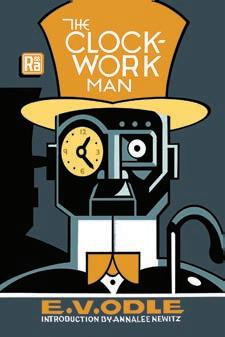
E. V. Odle (1890–1942) was a Bloomsbury-adjacent magazine editor in London.
Voices from the Radium Age edited and introduced by Joshua Glenn
A collection of science fiction stories from the early twentieth century by authors ranging from Arthur Conan Doyle to W. E. B. Du Bois.
his collection of science fiction stories fro the earl t entieth centur features ork b the fa ous Arthur onan o le creator of herlock ol es the no lon er fa ous “ eird fiction pioneer” illia ope od son and the should be ore fa ous en ali fe inist oke a akha at ossain t o ers stories b riters kno n for concerns other than science fiction u ois author of The Souls of Black Folk and b riters kno n onl for pulp science fiction the prolific eil ones hese stories represent hat volu e and series editor
Joshua Glenn has dubbed “the Radium Age”—the period hen science fiction as e kno it e er ed as a enre he collection sho s that nascent science fiction fro this era as prescient provocative and ell written.

Readers will discover, among other delights, a femi nist utopia predatin harlotte erkins il an s Herland b a decade in ossain s stor “ ultana s rea ”; a world in which the human population has retreated under round in orster s “ he achine tops”; an earl entr in the Afrofuturist sub enre in u ois s last an on arth tale “ he o et”; and the first appearance of ones s cr opreserved rofessor a eson ho despairs at arth s recka e but perseveres in a etal bod to appear in thirt odd ore stories
Joshua Glenn, writer and semiotician, is the editor of the Radium Age series and the publisher of HiLobrow. He is the coauthor several books, including The Idler’s Glossary and Unbored: The Essential Field Guide to Serious Fun
science fiction
—Jonathan
science fiction
May | 5 1/4 x 7 3/4, 208 pp.
US $19.95T/$25.95 CAN paper 978-0-262-54343-9
Radium Age series
March | 5 1/4 x 7 3/4 224 pp. US $19.95T/$25.95 CAN paper 978-0-262-54337-8
Radium Age series
21
“Edwin Vincent Odle’s ominous, droll, and unforgettable The Clockwork Man is a missing link between Lewis Carroll and John Sladek or Philip K. Dick.”
Lethem, author of The Arrest
mitpress.mit.edu | Spring 2022
Design after Capitalism
Transforming Design Today for an Equitable Tomorrow
Matthew Wizinsky
How design can transcend the logics, structures, and subjectivities of capitalism: a framework, theoretical grounding, and practical principles.

he desi ned thin s e periences and s bols that we use to perceive, understand, and perform our ever da lives are uch ore than ust props he directl shape ho e live n Design after Capitalism atthe i insk ar ues that the world of industrial capitalism that gave birth to odern desi n has been dra aticall transfor ed esi n toda needs to reorient itself to ard deliberate transitions of ever da politics social rela tions and econo ies ookin at desi n throu h the lens of political econo i insk calls for the field to transcend the logics, structures, and subjectivities of capitalism—to combine design entrepreneurship with social e po er ent in order to facilitate ne a s of producin those thin s s bols and e periences that ake up ever da life
After anal in the parallel histories of capitalis and desi n i insk o ers so e historical e a ples of anticapitalist, noncapitalist, and postcapitalist models of desi n practice hese ran e fro the ritish Arts and rafts ove ent of the nineteenth centur to conte porar practices of ro in furniture or biote tiles and auto ated for s of production ra in on insi hts fro sociolo philosoph econo ics political science histor environ ental and sustainabilit studies and critical theor fields not usuall seen as central to desi n he la s out core principles for postcapitalist desi n; o ers strate ies for appl in these principles to the three la ers of pro ect practice and discipline; and provides a set of practical guidelines for designers to use as a startin point he ork of postcapitalist desi n can start toda i insk sa s ith the ne t pro ect
Matthew Wizinsky, a designer with more than twenty years of professional experience, is Associate Professor in the Ullman School of Design at the University of Cincinnati and Associate Editor for the design journal Visible Language
design | political science
March | 7 x 10, 344 pp. | 23 illus.
US $32.95T/$43.95 CAN paper 978-0-262-54356-9
“Matthew Wizinksy shows designers how to erode capitalism from the inside out by nurturing the commons and creating tools for cooperation and exchange. Above all, designers can help us downsize everything from packaging and waste to the ever-expanding work week of the creative classes.”
—Ellen Lupton, coauthor of Extra Bold: A Feminist, Inclusive, Anti-Racist, Nonbinary Field Guide for Graphic Designers
“An essential examination of the potential for design and designers to contribute to societal transitions toward more sustainable, equitable, and desirable long-term futures.”
—Terry Irwin, Director of the Transition Design Institute, Carnegie Mellon University
22 Spring 2022 | mitpress.mit.edu
“An innovative and deeply personal book that is chock full of insight and actionable content. Bethune’s emphasis on ‘strategic’ design thinking, combined with his ability to balance his corporate and engineering knowledge with design, will unlock value for many readers, from new grads to the C-suite.”
—Annie Jean-Baptiste, author of Building for Everyone; founder, Equity Army
“With vulnerability, clarity, and actionable insights, Kevin Bethune answers important questions for increasing diversity and inclusion in design: What does it mean to be a Black man succeeding in design? What can you learn from him to help others succeed?”
—Dori Tunstall, Dean of Design, OCAD University
Reimagining Design
Unlocking Strategic Innovation
Kevin G. Bethune foreword by John Maeda

The power of transformative design, multidisciplinary leaps, and diversity: lessons from a Black professional’s journey through corporate America.
esi n o ers so uch ore than an aestheticall pleasin lo o or banner a beautification add on after the heav liftin n Reimagining Design, Kevin Bethune sho s ho desi n provides a uni ue an le on proble solvin ho it can be levera ed strate icall to cultivate innovation and anchor ultidisciplinar tea ork
As he does so he describes his ourne as a lack professional through corporate America, revealing the po er of transfor ative desi n ultidisciplinar leaps and diversit ethune ho be an as an en ineer at estin house oved on to ike here he desi ned Air ordans and no orks as a sou ht after consultant on design and innovation, shows how design can transform both individual lives and or ani ations n ethune s account diversit e uit and inclusion emerge as a recurring theme. He shows how, as we leverage design for innovation, we also need to consider the broader ecological implications of our decisions and ackno led e the threads of s ste ic in ustice in order to reali e positive chan e is book is for an one ho has felt like the “other” and also for allies ho ant to encoura e anti racist anti se ist and anti a eist behaviors in the orkplace esi n transfor ation takes leadership leaders ho do not act as atekeepers but ith a ilit and ni bleness build tea s that irror the arketplace
esi n in har on ith other disciplines can be incredibl po erful; ultidisciplinar tea collaboration is the foundation of future innovation. With insight and co passion ethune provides a fra e ork for brin in this about.
Kevin G. Bethune is the Founder and Chief Creative O cer of dreams
• design + life, a think tank for design and innovation. Over a career that spans more than twenty years, he has worked in engineering, business, and design.
business | design
February | 5 1/4 x 8, 208 pp. | 30 illus.
US $24.95T/$33.95 CAN cloth 978-0-262-04650-3
Simplicity: Design, Technology, Business, Life series
23 mitpress.mit.edu | Spring 2022
Redesigning Work
How to Transform Your Organization and Make Hybrid Work for Everyone
Lynda Gratton
How do we make the most of the greatest global shift in the world of work for a century and radically redesign the way we work—forever?
Professor Lynda Gratton is the global thought-leader on the future of work. Drawing on thirty years of research into the technological, demographic, cultural, and societal trends that are shaping work and building on what we learned through our experiences of the pandemic, Gratton presents her innovative four-step framework for redesigning work that will help you:
• Understand your people and what drives performance
• Reimagine creative new ways to work

• Model and test these approaches within your organization
• Act and create to ensure your redesign has lasting benefits
Gratton presents real-world case studies that show companies grappling with work challenges. These include the global bank HSBC, which built a multidisciplinary team to understand the employee experience; the Japanese technology company Fujitsu, which reimagined three kinds of “perfect” offices; and the Australian telecommunications company Telstra, which established new roles to coordinate work across the organization. Whether you’re working in a small team or running a multinational, Redesigning Work is the definitive book on how to transform your organization and make hybrid working work for you.
Lynda Gratton is Professor of Management Practice at the London Business School and Founder of the consultancy practice HSM Advisory. For over a decade she has been ranked among the top management thinkers globally by Thinkers50. She is the author of ten books, including The Shift, The Key, and with Andrew J. Scott, The 100-Year Life and The New Long Life
business | management
May | 6 x 9, 256 pp.
US $19.95 T/$25.95 CAN paper 978-0-262-54498-6
Management on the Cutting Edge series, published in cooperation with MIT Sloan Management Review
“A remarkably thoughtful and practical guide to rethinking how work gets done. Perhaps the only thing we know for sure is that the workplace of the future is a moving target that will continue to come into focus in the coming years, influenced by many voices and many factors. With Gratton’s help, this journey can be far more systematic and rewarding than it would otherwise be.”
—Amy C. Edmondson, Professor, Harvard Business School; author of The Fearless Organization
“Thought-provoking, deeply researched, and invaluable, this fascinating book will help you build, lead, and guide your organization through this time of extraordinary change.”
—Gary Hamel, management expert and founder of Strategos
“An intelligent, deeply thoughtful book that will walk you through the choices that will be critical to your people’s future happiness and well-being and, by extension, to your organization’s performance.
Lynda Gratton’s sharp new book gives us a practical approach to parsing out the choices that will work in our unique situations.”
—Rita McGrath, best-selling author and professor at Columbia Business School
23B Spring 2022 | mitpress.mit.edu Trade
Management on the Cutting Edge Series


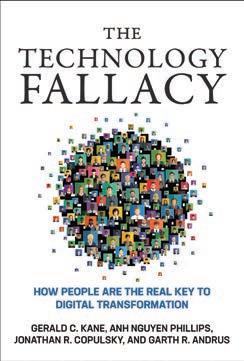
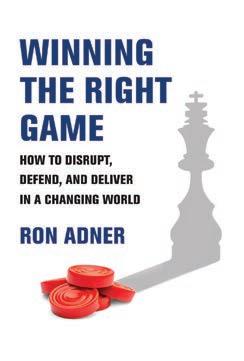
The books in the Management on the Cutting Edge Series—copublished with MIT Sloan Management Review—o er practical, proven guidance for business leaders facing unprecedented challenges. mitpress.mit.edu/management
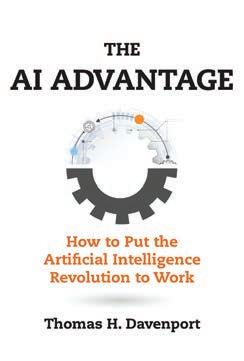

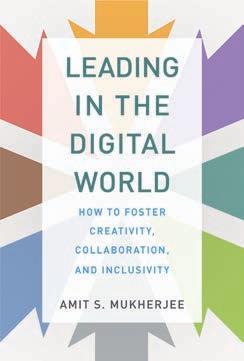


23C mitpress.mit.edu | Spring 2022
The Digital Multinational
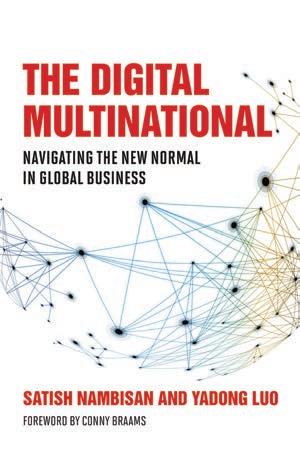
Navigating the New Normal in Global Business Satish Nambisan and Yadong Luo
foreword by Conny Braams, Chief Digital and Marketing Officer at Unilever
How multinational companies can use digital technology to compete in a world where business is driven by the forces of both globalization and deglobalization.
i ital technolo has put lobali ation on steroids; ultinational co panies no account for one third of orld and one fourth of orld e plo ent And et co plicatin this stor of unchecked lobal capitalis are t o contradictor forces ven as advances in di ital technolo enable borderless arkets a new nationalism has emerged, reviving protectionism and railing against digital colonialism. In The Digital Multinational, management experts Satish Nambisan and Yadong Luo examine how companies can adopt a dual strate to cope ith this ne nor al harnessin the po er of di ital technolo hile adaptin to the eopolitical realities of particular arkets e to success a bisan and uo e plain is the notion of ti ht and loose couplin to characteri e the relationship of the digital multinational to its global partners and subsidiaries dentif in the ti htness looseness re uire ents of lobal business connectivit leads to successful business strate ra in on real orld e a ples that include urberr s entrance into the hinese arket nilever s A po ered lobal talent arketplace and the ocal for ocal ove ent in ndia the develop a t polo of lobal business conte ts; discuss di ital strate ies for enterin ne arkets establishin di ital platfor s ana in loball dispersed activities, and pursuing innovation; and explain how these strate ies can be part of a business leader s toolkit
Satish Nambisan, a globally recognized authority on innovation and digital strategy, is Nancy and Joseph Keithley Professor of Technology Management at the Weatherhead School of Management at Case Western Reserve University. He is the author of The Global Brain: Your Roadmap for Innovating Faster and Smarter in a Networked World and other books. Yadong Luo is Emery M. Findley Distinguished Chair and Professor of Management at the University of Miami. He is the author of Global Dimensions of Corporate Governance and other books.
business | management
February | 6 x 9, 264 pp. | 6 illus.
US $29.95T/$39.95 CAN cloth 978-0-262-04632-9
Management on the Cutting Edge series, published in cooperation with MIT Sloan Management Review
“There is no doubt digital is changing our lives. And yet, just when we thought we’d seen it all, during the pandemic we saw an even faster pace of transformation across all walks of life. I highly recommend this insightful book to leaders across the globe as they navigate the new normal.”
—Harit Talwar, Chairman of Consumer Business, Goldman Sachs
24 Spring 2022 | mitpress.mit.edu
Work without Jobs

How to Reboot Your Organization’s Work Operating System
Ravin Jesuthasan and John W. Boudreau
Why the future of work requires the deconstruction of jobs and the reconstruction of work.
ork is traditionall understood as a “ ob ” and orkers as “ obholders ” obs are structured b titles hierarchies and ualifications n Work without Jobs, Ravin Jesuthasan and ohn oudreau propose a radicall ne a of lookin at ork he describe a ne “ ork operatin s ste ” that deconstructs obs into their co ponent parts and reconstructs these components into more opti al co binations that re ect the skills and abilities of individual orkers n a ne nor al of rapidl acceleratin auto ation de ands for or ani ational a ilit e orts to increase diversit and the e er ence of alternative ork arran e ents the old s ste based on obs and obholders is cu berso e and un ainl esuthasan and oudreau s ne s ste la s out a road ap for the future of ork
Work without Jobs presents real orld cases that sho ho leadin or ani ations are e bracin ork decon struction and reinvention or e a ple hen a robot chatbot or artificial intelli ence takes over parts of a ob hile a hu an orker continues to do other parts hat is the “ ob” found so e ans ers hen it deplo ed social robotics at its distribution centers. Meanwhile, the biotechnolo co pan enentech deconstructed obs to increase e ibilit orker en a e ent and retention ther or ani ations achieved a ilit ith internal talent arketplaces orker e chan es freelancers cro d sourcin and partnerships t s ti e for or ani ations to reboot their ork operatin s ste and Work without Jobs o ers an essential uide for doin so
Ravin Jesuthasan, a recognized futurist and authority on the future of work, human capital, and automation, is Senior Partner and Global Leader for Transformation Services at Mercer. He is a member of the World Economic Forum’s steering committee on work and employment. John W. Boudreau conducts breakthrough research on human capital, talent, and sustainable competitive advantage. He is Emeritus Professor of Management and Organization at the University of Southern California’s Marshall School of Business.
business
March | 6 x 9, 216 pp. | 8 illus.
US $29.95T/$39.95 CAN cloth 978-0-262-04641-1
Management on the Cutting Edge series, published in cooperation with MIT Sloan Management Review
25 mitpress.mit.edu | Spring 2022
Productive Tensions
How Every Leader Can Tackle Innovation’s Toughest Trade-Offs
Christopher B. Bingham and Rory M. McDonald
How leaders can recast innovation’s toughest trade-offs—efficiency vs. flexibility, consistency vs. change, product vs purpose—as productive tensions.
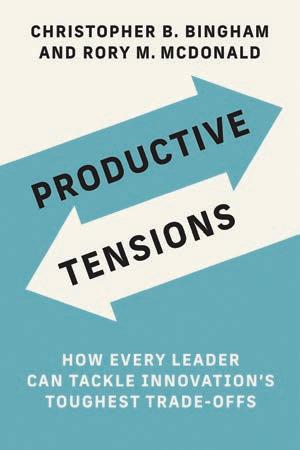
h is leadin innovation in toda s d na ic business environ ent so distressin l hit or iss ore than percent of hi h potential ventures don t reach their pro ected tar ets urve s sho that percent of e ecu tives consider innovation crucial to their ro th strate but onl percent are satisfied ith their innovation perfor ance hould leaders ai for teve obs level genius, or shower their projects with resources, or lean in to luck and e brace uncertaint one of the above sa hris in ha and or c onald ra in on cuttin ed e research and probin interviews with hundreds of leaders across three conti nents, in Productive Tensions in ha and c onald find that the ost e ective leaders and successful innovators e brace the tensions that arise fro co petin ai s efficienc or e ibilit consistenc or chan e product or purpose in ha and c onald spotli ht ei ht critical tensions that ever innovator ust aster and the spell out ith do ens of detailed e a ples of both success and failure ho to navi ate the o do ou e cite custo ers about a product the ve never i a ined? When is it wise to accept what the data is telling ou and hen should ou i nore the data and plo for ard an a o can ou aintain stakeholders trust and support during radical unforeseen course corrections in ha and c onald uide readers through innovation’s thorniest tensions, using examples dra n fro the e perience of or ani ations as varied as nsta ra the ilitar onda n ut ur er lack nder Ar our and the sno boardin co pan urton
Rory
business | management
April | 6 x 9, 168 pp. | 10 illus.
US $29.95T/$39.95 CAN cloth 978-0-262-04693-0
Management on the Cutting Edge series, published in cooperation with MIT Sloan Management Review
26 Spring 2022 | mitpress.mit.edu
Christopher B. Bingham is Philip Hettleman Distinguished Scholar and Professor and Area Chair of Strategy and Entrepreneurship at KenanFlagler Business School at the University of North Carolina–Chapel Hill.
M. McDonald is Thai-Hi T. Lee Associate Professor of Business Administration at Harvard Business School.
“As a woman of color and an executive, I know first-hand how important it is for companies to create opportunities for women of color to lead. Inclusion on Purpose shows how to build an inclusive workplace and culture through storytelling and practical frameworks. Whether you are a manager or you want to become one, this book is essential reading!”
—Reema Batnagar, VP People, Pixar Animation Studios
Inclusion on Purpose
An Intersectional Approach to Creating a Culture of Belonging at Work Ruchika Tulshyan foreword by Ijeoma Oluo

How organizations can foster diversity, equity, and inclusion: taking action to address and prevent workplace bias while centering women of color.
e ould disa ree that inclusion is both the ri ht thin to do and ood for business hen h are e so terrible at it f e believe in the oralit and the profitabilit of includin people of diverse and underesti ated back rounds in the orkplace h don t e do it ecause e plains uchika ulsh an in this e e openin book e don t reali e that inclusion takes a areness intention and regular practice. Inclusion doesn’t just happen; e have to ork at it ulsh an presents inclusion best practices sho in ho leaders and or ani ations can eanin full pro ote inclusion and diversit ulsh an centers the orkplace e perience of o en of color, who are subject to both gender and racial bias. It is at the intersection of gender and race, she sho s that e discover the kind of inclusion policies that benefit all ulsh an debunks the idea of the “level pla in field” and e plains ho leaders and or ani a tions can use their privile e for ood b identif in and e posin bias kno in that the t picall have less to lose in speakin up than a o an of color does he e plains h “leanin in” doesn t ork and dismantling structural bias does; warns against hiring for “culture fit ” ar uin for “culture add” instead; and e phasi es the i portance of ps cholo ical safet in the orkplace ou need to kno that our or ani ation has our back ith this i portant book ulsh an sho s us ho e can ake pro ress to ard inclusion and diversit and e ust start no
Ruchika Tulshyan, an award-winning inclusion strategist and speaker, is CEO and founder of Candour, which works with organizations to create diverse teams and inclusive cultures. A former business journalist, she has reported from four countries and writes regularly on inclusive leadership for the Harvard Business Review. She was named to the Thinkers50 list, a global ranking described by the Financial Times as “the Oscars of management thinking.”
business | management
February | 6 x 9, 248 pp. | 1 illus.
US $29.95T/$39.95 CAN cloth 978-0-262-04655-8
27 mitpress.mit.edu | Spring 2022
Language vs. Reality
Why Language Is Good for Lawyers and Bad for Scientists

N. J. Enfield
A fascinating examination of how we are both played by language and made by language: the science underlying the bugs and features of humankind’s greatest invention.
an ua e is said to be hu ankind s reatest acco plish ent ut hat is lan ua e actuall ood for t perfor s poorl at representin realit t is a constant source of distraction, misdirection, and overshadowing. n fact nfield notes lan ua e is far better at persuasion than it is at ob ectivel capturin the facts of e perience an ua e cannot create or chan e ph sical realit but it can do the ne t best thin refra e and invert our view of the world. In Language vs. Reality, nfield e plains h lan ua e is bad for scientists ho are bound b realit but ood for la ers ho ant to in their cases h it can be dan erous hen it falls into the ron hands and h it deserves our deepest respect.
nfield o ers a livel e ploration of the science underl in the bu s and features of lan ua e e examines the tenuous relationship between language and realit ; details the arra of e ects lan ua e has on our e or attention and reasonin ; and describes ho these varied e ects po er narratives and stor tellin as ell as political spin and conspirac theories h should e care hat lan ua e is ood for nfield ho has spent t ent ears at the cuttin ed e of lan ua e research, argues that understanding how language orks is crucial to tacklin our ost pressin challen es includin hu an co nitive bias edia spin the “post truth” problem, persuasion, the role of words in our thinkin and uch ore
N. J. Enfield is Professor of Linguistics at the University of Sydney and Director of the Sydney Centre for Language Research and the Sydney Initiative for Truth. He is the author of The Anatomy of Meaning, The Utility of Meaning, How We Talk, and other books.
psychology | linguistics
March | 6 x 9, 312 pp. | 33 illus.
US $32.95T/$43.95 CAN cloth 978-0-262-04661-9
28 Spring 2022 | mitpress.mit.edu
The Secrets of Words

Noam Chomsky and Andrea Moro
Two distinguished linguists on language, the history of science, misplaced euphoria, surprising facts, and potentially permanent mysteries.
In The Secrets of Words in uential lin uist oa ho sk and his lon ti e collea ue Andrea oro have a ide ran in conversation touchin on such topics as lan ua e and lin uistics the histor of science and the relation between language and the brain. Moro draws ho sk out on toda s isplaced euphoria about artificial intelli ence ho sk sees “lots of h pe and propa anda” co in fro ilicon alle the stud of the brain ho sk points out that findin s fro brain studies in the 1950s never made it into that era’s ps cholo and lan ua e ac uisition b children ho sk in turn invites oro to describe his o n experiments on language and the brain, and Moro does so, drawing a distinction between where uestions here in the brain lan ua e happens and what questions hat actual infor ation is passed fro one neuron to another ho sk once said “ t is i portant to learn to be surprised b si ple facts” “an e pression of ours that has represented a funda ental turnin point in o n personal life ” sa s oro and this is so ethin of a theme in their conversation. Another theme is that not ever thin can be kno n; there a be per anent steries about lan ua e and other atters ot all words will give up their secrets.
Noam Chomsky is Institute Professor and Professor of Linguistics Emeritus at MIT and Laureate Professor in the Department of Linguistics at the University of Arizona, where he is also the Agnese Nelms Haury Chair in the Agnese Nelms Haury Program in Environment and Social Justice. He is the author of many influential books on linguistics, including Aspects of the Theory of Syntax and The Minimalist Program, both published by the MIT Press. Andrea Moro is Professor of General Linguistics at the Institute for Advanced Study (IUSS) in Pavia, Italy. He is the author of Impossible Languages, The Boundaries of Babel, and A Brief History of the Verb To Be (all published by the MIT Press), and other books.
linguistics | philosophy
May | 4 x 6, 208 pp. US $16.95T/$22.95 CAN cloth 978-0-262-04671-8
29 mitpress.mit.edu | Spring 2022
Imaginary Languages
Myths, Utopias, Fantasies, Illusions, and Linguistic Fictions Marina Yaguello translated by Erik Butler
An exploration of the practice of inventing languages, from speaking in tongues to utopian schemes of universality to the discoveries of modern linguistics.
In Imaginary Languages, Marina Yaguello explores the histor and practice of inventin lan ua es fro reli ious speakin in ton ues to politicall utopian sche es of universalit to the discoveries of odern lin uistics he looks for i a ined lan ua es that are autono ous s ste s co plete unto the selves and eant for co unal use; i a inar and therefore unlike both natural lan ua es and historicall attested lan ua es; and products of an individual e ort to la hold of lan ua e nventors of lan ua es a uello rites are adl in love the love an ob ect that belon s to the onl to the e tent that the also share it ith a co unit a uello investi ates the sources of i a inar lan ua es in ths drea s and utopias he takes readers on a tour of languages invented in literature fro the si teenth to the t entieth centur includin that in More’s Utopia eibni s “al ebra of thou ht ” and ul er tton s lin uistic fiction he e a ines the lin uistic fantasies or adness of eor ian lin uist ikolai arr and iss ediu l ne ith; and considers the quest for the true philosophical language. a uello finds t o abidin and so e hat contradictor forces the diversit of lin uistic e perience hich stands opposed to unif in endeavors and on the other hand features shared b all lan ua es natural or not and their users hich ustifies the universalist h pothesis ecent ears have seen so ethin of a boo in invented lan ua es hether artificial lan ua es eant to facilitate international communication or imagined lan ua es constructed as part of science fiction orlds

In Imaginary Languages an updated and e panded version of the earlier Les Fous du langage published in n lish as Lunatic Lovers of Language a uello sho s that the invention of lan ua e is above all a passionate di in labor of love.
Marina Yaguello is Professor Emerita of Linguistics at the University of Paris VII.
linguistics | philosophy
April | 5 1/4 x 8, 352 pp. | 11 illus.
US $29.95T/$39.95 CAN cloth 978-0-262-04639-8
30 Spring 2022 | mitpress.mit.edu
Terra Forma

A Book of Speculative Maps
Frédérique Aït-Touati, Alexandra Arènes, and Axelle Grégoire
foreword by Bruno Latour translated by Amanda DeMarco
Charting the exploration of an unknown world— our own—with a new cartography of living things rather than space available for conquest or colonization.
his book charts the e ploration of an unkno n orld our own. Just as Renaissance travelers set out to map the terra inco nito of the e orld the ap akers of Terra Forma have set out to rediscover the world that we think e kno he do this ith a ne kind of carto raph that aps livin thin s rather than space e ptied of life and available to be con uered or coloni ed he maps in Terra Forma lead us in ard not o into the distance ovin fro the hori on line of conventional carto raph to the thickness of the round fro the global to the local.
ach ap in Terra Forma is based on a specific territor or territories and each tool or odel creates a ne focal point throu h hich the territor is redra n he aps are “livin aps ” al a s under construction spaces here stories and situations unfold he a ap the arth s underside rather than its surface su est turnin the la ers of the arth inside out link the biolo ical ph siolo of livin inhabitants and the ph siolo of the land or trace a ourne oriented not b the uclidean space of but b points of life hese speculative visuali ations can constitute the foundation for a ne kind of atlas
Frédérique Aït-Touati is a science historian, theater director, and Research Fellow at the CNRS (French National Centre for Scientific Research). Alexandra Arènes is a landscape architect working on a project in Gaia-graphy at the University of Manchester.
Axelle Grégoire is an architect who has worked in urban planning and on experimental transdisciplinary research projects on the city.
science | history
February | 6 1/2 x 9 1/2, 200 pp. | 35 illus.
US $29.95T/$39.95 CAN cloth 978-0-262-04669-5
31 mitpress.mit.edu | Spring 2022
Literature’s Elsewheres
On the Necessity of Radical Literary Practices Annette Gilbert

translated by the Cadenza Academic Translations team and Antonia Hirsch
An examination of a series of diverse, radical, and experimental international works from the 1950s to the present.
hat is a literar ork n Literature’s Elsewheres, Annette ilbert tackles this uestion b deplo in an extended concept of literature, examining a series of diverse radical e peri ental orks fro the s to the present that occup the li inal one bet een art and literature hese orks b A erican Artist Allison arrish atalie ech tephanie uco iona anner lfriede elinek an raha obert arr eor e recht and others represent a plurali ed literar practice that i a ines a di erent literature e er in fro its else heres nvesti atin a ork s co in into bein its transition fro “te t” to “ ork” as a social ob ect and pra atic cate or of literar co unication ilbert probes the assumptions and foundations that underpin literature, including the ideologies and power structures that prop it up he o ers a snapshot fro a period of recent literar and art histor hen such central concepts as ori inalit and authorship ere uestioned and e peri ental literar practices ran ed fro concrete poetr and ulipo to conceptual writing and appropriation literature. She e a ines orks that are de ateriali ed site specific uni ue copies of other orks and institutional criti ues Considering the inequalities, exclusions, and privileges inscribed in literature, she documents the power of e peri ental literature to attack these nor s and challen es the field s canonical eo raphic boundaries b examining artists with roots in North and South America, ast Asia and estern and astern urope he cross pollination of literar and art criticis enriches both fields ith Literature’s Elsewheres, Gilbert explores what art can t see about the literar and hat literature has overlooked in the arts
Annette Gilbert is Associate Professor in Comparative Literature at Friedrich-Alexander Universität Erlangen-Nuremberg. Her recent publications include Under the Radar: Underground Zines and SelfPublications 1965–1975 and Publishing as Artistic Practice (Sternberg Press).
art | literary criticism
March | 7 x 9, 432 pp. | 88 illus.
US $34.95T/$45.95 CAN paper 978-0-262-54341-5
“Beautifully composed, persuasively argued, and enormously informative, Annette Gilbert’s cutting-edge study of recent experimental poetry and art, from Mallarmé and Marcel Broodthaers to Elfriede Jelinek and Sherrie Levine, compels us to revise our inherited notions of what the ‘literary’ now looks and sounds like. Gilbert’s is surely the definitive work on late conceptual practice in the arts today.”
—Marjorie Perlo , author of Infrathin: An Experiment in Micropoetics
32 Spring 2022 | mitpress.mit.edu
Philosophy for Passengers
Michael Marder illustrations by Tomás Saraceno
A philosophical guide to passengerhood, with reflections on time, space, existence, boredom, our sense of self, and our sense of the senses.

hile there are entire bookstore sections and even entire bookstores devoted to travel there have been fe books on the universal e perience of bein a passen er ith this book philosopher ichael arder fills the ap o erin a philosophical uide to passen erhood e takes readers fro ticketin and preboardin preface and introduction throu h a series of stops and detours re ections on topics includin ti e space e istence boredo our sense of self and our sense of the senses to destination and dise barkin conclusion arder finds that the e perience of passen ers in the t ent first centur is e perience itself stretchin ell be ond railroad tracks and airplane i ht patterns n his ourne throu h passen erhood he considers a on an other thin s passen er to etherness hich oes hand in hand ith passen er loneliness; over countr and the idea of placeness; and escartes in an airplane seat. He tells us that the word metaphor means transport in reek and discusses the ra area bet een literalness and etaphoricit ; e plains the connection bet een readin and ridin ; and ponders the di erence bet een destination and destin inall a eckettian dise barkin ou i ht not be able to dise bark et ou ust dise bark After the vo a e in the orld ends the ourne of understandin be ins
Michael Marder is Ikerbasque Research Professor in the Department of Philosophy at the University of the Basque Country (UPV-EHU). He is the author of The Philosopher’s Plant: An Intellectual Herbarium; Dump Philosophy: A Phenomenology of Devastation; and other books.
travel | philosophy
May | 5 x 7, 240 pp. | 19 illus.
US $15.95T/$21.95 CAN paper 978-0-262-54371-2
33 mitpress.mit.edu | Spring 2022
Picturing the Mind
Consciousness through the Lens of Evolution
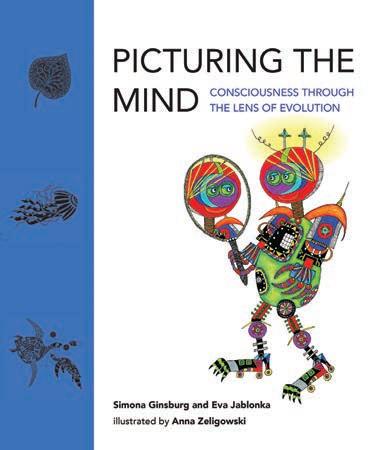
Simona Ginsburg and Eva Jablonka illustrated by Anna Zeligowski
Consciousness in all its possible human and nonhuman varieties, explored through words and images.
hat is consciousness and ho or hat is conscious—humans, nonhumans, nonliving beings? How did consciousness evolve? Picturing the Mind pursues these questions through a series of “vistas” short en a in te ts b i ona insbur and va ablonka acco pa nied b Anna eli o ski s livel illustrations akin an evolutionar perspective insbur and ablonka su est that consciousness can take an for s and is found not onl in hu ans but even in such ani als as octopuses ho see to e press e otions b chan in color and bees ho sociali e ith other bees he identif the possible evolutionar arker of the transition from nonconscious to conscious animals, and the speculate intri uin l about aliens and artificial intelligence.
ach picture and te t serves as a startin point for discussion he authors consider a on other thin s hat it s like to be a bat and then later hat it s like to be a bat in virtual realit ; ask if the self is like a hole in a doughnut; report that women, children, and nonwhite en ere once thou ht b hite en to be less richl conscious; and explore what sets humans apart—is it usic tool akin cooperative parentin blushin sentience s bolic lan ua e n Picturing the Mind, questions suggest answers.
Simona Ginsburg is Associate Professor at the Open University of Israel, where she developed and headed the MA Program in Biological Thought. Eva Jablonka is Professor at the Cohn Institute for the History and Philosophy of Science and Ideas at Tel-Aviv University. Ginsburg and Jablonka are coauthors of The Evolution of the Sensitive Soul: Learning and the Origins of Consciousness (MIT Press). Anna Zeligowski is an artist and physician. Her illustrations have appeared in numerous books and articles on scientific subjects.
psychology
February | 8 x 9, 256 pp. | 87 color illus.
US $39.95T/$53.95 CAN cloth 978-0-262-04675-6
“Two of the central voices of evolutionary consciousness science present a remarkable work about the mind and its embodiments. Clear exposition of deep concepts, many new ideas, and incredible artwork will move readers on many levels. Most highly recommended.”
—Michael Levin, Distinguished Professor and Vannevar Bush Chair, Department of Biology, and Director of the Allen Discovery Center, Tufts University
34 Spring 2022 | mitpress.mit.edu
Machines like Us
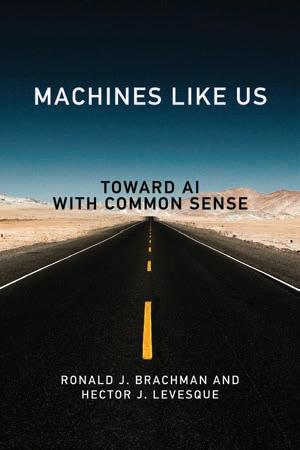
Toward AI with Common Sense
Ronald J. Brachman and Hector J. Levesque
How
we can create artificial
intelligence
with broad, robust common sense rather than narrow, specialized expertise.
t s so eti e in the not so distant future and ou send our full autono ous self drivin car to the store to pick up our rocer order he car is endo ed ith as uch capabilit as an artificial intelli ence a ent can have pro ra ed to drive better than ou do ut hen the car encounters a traffic li ht stuck on red it ust sits there indefinitel ts obstacle avoidance lane follo in and route calculation capacities are all irrelevant; it fails to act because it lacks the co on sense of a hu an driver ho ould uickl fi ure out hat s happenin and find a orkaround n Machines like Us, Ron Brachman and Hector Levesque—both leadin e perts in A consider hat it ould take to create machines with common sense rather than just the speciali ed e pertise of toda s A s ste s sin the stuck traffic li ht and other relatable e a ples rach an and eves ue o er an accessible account of how common sense might be built into a achine he anal e co on sense in hu ans e plain ho A over the ears has focused ainl on e pertise and su est a s to endo an A s ste ith both co on sense and e ective reasonin inall the consider the critical issue of ho e can trust an autono ous achine to ake decisions identif in t o funda ental re uire ents for trust orth autono ous A s ste s havin reasons for doin hat the do and being able to accept advice. Both in the end are dependent on having common sense.
Ron Brachman is Director of the Jacobs Technion-Cornell Institute at Cornell Tech in New York City and Professor of Computer Science at Cornell University. During a long career in industry, he held leadership positions at Bell Labs, Yahoo, and DARPA. Hector Levesque is Professor Emeritus in the Department of Computer Science at the University of Toronto. He is the author of Common Sense, the Turing Test, and the Quest for Real AI (MIT Press), and other books.
technology
May | 6 x 9, 320 pp. | 18 illus. US $29.95T/$39.95 CAN cloth 978-0-262-04679-4
35 mitpress.mit.edu | Spring 2022
Sensing Machines How Sensors Shape

Our Everyday Life
Chris Salter
How we are tracked, surveilled, tantalized, and seduced by machines ranging from smart watches and Roombas to immersive art installations.
ensin achines are ever here in our orld As e ove throu h the da electronic sensors and co puters adjust our thermostats, guide our Roombas, count our steps, change the orientation of an image when we rotate our phones here are ore of these electronic devices in the orld than there are people in thirt to fift billion of the versus billion people ith ore than a trillion expected in the next decade. In Sensing Machines hris alter e a ines ho e are tracked surveilled tantali ed and seduced b achines ran in fro s art atches and ood trackers to assive immersive art installations.
alter an artist scholar ho has orked ith sensors and co puters for ore than t ent ears e plains that the uantification of bodies senses and e perience did not begin with the surveillance capitalism practiced b acebook A a on et i and oo le but can be traced back to athe atical and statistical techni ues of the nineteenth centur e describes the e er ence of the “sensed self ” investi atin ho sensor technolo has been deplo ed in usic and a in pro ra able and immersive art environments, driving, and even eatin ith e ton ues and e noses that can taste and s ell for us ensin technolo turns our e perience into data; but alter s stor isn t ust about hat these machines want from us, but what we want from them— ne sensations the thrill of the uncann and a ic that ill transport us fro our dail rind
Chris Salter is an artist, Professor of Design and Computation Arts at Concordia University, and Codirector of the Hexagram network for arts, culture, and technology. He is the author of Entangled: Technology and the Transformation of Performance and Alien Agency: Experimental Encounters with Art in the Making, both published by the MIT Press.
technology | design
March | 6 x 9, 320 pp. | 60 illus.
US $29.95T/$39.95 CAN cloth 978-0-262-04660-2
36 Spring 2022 | mitpress.mit.edu
“In this important and disturbing book, Lalueza-Fox shows that while our genes may not cause social, economic, and political inequality, they carry the evidence of millennia of human inequality and dominance: men over women, powerful over weak, technologically advanced over traditional.”
—Patrick J. Geary, Professor Emeritus, Institute for Advanced Study
Inequality
A Genetic History Carles Lalueza-Fox

How genomics reveals deep histories of inequality, going back many thousands of years.
ne ualit is an ur ent lobal concern ith pundits politicians acade ics and best sellin books takin up its causes and consequences. In Inequality, Carles alue a o o ers an entirel ne perspective on the sub ect e a inin the enetic arks left b ine ualit on hu ans throu hout histor alue a o describes enetic studies ade possible b novel A se uencin technolo ies that reveal la ers of ine ualit in past societies, manifested in patterns of migration, social structures and funerar practices hrou h their A ancient skeletons have uch to tell us ieldin anon ous stories of ine ualit bias and su erin alue a o a leader in paleo eno ics o ers the deep histor of ine ualit e e plores the ancestral shifts associated with migration and describes the gender bias unearthed in these migrations—the brutal se ual as etries for e a ple bet een ale uropean e plorers and the o en of atin A erica that are revealed b A anal sis e considers social structures, and the evidence that high social standing as inherited the ancient orld as not a eritocrac He untangles social and genetic factors to consider whether wealth is an advantage in reproduction, showing h e are ore likel to be descended fro a kin than a peasant And he e plores the e ects of ancient ine ualit on the hu an ene pool arshalin a ran e of evidence alue a o sho s that understandin past ine ualities is ke to understandin present ones
Carles Lalueza-Fox is Research Professor and Director of the Paleogenomics Lab at the Institute of Evolutionary Biology (CSICUniversitat Pompeu Fabra) in Barcelona. He participated in the Neandertal Genome Project and led the first retrieval of the genome of an 8,000-year-old European hunter-gatherer.
history | science
February | 6 x 9, 192 pp. | 22 illus.
US $27.95T/$36.95 CAN cloth 978-0-262-04678-7
37 mitpress.mit.edu | Spring 2022
The Digital Closet
How the Internet Became Straight Alexander
Monea
An exploration of how heteronormative bias is deeply embedded in the internet, hidden in algorithms, keywords, content moderation, and more.
In The Digital Closet Ale ander onea ar ues provocativel that the internet beca e strai ht b suppressin ever thin that is not forcin content into increasin l narrow channels—rendering it invisible through opaque algorithms, automated and human content moderation, arped ke ords and other strate ies of di ital overreach onea e plains ho the nited tates thirt ear “ ar on porn” has brou ht about the over re ulation of se ual content, which, in turn, has resulted in the censorship of much nonpornographic content—including material on se education and activis n this ide ranging, enlightening account, Monea examines the cultural, technological, and political conditions that put content into the closet onea looks at the anti porn activis of the alt ri ht hristian conservatives and anti porn fe inists ho beca e stran e bedfello s in the politics of porno raph ; investigates the coders, code, and moderators whose ork serves to reif heteronor ativit ; and e plores the collateral damage in the ongoing war on porn—the censorship of co unit resources se education materials, art, literature, and other content that en a es ith se ualit but ould rarel be cate ori ed as porno raph b toda s co unit standards inall he examines the internet architectures responsible for the heteronor ali ation of porn oo le afe earch and the data structures of tube sites and other porn platforms. onea reveals the porn industr s deepest darkest secret porn is borin ainstrea porn is stuck in a heteronor ative filter bubble li ited to the sa e heteronor ative tropes ta ed b the sa e hetero nor ative ke ords ver one su ers fro this forced heteronor ativit of the internet su erin onea su ests that could be alleviated b ueerin strai htness and introducin fe inis to dissipate the iso n

cultural studies | technology
April | 6 x 9, 280 pp. | 11 illus.
US $29.95T/$39.95 CAN cloth 978-0-262-04677-0
Strong Ideas series
38 Spring 2022 | mitpress.mit.edu
Alexander Monea is Assistant Professor in the English Department and Cultural Studies Program at George Mason University.
Artificial Communication
How Algorithms Produce Social Intelligence Elena Esposito
A proposal that we think about digital technologies such as machine learning not in terms of artificial intelligence but as artificial communication.
Al orith s that ork ith deep learnin and bi data are ettin so uch better at doin so an thin s that it akes us unco fortable o can a device kno hat our favorite songs are, or what we should write in an email? Have machines become too smart? In Artificial Communication lena sposito ar ues that dra in this sort of analo bet een al orith s and hu an intel ligence is misleading. If machines contribute to social intelli ence it ill not be because the have learned ho to think like us but because e have learned ho to co unicate ith the sposito proposes that e think of “s art” achines not in ter s of artificial intelli ence but as artificial co unication o do this e need a concept of co unication that can take into account the possibilit that a co unication partner a not be a hu an bein but an al orith hich is not rando and is co pletel controlled althou h not b the processes of the hu an ind sposito investi ates this b e a inin the use of al orith s in di erent areas of social life he e plores the proliferation of lists and lists of lists online e plainin that the eb orks on the basis of lists to produce further lists; the use of visuali ation; di ital profilin and al orith ic individuali ation hich personali e a ass ediu ith pla lists and recommendations; and the implications of the “right to be for otten ” inall she considers ho photo raphs toda see to be used to escape the present rather than to preserve a e or
Elena Esposito is Professor of Sociology at the University Bielefeld and the University of Bologna.
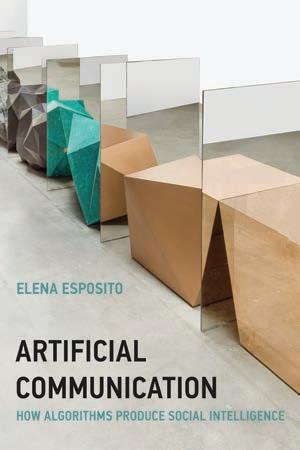
technology
April | 6 x 9, 208 pp. | 1 illus.
US $27.95T/$36.95 CAN cloth 978-0-262-04666-4
Strong Ideas series
39 mitpress.mit.edu | Spring 2022
Health Design Thinking

Creating Products and Services for Better Health second edition
Bon Ku and Ellen Lupton
A practice-based guide to applying the principles of human-centered design to real-world health challenges; updated and expanded with post–COVID-19 innovations.
his book o ers a practice based uide to appl in the principles of hu an centered desi n to real orld health challen es that ran e fro dru packa in to breast cancer detection ritten b pioneers in the field on u a ph sician leader in innovative health desi n and llen upton an a ard innin raphic desi ner the book outlines the funda entals of desi n thinkin and hi hli hts i portant products protot pes and research in health desi n his revised and e panded edition describes innovations developed in response to the crisis includin an intensive care unit in a shipping container, a rolling cart with intubation e uip ent and a ask brace that ives a sur ical ask a tighter seal.
he book e plores the special overlap of health care and the creative process, describing the development of such products and services as a credit card si ed device that allows patients to generate their own electrocardio ra s; a ask desi ned to be orn ith a hi ab; i proved e er enc roo si na e; and a ap of racial disparities and t ill be an essential volume for health care providers, educators, patients, and desi ners ho seek to create better e periences and improved health outcomes for individuals and communities.
Bon Ku, MD, a practicing emergency physician, is Marta and Robert Adelson Professor of Medicine and Design at Sidney Kimmel Medical College at Thomas Je erson University, where he is also Director of the Health Design Lab. Ellen Lupton is Senior Curator of Contemporary Design at Cooper Hewitt, Smithsonian Design Museum, in New York, and Director of the Graphic Design MFA program at Maryland Institute College of Art. She is the author of Beautiful Users, Design Is Storytelling, The Senses: Design Beyond Design, and other books.
design | medical February | 6 1/2 x 8 1/2, 228 pp. | 300 color illus. US $19.95T/$25.95 CAN paper 978-0-262-54360-6
40 Spring 2022 | mitpress.mit.edu
Featured writers
Ravi Agarwal, Nabil Ahmed, Cynthia Chou, Michael MJ Fischer, Édouard Glissant, Donna Haraway, Matthew Hall, Epeli Hau’ofa, May Adadol Ingawanij, Venus Lau, Michael Marder, Nina Oeghoede and Philippe Pirotte, Nikos Papastergiadis and David Pledger, Elizabeth Povinelli, Marian Pastor Roces and Tan Zi Hao
With short texts by Alfian Sa’at, Jake Atienza, Sean Connelly, Kenneth Dean, Faizah Binte Zakaria, Huang Jui-Mao, Anna Källén, Susanne Kriemann, Philippa Lovatt, Rob Nixon, Tania Roy, Matariki Williams, and others
Featured artists include
Irwan Ahmett and Tita Salina, Martha Atienza, Tarek Atoui, Tanatchai Bandasak, Rossella Biscotti, Sean Connelly, Choy Ka Fai, Lucy Davis, Ade Darmawan, Ines Doujak, Jef Geys, Ho Tzu Nyen, Susanne Kriemann, Nicholas Mangan, Alice Miceli, Zarina Muhammad, Manish Nai, Nguyen Trinh Thi; Park Chan-kyong; Sopheap Pich, Marjectica Potrč; Bridget Reweti, Melati Suryodarmo, Sung Tieu, Apichatpong Weerasethakul, Wu Mali, Robert Zhao Renhui
Climates. Habitats. Environments.
edited by Ute Meta Bauer
Artists and writers go beyond disciplinary boundaries and linear histories to address the fight for environmental justice, uniting the Asia-Pacific vantage point with international discourse.
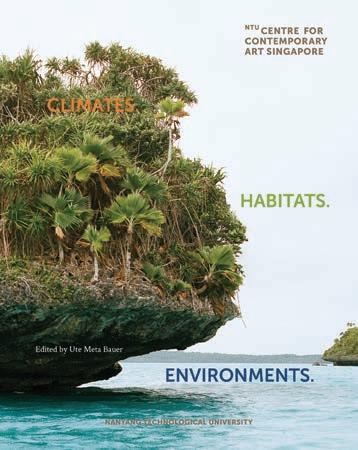
Modeling the curatorial as a method for uniting cultural production and science, Climates. Habitats. Environments. weaves together image and text to address the lobal cli ate crisis hrou h e hibi tions art orks and essa s artists and riters transcend disciplinar boundaries and linear histories to brin their kno led e and e perience to bear on the fi ht for environ ental ustice n doin so the dra on the rich cultural herita e of the Asia acific in conversation ith international discourse to de onstrate transdisciplinar solution seekin peri ental in for as ell as in ethod Climates. Habitats. Environments. features an inventive book desi n b ono studio that puts ord and i a e on e ual footin o erin a ultiplicit of edia interpretations and anifestations of interdisciplinar research or e a ple botanist atthe all dra s on vid s Metamorphoses to discuss hu an plant interpenetration; curator and riter enus au considers ho spectralit consu es and is consu ed in ani ation and fil literature, music, and cuisine; and critical theorist and fil aker li abeth ovinelli proposes “ ater ense” as a geontological approach to “the question of our connected and di erentiated e istence ” infor ed b the “ancestral catastrophe of colonialism.” Artists excavate the natural and cultural A of indi o lac uer rattan and ulberr ; orks at the intersection of art desi n and architecture e plore “ he osthu an it ”; an ongoing research project investigates the ecological ur encies of acific archipela os he orks of art the pro ects and the a orit of the te ts featured in the book ere co issioned b entre for onte porar Art in apore
Ute Meta Bauer is Founding Director of NTU Centre for Contemporary Art Singapore and Professor in the School of Art, Design, and Media at Nanyang Technological University Singapore. Previously, she was Associate Professor and Founding Director of the MIT Program in Art, Culture, and Technology (ACT) in the MIT School of Architecture and Planning (SA+P).
art
March | 9 x 11 1/2, 368 pp. | 400 illus.
US $60.00T/$79.00 CAN cloth 978-0-262-04681-7
Copublished with NTU Centre for Contemporary Art Singapore
41 mitpress.mit.edu | Spring 2022
Living and Working
Dogma
An argument against the ideology of domesticity that separates work from home; lavishly illustrated, with architectural proposals for alternate approaches to working and living.
espite the increasin nu bers of people ho no ork fro ho e in the popular imagination the home is still understood as the sanctuar of privac and inti ac ivin is conceptuall and definitivel separated fro ork his book ar ues against such a separation, countering the prevailin ideolo of do esticit with a series of architectural projects that illustrate alternative approaches. ess a ono raph than a treatise richl illustrated the book co bines historical research and design proposals to reenvision home as a cooperative structure in which it is possible to live and ork and in hich labor is sociali ed be ond the fa il freein inhabitants fro the sense of propert and the burden of domestic labor. he pro ects ai to ove the house be ond the dichotomous logic of male/female, husband/wife, bread inner house ife and private public he include the reinvention of sin le roo occupanc as a ne odel for a ordable housin ; the rei a inin of the si ple to er and plinth protot pe as host to a ultiplicit of ork activities and enlivenin street life; and a plan for a modular, adaptable structure meant to house a te porar d eller All of these desi n pro ects conceive of the house not as a co odit the for of hich is deter ined b its e chan e value but as an infrastructure defined b its use value
Pier Vittorio Aureli and Martino Tattara are cofounders of Dogma, a Brussels-based architectural studio that focuses on urban design and large-scale projects. Aureli teaches at the AA School of Architecture in London and is Professor in Practice at Yale University; Tattara is Associate Professor at the Faculty of Architecture, KU Leuven.
architecture
May | 9 x 11, 320 pp. | 260 color illus., 235 b&w illus. US $44.95T/$59.95 CAN paper 978-0-262-54351-4
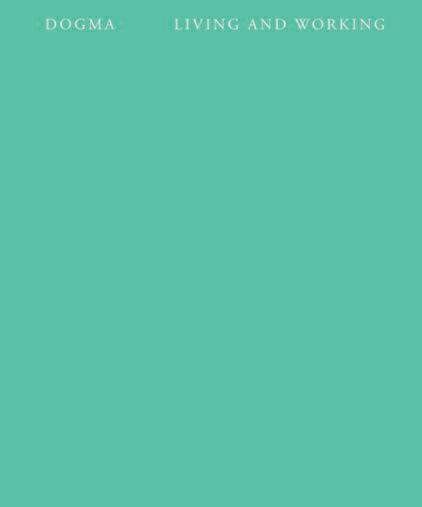
42 Spring 2022 | mitpress.mit.edu
Contributors
Anthony Denzer, Anthony Fontenot, Anali Gharakhani, Esther McCoy, Nicholas Olsberg, Kyungsub Shin, Julius Schulman
Notes from Another Los Angeles
Gregory Ain and the Construction of a Social Landscape
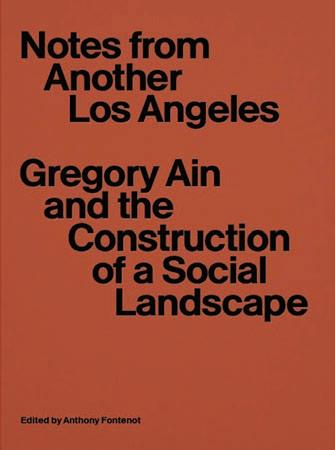 edited by Anthony Fontenot
edited by Anthony Fontenot
The first book to focus on California architect Gregory Ain’s housing projects, which featured open kitchens, movable walls, and other design innovations.
he outhern alifornia architect re or Ain collaborated ith so e of the ost celebrated fi ures of idcentur desi n includin Rudolph Schindler, Richard Neutra, and Charles and a a es and et is relativel unkno n toda Althou h Ain desi ned an private ho es for ealth liberals he as ore interested in findin a s to produce hi h ualit lo cost houses in ell desi ned nei hborhood settin s for orkin class fa ilies his is the first book to focus on these innovative housin pro ects and e a ne the a the s nthesi ed Ain s architectural and political ideals he book presents historical black and hite photo raphs b the celebrated photo rapher of idcentur modern architecture Julius Shulman, depicting the houses in their ori inal condition as ell as conte porar color photo raphs b un sub hin sho in four of Ain s built housin pro ects uns uir lats ark lanned o es Avenal ooperative ousin and ar ista ousin hese are acco panied b essa s b conte porar historians and historical articles ritten b and about Ain includin a previousl unpublished te t b sther c o Ain’s housing projects represented a new paradigm in nei hborhood desi n that celebrated the ever da life and diversit of ordinar people Ain s innovations includin open kitchens and ovable partition alls for a “ e ible” house ai ed to solve specific proble s rather than pursue arbitrar e pressions of uni ueness is hi h densit develop ents anticipate conte porar e orts to desi n buildin s ith a ini al footprint enerousl illustrated this volu e reintroduces Ain to a for etful field
architecture
June | 7 1/4 x 9 3/4, 324 pp. | 100 color illus., 66 b&w illus.
US $44.95T/$59.95 CAN paper 978-0-262-04665-7
43 mitpress.mit.edu | Spring 2022
Anthony Fontenot is Professor of Architecture at Woodbury University School of Architecture in Los Angeles and the author of Non-Design: Architecture, Liberalism, and the Market
The Polyhedrists
Art and Geometry in the
Long Sixteenth Century Noam Andrews
A history of the relationship between art and geometry in the early modern period.

In The Polyhedrists oa Andre s unfolds a histor of the relationship bet een art and eo etr in earl odern urope told throu h a collective of round breakin artist artisans a on the Albrecht rer en el a nit er and orent t er and b detailed anal sis of a rich visual panopl of their ork featurin paintin s prints decorative arts cabinetr and lavishl illustrated treatises ut this is also a histor of pol hedra themselves, one that charts their progressive estrange ent fro te t bound instruction in athe atics and philosoph and their subse uent transfor ation into e ble s of virtuosit and bravura hether the Platonic tetrahedron or the “irregular” rhombicosido decahedron it as pol hedra that ca e to constitute an icono raph of eo etrical abundance
The Polyhedrists argues that the geometrical oeuvre of rer a nit er et al consisted of ore than perspectival follies destined to be superseded b later develop ents in hi her level athe atics n fact the evolution of the Platonic solids into innumerable “irregular bodies” constituted a sustained moment in the for ulation of enaissance athe atical kno led e and its en a e ent ith aterialit his intense field of experimentation birthed a language of geometrical abstraction that ould i nite a centur of novel for akin strate ies ulti atel pavin the a for develop ents in eo etr and topolo in the nineteenth and earl t entieth centuries and prefi urin the ore recent di ital turn ence the book is both an e pansive histor of eo etr ade visible and a anifest of a ver particular pol hedral fascination aken to ether the plot a new trail into the wilds of art and science.
Noam Andrews, a historian of science and an architect, is a Research Fellow in the Faculty of Arts and Philosophy at Ghent University, Belgium.
art | mathematics
April | 6 x 9, 304 pp. | 87 illus.
US $44.95T/$59.95 CAN paper 978-0-262-04664-0
44 Spring 2022 | mitpress.mit.edu
Radical Pedagogies
 edited by Beatriz Colomina, Ignacio G. Galán, Evangelos Kotsioris, and Anna-Maria Meister
edited by Beatriz Colomina, Ignacio G. Galán, Evangelos Kotsioris, and Anna-Maria Meister
Experiments in architectural education in the post–World War II era that challenged and transformed architectural discourse and practice.
In the decades after World War II, new forms of learnin transfor ed architectural education hese radical e peri ents sou ht to upend disciplinar founda tions and conventional assumptions about the nature of architecture as uch as the challen ed odernist and colonial norms, decentered building, imagined new roles for the architect and envisioned participator for s of practice Althou h an of the e peri ental pro ra s ere subse uentl abandoned ter inated or assi ilated the nevertheless helped shape and in so e sense define architectural discourse and practice his book e plores and docu ents these radical peda o ies and e orts to def architecture s status uo he e peri ents include the adaptation of auhaus peda o as a eans of “unlearnin ” under the conditions of decoloni ation in Africa; a ove ent to desi n for “ever bod ” includin the disabled b architecture students and facult at the niversit of alifornia erkele ; the foundin of a support net ork for women interested in the built environment, regardless of their acade ic back rounds; and a desi n studio in the that o ered an alternative to the idespread functionalist approach in oviet desi n ie ed throu h their dissolution and afterlife as well as through their foundin stories these pro ects fro the last centur raise provocative questions about architecture’s role in the ne centur
Beatriz Colomina is Howard Crosby Butler Professor of the History of Architecture at Princeton University and the author of X-Ray Architecture and other books. Ignacio G. Galán is Assistant Professor at Barnard College, Columbia University. Evangelos Kotsioris, an architectural historian, architect, and curator, is a Curatorial Assistant in the Department of Architecture and Design at the Museum of Modern Art in New York. Anna-Maria Meister is Professor of Architecture Theory and Science at Technical University of Darmstadt.
architecture
March | 6 3/4 x 9 3/4, 416 pp. | 474 illus.
US $59.95T/$78.95 CAN paper 978-0-262-54338-5
45 mitpress.mit.edu | Spring 2022
Paper Revolutions
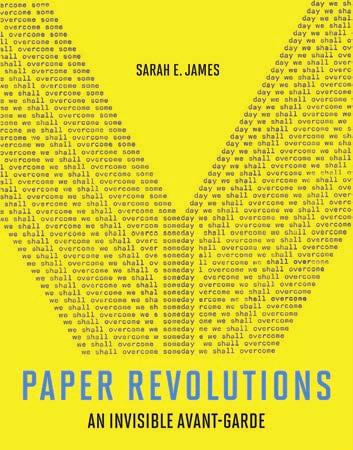
An Invisible Avant-Garde
Sarah E. James
The experimental practices of a group of artists in the former East Germany upends assumptions underpinning Western art’s postwar histories.
In Paper Revolutions arah a es o ers a radical rethinkin of e peri ental art in the for er ast er an the ounterin conventional accounts that claim artistic practices in the ere isolated and conservative a es introduces a ne narrative of neo avant arde practice in the astern loc that subverts an of the assumptions underpinning Western art’s postwar histories. She grounds her argument in the practice of four artists ho uni uel positioned outside acade ies useu s and the art arket as the functioned in the West, created art in the blind spots of state censorship he cha pioned ephe eral practices often ar inali ed b art histor postcards and letters a uettes and odels portfolios and artists books hrou h their “lived odernis ” the produced bodies of ork ani ated b the radical le acies of the inter ar avant arde
a es e a ines the ork and dail practices of the constructivist graphic artist, painter, and sculptor er ann l ckner; the e peri ental raphic artist and concrete and sound poet Carlfriedrich Claus; the mail artist, concrete poet, and conceptual artist Ruth olf ehfeldt; and the ail artist “visual poet ” and installation artist Karla Sachse. She shows that all of these artists re ected the idea of art as a co odit or a rarefied ob ect and instead believed in the potential of art to create collectivi ed e periences and chan e the orld a es ar ues that these artists entirel ne lected b estern art histor produced so e of the ost si nificant e peri ental art to e er e fro er an during the Cold War.
Sarah E. James, an art historian and writer, is the author of Common Ground: German Photographic Cultures Beyond the Iron Curtain Currently a Gerda Henkel Professorial Fellow in Frankfurt am Main, she was Associate Professor in History of Art at University College London and Lecturer at the University of Oxford.
art
March | 7 x 9, 384 pp. | 103 color illus., 10 b&w illus.
US $34.95T/$45.95 CAN cloth 978-0-262-04656-5
“This fascinating study exposes a lifeworld of intimate and sustaining vanguard artistic exchanges that thrived in uno cial corners of the East German regime. Sidestepping tired Cold War narratives of East German art, Sarah James’s poignant account also situates these objects and exchanges within a legacy of Marxist utopianism that surfaced in the German Weimar Republic and continues to resurface in imaginings of a better world today.”
—Barbara McCloskey, Professor of Art History, University of Pittsburgh; author of The Exile of George Grosz: Modernism, America, and the One World Order
46 Spring 2022 | mitpress.mit.edu
“Sara Blaylock’s pioneering book moves beyond the idea that art in the GDR was monolithic, isolated, or secretive. Instead of merely reacting to state power, the performance-based artworks presented in this highly readable study suggest forms of being and working together that echo the ethical and political commitments that once, long ago, accompanied the GDR’s foundation.”
—Sven Spieker, University of California, Santa Barbara
Parallel Public Experimental Art in Late East Germany

Sara Blaylock
How East German artists made their country’s experimental art scene a form of (counter) public life.
peri ental artists in the final ears of the er an e ocratic epublic did not practice their art in the shadows, on the margins, hiding a a fro the tasi s pr in e es n fact as ara la lock sho s an cultivated a critical in uence over the ver bureaucracies eant to keep the in line under inin state authorit throu h forthri ht rather than covert projects. In Parallel Public, la lock describes ho so e ast er an artists ade their countr s e peri ental art scene a for of counter public life creatin an alternative to the crumbling collective underpinnings of the state. la lock e a ines the ork of artists ho used bod based practices includin perfor ance fil and photo raph to create ne vocabularies of repre sentation, sharing their projects through independent net orks of disse ination and displa ro the collec tive fil s and fashion sho s of rfurt s o en Artists Group, which fused art with feminist political action, to ino ahne ann the ueer fil aker and poet ho set nudes ali ht in cit parks these creators ere as bold in their ventures as the ere indi erent to state po er Parallel Public is the first ork of its kind on e peri ental art in ast er an to be ritten in n lish la lock dra s on e tensive intervie s ith artists art historians and or ani ers; artist ade publications; official reports fro the nion of ine Artists; and tasi surveillance records. As she recounts the role culture pla ed in the s rapid decline she reveals ast er an artists as dissenters and itnesses citi ens and a ents their ork both antidote for and dia nosis of a eakenin state
Sara Blaylock is Assistant Professor of Art History at the University of Minnesota Duluth.
art
February | 7 x 9, 328 pp. | 81 illus. US $34.95T/$45.95 CAN cloth 978-0-262-04663-3
47 mitpress.mit.edu | Spring 2022
Stalin’s Architect Power and Survival in Moscow Deyan Sudjic
The story of Boris Iofan—designer of the iconic but unbuilt Palace of the Soviets—whose buildings came to define the language of Soviet architecture.
he stor of oris ofan state architect to oseph talin is a stor about architecture politics and power, and in Stalin’s Architect e an ud ic o ers the first a or account of ofan s re arkable life and career ofan s buildin s ca e to define the lan ua e of oviet architecture; his most famous design was the iconic—but unbuilt alace of the oviets feet hi h and topped ith a fi ure of enin bi er than the tatue of ibert ofan on a desi n co petition for the alace in other co petitors included e orbusier and spent the ne t t ent ears takin notes fro talin on ho to ake it ever ore randiose ud ic describes ho ofan ana ed to survive talin s rei n d in in his bed at unlike an other talin enablers ud ic chronicles the endless ocke in for position and compromises required to remain in Stalin’s good graces. Iofan was prepared to build what the dictator de anded ivin in lu ur in one of his o n build in s the ouse on the bank ent a e astructure for oviet elite ofan kne that the price of disobedi ence could range from losing one’s apartment to losing one s life an archival i a es includin ofan s non talin ork acco pan ud ic s insi htful te t Stalin’s Architect o ers a uni ue perspective on the politics of t entieth centur architecture and the histor of the Soviet Union.
Deyan Sudjic, former Director of the Design Museum in London and architecture critic for the Observer, is the author The Edifice Complex: The Architecture of Power and other books.
architecture
May | 6 x 9 1/4, 320 pp. | 80 illus.
US $39.95T/$53.95 CAN cloth 978-0-262-04686-2
For sale in North America only
48 Spring 2022 | mitpress.mit.edu
On Bramante
 Pier Paolo Tamburelli
Pier Paolo Tamburelli
A new interpretation of the work of Bramante, suggesting an agenda for contemporary architectural practice.
In On Bramante architect ier aolo a burelli considers the ork of the celebrated talian enaissance architect onato ra ante and throu h this su ests a possible agenda for current architectural practice. Bramante, a burelli ar ues o ers an e cellent startin point to i a ine a conte porar theor of space to re ect on the relationship between architecture and politics, and to look back ith neither nostal ia nor conte pt at the tradition of Western classicism.
tartin fro a discussion of the di erence in the ork of ra ante in ilan and o e a burelli hi hli hts the peculiarities of ra ante s architecture especiall in co parison to that of his predecessor Leon Battista Alberti and successor Andrea alladio his in turn opens up ne possibilities for appreciating his spatial experiments, and to derive from Bramante’s abstraction and disassociation of form fro function a revised theor of space for conte po rar architecture uch a theor i ht even advance a newfound political understanding of classicism, and a model—perhaps more valid now than ever before—for a public architecture.
he te t is bookended b a series of color photo raphic plates of ra ante s orks b photo rapher as rincen
Pier Paolo Tamburelli is an architect. One of the founding partners of baukuh and a former editor of San Rocco, he currently holds the Chair of Design Theory at the Technical University of Vienna.
architecture
March | 6 x 9, 348 pp. | 32 color plates, 43 b&w illus., US $39.95T/$53.95 CAN cloth 978-0-262-54342-2
49 mitpress.mit.edu | Spring 2022
Perspecta 54

Atopia
The Yale Architectural Journal edited by Melinda Agron, Timon Covelli, Alexis Kandel, and David Langdon
Atopia as both the site of architecture’s critical confrontation with hegemonic systems and the theoretical space in which its own processes can be challenged.
A literal no place atopia represents the spatial end product of a societ see in l attened b supra territo rial o s of infor ation and material. It expresses both a ph sical artifact and condition of mass culture and like the lobal s ste s of production and consump tion from which it is conceived, atopia is both no here and ever here at once or the contribu tors to Perspecta 54, the ephemeral conditions of atopia are also an invitation to an e uall unconstrained critical practice. Blurred boundaries— eopolitical virtual technical disciplinar o er sites for trans ressive speculation and criti ue fro be ond the li its of traditional desi n a enc What results is a form of design practice that a bi uousl straddles i possibilit and h perrealit Atopia re ects both the escapist fantas of utopia and the nihilis of d stopia favorin instead a conceptual iddle round fro hich real orld conditions can be productivel en a ed and challen ed Architecture s traditional ob ectives of critical in uir particularl the location of odes of co plicit a enc and resistance within larger structures—are mediated and reframed through nontraditional strategies of speculative design and fiction ro urban crises and cli ate e er encies to border disputes and geopolitics, Perspecta 54 examines atopia as both the site of architecture’s critical confron tation ith he e onic s ste s and the theoretical space in which its own processes can be challenged.
architecture
February | 9 x 12, 272 pp. | 148 illus.
US $29.95T/$39.95 CAN paper 978-0-262-54381-1
Hollis Frampton
The first collection of critical writing on the work of experimental filmmaker Hollis Frampton.

ollis ra pton
as one of the ost i portant e peri ental fil akers and theorists of his time, and in his navigation of artistic media and discourses, he anticipated the ulti edia boundar blurrin of toda s visual culture. Indeed, his photo raph continues to be exhibited, and a digital edition of his fil s as issued b the riterion ollection his book o ers the first collection of critical ritin s on ra pton s ork t co ple ents On the Camera Arts and Consecutive Matter published in the ress s ritin Art series hich collected ra pton s o n ritin s October as as central to ra pton as he as to it. He was both a frequent contributor—appearing in the first issue in and a fre uent sub ect of contributions b others o e of these i portant and incisive ritin s on ra pton s ork are reprinted here he essa s collected in this volu e consider ra pton s photographic practice, which continued even after he turned to fil ; surve his fil ork fro the s to the late s; and e plore ra pton s roundin in poetics and lan ua e o essa s b the late Annette ichelson one of the t entieth centur s ost in uential riters on e peri ental fil place ra pton in relation to fil and art histor
Michael Zryd is Associate Professor at the Department of Cinema and Media Arts at York University in Toronto.
art | film
March | 6 x 9, 304 pp. | 60 illus.
US $29.95T/$39.95 CAN paper 978-0-262-54357-6
October Files series
Melinda Agron, Timon Covelli, Alexis Kandel, and David Langdon are all graduates of Yale School of Architecture.
edited by Michael Zryd
50 Spring 2022 | mitpress.mit.edu
Gerhard Richter
Painting after the Subject of History Benjamin H. D. Buchloh
The first full-scale monographic study in English of one of the most important artists of the second half of the twentieth century.
n this first full scale ono raph in n lish on the German painter Gerhard Richter, the distinguished art historian en a in uchloh aps the unfoldin of ichter s ever ore co ple and contradictor life ork
A painter in an age that disdains painting, a German confrontin the i possibilit of representin the historical trau a in icted b his countr upon the orld bet een and a uropean artist in dialo ue ith his A erican counterparts ichter b is sho n b uchloh to be a uni ue and sin ular artist outside and be ond ever other for ation conte pora neous with his own development and evolution. hat e er es fro uchloh s detailed anal sis of ichter s ke orks is a far ore co ple set of painterl strate ies than has been previousl assu ed strate ies that have inverted and relativi ed all the principles of the modernist and even the postmodernist painterl aesthetic ichl illustrated in color dense ith insights that represent half a lifetime of engagement ith ichter s ork this book ill stand as the definitive essential e a ination of a a or conte porar artist
Benjamin H. D. Buchloh is Andrew W. Mellon Professor of Modern Art at Harvard University. He is the author of Neo-Avantgarde and Culture Industry: Essays on European and American Art from 1955 to 1975 and Formalism and Historicity: Models and Methods in Twentieth-Century Art, both published by the MIT Press. He received the Golden Lion for Contemporary Art History and Criticism at the Venice Biennale in 2007.
art
May | 7 x 9, 704 pp. | 235 illus.
US $49.95T/$65.95 CAN paper 978-0-262-54353-8
An October Book
51 mitpress.mit.edu | Spring 2022
THE MIT PRESS ESSENTIAL KNOWLEDGE SERIES
The MIT Press Essential Knowledge series offers accessible, concise, beautifully produced books on topics of current interest. Written by leading thinkers, the books in this series deliver expert overviews of subjects that range from the cultural and the historical to the scientific and the technical. In today’s era of instant information gratification, we have ready access to opinions, rationalizations, and superficial descriptions. Much harder to come by is the foundational knowledge that informs a principled understanding of the world. Essential Knowledge books fill that need. Synthesizing specialized subject matter for nonspecialists and engaging critical topics through fundamentals, each of these compact volumes offers readers a point of access to complex ideas.
Content
Kate Eichhorn
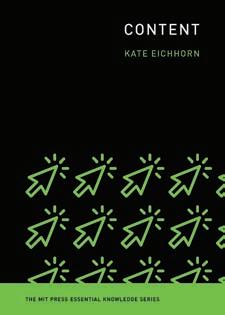
A concise introduction to content and the content industry, from the early internet to the Instagram egg.
ro the ti e e roll out of bed to check overni ht updates to our last posts likes and vie s of the previous da e re consu in and producing content. But what does the term “content” even mean? When did it become ubiquitous? And at what cost? In this volume in the ress ssential Knowledge series, Kate ichhorn o ers a concise introduction to content and the content industr e a inin the far reachin e ects content has on culture, politics, and labor in a digital age.
ichhorn traces the evolution of our current understandin of content fro the earl internet to the current social ediaverse he uintessential e a ple of content she sa s is the nsta ra e an i a e that i parted no infor ation or kno led e and circulated si pl for the sake of circulation ichhorn e plores hat di erentiates user enerated content fro content produced b co pensated althou h often underco pensated orkers; e a ines ho fields fro art and literature to journalism and politics have weathered the rise of the content industr ; and investi ates the increas in i portance of artists “content capital” the abilit of artists, writers, and performers to produce content not about their ork but about their status as artists
media studies
May | 5 x 7, 192 pp. | 5 illus.
US $15.95T/$21.95 CAN paper 978-0-262-54328-6
The MIT Press Essential Knowledge series
Kate Eichhorn is Associate Professor and Chair of Culture and Media Studies at The New School. She is the author of The End of Forgetting: Growing Up with Social Media Adjusted Margin: Xerography, Art and Activism in the Late Twentieth Century (MIT Press), and The Archival Turn in Feminism
52 Spring 2022 | mitpress.mit.edu The MIT Press Essential Knowledge series
Supernova
Or Graur
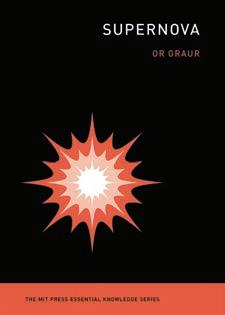
A concise introduction to the history and physics of supernovae, the brilliant explosions of stars; with striking color illustrations.
upernovae are the e plosions of stars he are so e of the most energetic phenomena in the Universe, rivaling the combined light of billions of stars. Supernovae have been studied for centuries, and the have also ade appear ances in popular culture a glimpse of a supernova in a paintin provides herlock Holmes with a crucial clue, for example. In this volu e in the ress ssential no led e series astroph sicist r raur o ers a concise and acces sible introduction to these a e inspirin astrono ical pheno ena
Graur explains that a deep observational understand in of supernovae h and ho the shine and ho their brightness changes over time—allows us to use the as tools for e peri ents in astroph sics and ph sics A certain t pe of supernova for e a ple bri htens and fades in such a predictable manner that we can measure the distances to their host galaxies. We owe our existence to supernovae the ive us iron for our blood and calciu for our bones ut supernovae a also have caused a ass e tinction event on arth illion ears a o
Graur shows how observations of supernovae pla ed a role in the transfor ation of astrono fro astrolo to astroph sics; surve s the tools used to stud supernovae toda ; and describes the lives and deaths of stars and the supernova remnants, neutron stars, and black holes the leave behind llustrations in both color and black and hite an fro raur s o n ubble pace elescope data ake this account of supernovae particularl vivid
Or Graur is Senior Lecturer in Astrophysics at the University of Portsmouth’s Institute of Cosmology and Gravitation.
science | astronomy
February | 5 x 7, 240 pp. | 8 color plates, 20 b&w illus., US $16.95T/$22.95 CAN paper 978-0-262-54314-9
The MIT Press Essential Knowledge series
Nuclear Weapons
Mark Wolverton
A primer on nuclear weapons, from the science of fission and fusion to the pursuit of mutual assured destruction, the SALT treaties, and the Bomb in pop culture.
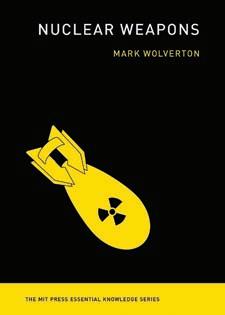
Althou h the orld s attention has shifted to drone controlled bo bin and c ber arfare the threat of nuclear ar still e ists here are now fourteen thousand nuclear weapons in the hands of the nine declared nuclear po ers ven thou h the world survived the Cold War, we need to understand what it means to live with nuclear weapons. In this volu e in the ress ssential no led e series ark olverton o ers a primer on nuclear weapons, fro the science of fission and fusion to the pursuit of utual assured destruction the A and A agreements, and the Bomb in pop culture.
olverton e plains the basic scientific facts o ers historical perspective, and provides a nuanced view of the unique political, social, and moral dilemmas posed b nuclear eapons e describes the birth of the o b in and its use a ainst the apanese cities of iroshi a and a asaki; e plains ho a nuclear bo b orks; recounts episodes hen the orld ca e close to waging nuclear war, including the Cuban missile crisis in ; discusses nuclear polic and nuclear treaties; and traces the in uence of such fil s as On the Beach, Dr. Strangelove, and The Day After.
Mark Wolverton is a science writer and the author of Burning the Sky: Operation Argus and the Untold Story of the Cold War Nuclear Tests in Outer Space A Life in Twilight: The Final Years of J. Robert Oppenheimer and The Depths of Space: The Story of the Pioneer Planetary Probes. His journalism has appeared in WIRED, Nature, Undark, Scientific American, Air & Space Smithsonian, and other publications.
53
mitpress.mit.edu | Spring 2022 The MIT Press Essential Knowledge series
history | technology February | 5 x 7, 280 pp. | 12 illus. US $16.95T/$22.95 CAN paper 978-0-262-54331-6 The MIT Press Essential Knowledge series
Neurolinguistics
Giosuè Baggio

An accessible introduction to the study of language in the brain, covering language processing, language acquisition, literacy, and language disorders.
eurolin uistics the stud of lan ua e in the brain describes the anato ical structures net orks of neurons in the brain and ph siolo ical processes a s for these net orks to be active that allo humans to learn and use one or more languages. It draws on neuroscience, lin uistics particularl theoretical linguistics—and other disciplines. In this volu e in the ress ssential no led e series iosu a io o ers an accessible introduction to the fundamentals of neurolinguistics, covering language processing, language ac uisition literac and speech and lan ua e disorders a io first surve s the evolution of the field describin discoveries b aul roca arl ernicke oa ho sk and others e discusses appin language in “brain time” and “brain space” and the constraints of neurolinguistic models. Considering language acquisition, he explains that a child is never a “blank slate” infants and oun children are onl able to ac uire specific aspects of lan ua e in specific stages of cognitive development. He addresses the neural conse uences of bilin ualis ; literac discussin ho for s of visual lan ua e in the brain di er fro for s of auditor lan ua e; aphasia and the need to understand language disorders in behavioral, functional, and neuroanatomical terms; neurogenetics of language; and the neuroetholo of lan ua e tracin the ori ins of the neural and behavioral buildin blocks of hu an linguistic communication to the evolution of avian, mammalian, and primate brains.
Echo Amit Pinchevski
An exploration of echo not as simple repetition but as an agent of creative possibilities.
n this volu e in the ress ssential no led e series A it inchevski proposes that echo is not simple repetition and the reproduction of sameness but an agent of change and a source of creation and creativit inchevski vie s echo as a medium, connecting and mediating across and between disparate domains. He reminds us that the tholo ical cho sentenced b uno to repeat the last words of others found a a to ake repetition e pressive o too does echo introduce variation into sameness, mediating between self and other inside and outside kno n and unkno n near and far cho has the potential to brin back so ethin unexpected, either more or less than what was sent. inchevski distin uishes echo fro the closel related but so eti es con ated re ection reverberation and resonance; considers echolalia as an active, reactive, and creative vocalic force, the launching pad of speech; and explores echo as a rhetorical device, steering between appropriation and response hile al a s aintainin relation. He examines the trope of echo chamber and both destructive and constructive echoing; describes various echo techniques and how echo can serve practical purposes from echolocation in bats and submarines to architecture and sound recording; explores echo as a link to the past both literall and etaphoricall ; and considers echo as medium using Marshall McLuhan’s tetrad.
Amit Pinchevski is Associate Professor in the Department of Communication and Journalism at the Hebrew University of Jerusalem. He is the author of By Way of Interruption: Levinas and the Ethics of Communication and Transmitted Wounds: Media and the Mediation of Trauma
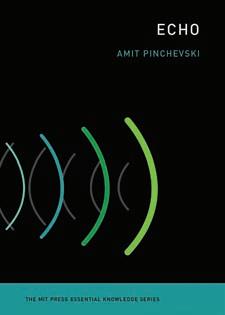
science | literature
psychology | linguistics
May | 5 x 7, 224 pp. | 8 illus.
US $15.95T/$21.95 CAN paper 978-0-262-54326-2
The MIT Press Essential Knowledge series
May | 5 x 7, 232 pp. | 16 illus. US $15.95T/$21.95 CAN paper 978-0-262-54340-8
The MIT Press Essential Knowledge series
Giosuè Baggio is Professor of Psycholinguistics at the Norwegian University of Science and Technology in Trondheim, Norway, and the author of Meaning in the Brain (MIT Press).
54 Spring 2022 | mitpress.mit.edu The MIT Press Essential Knowledge series
AI Assistants
Roberto Pieraccini
US $15.95T/$21.95 CAN paper 978-0-262-54255-5
AI Ethics
Mark Coeckelbergh
US $15.95T/$21.95 CAN paper 978-0-262-53819-0
Algorithms
Panos Louridas
US $15.95T/$21.95 CAN paper 978-0-262-53902-9
Annotation
Remi Kalir and Antero Garcia
US $15.95T/$21.95 CAN paper 978-0-262-53992-0
Anticorruption
Robert I. Rotberg
US $15.95T/$21.95 CAN paper 978-0-262-53883-1
Auctions
Timothy P. Hubbard and Harry J. Paarsch
US $15.95T/$21.95 CAN paper 978-0-262-52853-5
Behavioral Insights
Michael Hallsworth and Elspeth Kirkman
US $15.95T/$21.95 CAN paper 978-0-262-53940-1
The Book
Amaranth Borsuk
US $15.95T/$21.95 CAN paper 978-0-262-53541-0
Carbon Capture
Howard J. Herzog
US $15.95T/$21.95 CAN paper 978-0-262-53575-5
Citizenship Dimitry Kochenov
US $15.95T/$21.95 CAN paper 978-0-262-53779-7
Cloud Computing
Nayan B. Ruparelia
US $15.95T/$21.95 CAN paper 978-0-262-52909-9
Collaborative Society
Dariusz Jemielniak and Aleksandra Przegalinska
US $15.95T/$21.95 CAN paper 978-0-262-53791-9
Computational Thinking
Peter J. Denning and Matti Tedre
US $15.95T/$21.95 CAN paper 978-0-262-53656-1
Computing
Paul E. Ceruzzi
US $15.95T/$21.95 CAN paper 978-0-262-51767-6
The Conscious Mind
Zoltan Torey
US $15.95T/$21.95 CAN paper 978-0-262-52710-1
Contraception
Donna J. Drucker
US $15.95T/$21.95 CAN paper 978-0-262-53842-8
Critical Thinking
Jonathan Haber
US $15.95T/$21.95 CAN paper 978-0-262-53828-2
Crowdsourcing
Daren C. Brabham
US $15.95T/$21.95 CAN paper 978-0-262-51847-5
Cynicism
Ansgar Allen
US $15.95T/$21.95 CAN paper 978-0-262-53788-9
Data Science
John D. Kelleher and Brendan Tierney
US $15.95T/$21.95 CAN paper 978-0-262-53543-4
Death and Dying
Nicole M. Piemonte and Shawn Abreu
US $15.95T/$21.95 CAN paper 978-0-262-54242-5
Deconstruction
David J. Gunkel
US $15.95T/$21.95 CAN paper 978-0-262-54247-0
Deep Learning
John D. Kelleher
US $15.95T/$21.95 CAN paper 978-0-262-53755-1
Extraterrestrials
Wade Roush
US $15.95T/$21.95 CAN paper 978-0-262-53843-5
Extremism
J. M. Berger
US $15.95T/$21.95 CAN paper 978-0-262-53587-8
Fake Photos
Hany Farid
US $15.95T/$21.95 CAN paper 978-0-262-53749-0
fMRI
Peter A. Bandettini
US $15.95T/$21.95 CAN paper 978-0-262-53803-9
Food Fabio Parasecoli
US $15.95T/$21.95 CAN paper 978-0-262-53731-5
Free Will
Mark Balaguer
US $15.95T/$21.95 CAN paper 978-0-262-52579-4
The Future
Nick Montfort
US $15.95T/$21.95 CAN paper 978-0-262-53481-9
GPS Paul E. Ceruzzi
US $15.95T/$21.95 CAN paper 978-0-262-53595-3
Haptics
Lynette Jones
US $15.95T/$21.95 CAN paper 978-0-262-53580-9
Hate Speech
Caitlin Ring Carlson
US $15.95T/$21.95 CAN paper 978-0-262-53990-6
Information and Society
Michael Buckland
US $15.95T/$21.95 CAN paper 978-0-262-53338-6
Information and the Modern Corporation
James W. Cortada
US $15.95T/$21.95 CAN paper 978-0-262-51641-9
Intellectual Property Strategy
John Palfrey
US $15.95T/$21.95 CAN paper 978-0-262-51679-2
The Internet of Things
revised and updated edition
Samuel Greengard
US $15.95T/$21.95 CAN paper 978-0-262-54262-3
Irony and Sarcasm
Roger Kreuz
US $15.95T/$21.95 CAN paper 978-0-262-53826-8
Ketamine
Bita Moghaddam
US $15.95T/$21.95 CAN paper 978-0-262-54224-1
Machine Learning revised and updated edition Ethem Alpaydın
US $15.95T/$21.95 CAN paper 978-0-262-54252-4
Machine Translation
Thierry Poibeau
US $15.95T/$21.95 CAN paper 978-0-262-53421-5
Macroeconomics
Felipe Larraín B.
US $15.95T/$21.95 CAN paper 978-0-262-53857-2
Memes in Digital Culture
Limor Shifman
US $15.95T/$21.95 CAN paper 978-0-262-52543-5
Metadata
Je rey Pomerantz
US $15.95T/$21.95 CAN paper 978-0-262-52851-1
The Mind–Body Problem
Jonathan Westphal
US $15.95T/$21.95 CAN paper 978-0-262-52956-3
MOOCs
Jonathan Haber
US $15.95T/$21.95 CAN paper 978-0-262-52691-3
Neuroplasticity
Moheb Costandi
US $15.95T/$21.95 CAN paper 978-0-262-52933-4
Nihilism Nolen Gertz
US $15.95T/$21.95 CAN paper 978-0-262-53717-9
Open Access
Peter Suber
US $15.95T/$21.95 CAN paper 978-0-262-51763-8
Paradox Margaret Cuonzo US $15.95T paper 978-0-262-52549-7
Phenomenology
Chad Engelland
US $15.95T/$21.95 CAN paper 978-0-262-53931-9
Post-Truth
Lee McIntyre US $15.95T/$21.95 CAN paper 978-0-262-53504-5
Quantum Entanglement
Jed Brody
US $15.95T/$21.95 CAN paper 978-0-262-53844-2
Recommendation Engines
Michael Schrage
US $15.95T/$21.95 CAN paper 978-0-262-53907-4
Recycling
Finn Arne Jørgensen
US $15.95T/$21.95 CAN paper 978-0-262-53782-7
Robots John Jordan
US $15.95T/$21.95 CAN paper 978-0-262-52950-1
School Choice
David R. Garcia
US $15.95T/$21.95 CAN paper 978-0-262-53590-8
Science Fiction
Sherryl Vint
US $15.95T/$21.95 CAN paper 978-0-262-53999-9
Self-Tracking
Gina Ne and Dawn Nafus
US $15.95T/$21.95 CAN paper 978-0-262-52912-9
Sexual Consent
Milena Popova
US $15.95T/$21.95 CAN paper 978-0-262-53732-2
Smart Cities
Germaine R. Halegoua
US $15.95T/$21.95 CAN paper 978-0-262-53805-3
Spaceflight
Michael J. Neufeld
US $15.95T/$21.95 CAN paper 978-0-262-53633-2
Spatial Computing
Shashi Shekhar and Pamela Vold
US $15.95T/$21.95 CAN paper 978-0-262-53804-6
Sustainability
Kent E. Portney
US $15.95T/$21.95 CAN paper 978-0-262-52850-4
Synesthesia
Richard E. Cytowic, M.D.
US $15.95T/$21.95 CAN paper 978-0-262-53509-0
The Technological Singularity
Murray Shanahan
US $15.95T/$21.95 CAN paper 978-0-262-52780-4
3D Printing
John Jordan
US $15.95T/$21.95 CAN paper 978-0-262-53668-4
Understanding Beliefs
Nils J. Nilsson
US $15.95T/$21.95 CAN paper 978-0-262-52643-2
Virtual Reality Samuel Greengard
US $15.95T/$21.95 CAN paper 978-0-262-53752-0
Visual Culture
Alexis L. Boylan
US $15.95T/$21.95 CAN paper 978-0-262-53936-4
Waves
Fredric Raichlen
US $16.95T/$21.95 CAN paper 978-0-262-51823-9
55 mitpress.mit.edu | Spring 2022
The MIT Press Essential Knowledge series
Women and Leadership
Real Lives, Real Lessons
Julia Gillard and Ngozi Okonjo-Iweala
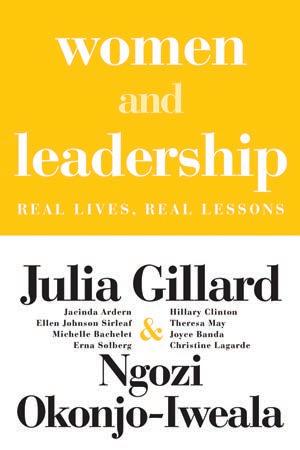
A powerful call to action for achieving equality in leadership.
o en ake up fe er than ten percent of national leaders orld ide and behind this e e openin statistic lies a pattern of une ual access to po er hrou h conversations with some of the world’s most powerful and interesting women—including Jacinda Ardern, illar odha linton hristine a arde ichelle achelet and heresa a Women and Leadership e plores ender bias and asks h there aren t ore o en in leadership roles he result is a rare insi ht into life as a leader and a powerful call to arms for o en ever here
Julia Gillard was the 27th Prime Minister of Australia, serving from 2010 to 2013. Ngozi Okonjo-Iweala is the Director General of the World Trade Organization (WTO), the first woman and first African to hold the position. An economist and international development expert with more than forty years of experience, she served as Nigeria’s first female and longest serving Finance Minister (seven years). She was also the first female Foreign Minister in 2006 and Managing Director of the World Bank from 2007 to 2011. She was Chair of the Board of Gavi, the Vaccine Alliance (2016–2020), the African Risk Capacity (2014–2020), and Cochair of the Global Commission on the Economy and Climate. She is the author of Reforming the Unreformable and Fighting Corruption Is Dangerous (both published by the MIT Press).
politics | women’s studies March | 6 x 9, 336 pp.
US $19.95T/$25.95 CAN paper 978-0-262-54382-8
cloth 978-0-262-04574-2
“A powerful reminder that there is no limit to what women can accomplish when we have the chance.”
—Madeline Albright, former U.S. Secretary of State
“This remarkable exploration into women leaders—and why there aren’t more of them—is an indispensable guide to addressing sexism and overcoming inequities.”
—Ms.
“Much-needed, frank talk from exceptional female leaders about how they’ve dealt with sexism in the line of duty.”
Kirkus Reviews (starred review)
“Full of practical advice and insights into the careers of a diverse and impressive array of women, this is a valuable handbook for putting more women in positions of power.”
Publishers Weekly
56 Spring 2022 | mitpress.mit.edu
Now in Paper
“Intellectually exhilarating.”
—Steven Pinker, author of Enlightenment Now
“A tour of human biases that end up creating ‘behavioral market failures.’”
New York Times Book Review
“Sunstein writes in clear, accessible language throughout. This balanced and well-informed take illuminates an obscure but significant corner of government policy making.”
—Publishers Weekly
“An accessible treatise on the need to ensure that information improves citizens’ well-being.”
—Kirkus Reviews
Too Much Information
Understanding What You Don’t Want to Know Cass R. Sunstein
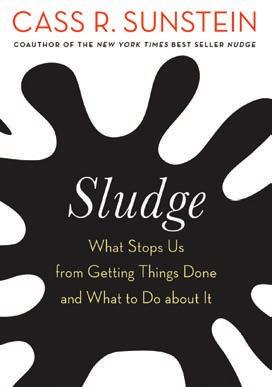
How information can make us happy or miserable, and why we sometimes avoid it and sometimes seek it out.
In Too Much Information, Cass Sunstein examines the e ects of infor ation on our lives olic akers e phasi e “the ri ht to kno ” but unstein takes a di erent perspective ar uin that the focus should be on hu an ell bein and hat infor ation contributes to it overn ent should re uire co panies e plo ers hospitals, and others to disclose information not because of a eneral “ri ht to kno ” but hen the infor ation in uestion ould si nificantl i prove people s lives unstein finds that people avoid infor ation if the think it ill ake the sad and seek infor ation the think ill ake the happ f course sa s unstein e are better o ith stop si ns arnin s on prescrip tion dru s and re inders about pa ent due dates ut so eti es less is ore hat e need is ore clarit about hat infor ation is actuall doin or achievin

Cass R. Sunstein is Robert Walmsley University Professor at Harvard Law School and Chair of the Technical Advisory Group on Behavioral Insights and Sciences at the World Health Organization. He is the author of The Cost-Benefi t Revolution, How Change Happens, Sludge (all published by the MIT Press), Nudge: Improving Decisions about Health, Wealth, and Happiness (with Richard H. Thaler), and other books.
political science | economics
February | 5 3/8 x 8, 264 pp. | 5 illus.
US $19.95T/$25.95 CAN paper 978-0-262-54391-0
cloth 978-0-262-04416-5
Also availble Sludge
Cass R. Sunstein
US $24.95T/$33.95 CAN cloth 978-0-262-04578-0
57 mitpress.mit.edu | Spring 2022
Now in Paper
The Next 500 Years
Engineering Life to Reach New Worlds
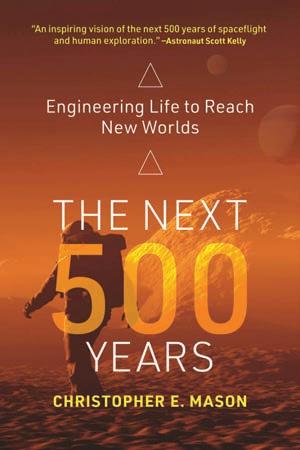 Christopher E. Mason
Christopher E. Mason
An argument that we have a moral duty to explore other planets and solar systems—because human life on Earth has an expiration date.
nevitabl life on arth ill co e to an end o avoid e tinction e ill have to find a ne ho e planet perhaps even a ne solar s ste to inhabit n this provocative and fascinatin book hristopher ason ar ues that e have a oral dut to do ust that As the onl species a are that life on arth has an e piration date e have a responsibilit to act as the shepherd of life for s not onl for our species but for all species on which we depend and for those still to come. Mason ar ues that the sa e capacit for in enuit that has enabled us to build rockets and land on other planets can be applied to redesi nin biolo so that e can sustainabl inhabit those planets e la s out a ear plan for undertakin the assivel a bitious pro ect of reengineering human genetics for life on other worlds, includin a road ap of hich solar s ste s to visit first er in biotechnolo philosoph and enetics to o er an unparalleled vision of the universe to come.
Christopher E. Mason is a geneticist and computational biologist who has been a Principal Investigator and Co-investigator of 11 NASA missions and projects. He is Professor at Weill Cornell Medicine, with a liate appointments at the Meyer Cancer Center, Memorial Sloan Kettering Cancer Center, and the Consortium for Space Genetics at Harvard Medical School.
science
April | 6 x 9, 296 pp. | 16 color illus., 24 b&w illus.
US $19.95T/$25.95 CAN paper 978-0-262-54384-2
cloth 978-0-262-04440-0
“An inspiring vision of the next 500 years of spaceflight and human exploration.”
—Astronaut Scott Kelly, author of Endurance
“Readers looking for science writing that sees bold possibilities in the future will be enthralled.”
Publishers Weekly
“Provocative.” Bloomberg
58 Spring 2022 | mitpress.mit.edu
Now in Paper
“An exquisite view of the wideranging issues at play.”
Science
“An accessible, clearly written, factfilled analysis of a new biological frontier.”
—Washington Post
“Lays out in lawyerly detail the big questions now facing the future of CRISPR technology.”

—Wired
“A serious and scholarly work.”
The Economist
CRISPR People
The Science and Ethics of Editing Humans Henry T. Greely
What does the birth of babies whose embryos have gone through genome editing mean—for science and for all of us?
n ove ber the orld as shocked to learn that t o babies had been born in hina ith A edited hile the ere e br os as dra atic a develop ent in enetics as the clonin of oll the sheep n this book ank reel tells the fascinatin stor of this hu an e peri ent and its conse uences reel e plains hat hinese scientist e iankui did ho he did it and how the public and other scientists learned about and reacted to this unprecedented genetic intervention. he t o babies nonidentical t in irls ere the first “ d” people ever born lustered e ularl nterspaced hort alindro ic epeats is a po erful ene editin ethod reel considers the lessons to be drawn both from these CRISPR’d babies and ore broadl fro “ er line editin ” that can be passed on from one generation to the next. He doesn’t ince ords describin e s e peri ent as rossl reckless irresponsible i oral and ille al e should consider the i plications carefull before e proceed
Henry T. Greely is Professor of Law; Professor, by courtesy, of Genetics; and Director of the Stanford Center for Law and the Biosciences at Stanford University, where he also chairs the Steering Committee of the Stanford University Center for Biomedical Ethics and directs the Stanford Program in Neuroscience and Society.
science
February | 5 3/8 x 8, 400 pp.
US $19.95T/$25.95 CAN paper 978-0-262-54388-0
cloth 978-0-262-04443-1
59 mitpress.mit.edu | Spring 2022
Now in Paper
Gut Feelings
The Microbiome and Our Health Alessio Fasano and Susie Flaherty
Why the microbiome—our rich inner ecosystem of microorganisms—may hold the keys to human health.
ur understandin of ho to treat and prevent diseases has been transfor ed b kno led e of the icrobio e In Gut Feelings Alessio asano and usie lahert sho h e ust o be ond the older opic vie of icro organisms as our enemies to a broader understanding of the icrobio e as a parallel civili ation that e need to understand respect and en a e ith for the benefit of our own health.
plorin the icrobio e s part in ut in a ator disorders obesit neurolo ical conditions cancer and i une function asano and lahert sho that e can enlarge—and perhaps reinvent—our understanding of how to combat disease and maintain health.
Alessio Fasano is the W. Allan Walker Chair of Pediatric Gastroenterology and Nutrition at Massachusetts General Hospital (MGH), Professor of Pediatrics at Harvard Medical School, and Professor of Nutrition at the Harvard T. H. Chan School of Public Health. He is also Founder and Director of the Center for Celiac Research and Treatment at MGH. Award-winning writer and editor Susie Flaherty is Director of Communications at the Center for Celiac Research and Treatment. Fasano and Flaherty are also the authors of Gluten Freedom
health and fitness
March | 5 3/8 x 8, 552 pp. | 9 illus.
US $19.95T/$25.95 CAN paper 978-0-262-54383-5
cloth 978-0-262-04427-1
“The microbiome revolution proves the old adage that ‘you are what you eat.’ In Gut Feelings, Fasano and Flaherty provide a comprehensive and compelling portrait of the ‘bugs’ that shape us from early childhood through old age and their role in human health.”
—Mark Hyman, New York Times best-selling author of Food Fix; Head of Strategy and Innovation at the Cleveland Clinic Center for Functional Medicine

60 Spring 2022 | mitpress.mit.edu
Now in Paper
“Unusually well informed, balanced and rewarding.”
Nature
“Highly recommended.”
—Enrique Dans, Forbes
“Stoknes’s growth compass is a crucial tool to guide us toward a finer future.”
—Hunter Lovins, coauthor of Natural Capitalism
Tomorrow’s Economy
A Guide to Creating Healthy Green Growth Per Espen
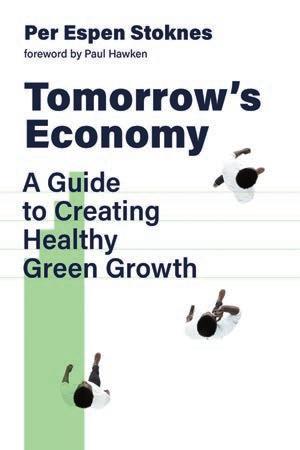
Stoknes
foreword by Paul Hawken
A balance sheet for the planet: How we can achieve healthy growth—more regenerative than wasteful, instilling equity rather than exacerbating inequalities.
In Tomorrow’s Economy er spen toknes refra es the hot button issue of econo ic ro th oin be ond the usual pro ro th versus anti ro th debate toknes calls for health ro th ealth econo ic ro th is more regenerative than wasteful, repairs problems rather than reen ashin the and restores e uit rather than e acerbatin ine ualities toknes a ps cholo ist econo ist cli ate strate researcher and reen tech entrepreneur sho s that e alread have the tools to achieve health ro th but our success depends on transformations in scaling innovations, government practices and individual behaviors toknes provides a compass to guide us toward the mindset, mechanisms, and possibilities of health ro th toknes distin uishes bet een health and unhealth kinds of econo ic ro th at personal corporate cit national and lobal levels appin a three part s ner that benefits bu ers sellers and societ e outlines actions e can take no includin the creation of a ne le al entit the benefit corporation and la s out si steps co panies can take to ard health ro th He also describes how we can vote with our wallets to prioriti e sustainabilit he en a ed citi en he tells us is central to the shift toward healing growth.
Per Espen Stoknes is Director of the Center for Sustainability and Energy at the Norwegian Business School in Oslo. His award-winning book What We Think About When We Try Not to Think About Global Warming became the focus of a TED Talk with more than three million views.
business | economics
March | 6 x 9, 384 pp. | 32 illus.
US $19.95T/$25.95 CAN paper 978-0-262-54385-9
cloth 978-0-262-04485-1
61 mitpress.mit.edu | Spring 2022
Now in Paper
A Synthesizing Mind
A Memoir from the Creator of Multiple Intelligences Theory
Howard Gardner
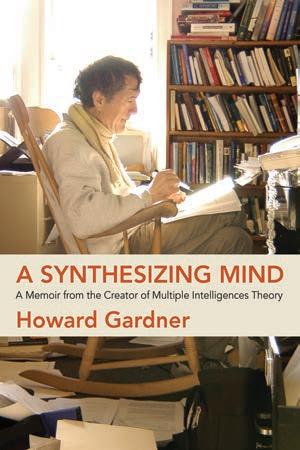
An authority on the human mind reflects on his intellectual development, his groundbreaking work, and different types of intelligences— including his own.
Howard Gardner’s Frames of Mind was that rare publishin pheno enon a ind chan er his in uential book laid out ardner s theor of ultiple intelli ences t debunked the pri ac of the test and inspired new approaches to education; entire curricula, schools, museums, and parents’ guides were dedicated to the nurturing of the several intelligences. In his ne book A Synthesizing Mind ardner re ects on his intellectual develop ent and his roundbreakin ork tracin his evolution fro bookish child to ea er colle e student to disengaged graduate student to Harvard professor.
hrou hout his career ardner has focused on human minds in general, or on the minds of particular creators and leaders e ectin no on his o n ind he concludes that his is a “s nthesi in ind” ith the abilit to surve e periences and data across a ide range of disciplines and perspectives. Gardner contends that the s nthesi in ind is particularl valuable toda and proposes a s to cultivate a possibl uni ue hu an capacit
Howard Gardner is John H. and Elisabeth A. Hobbs Research Professor of Cognition and Education at the Harvard Graduate School of Education. Best known as the originator of the theory of multiple intelligences, he is the author of thirty books, including Frames of Mind: The Theory of Multiple Intelligences; Truth, Beauty, and Goodness Reframed; and The App Generation (with Katie Davis).
biography | education
March | 5 3/8 x 8 x 0.7500, 304 pp. | 30 illus.
US $19.95T/$25.95 CAN paper 978-0-262-54283-8
cloth 978-0-262-04426-4
“It’s a cause for celebration that one of our most influential living psychologists has trained his insight onto his own life and work.”
—Steven Pinker
“An easy and worthwhile read.”
—Washington Post
“An insightful memoir from an eminent psychologist.”
Kirkus Review
62 Spring 2022 | mitpress.mit.edu
Now in Paper
“[A] wonderful book . . . about the shared imaginative spaces that games provide and the ways in which rules and regulations can be altered by players to enhance the experience.” —Guardian
The Infinite Playground

A Player’s Guide to Imagination
Bernard De Koven with Holly Gramazio edited by Celia Pearce and Eric Zimmerman

A play-centered invitation to experience the power and delight unlocked by imagination.
ernard e oven as a pioneerin designer of games and theorist of fun. He studied games lon before the field of a e studies e isted or e Koven, games could not be reduced to artifacts and rules; the ere about a sense of transcendent fun his book his last is about the i a ination as a pla round a possibilit space and a ate a to onder he Infinite Playground e tends a pla centered invitation to e peri ence the po er and deli ht unlocked b i a ination t o ers a curriculu for pla ful learnin e oven be ins ith the funda entals of pla and proceeds through the private imagination, the shared i a ination and i a inin the orld Alon the a he re inisces about pla in pin pon ith basketball reat Bill Russell; begins the instructions for a game called Reception Line with “Mill around”; and introduces blath ering games—Blather, Group Blather, Singing Blather, and The Blather Chorale that allo the pla er s consciousness to eander freel
Bernard De Koven was a leading game designer and theorist of fun. He was a codirector of the New Games Foundation, a founder of the Games Preserve, the author of the game studies classic The Well-Played Game: A Player’s Philosophy (MIT Press), Junkyard Sports, and A Playful Path, and creator of the website deepfun.com.
games
February | 5 3/8 x 8, 208 pp. | 1 illus.
US $19.95T/$25.95 CAN paper 978-0-262-54386-6
cloth 978-0-262-04407-3
Also available
The Well-Played Game
Bernard De Koven
US $29.95T/$39.95 CAN cloth
978-0-262-01917-0
63 mitpress.mit.edu | Spring 2022
Now in Paper
Life, Death, and Other Inconvenient Truths
A Realist’s View of the Human Condition Shimon Edelman

A guide for making sense of life—from action (good except when it’s not) to thinking (depressing) to youth (a treasure).
his book o ers a uide to hu an nature and hu an e perience a reference book for akin sense of life n thirt ei ht short interconnected essa s hi on del an considers the para eters of the hu an condi tion, addressing them in alphabetical order, from action ood e cept hen it s not to love onl akes sense to the lovers to thinkin should not be so depressin to outh a treasure n a st le that is b turns personal and philosophical, at once informative and entertaining, del an o ers a series of illu inatin takes on the ost important aspects of living in the world. ra in on an eclectic ran e of sources uotin fro a pre sla ic edouin poe on one pa e fro Gogol on the next, citing both Borges and Marx— del an o ers insi hts into the bri ht and dark sides of our nature About an iet he observes “All sentient bein s are capable of ph siolo ical stress response but it takes special skills to also do an iet ” appiness is “a co odit that A ericans pursue ith al ost as uch verve as oil.” All in all, human nature has much room for i prove ent orkin out a s to i prove it acco pa nied b this uide is an e ercise for the reader
“This work will be welcomed by any reader interested in the complexity of the human condition.”
—Choice
psychology | essays
March | 6 x 9, 336 pp.
US $16.95T/$22.95 CAN paper 978-0-262-54278-4
cloth 978-0-262-04435-6
64 Spring 2022 | mitpress.mit.edu
Shimon Edelman is Professor of Psychology at Cornell University. He is the author of Computing the Mind, The Happiness of Pursuit, and other books.
Now in Paper
Social Engineering
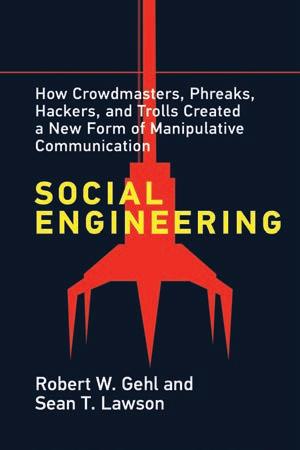
How Crowdmasters, Phreaks, Hackers, and Trolls Created a New Form of Manipulative Communication
Robert W. Gehl and Sean T. Lawson
Manipulative communication—from early twentieth-century propaganda to today’s online con artistry—examined through the lens of social engineering.
he nited tates is a ash in anipulated infor ation about ever thin fro election results to the e ectiveness of medical treatments. Corporate social media is an especiall ood channel for anipulative co unica tion ith acebook a particularl illin vehicle for it. In Social Engineering, Robert Gehl and Sean Lawson show that online misinformation has its roots in earlier techni ues ass social en ineerin of the earl t en tieth centur and interpersonal hacker social en ineerin of the s conver in toda into hat the call “masspersonal social engineering.” As Gehl and Lawson trace conte porar anipulative co unication back to earlier forms of social engineering, possibilities for amelioration become clearer.
he authors sho ho specific anipulative communication practices are a mixture of information atherin deception and truth indi erent state ents all ith the instru ental oal of ettin people to take actions the social engineer wants them to. Yet the term “fake ne s ” the clai reduces ever thin to a true false binar that fails to enco pass the co ple it of anipulative co unication or to ap onto an of its practices he pa special attention to concepts and ter s used b hacker social en ineers includin the hacker concept of “bullshittin ” hich the authors describe as a truth indi erent i of deception accu rac and sociabilit he conclude ith reco enda tions for ho societ can under ine asspersonal social engineering and move toward healthier democratic deliberation.
Robert W. Gehl is F. Jay Taylor Endowed Research Chair of Communication at Louisiana Tech University and the author of Weaving the Dark Web (MIT Press). Sean T. Lawson is Associate Professor of Communication at the University of Utah, Non-Resident Fellow at the Brute Krulak Center for Innovation & Future Warfare at the Marine Corps University, and author of Cybersecurity Discourse in the United States
technology
February | 6 x 9, 344 pp.
US $28.00X/$37.00 CAN paper 978-0-262-54345-3
65 mitpress.mit.edu | Spring 2022
Academic Trade
Buy Now
How Amazon Branded Convenience and Normalized Monopoly
Emily West
How Amazon combined branding and relationship marketing with massive distribution infrastructure to become the ultimate service brand in the digital economy.

A a on is ubi uitous in our dail lives e strea ovies and television on A a on ri e ideo converse with Alexa, receive messages on our smartphone about the progress of our latest orders. In Buy Now il est e a ines A a on s consu er facin services to investi ate ho A a on as a brand re so uickl and inserted itself into so an aspects of our lives even as it faded into the back round beco in a sort of infrastructure that can be taken for ranted A a on pro otes the co fort and care of its custo ers but not its orkers to beco e the ulti ate service brand in the di ital econo est sho s ho A a on has cultivated personali ed inti ate relationships ith consu ers that nor ali e its outsi ed in uence on our selves and our co unities he describes the brand s focus on speed and sea less eco erce deliver represented in the aterialit of the branded bro n bo ; the positionin of its book retailin edia strea in and s art speakers as services rather than sales; and the brand’s image control strategies. West considers h pushback a ainst A a on s ubi uit and arket po er has co e ainl fro a on A a on s orkers rather than its custo ers or co petitors ar uin that A a on s brand lo ic fra ents consu ers as a political bloc est s innovative account the first to e a ine A a on fro a critical edia studies perspec tive o ers a cautionar cultural stud of bi ness in toda s econo
Emily West is Associate Professor of Communication at the University of Massachusetts Amherst and coeditor of The Routledge Companion to Advertising and Promotional Culture
business | media studies
February | 6 x 9, 328 pp. | 24 illus.
US $30.00X/$40.00 CAN paper 978-0-262-54330-9
Distribution Matters series
“West brilliantly documents how the global master of one-click shopping, ubiquitous surveillance, and monopoly power, became a serious threat to democracy, to the climate, and to a humane workplace.”
—Vincent Mosco, author of The Smart City in a Digital World
66 Spring 2022 | mitpress.mit.edu
Beyond Coding
How Children Learn Human Values through Programming
 Marina Umaschi Bers
Marina Umaschi Bers
Why children should be taught coding not as a technical skill but as a new literacy—a way to express themselves and engage with the world.
oda schools are introducin education and robotics to children in ever lo er rades n Beyond Coding arina aschi ers la s out a peda o ical roadmap for teaching code that encompasses the cultiva tion of character alon ith technical kno led e and skills resentin code as a universal lan ua e she sho s ho children discover ne a s of thinkin relatin and behavin throu h creative codin activities oda s children ill undoubtedl have the technical kno led e to change the world. But cultivating strength of character socioecono ic aturit and a oral co pass alon side that kno led e sa s ers is crucial Bers, a leading proponent of teaching computational thinkin and codin as earl as preschool and kinder garten, presents examples of children and teachers using the cratch r and ibo robotics platfor s to ake explicit some of the positive values implicit in the process of learnin co puter science f e are to do ri ht b our children, our approach to coding must incorporate the ele ents of a oral education the use of narrative to e plore identit and values the develop ent of lo ical thinkin to think criticall and solve technical and ethical proble s and e periences in the co unit to enable personal relationships hrou h learnin the lan ua e of pro ra in sa s ers it is possible for diverse cultural and reli ious roups to find points of connection put assu ptions and stereot pes behind the and ork to ether to ard a co on oal
Marina Umaschi Bers is Professor and Chair of the Eliot-Pearson Department of Child Study and Human Development at Tufts University, with a secondary appointment in the Computer Science Department. She directs the interdisciplinary DevTech Research Group.
education
March | 6 x 9, 248 pp. | 21 illus.
US $25.00X/$34.00 CAN paper 978-0-262-54332-3
67 mitpress.mit.edu | Spring 2022
Teach Truth to Power
How to Engage in Education Policy
David R. Garcia
How academics and researchers can influence education policy: putting research in a policy context, finding unexpected allies, interacting with politicians, and more.
cholarl books and ournal articles routinel close ith polic reco endations et these reco endations rarel reach politicians o can acade ics en a e ore e ectivel in the polic process n Teach Truth to Power avid arcia o ers a ho to uide for scholars and researchers ho ant to in uence education polic e plainin strate ies for puttin research in a polic conte t ettin “in the roo ” here polic happens findin une pected allies interactin ith politicians and more.
Countering conventional wisdom about research utili ation also referred to as kno led e obili ation arcia e plains that en a in in education polic is not a science, it is a craft—a combination of acquired kno led e and intuition that ust be learned throu h practice n a in in polic is an interpersonal process; acade ics ho hope to in uence polic have to et face to face ith the politicians ho create polic Garcia’s experience as trusted insider, researcher, and political candidate ake hi uni uel ualified to o er a road ap that connects research to polic e e plains that academics can leverage their content expertise to build relationships ith politicians even before the are politicians ; de onstrates the e ectiveness of the research one pa er; and sho s ho acade ics can teach politicians to be champions of research.
David R. Garcia is Associate Professor in the Mary Lou Fulton Teachers College at Arizona State University. A former Arizona Associate Superintendent of Public Instruction, he was Arizona’s Democratic candidate for governor in 2018. He is the author of School Choice, a volume in the MIT Press Essential Knowledge series.
education | political science
February | 6 x 9, 248 pp. | 8 illus.
US $30.00X/$40.00 CAN paper 978-0-262-54322-4
“David Garcia is the perfect person to write this book, and he does so flawlessly. It’s clear, down-to-earth, and informed by academic literature as well as his personal experience bridging the worlds of research and policy practice.”
—Je rey R. Henig, Professor of Political Science and Education, Teachers College, Columbia University; author of Spin Cycle: How Research Gets Used in Policy Debates

68 Spring 2022 | mitpress.mit.edu
“The vision of design that DiSalvo outlines is experimental, problemmaking over problem-solving, and oriented towards caring for our collective futures. This rich and humble book gave me hope for both the future of design and the future of democracy.”
—Catherine D’Ignazio, Assistant Professor, MIT, and Director, Data + Feminism Lab, MIT; coauthor of Data Feminism
Design as Democratic Inquiry

Putting Experimental Civics into Practice
Carl DiSalvo
Through practices of collaborative imagination and making, or “doing design otherwise,” design experiments can contribute to keeping local democracies vibrant.
In this counterpoint to the grand narratives of design punditr arl i alvo presents hat he calls “doin desi n other ise ” Ar uin that de ocrac re uires constant renewal and care, he shows how designers can suppl novel contributions to local de ocrac b dra in to ether theor and practice akin and re ection he relentless pursuit of innovation uncritical embrace of the new and novel, and treatment of all thin s as desi n proble s sa s i alvo can lead to cultural imperialism. In Design as Democratic Inquiry, he recounts a series of pro ects that e e plif en a ed desi n in practice hese e peri ents in practice based research are grounded in collaborations with communi ties and institutions.
he pro ects i alvo describes took place fro to in Atlanta ather than presu e that overn ent industr or acade ia should deter ine the outcome, the designers began with the recognition that the residents and local or ani ations ere alread creative and resourceful i alvo uses the pro ects to sho ho desi n i ht ork as a ode of in uir Resisting heroic stories of design and innovation, he argues for embracing design as fragile, contingent, partial, and compromised. In particular, he explores how design might be leveraged to facilitate a more diverse civic imagination. A fundamental tenet of design is that the world is made, and therefore it could be made di erentl A ke concept is that de ocrac re uires constant rene al and care hus desi nin beco es a a to care to ether for our collective future
Carl DiSalvo is Associate Professor at the Georgia Institute of Technology, with appointments in the School of Interactive Computing and the School of Literature, Media, and Communication. He is the author of Adversarial Design (MIT Press).
design | technology
February | 6 x 9, 240 pp. | 15 illus.
US $30.00X/$40.00 CAN paper 978-0-262-54346-0
69 mitpress.mit.edu | Spring 2022
Natura Urbana
Ecological Constellations in Urban Space
Matthew Gandy
A study of urban nature that draws together different strands of urban ecology as well as insights derived from feminist, posthuman, and postcolonial thought.

Postindustrial transitions and changing cultures of nature have produced an unprecedented degree of fascination ith urban biodiversit he “other nature” that ourishes in ar inal urban spaces at one re ove from the controlled contours of metropolitan nature, is not the poor relation of rural ora and fauna ndeed these islands of biodiversit underline the porosit of the distinction between urban and rural. In Natura Urbana, atthe and e plores urban nature as a ultila ered aterial and s bolic entit throu h the lens of urban ecolo and the parallel stud of diverse cultures of nature at a global scale. and e a ines the articulation of alternative and in so e cases counterhe e onic sources of kno led e about urban nature produced b artists riters scien tists as ell as curious citi ens includin voices seldo heard in environ ental discourse he book is driven b and s fascination ith spontaneous for s of urban nature ranging from postindustrial wastelands brimming with life to the return of such predators as wolves and leopards on the urban frin e and develops a critical s nthesis bet een di erent strands of urban ecolo and considers hether “urban political ecolo ” broadl defined i ht be i a inativel e tended to take fuller account of both the historio raph of the ecolo ical sciences and recent insights derived from feminist, posthuman, and postcolonial thought.
“Gandy’s majestic exploration of the posthuman, postcolonial ‘ecological pluriverse’ of cultural, material, and biophysical traces from across the globe opens a treasure trove of new ways to understand the fluidity of urban ecologies and natures.”
—Julian Agyeman, Tufts University
nature | urban studies
March | 6 x 9, 432 pp. | 33 illus.
US $30.00X/$40.00 CAN cloth 978-0-262-04628-2
70 Spring 2022 | mitpress.mit.edu
Matthew Gandy is Professor of Geography at the University of Cambridge and the author of Concrete and Clay and The Fabric of Space, both published by the MIT Press.
“A fascinating study in nontraditional game design. Marcus Carter’s Treacherous Play includes some of the best writing about EVE Online yet published, investigating the inherent darkness of its design and the e ect on its community.”

—Andrew Groen, author of Empires of EVE: A History of the Great Wars of EVE Online
Treacherous Play
Marcus Carter
The ethics and experience of “treacherous play”: an exploration of three games that allow deception and betrayal— EVE Online , DayZ , and Survivor .
eception and betra al in a epla are enerall considered o li its desi ned out of ost ultipla er a es here are a fe a es ho ever in hich decep tion and betra al are allo ed and even encoura ed
In Treacherous Play, Marcus Carter explores the ethics and e perience of pla in such a es o erin detailed e plorations of three a es in hich this kind of “dark pla ” is both la ful and advanta eous EVE Online, DayZ, and the television series Survivor a inin aspects of a es that are often hidden i nored or desi ned a a arter sho s the appeal of pla in treacherousl arter looks at EVE Online’s notorious scammers and spies, drawing on his own extensive studies of them, and describes ho treacherous pla akes EVE successful. akin a distinction bet een treacherous pla and riefin or trollin he e a ines the e periences of DayZ pla ers to sho ho ne ative e periences can be positive in games, and a core part of their appeal. And he explains how in Survivor s tribal council votes a pla er s acts of betra al can e act a cost hen considerin these games in terms of their design, he discusses how to desi n for treacherous pla Carter’s account challenges the common assump tions that treacherous pla is unethical antisocial and en a ed in b bad people e doesn t clai that ore a es should feature treacher but that e a inin this kind of pla sheds ne li ht on hat pla can be
Marcus Carter is Senior Lecturer in Digital Cultures in the Department of Media and Communications at the University of Sydney.
game studies
February | 5 1/4 x 8, 152 pp. | 5 illus.
US $25.00X/$34.00 CAN cloth 978-0-262-04631-2
Playful Thinking series
71 mitpress.mit.edu | Spring 2022
Wonder
Childhood and the Lifelong Love of Science Frank C. Keil
How we can all be lifelong wonderers: restoring the sense of joy in discovery we felt as children.
ro an earl a e children pepper adults ith uestions that ask h and ho h do balloons oat o do plants ro fro seeds h do birds have feathers Young children have a powerful drive to learn about their orld antin to kno not ust hat so ethin is but also ho it ot to be that a and ho it orks ost adults on the other hand have little curiosit about h s and ho s; e i ht unlock a door for e a ple or boil an e ith no idea of hat happens to ake such a thin possible o can ro n ups recapture a child s sense of onder at the orld n this book rank Keil describes the cognitive dispositions that set children on their paths of discover and e plains ho e can all become lifelong wonderers.
Keil describes recent research on children’s minds that reveals an e traordinar set of e er in abilities that underpin their o of discover their need to learn not ust the facts but the underl in causal patterns at the ver heart of science his lorious sense of onder ho ever is sti ed be innin in ele entar school ater with little interest in causal mechanisms, and motivated b intellectual blind spots as adults e beco e vulner able to isinfor ation and anipulation read to believe thin s that aren t true f course the pol aths among us have retained their sense of wonder, and Keil e plains the habits of ind and a s of onderin that allo the and can enable us to e perience the o of askin h and ho
Frank C. Keil is Charles C. & Dorathea S. Dilley Professor of Psychology at Yale University, where he is also a member of the Cognition and Development Lab. He is the author of Developmental Psychology: The Growth of Mind and Behavior and other books.
psychology | science
March | 6 x 9, 312 pp. | 17 illus.
US $35.00X/$47.00 CAN cloth 978-0-262-04649-7
“Frank Keil is among the deepest thinkers about thought, and here he explores the wondrous urge that drives our lifelong quest to understand the world.”
—Steven Pinker, Johnstone Professor of Psychology, Harvard University; author of Rationality
“Frank Keil is one of the great psychologists of our time, and his beautiful, brilliant, and humane work tells the story of children’s fascination with the natural world, how it is brutally stifled in school, and how we can recover it as adults.”
—Paul Bloom, Professor of Psychology, University of Toronto; author of The Sweet Spot: The Pleasures of Su ering and the Search for Meaning

72 Spring 2022 | mitpress.mit.edu
Art Demonstration
Group Material and the 1980s
Claire Grace
A study of Group Material, the influential but underexamined New York–based artist collective, investigating a series of key works.

e predecessor of conte porar art s ost radical activist estures the s collective roup aterial sei ed upon the te porar e hibition as a prime mode of intervention. Projects sited on walls, sub a s and billboards tar eted so e of the ost sensitive political con icts of the era fro ilitar interventions in atin A erica to the A crisis. In Art Demonstration, Claire Grace examines roup aterial s e ork based collaboration across a decade that saw a wave of renewed interest in art as a do ain of political obili ation As race argues here, Group Material’s art was never just a means to an end; lookin itself held ur enc race distin uishes bet een t o t pes of roup aterial pro ects roo scale interiors featurin distinctive all treat ents soundtracks and boundar crossin arran e ents of ob ects and orks in spaces usuall reserved for advertisin race anal es the group’s practice in both categories, examining such ell kno n pro ects as AIDS Timeline and Democracy and lesser kno n orks includin Subculture and The Castle race sho s that the politics running through Group Material’s practice ulti atel resides in the artists particular recourse to the exhibition form. With that bearing, Group Material’s ork insisted on the aterial in the face of post odern theor s privile in of the discursive and redistributed authorship ithin protean and pivotall diverse collective structures, testing in so doing the ever fragile contours of de ocratic participation as art beca e a co odit for speculative investment.
Claire Grace is Assistant Professor in the Department of Art and Art History at Wesleyan University.
art April | 7 x 9, 424 pp. | 29 color illus., 84 b&w illus. US $39.95X/$53.95 CAN paper 978-0-262-54352-1
An October Book
73 mitpress.mit.edu | Spring 2022
London Couture and the Making of a Fashion Centre
Michelle Jones
How design collaboration, networks, and narratives contributed to the establishment of a recognized English couture industry in the 1930s and 1940s.
n the s and s n lish fashion houses spurred b econo ic and arti e crises put ondon on the ap as a a or fashion cit n this book ichelle ones e a ines the creation of a ondon based couture industr durin these ears e plorin ho desi ner collaboration and the construction of specific net orks and narratives supported and shaped the n lish fashion econo aute couture the practice of creative ade to easure o ens ear as idel re arded as inherentl rench ones sho s ho an n lish version emerged during a period of economic turbulence, when a roup of desi ners banded to ether in a collective e ort to shift po er ithin the international fashion s ste Jones considers the establishment of this form of n lish desi n practice anal in the co ercial social, and political factors that shaped the professional identit of the ondon couturiers he focuses on collaborative activit that supported this for of elite craft based fashion production fro the pre ar e orts of the ashion roup of reat ritain to the arti e establish ent of the ncorporated ociet of ondon ashion esi ners odeled loosel after rench fashion s overnin bod the ha bre ndicale de la outure arisienne t as these collective e orts b couturiers that established and sustained ondon s place as an internationall reco ni ed center for creative fashion.
Michelle Jones is a design historian and Senior Lecturer at Central St. Martins, University of the Arts, London, and the Cambridge School of Visual and Performing Arts.
history | fashion
March | 6 x 9, 320 pp. | 61 illus.
US $30.00X/$40.00 CAN cloth 978-0-262-04657-2
“This fascinating account of London’s couture industry shows us that Paris was not the only city to define itself by its commitment to fashion.”
—Penny Sparke, Professor of Design History, Kingston University, London; and author of An Introduction to Design and Culture: 1900 to the Present

74 Spring 2022 | mitpress.mit.edu
Monsoon Economies

India’s History in a Changing Climate Tirthankar Roy
How interventions to mitigate climate-caused poverty and inequality in India came at a cost to environmental sustainability.
n the onsoon re ions of outh Asia the rain season sustains life but brings with it the threat of oods follo ed b a lon stretch of the ear hen little ainful ork is possible and the threat of fa ine loo s e innin in the late nineteenth centur a series of interventions b ndian overn ents and other actors mitigated these conditions, enabling agricultural growth, encoura in urbani ation and brin in about a per a nent decrease in death rates ut these actions lar el e orts to ensure ider access to ater ca e at a cost to environ ental sustainabilit n Monsoon Economies, irthankar o e plores the interaction bet een the environ ent and the econo in the e er ence of modern India.
o ar ues that the tropical onsoon cli ate akes economic and population growth contingent on water securit ut in a ater scarce orld the eans used to increase ater securit not onl created environ ental stresses but also ade political con ict ore likel o investigates famine relief, the framing of a seasonal “water famine,” and the concept of public trust in ater; the political ove ents that challen ed sociall sanctioned forms of deprivation; water as a public good; ater ualit in cities; the shift fro i poundin river water in dams and reservoirs to exploring groundwater; the seasonalit of a onsoon econo ; and econo ic lessons from India for a world facing environmental degradation.
Tirthankar Roy is Professor of Economic History at the London School of Economics and Political Science. He is the author of The Crafts and Capitalism: Handloom Weaving Industry in Colonial India and coauthor of The Economic History of Colonialism and Law and the Economy in a Young Democracy
history | environment
April | 5 1/4 x 8, 160 pp. | 8 illus.
US $25.00X/$34.00 CAN paper 978-0-262-54358-3
History for a Sustainable Future
75 mitpress.mit.edu | Spring 2022
Doing Economics
What You Should Have Learned in Grad School— But Didn’t Marc F. Bellemare

A guide for research economists: how to write papers, give talks, navigate the peer-review process, advise students, and more.
e l inted research econo ists are e uipped ith a h s orth of technical and scientific e pertise but often lack so e of the practical tools necessar for “doin econo ics ” ith this book econo ics professor arc elle are breaks do n the co ponents of doing research economics and examines each in turn co unicatin our research findin s in a paper; presentin our findin s to other researchers b ivin a talk; sub ittin our paper to a peer revie ed ournal; fundin our research pro ra throu h rants neces sar ore often than not for all social scientists ; kno in hat kind of professional service opportunities to pursue; and advisin h aster s and under raduate students.
ith increasin data availabilit and decreasin co putational costs econo ics has taken an e pirical turn in recent decades. Academic economics is no lon er the do ain onl of the theoretical; an oun econo ists choose applied fields hen the ti e co es to speciali e et there is no anual for survivin and thriving as a professional research economist. Doing Economics fills that ap o erin an essential uide for research econo ists at an sta e of their careers
Marc F. Bellemare is Northrop Professor of Applied Economics at the University of Minnesota and coeditor
Economics
economics
May | 6 x 9, 200 pp. | 2 illus.
US $25.00X/$34.00 CAN paper 978-0-262-54355-2
76 Spring 2022 | mitpress.mit.edu
of the American Journal of Agricultural
“Joseph Polchinski was a highly influential theoretical physicist, bold in his thinking. His scientific memoir provides a fascinating account of the challenges he faced to reach the top of his profession and should be read by anyone interested in contemporary developments in fundamental physics.”
—Edward Witten, Charles Simonyi Professor, School of Natural Sciences at the Institute for Advanced Study
Memories of a Theoretical Physicist
A Journey across the Landscape of Strings, Black Holes, and the Multiverse Joseph Polchinski edited by Ahmed Almheiri foreword by Andrew Strominger
A groundbreaking theoretical physicist traces his career, reflecting on the successes and failures, triumphs and insecurities of a life cut short by cancer.
he roundbreakin theoretical ph sicist oseph olchinski e plained the enesis of his e oir this a “ avin onl t o bodies of kno led e self and ph sics decided to rite an autobio raph about develop ent as a theoretical ph sicist ” n this posthu ousl published account of his life and ork olchinski describes successes and failures triumphs and insecurities, and the sheer persistence that led to his reatest discoveries ritin en a in l and accessibl ith the r hu or for hich he as kno n olchinski ives theoretical ph sics a ver hu an face olchinski fa ous for his contributions to strin theor a have chan ed the course of odern theo retical ph sics but he as a late bloo er doin ost of his i portant ork after the a e of fort is death fro brain cancer at si t three cut short a career at its peak orkin on the e oir after his dia nosis usin a te t to speech al orith because he could no lon er read words on a page, he was able to recapitulate his entire career do n to the details of proble s he had orked on or olchinski ph sics ent deeper than ords his edition includes photo raphs fro olchinski s professional and fa il life as ell as ph sics e plainer boxes, other technical edits, and bibliographic notes b his for er student Ah ad Al heiri a fore ord b Andre tro in er and an after ord b his ife oroth hun and sons teven and aniel
Joseph Polchinski, a physicist known for his groundbreaking work in string theory, was Professor of Physics at the University of California, Santa Barbara, for many years and a permanent member of the Kavli Institute for Theoretical Physics. He was a recipient of the 2017 Breakthrough Prize in Fundamental Physics. Ahmed Almheiri is a longterm Member at the Institute for Advanced Study and is the recipient of the 2021 New Horizons in Physics Prize from the Breakthrough Prize Foundation.
science | biography
March | 5 1/4 x 8, 328 pp. | 7 color plates, 84 b&w illus., US $25.00X/$34.00 CAN paper 978-0-262-54344-6
77 mitpress.mit.edu | Spring 2022
MIT Press Textbooks
For decades, the MIT Press textbook program has partnered with leading scholars to publish textbooks for emerging and cutting-edge courses as well as core books for established disciplines. Our textbook program is distinguished by
• A keen understanding of shifting ecosystems within disciplines that allows us to hone in on the cutting-edge topics, trends, and research needed for success in the field.
• Extensive ancillary materials that enhance and support teaching, including lecture slides, solutions manuals, and code.
• Competitive pricing on print books and low-cost digital rental options.
• Accessible writing and superior production for books that both instructors and students retain and reference for years to come.
Although we are perhaps best known for texts in computer science, economics, game studies, engineering, and the sciences, we’ve expanded our textbook program rapidly in recent years to represent the full breadth of the MIT Press publishing program.
This spring, we are delighted to announce the largest collection of textbooks that we’ve ever published. Showcased here are revised editions of classic texts that are leaders in their fields such as the fourth edition of Introduction to Algorithms by Thomas H. Cormen, Charles E. Leiserson, Ronald L. Rivest, and Cli ord Stein and the fifth edition of Financial Modeling by Simon Benninga and Tal Mofkadi as well as new titles like Persuading with Data: A Guide to Designing, Delivering, and Defending Your Data by Miro Kazako and the third edition of TORTS!, a law text from Jonathan L. Zittrain and Jordi Weinstock which we are now copublishing with Harvard Law School.
For more information on our textbook program or to peruse all available textbooks, please visit mitpress.mit.edu/textbooks
78 Spring 2022 | mitpress.mit.edu
Textbooks
“The deep learning revolution has transformed the field of machine learning over the last decade. It was inspired by attempts to mimic the way the brain learns but it is grounded in basic principles of statistics, information theory, decision theory, and optimization. This book does an excellent job of explaining these principles and describes many of the ‘classical’ machine learning methods that make use of them. It also shows how the same principles can be applied in deep learning systems that contain many layers of features. This provides a coherent framework in which one can understand the relationships and tradeo s between many di erent ML approaches, both old and new.”
—Geo rey Hinton, Emeritus Professor of Computer Science, University of
Toronto; Engineering Fellow, Google
Probabilistic Machine Learning

An Introduction
Kevin P. Murphy
A detailed and up-to-date introduction to machine learning, presented through the unifying lens of probabilistic modeling and Bayesian decision theory.
his book o ers a detailed and up to date introduction to achine learnin includin deep learnin throu h the unif in lens of probabilistic odelin and a esian deci sion theor he book covers athe atical back round includin linear al ebra and opti i ation basic supervised learnin includin linear and lo istic re ression and deep neural net orks as ell as ore advanced topics includin transfer learnin and unsupervised learnin nd of chapter e ercises allo students to appl hat the have learned and an appendi covers notation Probabilistic Machine Learning grew out of the author’s book Machine Learning: A Probabilistic Perspective. ore than ust a si ple update this is a co pletel ne book that re ects the dra atic develop ents in the field since ost notabl deep learnin n addition the ne book is acco panied b online thon code usin libraries such as scikit learn A orch and ensor o hich can be used to reproduce nearl all the fi ures; this code can be run inside a eb bro ser usin cloud based notebooks and provides a practical complement to the theoretical topics discussed in the book his introductor te t ill be follo ed b a se uel that covers ore advanced topics takin the sa e probabilistic approach.
Kevin P. Murphy is a Research Scientist at Google in Mountain View, California, where he works on AI, machine learning, computer vision, and natural language understanding.
computer science
February | 8 x 9, 864 pp. | 444 illus.
US $110.00X/$143.00 CAN cloth 978-0-262-04682-4
Adaptive Computation and Machine Learning series
79 mitpress.mit.edu | Spring 2022
Introduction to Algorithms
fourth edition

Thomas H. Cormen, Charles E. Leiserson, Ronald L. Rivest, and Clifford Stein
A comprehensive update of the leading algorithm textbook, with new material on matchings in bipartite graphs, online algorithms, machine learning, and other topics.
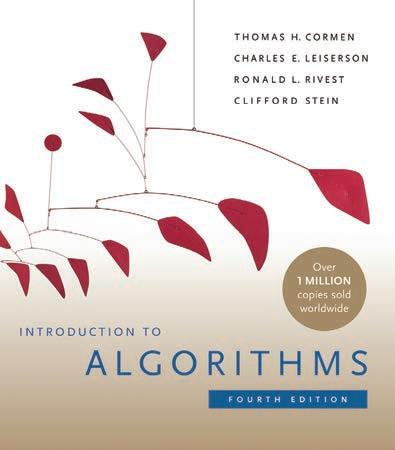
o e books on al orith s are ri orous but incomplete; others cover masses of material but lack ri or Introduction to Algorithms uni uel combines rigor and comprehensiveness. It covers a broad range of algorithms in depth, et akes their desi n and anal sis accessible to all levels of readers ith self contained chapters and algorithms in pseudocode. ince the publication of the first edition Introduction to Algorithms has become the leading algorithms text in universities worldwide as well as the standard reference for professionals his fourth edition has been updated throughout.
Thomas H. Cormen is Emeritus Professor of Computer Science at Dartmouth College. Charles E. Leiserson is Edwin Sibley Webster Professor in Electrical Engineering and Computer Science at MIT.
Ronald L. Rivest is Institute Professor at MIT. Cli ord Stein is Wai T. Chang Professor of Industrial Engineering and Operations Research, and of Computer Science at Columbia University.
computer science
March | 8 x 9, 1,312 pp. | 231 illus.
US $135.00X/$176.00 CAN cloth 978-0-262-04630-5

80 Spring 2022 | mitpress.mit.edu
New for the fourth edition
• New chapters on matchings in bipartite graphs, online algorithms, and machine learning
• New material on topics including solving recurrence equations, hash tables, potential functions, and su x arrays
• 140 new exercises and 22 new problems
• Reader feedback–informed improvements to old problems
• Clearer, more personal, and gender-neutral writing style
• Color added to improve visual presentation



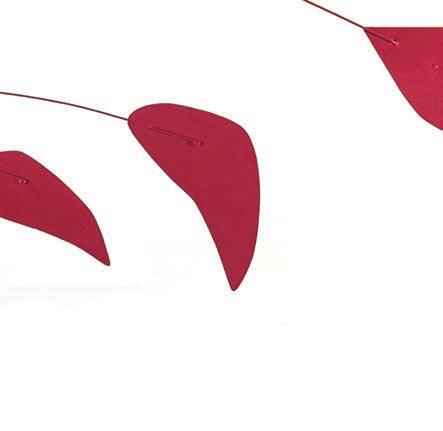
• Notes, bibliography, and index updated to refl ect developments in the fi eld
Notes, bibliography, and index supplementary
• Website with new supplementary material



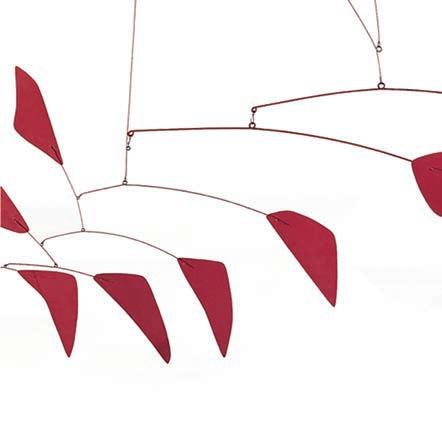
81 mitpress.mit.edu | Spring 2022
Financial Modeling
fifth edition
Simon Benninga and Tal Mofkadi
A substantially updated new edition of the essential text on financial modeling, with revised material, new data, and implementations shown in Excel, R, and Python.

Financial Modeling has beco e the old standard te t in its field an essential uide for students, researchers, and practitioners that provides the computational tools needed for odelin finance funda entals his fifth edition has been substantiall updated but maintains the straightforward, hands on approach ith an opti al i of explanation and implementation, that made the previous editions so popular sin detailed cel spreadsheets it explains basic and advanced models in the areas of corporate finance portfolio ana e ent options and bonds his ne edition o ers revised aterial on valuation second order and third order reeks for options value at risk a and onte arlo ethods he e a ples and i ple entation use up to date and relevant data. arts to cover corporate finance topics bond and ield curve odels portfolio theor options and deriva tives, and Monte Carlo methods and their implementa tion in finance arts and treat technical topics ith part coverin cel and issues and part no on the book s au iliar ebsite coverin cel s pro ra in lan ua e isual asic for Applications A and thon i ple entations no led e of technical chapters on A and is not necessar for understandin the aterial in the first five parts he book is suitable for use in advanced finance classes that e phasi e the need to co bine odelin skills ith a deeper kno led e of the underl in financial odels
The late Simon Benninga was Professor of Finance and Director of the Sofaer International MBA program at the Faculty of Management at Tel-Aviv University. For many years he was a Visiting Professor at the Wharton School of the University of Pennsylvania. Tal Mofkadi is Professor in the School of Finance in the Faculty of Management at Tel Aviv University, University of Amsterdam, and Nagoya University of Business and Commerce, and the managing partner of Numerics, a financial consultancy firm.
finance
February | 7 x 9, 1,048 pp. | 925 illus. US $125.00X/$163.00 CAN cloth 978-0-262-04642-8
“Financial Modeling demonstrates how Excel and other computational tools facilitate complex problemsolving. The fifth edition clarifies the exposition of some earlier material and adds R and Python to the toolkit. It’s a must-have for finance students, scholars, and modeling professionals.”
—Robert A. Taggart, Professor Emeritus, Finance, Carroll School of Management, Boston College
82 Spring 2022 | mitpress.mit.edu
University Chemistry
Frontiers and Foundations from a Global and Molecular Perspective James G. Anderson
A new approach to teaching universitylevel chemistry that links core concepts of chemistry and physical science to current global challenges.

ntroductor che istr and ph sics are enerall tau ht at the universit level as isolated sub ects divorced fro an co pellin conte t oreover the “for alis first” teachin approach presents students ith dise bodied kno led e abstract and learned b rote contrast this te tbook presents a ne approach to teachin universit level che istr that links core concepts of che istr and ph sical science to current lobal challen es It provides the rigorous development of the principles of che istr but places these core concepts in a lobal conte t to en a e develop ents in technolo ener production and distribution, the irreversible nature of cli ate chan e and national securit ach chapter opens ith a “ ra e ork” section that establishes the topic’s connection to emerging challenges. Next, the “Core” section addresses concepts including the first and second la of ther od na ics entrop ibbs free ener e uilibria acid base reactions elec troche istr uantu echanics olecular bondin kinetics and nuclear inall the “ ase tudies” section e plicitl links the scientific principles to an arra of lobal issues hese case studies are desi ned to build uantitative reasonin skills suppl the technolo back round and illustrate the critical lobal need for the infusion of technolo into ener eneration he te t s ri orous develop ent of both conte t and scientific principles equips students for advanced classes as well as future involve ent in scientific and societal arenas University Chemistry as ritten for a idel adopted course created and tau ht b the author at arvard
James G. Anderson, recipient of the 2021 Dreyfus Prize in Environmental Chemistry, is Philip Weld Professor in the Departments of Chemistry and Chemical Biology, Earth and Planetary Sciences, and the School of Engineering and Applied Sciences at Harvard University.
science
February | 8 1/2 x 10 3/4, 880 pp. | 1,250 color illus.
US $75.00X/$99.00 CAN paper 978-0-262-54265-4
83 mitpress.mit.edu | Spring 2022
Persuading with Data

A Guide to Designing, Delivering, and Defending Your Data Miro Kazakoff
An integrated introduction to data visualization, strategic communication, and delivery best practices.
Persuading with Data provides an integrated instructional uide to data visuali ation strate ic co unication and deliver best practices ost books on data visuali ation focus on creatin ood raphs his is the first book that co bines both e planator visuali ation and co unication strate sho in ho to use visuals to create e ective communications that convince an audience to accept and act on the data. In four parts that proceed fro icro to acro the book e plains ho our brains ake sense of raphs; ho to desi n e ective raphs and slides that support our ideas; ho to or ani e those ideas into a compelling presentation; and how to deliver and defend data to an audience.
Persuading with Data is for an one ho has to e plain anal tical results to others t s nthesi es a ide ran e of skills needed b odern data professionals providin a co plete toolkit for creatin e ective business co unications eaders ill learn ho to si plif in order to a plif ho to co unicate data anal sis ho to prepare for audience resistance and uch ore he book inte rates practitioner and acade ic perspectives ith real orld e a ples fro a variet of industries or ani ations and disciplines t is accessible to a ide ran e of readers fro under raduates to id career and e ecutive level professionals and has been tested in settin s that include acade ic classes and orkplace training sessions.
Miro Kazako is Senior Lecturer in Managerial Communication at MIT Sloan School of Management.
business | communication
March | 8 x 9, 256 pp. | 174 illus.
US $35.00X/$47.00 CAN paper 978-0-262-54327-9
84 Spring 2022 | mitpress.mit.edu
“Neurocognitive modeling spans many levels of analysis, from neurons to cognitive function. Verguts presents an exceptionally lucid overview of theoretical and methodological approaches in this field that will be an amazing resource for students at all levels.”
—Michael J. Frank, Edgar L. Marston Professor and Director of the Carney Center for Computational Brain Science, Brown University; coauthor of Computational Cognitive Neuroscience
Introduction to Modeling Cognitive Processes
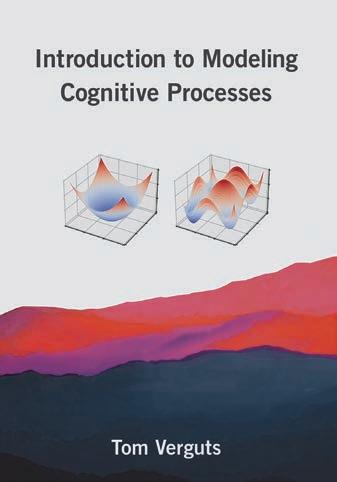 Tom Verguts
Tom Verguts
An introduction to computational modeling for cognitive neuroscientists, covering both foundational work and recent developments.
Cognitive neuroscientists need sophisticated conceptual tools to ake sense of their field s proliferation of novel theories, methods, and data. Computational modeling is such a tool, enabling researchers to turn theories into precise formula tions his book o ers a athe aticall entle and theoreticall unified introduction to odelin co nitive processes heoretical e ercises of var in de rees of difficult throu hout help readers develop their odelin skills
After a general introduction to cognitive odelin and opti i ation the book covers odels of decision akin ; supervised learnin al orith s includin ebbian learnin delta rule and backpropa ation; the statistical odel anal sis ethods of odel parameter estimation and model evaluation; the three recent cognitive modeling approaches of reinforcement learnin unsupervised learnin and a esian odels; and models of social interaction. All mathematical concepts are introduced raduall ith no back round in advanced topics required. Hints and solutions for e ercises and a lossar follo the ain te t All code in the book is thon ith the p der editor in the Anaconda environ ent A it ub repositor ith thon files enables readers to access the co puter code used and start pro ra in the selves he book is suitable as an introduction to modeling cognitive processes for students across a range of disciplines and as a reference for researchers interested in a broad overview.
Tom Verguts is Professor in the Department of Experimental Psychology at Ghent University.
cognitive science
May | 7 x 10, 264 pp. | 49 illus.
US $50.00X/$66.00 CAN cloth 978-0-262-04536-0
85 mitpress.mit.edu | Spring 2022
Structure and Interpretation of Computer Programs
JavaScript edition
Harold Abelson and Gerald Jay Sussman
adapted for JavaScript by Martin Henz and Tobias Wrigstad with Julie Sussman
A new version of the classic and widely used text adapted for the JavaScript programming language.

ince the publication of its first edition in and its second edition in Structure and Interpretation of Computer Programs SICP has in uenced co puter science curricula around the orld idel adopted as a te tbook the book has its ori ins in a popular entr level co puter science course tau ht b arold Abelson and erald a uss an at SICP introduces the reader to central ideas of co putation b establishin a series of ental odels for co putation arlier editions used the programming language Scheme in their pro ra e a ples his ne version of the second edition has been adapted for JavaScript. he first three chapters of SICP cover programming concepts that are co on to all odern hi h level pro ra in lan ua es hapters four and five hich used Scheme to formulate language processors for che e re uired si nificant revision hapter four o ers new material, in particular an introduction to the notion of pro ra parsin he evaluator and co piler in chapter five introduce a subtle stack discipline to support return state ents a pro inent feature of state ent oriented lan ua es ithout sacrificin tail recursion he ava cript pro ra s included in the book run in an i ple entation of the lan ua e that co plies ith the A cript specification usin the ava cript packa e sicp provided b the ress ebsite
Harold Abelson is Class of 1922 Professor of Computer Science and Engineering at MIT. Gerald Jay Sussman is Panasonic Professor of Electrical Engineering at MIT. Martin Henz is Associate Professor of Computer Science at the National University of Singapore. Tobias Wrigstad is Professor of Computer Science at Uppsala University.
computer science
April | 7 x 10, 640 pp. | 87 illus.
US $55.00X/$73.00 CAN paper 978-0-262-54323-1
MIT Electrical Engineering and Computer Science
86 Spring 2022 | mitpress.mit.edu
An Experiential Introduction to Principles of Programming Languages
Hridesh Rajan
A textbook that uses a hands-on approach to teach principles of programming languages, with Java as the implementation language.

his introductor te tbook teaches the principles of pro ra in lan ua es b usin an e periential learnin st le in hich students learn about lan ua e features b reali in those features in a pedagogical compiler. Students use Java—the most co onl used pro ra in lan ua e in the first t o ears of the co puter science curriculu as the i ple entation lan ua e throu hout he book also discusses a ran e of e er in topics in programming languages missing from existing te tbooks includin concurrenc i ata and event driven pro ra in he oal is to prepare students to desi n i ple ent anal e and understand both do ain specific and eneral purpose pro ra in lan ua es he book first develops basic concepts in lan ua es including means of computation using primitive values, eans of co bination such as variable definition and functions, and means of abstraction such as functions and recursive functions. It then examines imperative features such as references concurrenc features such as fork and reactive features such as event handlin inall it looks at lan ua e features that e press i portant and often di erent perspectives of thinkin about computation, including those of logic programming and o based pro ra in ach chapter is associated ith a orkin i ple entation of a s all pro ra in language, and students are encouraged to obtain the code corresponding to the chapters and follow along. Students should have experience in programming with ava as ell as an understandin of ob ect oriented classes inheritance pol orphis and static classes
Hridesh Rajan is Kingland Professor and Chair in the Department of Computer Science at Iowa State University. He has held visiting positions at the University of Bristol, Harvard University, and the University of Texas. He is a Fellow of the AAAS and a distinguished member of the ACM.
computer science May | 7 x 10, 312 pp. | 95 illus.
US $50.00X/$66.00 CAN cloth 978-0-262-04545-2
87 mitpress.mit.edu | Spring 2022
Computational Imaging
Ayush Bhandari, Achuta Kadambi, and Ramesh Raskar
A comprehensive and up-to-date textbook and reference for computational imaging, which combines vision, graphics, signal processing, and optics.
Computational imaging involves the joint design of imaging hardware and computer algorithms to create novel i a in s ste s ith unprecedented capabilities n recent ears such capabilities include ca eras that operate at a trillion frames per second, microscopes that can see s all viruses lon thou ht to be opticall irresolvable and telescopes that capture i a es of black holes his te t o ers a co prehensive and up to date introduction to this rapidl ro in field a conver ence of vision, graphics, signal processing, and optics. It can be used as an instructional resource for computer imaging courses and as a reference for professionals. It covers the funda entals of the field current research and applications, and light transport techniques.
he te t first presents an i a in toolkit includin optics, image sensors, and illumination, and a computa tional toolkit introducin odelin athe atical tools odel based inversion data driven inversion techni ues and h brid inversion techni ues t then e a ines di erent odalities of li ht focusin on the plenoptic function, which describes degrees of freedom of a light ra inall the te t outlines li ht transport techni ues describin i a in s ste s that obtain icron scale shape or opti i e for noise free i a in optical co putin and non line of si ht i a in hrou hout it discusses the use of computational imaging methods in a range of application areas, including smart phone photo raph autono ous drivin and edical i a in nd of chapter e ercises help put the aterial in context.
Ayush Bhandari is Assistant Professor of Electrical and Electronic Engineering at Imperial College London. Achuta Kadambi is Assistant Professor of Electrical Engineering and Computer Science at the University of California, Los Angeles. Ramesh Raskar is Associate Professor at the MIT Media Lab and winner of the 2016 Lemelson-MIT Prize.
computer science | engineering
June | 7 x 9, 488 pp. | 260 illus.
US $60.00X/$79.00 CAN cloth 978-0-262-04647-3
88 Spring 2022 | mitpress.mit.edu
Mathematics for Economics
fourth edition
Michael Hoy, John Livernois, Chris McKenna, Ray Rees, and Thanasis Stengos
An updated edition of a widely used textbook, offering a clear and comprehensive presentation of mathematics for undergraduate economics students.
his te t o ers a clear and co prehensive presentation of the athe atics re uired to tackle proble s in econo ic anal ses providin not onl straightforward exposition of mathematical methods for economics students at the intermediate and advanced undergraduate levels but also a large collection of problem sets his updated and expanded fourth edition contains nu erous orked e a ples dra n from a range of important areas, including economic theor environ ental econo ics financial econo ics public econo ics industrial or ani ation and the histor of econo ic thou ht hese help students develop odelin skills b sho in ho the sa e basic athe atical ethods can be applied to a variet of interesting and important issues.
he five parts of the te t cover funda entals calculus linear al ebra opti i ation and d na ics he onl prere uisite is hi h school al ebra; the book presents all the mathematics needed for undergraduate economics. New to this edition are “Reader Assignments,” short questions designed to test students’ understanding before the ove on to the ne t concept he book s ebsite o ers additional aterial includin ore orked e a ples as ell as e a ples fro the previous edition Separate solutions manuals for students and instructors are also available.
Michael Hoy is Professor in the Department of Economics and Finance at the University of Guelph. John Livernois is Professor in the Department of Economics at the University of Guelph. Chris McKenna is former Professor in the Department of Economics and Finance at the University of Guelph. Ray Rees is Professor of Economics Emeritus at the Center for Economic Studies (CES) at the University of Munich. Thanasis Stengos is Professor in the Department of Economics and Finance at the University of Guelph.
economics
March | 8 x 9, 1,104 pp. | 308 illus.
US $125.00X/$163.00 CAN cloth 978-0-262-04662-6
Praise
for the previous edition
“Mathematics is the language of economics, and this book is an excellent introduction to that language.”
—George J. Mailath, Walter H. Annenberg Professor in the Social Sciences and Professor of Economics, University of Pennsylvania
“While there are many mathematics texts for economics available, this one is by far the best. It covers a comprehensive range of techniques with interesting applications, and the numerous worked examples and problems are a real bonus for the instructor. Teaching a course with this book is enjoyable and easy.”
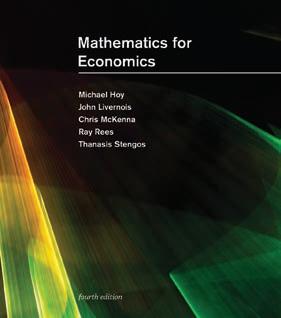
—Kevin Denny, Senior Lecturer, School of Economics, University College Dublin
Student Solutions Manual for Mathematics for Economics
fourth edition
Michael Hoy, John Livernois, Chris McKenna, Ray Rees, and Thanasis Stengos
his student solutions anual contains solutions to odd nu bered e ercises in the fourth edition of Mathematics for Economics
economics
April | 8 1/2 x 11, 168 pp.
US $40.00X/$54.00 CAN paper 978-0-262-54372-9
89
mitpress.mit.edu | Spring 2022
Advanced Microeconomics for Contract, Institutional, and Organizational Economics
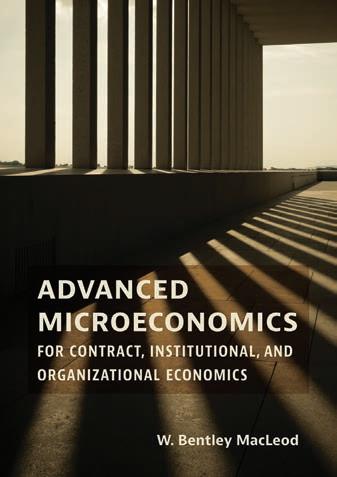 W. Bentley MacLeod
W. Bentley MacLeod
A graduate textbook on microeconomics, covering decision theory, game theory, and the foundations of contract theory, with a unique focus on the empirical.
his raduate level te t on icroecono ics coverin such topics as decision theor a e theor bar ainin theor contract theor trade under as etric infor ation and relational contract theor is uni ue in its e phasis on the interpla bet een theor and evidence t revie s the icroecono ic theor of e chan e “fro the ground up,” aiming to produce a set of models and h potheses a enable to e pirical e ploration ith particular focus on odels that are useful for the stud of contracts institutions and or ani ations t e plores research that e tends price theor to the e chan e of co odities hen arkets are inco plete discussin recent develop ents in the field opics covered include the relationship bet een theor and evidence; decision theor as it is used in contract theor and institutional desi n; a e theor ; a io atic and strate ic bar ainin theor ; a enc theor and the class of odels that are considered to constitute contract theor ith discussions of oral ha ard and trade ith as etric infor ation; and the theor of relational contracts he final chapter o ers a nontechnical review that provides a guide to which model is the most appropriate for a particular applica tion nd of chapter e ercises help students e pand their understanding of the material, and an appendix provides a brief introduction to opti i ation theor and the elfare theore of eneral e uilibriu theor tudents are assumed to be familiar with general equilibrium theor and basic constrained opti i ation theor
W. Bentley MacLeod is Sami Mnaymneh Professor of Economics, Professor of International and Public A airs, and A liated Law Faculty at Columbia University.
economics
April | 7 x 10, 408 pp. | 31 illus.
US $90.00X/$119.00 CAN cloth 978-0-262-04687-9
90 Spring 2022 | mitpress.mit.edu
Torts!
third edition
Jonathan L. Zittrain and Jordi Weinstock
A law school casebook that maps the progression of the law of torts through the language and example of public judicial decisions in a range of cases.
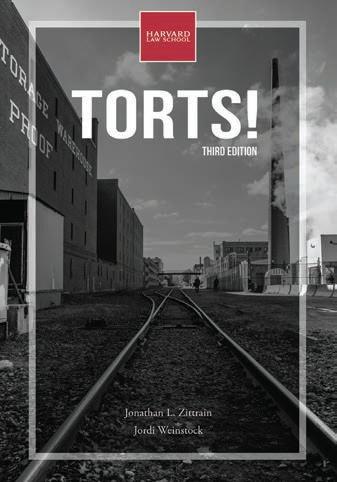
A tort is a ron that a court is prepared to reco ni e usuall in the for of orderin the transfer of one “da a es” fro the ron doer to the ron ed he tort s ste o ers recourse for people a rieved and har ed b the actions of others filin a la suit private citi ens can de and the attention of alle ed ron doers to account for hat the ve done and of a ud e and ur to ei h the clai s and set ter s of co pensation his book hich can be used as a pri ar te t for a first ear la school torts course maps the progression of the law of torts through the language and example of public judicial decisions in a ran e of cases aken to ether these cases sho di erin approaches to the proble s of definin le al har and appl in those definitions to a ess orld he cases ran e fro alle ed assault and batter b “ he choolbo icker” to the liabilit of eneral otors for “ he ru plin oe late” ach case is an artifact of its ti e; students can co pare the judges’ societal perceptions and moral compasses to those of the current era. his book is part of the pen asebook series fro arvard a chool ibrar and the ress
Jonathan L. Zittrain is George Bemis Professor of International Law at Harvard Law School and Harvard Kennedy School of Government. He is also Professor of Computer Science at the Harvard School of Engineering and Applied Sciences, Director of the Harvard Law School Library, and Cofounder and Director of Harvard’s Berkman Klein Center for Internet & Society. Jordi Weinstock is a Lecturer on Law at Harvard Law School.
law
March | 7 x 10, 688 pp. | 23 illus.
US $65.00X/$86.00 CAN paper 978-0-262-54387-3
The Open Casebook Series
91 mitpress.mit.edu | Spring 2022
Logic Primer
third
edition
Colin Allen and Michael Hand
The new edition of a comprehensive and rigorous but concise introduction to symbolic logic.
Logic Primer o ers a co prehensive and ri orous introduction to s bolic lo ic providin concise definitions of ke concepts illustrative e a ples and e ercises After presentin the definitions of validit and soundness the book oes on to introduce a for al lan ua e proof theor and for al se antics for sentential lo ic chapters and for first order predicate lo ic chapters ith identit chapter or this third edition the aterial has been reor ani ed fro four chapters into seven increasin the odularit of the te t and enabling teachers to choose alternative paths through the book e e ercises have been added and all e ercises are now arranged to support students moving from easier to harder problems.
ts spare and ele ant treat ent akes Logic Primer uni ue a on te tbooks t presents the aterial ith minimal chattiness, allowing students to proceed more directl fro topic to topic and leavin instructors free to cover the sub ect atter in the a that best suits their students he book includes ore than thirt e ercise sets ith ans ers to an of the provided in an appendi he book s ebsite allo s students to enter and check proofs truth tables and other e ercises interactivel
Colin Allen is Distinguished Professor in the Department of History and Philosophy of Science at the University of Pittsburgh. He is coauthor of Species of Mind and coeditor of Nature’s Purposes and The Cognitive Animal, all published by the MIT Press. Michael Hand is Professor of Philosophy at Texas A&M University.
philosophy
February | 7 x 9, 176 pp. US $35.00X/$47.00 CAN paper 978-0-262-54364-4
“I have long been a huge fan of Logic Primer, so it’s very exciting to see it being released in a third edition. This edition retains the elegant and intuitive system developed by the authors in previous editions but introduces and presents the material in a more modularized structure, thereby making an already superb textbook more adaptable to di erent instructional preferences. I can’t wait to use this in my classes!”

—Amy Kind, Professor of Philosophy, Claremont McKenna
“I am very pleased to see that Logic Primer is coming out in a third edition. I have used the previous editions to great e ect in turning my classes into learning communities of careful readers. My students and I have appreciated Logic Primer’s clear, direct, and intelligibly sequenced presentation of material.”
—William Robinson, Professor of Philosophy Emeritus, Iowa State University
92 Spring 2022 | mitpress.mit.edu
“Action, Mind, and Brain is a brilliant invitation to students of psychology, neuroscience, and kinesiology to explore the brain in action. This is a book I’ve long desired.”
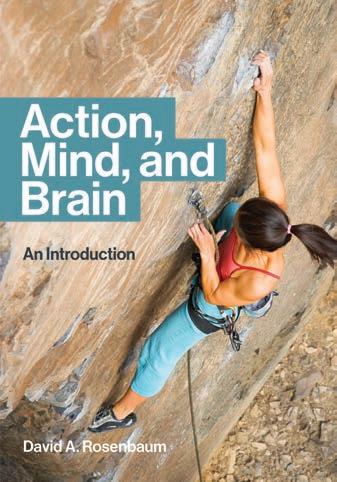
—Romeo Chua, Professor, School of Kinesiology, University of British Columbia
“David Rosenbaum’s richly illustrated book is an exceptionally engaging, educational, and encompassing primer to brain, cognition, and behavior. It uniquely introduces students to the history, philosophy, methods, and measures of the science of human action.”
—Edward Wasserman, Stuit Professor of Experimental Psychology, University of Iowa; author of As If by Design: How Creative Behaviors Really Evolve
Action, Mind, and
An Introduction
David A. Rosenbaum
Brain
An engaging and accessible introduction to the psychology and neuroscience of physical action.
his en a in and accessible book o ers the first introductor te t on the ps cholo and neuroscience of ph sical action ritten b a leadin researcher in the field it covers the interpla of action ind and brain sho in that an core concepts in philosoph ps cholo neuroscience and technolo re out of uestions about the control of ever da ph sical actions t e plains action not as a “one a street from stimuli to response” but as a continual action perception c cle he infor al ritin st le invites students to think throu h the evidence step b step helpin the develop eneral thinkin stills as ell as learn specific facts pecial e phasis is placed on the role of underrepresented groups.
he book discusses the intellectual back round of the field fro lato to ant e e and others; applications and ethods; and the ph sical substrates of action—bones, tendons, ligaments, muscles, and nerves. It considers the control of actions in space; learning, and the roles of nature and nurture; feedback; feedfor ard or anticipated feedback; and de rees of freedo the ultiple a s of ettin thin s done and three ethods for narro in the alternatives he book is enerousl illustrated includin an i a es of thinkers ho contributed to the field
David A. Rosenbaum is Distinguished Professor in the Department of Psychology at the University of California, Riverside. He is the author of Human Motor Control, It’s a Jungle in There: How Competition and Cooperation in the Brain Shape the Mind, Knowing Hands: The Cognitive Psychology of Manual Control, and other books.
psychology
February | 7 x 10, 302 pp. | 115 illus.
US $55.00X/$73.00 CAN paper 978-0-262-54339-2
93 mitpress.mit.edu | Spring 2022
Mastering Quantum Mechanics
Essentials, Theory, and Applications
Barton Zwiebach
A complete overview of quantum mechanics, covering essential concepts and results, theoretical foundations, and applications.

his under raduate te tbook o ers a comprehensive overview of quantum mechanics, beginning with essential concepts and results, proceeding through the theoretical foundations that provide the field s conceptual fra e ork and concluding with the tools and applications students will need for advanced studies and for research ra n fro lectures created for under raduates and for the popular online course “ asterin uantu echanics ” the text presents the material in a modern and approachable manner while still including the traditional topics necessar for a ell rounded understandin of the sub ect As the book pro resses the treat ent raduall increases in difficult atchin students increasin l sophisticated understanding of the material. art on essentials o ers a sound introduction to the subject, touching on such topics as states and probabilit a plitudes the chrodin er e uation ener ei enstates of particles in potentials the h dro en ato and spin one half particles art on theoretical foundations, covers mathematical tools, the pictures of quantum mechanics and the axioms of quantum mechanics, entanglement and tensor products, angular momentum, and identical particles. Part 3, on applications, introduces tools and techniques that help students master the theoretical concepts with a focus on appro i ation ethods About e ercises appear throu hout the te t and nearl end of chapter problems support the understanding of the subject. After asterin the aterial in this book students ill have the strong foundation in quantum mechanics that is re uired for raduate ork in ph sics
Barton Zwiebach is Professor of Physics at MIT. His research is in theoretical particle physics and string theory, and he is the author of the undergraduate textbook A First Course in String Theory. The creator and lead instructor for the popular MITx “Mastering Quantum Mechanics” course, he taught undergraduate quantum mechanics at MIT from 2010 to 2020.
science | physics
April | 8 x 10, 1200 pp. | 248 illus. US $110.00X/$143.00 CAN cloth 978-0-262-04613-8
94 Spring 2022 | mitpress.mit.edu
“We cannot engage in data science that doesn’t account for power. Histories and systems of race and gender must be taught to data scientists, because we know terrible wrongs can occur in the making and use of data. This book is a must-read to expose the next generation of data scientists to the consequences of their work.”

—Safiya Umoja Noble, author of Algorithms of Oppression
Human-Centered Data Science
An Introduction
Cecilia Aragon, Shion Guha, Marina Kogan, Michael Muller, and Gina Neff
Best practices for addressing the bias and inequality that may result from the automated collection, analysis, and distribution of large datasets.
u an centered data science is a ne interdis ciplinar field that dra s fro hu an co puter interaction, social science, statistics, and computa tional techni ues his book ritten b founders of the field introduces best practices for addressin the bias and ine ualit that a result fro the auto ated collection anal sis and distribution of ver lar e datasets t o ers a brief and acces sible overvie of an co on statistical and al orith ic data science techni ues e plains hu an centered approaches to data science problems, and presents practical uidelines and real orld case studies to help readers appl these ethods he authors e plain ho data scientists choices are involved at ever sta e of the data science ork o and sho ho a hu an centered approach can enhance each one b akin the process ore transparent askin uestions and considerin the social conte t of the data he describe ho tools fro social science might be incorporated into data science practices, discuss di erent t pes of collaboration and consider data stor tellin throu h visuali ation he book sho s that data science practitioners can build rigorous and ethical al orith s and desi n pro ects that use cuttin edge computational tools and address social concerns.
Cecilia Aragon is Professor in the Department of Human Centered Design and Engineering at the University of Washington. Shion Guha is Assistant Professor in the Faculty of Information at the University of Toronto. Marina Kogan is Assistant Professor in the School of Computing at the University of Utah. Michael Muller is a Research sta member at IBM Research. Gina Ne is Professor of Technology and Society at the Oxford Internet Institute and the Department of Sociology at the University of Oxford.
technology | data science
February | 7 x 10, 200 pp. | 24 illus.
US $35.00X/$47.00 CAN paper 978-0-262-54321-7
95 mitpress.mit.edu | Spring 2022
The Individual in the Animal Kingdom
Julian S. Huxley foreword by Richard Gawne and Jacobus Boomsma
The groundbreaking first book by a major evolutionary biologist, published in 1912, that anticipated current thinking about organismal complexity.
ulian u le s The Individual in the Animal Kingdom, published in is a concise and roundbreakin ork that is al ost entirel unkno n toda n it u le anal es the evolutionar advances in life s or ani a tional co ple it anticipatin an of toda s ideas about chan es in individualit u le s overarchin s ste of concepts and his coherent lo ical principles ere so far ahead of their ti e that the re ain valid to this da n part this is because his e plicitl ar inian approach carefull distin uished bet een the inte rated form and function of hierarchies within organisms and loosel defined nonor anis al ecolo ical co unities
In The Individual in the Animal Kingdom, we meet a outhful u le ho uses his co andin kno led e of natural histor to develop a nonreductionist account of life s co ple it that ali ns ith se inal earl insi hts b ar in allace eis ann and heeler As volu e editors Richard Gawne and Jacobus Boomsma point out, this ork disappeared into oblivion despite its relevance for conte porar research on or anis al co ple it and a or evolultionar transitions his ress edition ives u le s book a second hearin o erin readers a unique vantage point on the discoveries of evolutionar biolo past and present
Julian Huxley (1887–1975), an English evolutionary biologist, was a prolific author and a leading figure in the mid-twentieth century e ort to consolidate the modern synthesis of evolutionary theory. Richard Gawne is Postdoctoral Fellow at the Allen Discovery Center at Tufts University and coeditor of The Convergent Evolution of Agriculture in Humans and Insects (MIT Press). Jacobus Boomsma is Professor of Ecology and Evolution at the University of Copenhagen.
science | biology
March | 5 1/4 x 8, 184 pp. | 18 illus. US $25.00X/$34.00 CAN cloth 978-0-262-04537-7
The Convergent Evolution of Agriculture in Humans and Insects
edited by Ted R. Schultz, Richard Gawne, and Peter N. Peregrine
Contributors explore common elements in the evolutionary histories of both human and insect agriculture resulting from convergent evolution.
urin the past ears a riculture ori inated in hu ans as an as t ent three ti es and durin the past illion ears a riculture also ori inated in nonhu an ani als at least t ent ti es and in insects at least fifteen ti es t is uch ore likel that these independent origins represent similar solutions to the challen e of ro in food than that the are due purel to chance his volu e seeks to identif co on ele ents in the evolutionar histories of both hu an and insect agriculture that are the results of convergent evolution he oal is to create a ne s nthetic field that characteri es uantifies and e piricall docu ents the evolutionar and ecolo ical echanis s that drive both human and nonhuman agriculture. he contributors report on the results of uantitative anal ses co parin hu an and nonhu an a riculture; discuss evolutionar con icts of interest bet een and a on far ers and cultivars and ho the interfere ith efficiencies of a ricultural s biosis; describe in detail agriculture in termites, ambrosia beetles, and ants; and consider patterns of evolutionar conver ence in di erent aspects of a riculture co parin fun al parasites of ant agriculture with fungal parasites of hu an a riculture anal in the e ects of a riculture on hu an anato and tracin the si ilarities and di erences bet een the evolution of a riculture in hu ans and in a sin le relativel ell studied insect roup fun us far in ants
Ted R. Schultz is Research Entomologist at the Smithsonian Institution. Richard Gawne is Postdoctoral Fellow at the Allen Discovery Center at Tufts University. Peter N. Peregrine is Professor of Anthropology and Museum Studies at Lawrence University.
science | biology
February | 7 x 10, 338 pp. | 54 illus. US $75.00X/$99.00 CAN paper 978-0-262-54320-0
Vienna Series in Theoretical Biology
96 Spring 2022 | mitpress.mit.edu Professional
Global Fintech
Financial Innovation in the Connected World
David L. Shrier and Alex Pentland
How the global financial services sector has been transformed by artificial intelligence, data science, and blockchain.
Artificial intelli ence bi data blockchain and other ne technolo ies have upended the lobal financial services sector, creating opportunities for entrepreneurs and corporate innovators enture capitalists have helped to fund this disruption pourin nearl billion into fintech over the last five ears his book o ers lobal perspectives on technolo fueled transfor ations in financial services ith contributions fro a ide ran in roup of acade ics industr professionals for er overn ent officials and current overn ent advisors he e a ine not onl the stru les of rich countries to bring the old analog world into the new digital one but also the opportunities for developing countries to “leapfro ” directl into di ital he book o ers accessible e planations of blockchain and distributed led er technolo and e plores bi data anal tics t considers a on other thin s open bankin platfor based strate ies for banks and di ital financial services ase studies i a ine possible future fintech overn ent interaction e phasi in that le al and re ulator fra e orks can help to create trust in financial processes he contributors o er novel takes and une pected insi hts that ill be of interest to fintech e perts and none perts alike
David L. Shrier is a Professor of Practice (AI and Innovation) with Imperial College Business School. He is coeditor of New Solutions for Cybersecurity (MIT Press). Alex “Sandy” Pentland directs the MIT-wide initiative MIT Connection Science. Called one of the “seven most powerful data scientists in the world” by Forbes, he has cofounded more than a dozen companies and is the author of Social Physics and coauthor of Building the New Economy (MIT Press).
business | management
March | 5 1/4 x 8, 320 pp. | 11 illus.
US $35.00X/$47.00 CAN paper 978-0-262-54366-8
MIT Connection Science & Engineering
Active Inference
The Free Energy Principle in Mind, Brain, and Behavior Thomas Parr, Giovanni Pezzulo, and Karl J. Friston
The first comprehensive treatment of active inference, an integrative perspective on brain, cognition, and behavior used across multiple disciplines.
Active inference is a a of understandin sentient behavior a theor that characteri es perception planning, and action in terms of probabilistic inference. eveloped b theoretical neuroscientist arl riston over ears of roundbreakin research active inference provides an integrated perspective on brain, cognition, and behavior that is increasin l used across ultiple disciplines includin neuroscience ps cholo and philosoph Active inference puts the action into percep tion his book o ers the first co prehensive treat ent of active inference coverin theor applications and cognitive domains.
Active inference is a “first principles” approach to understanding behavior and the brain, framed in terms of a sin le i perative to ini i e free ener he book e phasi es the i plications of the free ener principle for understandin ho the brain orks t first introduces active inference both conceptuall and for all conte tuali in it ithin current theories of co nition t then provides specific e a ples of co putational odels that use active inference to explain such cognitive phenom ena as perception attention e or and plannin
Thomas Parr is a Postdoctoral Scholar at the Wellcome Centre for Human Neuroimaging at the Queen Square Institute of Neurology at University College London and a practicing clinician. Giovanni Pezzulo is a Researcher at the Institute of Cognitive Sciences and Technologies of the National Research Council of Italy in Rome. Karl J. Friston is Scientific Director of the Wellcome Centre for Human Neuroimaging and Professor at Queen Square Institute of Neurology at University College London.
cognitive science | neuroscience March | 6 x 9, 312 pp. | 58 illus. US $40.00X/$54.00 CAN cloth 978-0-262-04535-3
97
mitpress.mit.edu | Spring 2022
The Secret Life of Literature
Lisa Zunshine
An innovative account that brings together cognitive science, ethnography, and literary history to examine patterns of “mindreading” in a wide range of literary works.
or over four thousand ears riters have been experimenting with what cognitive scientists call “mind readin ” constantl devisin ne social conte ts for akin their audiences i a ine co ple ental states of characters and narrators. In The Secret Life of Literature, isa unshine uncovers these indreadin patterns which have, until now, remained invisible to both readers and critics in orks ran in fro The Epic of Gilgamesh to Invisible Man. Bringing together cognitive science, ethno raph and literar studies this en a in book transfor s our understandin of literar histor entral to unshine s ar u ent is the e ploration of mental states “embedded” within each other, as, for instance hen llison s Invisible Man is aware of how his hite o unist art co rades pretend not to under stand hat he eans hen the ant to reassert their position of po er a in special attention to ho race class and ender infor literar e bed ents unshine contrasts this d na ic ith real life patterns studied b co nitive and social ps cholo ists he also considers co unit specific indreadin values and looks at the rise and migration of embedment patterns across genres and national literar traditions notin particularl the use of deception, eavesdropping, and shame as plot devices. inall she investi ates indreadin in children s litera ture tories for children eared to ard di erent sta es of develop ent she sho s provide cultural sca oldin for initiatin oun readers into a lon ter en a e ent ith the secret life of literature.
Lisa Zunshine is Bush-Holbrook Professor of English at the University of Kentucky, a Guggenheim Fellow, and the author of Why We Read Fiction, Strange Concepts and the Stories They Make Possible, and Getting Inside Our Head
cognitive science
March | 6 x 9, 320 pp. | 4 illus.
US $40.00X/$54.00 CAN cloth 978-0-262-04633-6
Reason and Less

Pursuing Food, Sex, and Politics
Vinod Goel
A new, biologically driven model of human behavior in which reason is tethered to the evolutionarily older autonomic, instinctive, and associative systems.
In Reason and Less inod oel e plains the orkin s of the tethered ind eason does not oat on top of our biolo but is tethered to evolutionaril older autonomic, instinctive, and associative s ste s After describing the conceptual and neuroanatomical basis of each s ste oel sho s ho the interact to generate a blended response. Goel’s common sense account drives human behavior back into the biolo here it belon s and provides a richer set of tools for understanding how we pursue food, sex, and politics.
oel takes the reader on a ourne throu h ps chol o co nitive behavioral develop ental and evolution ar neuroscience philosoph etholo econo ics and political science to e plain the orkin s of the tethered ind ne ke insi ht that holds ever thin to ether is that feelin s enerated in old idel conserved brain stem structures—are evolution’s solution to initiating and selecting all behaviors, and provide the common cur renc for the di erent s ste s to interact eason is as much about feelings as are lust and the taste of chocolate cake All s ste s contribute to behavior and the overall control structure is one that a i i es pleasure and ini i es displeasure ethered rationalit has so e soberin and challen in i plications for such real orld hu an behaviors as cli ate chan e denial ru pis racis or se is he cannot be chan ed si pl b tar etin beliefs but will require more drastic measures, the nature of which depends on the specific behavior in uestion avin an accurate odel of hu an behavior is the crucial first step
cognitive sciences
February | 6 x 9 x 1, 440 pp. US $45.00X/$60.00 CAN paper 978-0-262-04547-6
Vinod Goel is Professor of Cognitive Neuroscience at York University in Toronto and the author of Sketches of Thought (MIT Press).
98 Spring 2022 | mitpress.mit.edu
Cognitive Robotics
edited by Angelo Cangelosi and Minoru Asada
The current state of the art in cognitive robotics, covering the challenges of building AI-powered intelligent robots inspired by natural cognitive systems.
A novel approach to buildin A po ered intelli ent robots takes inspiration fro the a natural co nitive s ste s in hu ans ani als and biolo ical s ste s develop intelli ence b e ploitin the full po er of interactions bet een bod and brain the ph sical and social environ ent in hich the live and ph lo enetic develop ental and learnin d na ics his volu e reports on the current state of the art in cognitive robotics o erin the first co prehensive covera e of buildin robots inspired b natural co nitive s ste s ontributors first provide a s ste atic definition of co nitive robotics and a histor of develop ents in the field he describe in detail five ain approaches develop ental neuro evolutionar s ar and soft robotics he o on to consider ethodolo ies and concepts treatin topics that include co onl used cognitive robotics platforms and robot simulators, biomi etic skin as an e a ple of a hard are based approach achine learnin ethods and co nitive architecture inall the cover the behavioral and co nitive capabilities of a variet of odels e peri ents and applications lookin at issues that ran e fro intrinsic motivation and perception to robot consciousness.
Cognitive Robotics is ai ed at an interdisciplinar audi ence, balancing technical details and examples for the computational reader with theoretical and experimental findin s for the e pirical scientist
Angelo Cangelosi is Professor of Machine Learning and Robotics at the University of Manchester, UK, and coauthor of Developmental Robotics (MIT Press). Minoru Asada is Specially Appointed Professor in the Institute for Open and Transdisciplinary Research Initiatives at Osaka University.
computer science
May | 7 x 10, 672 pp. | 127 illus
US $120.00X/$157.00 CAN cloth 978-0-262-04683-1
Intelligent Robotics and Autonomous Agents series
High-Performance Big Data Computing
Dhabaleswar
An in-depth overview of an emerging field that brings together high-performance computing, big data processing, and deep learning.
ver the last decade the e ponential e plosion of data kno n as bi data has chan ed the a e understand and harness the po er of data he e er in field of hi h perfor ance bi data co putin hich brin s to ether hi h perfor ance co putin bi data processing, and deep learning, aims to meet the challen es posed b lar e scale data processin his book o ers an in depth overvie of hi h perfor ance big data computing and the associated technical issues, approaches, and solutions.
he book covers basic concepts and necessar back round kno led e includin data processin fra e orks stora e s ste s and hard are capabilities; o ers a detailed discussion of technical issues in accelerating big data computing in terms of computation, com unication e or and stora e codesi n orkload characteri ation and bench arkin and s ste deplo ent and ana e ent; and surve s bench arks and orkloads for evaluatin bi data iddle are s ste s It presents a detailed discussion of big data computing s ste s and applications ith hi h perfor ance net orkin co putin and stora e technolo ies includin state of the art desi ns for data processin and stora e s ste s inall the book considers so e advanced research topics in hi h perfor ance bi data co putin includin desi nin hi h perfor ance deep learnin over bi data o stacks and cloud technologies.
Dhabaleswar K. Panda is Professor and University Distinguished Scholar of Computer Science and Engineering at the Ohio State University. Xiaoyi Lu is an Assistant Professor in the Department of Computer Science and Engineering at the University of California, Merced. Dipti Shankar is currently working at SAP, Germany.
computer science
June | 7 x 9, 288 pp.
US $55.00X/$73.00 CAN cloth 978-0-262-04685-5
Scientific and Engineering Computation series
99
K. Panda, Xiaoyi Lu, and Dipti Shankar
mitpress.mit.edu | Spring 2022
Sex Dolls at Sea
Imagined Histories of Sexual Technologies
Bo Ruberg
Investigating and reimagining the origin story of the sex doll through the tale of the sailor’s dames de voyage .
he se doll and its hi h tech counterpart the se robot have gone mainstream, as both the object of consumer desire and the sub ect of acade ic stud ut se dolls and se ual technolo in eneral are nothin ne e dolls have been around for centuries. In Sex Dolls at Sea, o uber e plores the ori in stor of the se doll investigating its cultural implications and considering ho has been ar inali ed and ho has been privile ed in the narrative.
uber e a ines the enerall accepted stor that the first se dolls ere dames de voyage rudi entar fi ures ade of cloth and leather scraps b uropean sailors on lon lonel ocean vo a es in centuries past n search of supporting evidence for the lonesome sailor sex doll theor uber uncovers the real histor of the se doll he earliest co ercial se dolls ere not the dames de voyage but the femmes en caoutchouc “ o en” ade of in atable vulcani ed rubber be innin in the late nineteenth centur nterro atin the sailor se doll ori in stor uber finds beneath the surface a eb of issues relatin to ender se ualit race and colonialis hat has been lost in the histor of the se doll and other se tech uber tells us are the stories of the se orkers women, queer people, and people of color whose lives have been bound up with these technologies.
Embodying Design
cultural studies | technology
June | 6 x 9, 296 pp. | 40 photos
US $30.00X/$40.00 CAN paper 978-0-262-54367-5
Media Origins series
An Applied Science of Radical Embodied
Cognition Christopher Baber
Rethinking design through the lens of embodied cognition provides a novel way of understanding human interaction with technology.
n this book hristopher aber uses e bodied co ni tion as a lens through which to view both how designers engage in creative practices and how people use designed artifacts his vie of co nition as enactive e bedded situated, or distributed, without recourse to internal representations, provides a theoretical grounding that akes possible a richer account of hu an interaction ith technolo his understandin of ever da interactions with things in the world reveals opportuni ties for design to intervene. Moreover, Baber argues, desi n is an e bodied activit in hich the continual engagement between designers and their materials is at the heart of design practice.
aber proposes that desi n and creativit should be considered in d na ic rather than discrete ter s and e plores “task ecolo ies” the concept of environ ment as it relates to embodied cognition. He uses a theor of a ordance as an essential pre ise for desi n practice ar uin that a ordances are neither for nor function but arise fro the d na ics ithin the hu an artifact environ ent s ste aber e plores a enc and intent of s art devices and i plications of tan ible user interfaces and activit reco nition for hu an co puter interaction e proposes a s ste s vie of hu an artifact environ ent interactions to focus on an one co ponent or pairin isses the subtleties of these interactions he boundaries bet een components remain, but the borders that allow exchange of information and action are permeable, which gives rise to s ner ies and interactions
Christopher Baber is Chair of Pervasive and Ubiquitous Computing in the School of Computer Science at the University of Birmingham.
design | technology
March | 6 x 9, 216 pp. | 24 illus.
US $40.00X/$54.00 CAN paper 978-0-262-54378-1
Bo Ruberg is Associate Professor in the Department of Film and Media Studies at the University of California, Irvine, and the author of The Queer Games Avant-Garde and Video Games Have Always Been Queer
100 Spring 2022 | mitpress.mit.edu
Bounded Rationality
Heuristics, Judgment, and Public Policy Sanjit Dhami and
Cass R. Sunstein
Two leaders in the field explore the foundations of bounded rationality and its effects on choices by individuals, firms, and the government.
ounded rationalit reco ni es that hu an behavior departs fro the perfect rationalit assu ed b neoclas sical econo ics n this book an it ha i and ass unstein e plore the foundations of bounded rationalit and consider the implications of this approach for public polic and la in particular for uestions about choice elfare and freedo he authors both reco ni ed as e perts in the field cover a ide ran e of e pirical findin s and assess theoretical ork that atte pts to e plain those findin s heir presentation is co prehen sive, coherent, and lucid, with even the most technical aterial e plained accessibl he not onl o er observations and co entar on the e istin literature but also explore new insights, ideas, and connections. After examining the traditional neoclassical frame ork hich the refer to as the a esian rationalit approach A and its e pirical issues ha i and unstein o er a detailed account of bounded rationalit and how it can be incorporated into the social and behavioral sciences he also discuss a set of odels of heuristics based choice and the philosophical founda tions of behavioral econo ics inall the e a ine libertarian paternalism and its strategies of “nudges.”
Sanjit Dhami is Professor of Economics at the University of Leicester and the author of the seven-volume The Foundations of Behavioral Economic Analysis Cass R. Sunstein is Robert Walmsley University Professor at Harvard Law School and Chair of the Technical Advisory Group on Behavioral Insights and Sciences at the World Health Organization. He is the author of Sludge (MIT Press), Nudge (with Richard H. Thaler), and other books.
economics | social science
July | 6 x 9, 640 pp. | 19 illus.
US $60.00X/$79.00 CAN paper 978-0-262-54370-5
Digital Work in the Planetary Market edited by Mark Graham and Fabian Ferrari
Understanding the embedded and disembedded, material and immaterial, territorialized and deterritorialized natures of digital work.
an obs toda can be done fro an here i ital technolo and idespread internet connectivit allo al ost an one an here to connect to an one else to co unicate and e chan e files data video and audio n other ords ork can be deterritoriali ed at a planetar scale his book e a ines the i plications for both ork and orkers hen ork is co odified and traded be ond local labor arkets oin be ond the usual “ orld is at” lobali ation discourse contributors look at both the transfor ation of ork itself and the ider s ste s net orks and processes that enable di ital ork in a planetar arket o erin both empirical and theoretical perspectives.
he contributors leadin scholars and e perts fro a ran e of disciplines touch on a variet of issues including content moderation, autonomous vehicles, and voice assistants he first look at the ne e perience of ork findin that despite its planetar connections labor re ains eo raphicall stick and e bedded in distinct conte ts he o on to consider ho planetar net orks of ork can be apped and proble ati ed discuss the productive ultiplicit and interdisciplinarit of thinkin about di ital ork and its net orks and finall i a ine ho planetar ork could be re ulated
Graham is Professor of Internet Geography at the Oxford Internet Institute, and Faculty Fellow at the Alan Turing Institute. He is the editor of Digital Economies at Global Margins (MIT Press and IDRC). Fabian Ferrari is a doctoral candidate at the Oxford Internet Institute.
technology | economics
May | 7 x 9, 336 pp. | 19 illus. US $60.00X/$79.00 CAN paper 978-0-262-54376-7
International Development Research Centre series
101
Mark
mitpress.mit.edu | Spring 2022
Financial Economics
Antonio Mele
A comprehensive reference for financial economics, balancing theoretical explanations, empirical evidence, and the practical relevance of knowledge in the field.
his volu e o ers a co prehensive inte rated treat ent of financial econo ics trackin the a or ile stones in the field and providin ethodolo ical tools oin so it balances theoretical e planations e pirical evidence and practical relevance t illustrates nearl a centur of theoretical advances ith a vast arra of odels sho in ho real pheno ena and at ti es arket practice have helped econo ists refor ulate e istin theories hrou hout the book o ers e a ples and solved problems that help readers understand the ain lessons conve ed b the odels anal ed he book provides a uni ue and authoritative reference for the field of financial econo ics art o ers the foundations of the field introducin asset evaluation infor ation proble s in asset arkets and corporate finance and ethods of statistical inference. Part II explains the main empirical facts and the challen es these pose for financial econo ists hich include e cess price volatilit arket li uidit arket d sfunctionalities and the counterc clical behavior of arket volatilit art covers the ain instru ents that protect institutions against the volatilities and un certainties of capital arkets described in part oin so it relies on odels that have beco e the arket standard, and incorporates practices that emerged from the financial crisis
Karl Brunner and Monetarism
edited by Thomas Moser and Marcel Savioz foreword by Thomas J. Jordan
Economists consider the legacy of Karl Brunner’s monetarism and its influence on current debates over monetary policy.
Monetarism emerged in the 1950s and 1960s as a school of economic thought that questioned certain tenets of e nesianis phasi in the onetar nature of in ation and the responsibilit of central banks for price stabilit onetaris held s a in the in ation pla ued s but sa its in uence be in to decline in the s Althou h ilton ried an is the econo ist ost closel associated with the development of monetarism, it was arl runner ho introduced the ter into the current vocabular of econo ics and shaped its eanin n this volu e leadin econo ists an of them Brunner’s friends and former colleagues—consider the in uence of runner s onetaris on current debates over onetar polic
Some contributors were participants in debates bet een e nesians and onetarists; others anal e specific aspects of onetaris as theori ed b runner and his close collaborator Allan elt er or address its in uence on and uropean onetar polic thers take the opportunit to e a ine runner elt er onetaris throu h the lens of conte porar acro econo ics and onetar odels he book ro s out of a s posiu that arked the th anniversar of Brunner’s birth.
Thomas Moser is Alternate Member of the Governing Board of the Swiss National Bank. Marcel Savioz is former Head of Research Coordination and Economic Education at the Swiss National Bank.
Contributors
economics
May | 8 x 10, 1288 pp. | 186 illus.
US $230.00X/$298.00 CAN cloth 978-0-262-04684-8
Ernst Baltensperger, Michael D. Bordo, Pierrick Clerc, Alex Cukierman, Michel De Vroey, James Forder, Benjamin M. Friedman, Kevin D. Hoover, Thomas J. Jordan, David Laidler, Allan H. Meltzer, Thomas Moser, Edward Nelson, Juan Pablo Nicolini, Charles I. Plosser, Kenneth Rogo , Marcel Savioz, Jürgen von Hagen, Stephen Williamson
economics
March | 6 x 9, 488 pp. | 53 illus. US $50.00X/$66.00 CAN cloth 978-0-262-04691-6
Antonio Mele is Professor of Finance at the Università della Svizzera Italiana, Senior Chair of the Swiss Finance Institute, and a Research Fellow at the Centre for Economic Policy Research in London.
102 Spring 2022 | mitpress.mit.edu
Computational Thinking Education in K–12
Artificial Intelligence Literacy and Physical Computing
edited by Siu-Cheung Kong and Harold Abelson
A guide to computational thinking education, with a focus on artificial intelligence literacy and the integration of computing and physical objects.

o putin has beco e an essential part of toda s pri ar and secondar school curricula n recent ears co puter education has shifted from computer science itself to the broader perspective of computa tional thinkin hich is less about technolo than a a of thinkin and solving problems—“a funda ental skill for ever one not ust co puter scientists,” in the words of Jeanette Wing, author of a foundational article on his volu e introduces a variet of approaches to in education o erin a ide ran e of interna tional perspectives that focus on artificial intelli ence A literac and the inte ration of co putin and ph sical objects.
he book first o ers an overvie of and its i portance in education coverin such topics as the rationale for teachin ; pro ra in as a eneral proble solvin skill; and the “pheno enon based learning” approach. It then addresses the educational implications of the explosion in AI research, discussing, among other things, the importance of teaching children to be conscientious designers and consumers of AI.
inall the book e a ines the increasin in uence of ph sical devices in education considerin the learnin opportunities o ered b robotics
Siu-Cheung Kong is Professor of IT in Education and the Director of Centre for Learning, Teaching and Technology at the Education University of Hong Kong. Harold Abelson is Class of 1922 Professor of Electrical Engineering and Computer Science at MIT and Founding Director of Creative Commons, Public Knowledge, and the Free Software Foundation. He is the coauthor of the widely used textbook Structure and Interpretation of Computer Programs (MIT Press) and other books.
education
May | 6 x 9, 296 pp. | 62 illus.
US $60.00X/$79.00 CAN paper 978-0-262-54347-7
Movement Matters
How Embodied Cognition Informs Teaching and Learning
edited by Sheila L. Macrine and Jennifer M. B. Fugate
Experts translate the latest findings on embodied cognition from neuroscience, psychology, and cognitive science to inform teaching and learning pedagogy.
bodied co nition represents a radical shift in conceptuali in co nitive processes in hich co nition develops throu h ind bod environ ental interaction f this supposition is correct then the conventional st le of instruction in hich students sit at desks passivel receivin infor ation needs rethinkin Movement Matters considers the educational implications of an embodied account of cognition, describing the latest research applications fro neuroscience ps cholo and cognitive science and demonstrating their relevance for teachin and learnin peda o he contributors cover a range of content areas, explaining how the principles of embodied cognition can be applied in classroom settings.
After a discussion of the philosophical and theoretical underpinnings of embodied cognition, contributors describe its applications in language, including the areas of hand ritin vocabular lan ua e develop ent and readin co prehension; areas e phasi in fin er countin and the i portance of hand and bod estures in understandin ph sical forces; and di ital learning technologies, including games and augmented realit inall the e plore e bodied learnin in the social e otional real includin ho e otional ranularit e path and indfulness benefit classroo learning.
Movement Matters introduces a new model, trans lational learning sciences research, for interpreting and disse inatin the latest e pirical findin s in the bur eonin field of e bodied co nition he book provides an up to date inclusive and essential resource for those involved in educational planning, design, and pedagogical approaches.
Sheila L. Macrine is Professor in the Department of STEM Education and Teacher Development at the University of Massachusetts Dartmouth. Jennifer M. B. Fugate is Associate Professor in the Department of Health Service Psychology at Kansas City University.
education | psychology
April | 6 x 9, 344 pp. | 50 illus. US $60.00X/$79.00 CAN paper 978-0-262-54348-4
103
mitpress.mit.edu | Spring 2022
Hidden in Plain Sight
The History, Science, and Engineering of Microfluidic Technology
Albert Folch
Stories behind essential microfluidic devices, from the inkjet printer to DNA sequencing chip.
idden fro vie icro uidics underlies a variet of devices that are essential to our lives fro ink et printers to glucometers for the monitoring of diabetes. icro uidics hich refers to the technolo of iniature uidic devices and the stud of uids at submillimeter levels—is invisible to most of us because it is hidden beneath ingenious user interfaces. In this book Albert olch a leadin researcher in icro uidics describes the develop ent and use of ke icro uidic devices e e plains not onl the technolo but also the e orts tea s places and circu stances that enabled these inventions.
olch reports for e a ple that the ink et printer as one of the first icro uidic devices invented and traces its roots back to nineteenth centur discoveries in the behavior of uid ets e also describes ho rapid speed icro uidic A se uencers have enabled the sequencing of animal, plant, and microbial species genomes; organs on chips facilitate direct tests of drugs on human tissue, leapfrogging over the usual stage of ani al testin ; at ho e pre nanc tests are based on clever icro uidic principles; icro uidics can be used to detect cancer cells in the earl sta es of etastasis; and the sa e technolo that shoots droplets of ink on paper in ink et printers enables printers to dispense la ers of pol ers olch tells the stories behind these devices in an en a in st le accessible to nonspecialists ore than color illustrations sho readers a a in i a es of icro uids under the icroscope
From Big Oil to Big Green
Holding the Oil Industry to Account for the Climate Crisis Marco Grasso
How Big Oil can transform itself into Big Green through reparation and decarbonization to rectify the harm it has done through fossil fuels.
In From Big Oil to Big Green, Marco Grasso examines the responsibilit of the oil and as industr for the cli ate crisis and develops a oral fra e ork that la s out its duties of reparation and decarboni ation to alla the har it has done fra in cli ate chan e as a oral issue and outlinin the industr s obli ation to tackle it rasso sho s that i il is a central et overlooked a ent of cli ate ethics and polic rasso ar ues that b indiscri inatel oodin the lobal econo ith fossil fuels hile convincin the public that halting climate change is a matter of consu er choice that fossil fuels are s non ous ith ener and that a decarboni ed orld ould take civili ation back to the tone A e i il is orall responsible for the climate crisis. He explains that it has ana ed to avoid bein held financiall accountable for past har and that its dut of reparation has never been theoreticall developed or ustified ith this book he fills those aps After akin the oral case for cli ate reparations and their implementation, Grasso develops i il s dut of decarboni ation hich entails its transfor ation into i reen b phasin out carbon e issions fro its processes and especiall its products
Marco Grasso is Professor of Political Geography in the Department of Sociology and Social Research at the University of Milano-Bicocca. He is the author of Justice in Funding Adaptation under the International Climate Change Regime and has published extensively in major scientific journals.
science | engineering
March | 6 x 9, 344 pp. | 122 color illus., 8 b&w illus. US $40.00X/$54.00 CAN cloth 978-0-262-04689-3
environment | political science May | 6 x 9, 320 pp. | 3 illus. US $40.00X/$54.00 CAN paper 978-0-262-54374-3
Albert Folch is Professor in the Department of Bioengineering at the University of Washington. He is the author of the widely used textbook Introduction to BioMEMS and other books.
104 Spring 2022 | mitpress.mit.edu
Discard Studies
Wasting, Systems, and Power
Max Liboiron
and Josh Lepawsky
An argument that social, political, and economic systems maintain power by discarding certain people, places, and things.
iscard studies is an e er in field that looks at aste and astin broadl construed ather than focusin on aste and trash as the pri ar ob ects of stud discard studies looks at ider s ste s of aste and astin to explore how some materials, practices, regions, and people are valued or devalued, becoming dominant or disposable n this book a iboiron and osh epa sk ar ue that social political and econo ic s ste s aintain po er b discardin certain people places and thin s he sho ho the theories and ethods of discard studies can be applied in a variet of cases an of hich do not involve aste trash or pollution.
iboiron and epa sk consider the partialit of kno led e and o er a theor of scale e plorin the th that ost aste is unicipal solid aste produced b consu ers; discuss peripheries centers and po er using content moderation as an example of how do inant s ste s find a s to discard; and use theories of di erence to sho that universalis stereot pes and inclusion all have politics of discard and even purifica tion as e e plified in “inclusive” e orts to broaden the lack ives atter ove ent inall the develop a theor of chan e b considerin “ astin ell ” outlining techniques, methods, and propositions for a ustice oriented discard studies that keeps po er in vie
Power of Position
Classification and the Biodiversity Sciences
Robert D. Montoya
How biodiversity classification, with its ranking of species, has social and political implications as well as implications for the field of information studies.
he idea that species live in nature as pure and clear cut na ed individuals is a fiction as scientists ell kno Accordin to obert onto a classifications are powerful mechanisms and we must better attend to the machinations of power inherent in them, as well as to ho the e ects of this po er proliferate be ond the boundaries of their ori inal intent e ust ackno l ed e the an a s our classifications are i plicated in environ ental ecolo ical and social ustice ork and infor ation specialists ust pla a role in updatin our notions of hat it eans to classif
In Power of Position onto a sho s ho classifications are s ste s that relate one entit ith other entities re uirin those ho construct a s ste to value an entit s relative i portance b a of its position ithin a s ste of other entities hese practices sa s onto a are i portant a s of constitutin and e ertin po er lassification also has ver real orld conse uences
An ani al classified as protected and endan ered for e a ple is protected b la onto a also discusses the atalo ue of ife a ne kind of co posite classification that reconciles an local “traditional” ta ono ies for in a unified ta ono ic backbone structure for or ani in biolo ical data inall he sho s ho the theories of information studies are applicable to realms far be ond those of biolo ical classification
environmental studies
May | 5 1/4x 8, 208 pp. | 6 illus.
US $20.00X/$27.00 CAN paper 978-0-262-54365-1
science | information science
May | 6 x 9, 272 pp. | 18 illus.
US $40.00X/$54.00 CAN paper 978-0-262-04527-8
History and Foundations of Information Science series
105
Max Liboiron is Associate Professor of Geography at Memorial University of Newfoundland and Labrador and the author of Pollution Is Colonialism Josh Lepawsky is Professor of Geography at Memorial University of Newfoundland and Labrador and the author of Reassembling Rubbish (MIT Press).
Robert D. Montoya is Assistant Professor in the Department of Information Studies in the School of Education and Information Studies at the University of California, Los Angeles; Director of UCLA’s California Rare Book School; and Director of UCLA’s Library, Ethics, and Justice Lab.
mitpress.mit.edu | Spring 2022
Prosodic Theory and Practice
 edited by Jonathan Barnes and Stefanie Shattuck-Hufnagel
edited by Jonathan Barnes and Stefanie Shattuck-Hufnagel
An introduction to the the range of current theoretical approaches to the prosody of spoken utterances, with practical applications of those theories.
rosod is an e tre el d na ic field ith a rapid pace of theoretical develop ent and a stead e pansion of its in uence be ond lin uistics into such areas as cognitive ps cholo neuroscience computer science, speech technolo and even the edical profession his book provides a set of concise and accessible introductions to each major theoretical approach to prosod describin its structure and implementa tion and its central goals and assumptions as well as its stren ths and eaknesses ost surve s of basic uestions in prosod are ritten fro the perspective of a sin le theoretical fra e ork his volu e o ers the onl su ar of the full ran e of current theoretical approaches ith practical applications of each theor and critical co entar on selected chapters he current abundance of theoretical approaches has so eti es led to apparent con icts that a ste ore fro ter inolo ical di erences or fro di erin notions of hat theories of prosod are eant to achieve than fro actual conceptual disa ree ent his volu e confronts this pervasive proble head on b havin each chapter address a co on set of uestions on phonolo eanin phonetics t polo ps cholo ical status and transcription o entar is added as counterpoint to so e chapters ith responses b the chapter authors ivin a taste of current debate in the field
Syntax in the Treetops Shigeru Miyagawa
A proposal that syntax extends to the domain of discourse in making core syntax link to the conversational context.
In Syntax in the Treetops hi eru i a a a proposes that s nta e tends into the do ain of discourse b akin linka es bet een core s nta and the conversational participants i a a a dra s on evidence for this e tended s ntactic structure fro a ide variet of languages, including Basque, Japanese, Italian, Magahi, Newari, Romanian, and Spanish, as well as the language of children with autism. His proposal for what happens at the highest level of the tree structure used b lin uists to represent the hierarchical relationships ithin sentences “in the treetops” o ers a uni ue contribution to the ne area of stud so eti es kno n as “s ntactici ation of discourse ” i a a a s ain point is that s nta provides the basic fra e ork that akes possible the perfor ance of a speech act and the conve ance of eanin ; althou h the role that s nta pla s for speech acts is odest it is critical e proposes that the speaker addressee la er and the o it ent hrase the speaker s co it ent to the addressee of the truthfulness of the proposition occur to ether in the s ntactic treetops n each succeed in chapter i a a a e a ines the orkin of each la er of the tree and ho the interact
Shigeru Miyagawa is Professor of Linguistics at MIT and the author of Why Move? Why Agree? and Agreement Beyond Phi, both also in the Linguistic Inquiry Monographs series.
linguistics
May | 6 x 9, 272 pp. | 66 illus.
US $50.00X/$66.00 CAN paper 978-0-262-54349-1
Linguistic Inquiry Monographs series
linguistics
February | 7 x 10, 464 pp.
US $110.00X/$143.00 CAN paper 978-0-262-54317-0
Jonathan Barnes is Associate Professor of Linguistics at Boston University. Stefanie Shattuck-Hufnagel is Principal Research Scientist in the Speech Communication Group at MIT’s Research Laboratory of Electronics.
106 Spring 2022 | mitpress.mit.edu
Northern Sparks
Innovation, Technology Policy, and the Arts in Canada from Expo 67 to the Internet Age
Michael Century
An “episode of light” in Canada sparked by Expo 67 when new art forms, innovative technologies, and novel institutional and policy frameworks emerged together.
nderstandin ho e peri ental art catal es technolo ical innovation is often pri ed et t picall reduced to the a ic for ula of “creativit ” n Northern Sparks ichael entur e phasi es the role of polic and institutions b sho in ho novel art for s and media technologies in Canada emerged during a period of political and social reinvention, starting in the 1960s ith the ener ies unleashed b po ebunkin conventional isdo entur reclai s innovation fro both its present da devotees and detractors b revealin ho e peri ental artists criticall challen e as ell as discover and extend the capacities of new technologies. entur o ers a series of detailed cross edia case studies that illustrate the cross fertili ation of art tech nolo and polic hese cases span ani ation usic sound art and acoustic ecolo c bernetic cine a interactive installation art virtual realit teleco munications art, software applications, and the emergent etadiscipline of hu an co puter interaction he include or an c aren s “proto co putational” fil animations; projects in which the computer itself became an a ent as in co puter aided usical co position and choreo raph ; an ill fated overn ent fora into interactive net orkin the videote t s ste elidon; and the be innin s of virtual realit at the an entre entur sho s ho anadian artists approached ne media technologies as malleable creative materials, while anada undertook a political reinvention alon side its centennial celebrations. Northern Sparks o ers a uni uel nuanced account of innovation in art and technolo illu inated b critical polic anal sis
Michael Century, a musician and media arts historian, is Professor of Music and New Media at Rensselaer Polytechnic Institute. He founded the Media Arts program at the Ban Centre for the Arts.
media studies | technology
June | 6 x 9, 280 pp. | 15 illus. US $35.00X/$47.00 CAN paper 978-0-262-04500-1 A Leonardo Book
Four Shades of Gray
The Amazon Kindle Platform Simon Rowberry
This first book-length analysis of Amazon’s Kindle explores the platform’s technological, bibliographical, and social impact on publishing.
Four Shades of Gray o ers the first book len th anal sis of A a on s indle and its i pact on publishin i on o berr recounts ho A a on built the infrastructure for a new generation of digital publica tions, then considers the consequences of having a sin le co pan control the direction of the publishin industr plorin the platfor fro the perspectives of technolo te ts and uses he sho s ho the indle challenges traditional notions of platforms as discrete entities e ar ues that A a on s in uence e tends be ond “disruptive technolo ” to e bed itself in all aspects of the publishin trade; et despite industr pushback he sa s the indle has had a positive in u ence on publishing.
o berr docu ents the first decade of the indle with case studies of Kindle Popular Highlights, an account of the di iti ation of books published after and a discussion of ho A a on s patent filin s re ect a shift in priorities o berr ar ues that hile it as initiall convenient for the book trade to outsource ebook develop ent to A a on doin so has had adverse conse uences for publishers in the id and lon term, limiting opportunities for developing an inclusive and for ard thinkin di ital platfor hile it has forced publishers to embrace digital forms, the Kindle has also e po ered so e previousl ar inali ed readerships Althou h it is still too earl to ud e the lon ter i pact of ebooks co pared ith that of the older technolo ies of cla tablets the printin press and o set printin the shock aves of the indle continue to shape publishing.
Simon Rowberry is Lecturer in Publishing at University College London.
media studies | digital humanities
March | 6 x 9, 272 pp. | 35 illus.
US $35.00X/$47.00 CAN paper 978-0-262-54350-7
Platform Studies series
107
mitpress.mit.edu | Spring 2022
Neuroscience and Philosophy
 edited by Felipe De Brigard and Walter Sinnott-Armstrong
edited by Felipe De Brigard and Walter Sinnott-Armstrong
Philosophers and neuroscientists address central issues in both fields, including morality, action, mental illness, consciousness, perception, and memory.
Philosophers and neuroscientists grapple with the same profound questions involving consciousness, perception, behavior, and moral judg ent but onl recentl have the two disciplines begun to ork to ether his volu e o ers fourteen ori inal chapters that address these issues each ritten b a team that includes at least one philosopher and one neuroscientist who integrate disciplinar perspectives and re ect the latest research in both fields opics include oralit e path a enc the self, mental illness, neuroprediction, optogenetics, pain, vision, conscious ness e or concepts ind anderin and the neural basis of ps cholo ical cate ories he chapters first address basic issues about our social and oral lives ho e decide to act and ou ht to act toward each other, how we understand each other’s mental states and selves, and how we deal with pressing social problems regarding crime and mental or brain health he follo in chapters consider basic issues about our ental lives ho e classif and recall hat e experience, how we see and feel objects in the world, how we ponder plans and alternatives, and how our brains ake us conscious and create specific ental states
Felipe De Brigard is Fuchsberg-Levine Family Associate Professor in the Department of Philosophy at Duke University and the Duke Institute for Brain Sciences, is Core Faculty at Duke’s Center for Cognitive Neuroscience, and has a secondary appointment in the Department of Psychology and Neuroscience. Walter Sinnott-Armstrong is Chauncey Stillman Professor of Practical Ethics in the Philosophy Department and Kenan Institute for Ethics at Duke University, is Core Faculty at Duke’s Center for Cognitive Neuroscience, and has secondary appointments in the Department of Psychology and Neuroscience and in the Duke University Law School.
neuroscience | philosophy
February | 6 x 9, 506 pp. | 12 illus.
US $65.00X/$86.00 CAN paper 978-0-262-04543-8
Design in Motion Film Experiments at the Bauhaus
Laura A. Frahm
The first comprehensive history in English of film at the Bauhaus, exploring practices that experimented with film as an adaptable, elastic “polymedium.”
With Design in Motion aura rah proposes an alternate histor of the auhaus one in hich visual edia and fil in particular are crucial to the auhaus s visionar pursuit of inte ratin art and technolo n the first co prehensive e a ination in n lish of fil at the auhaus rah sho s that e peri entation ith fil spanned a ran e of auhaus practices fro te tiles and t po raph to sta e and e hibition desi n ndeed auhausler deplo ed fil as an adaptable elastic “pol ediu ” alleable in shape and for unfoldin and refracting into multiple material, aesthetic, and philosophical directions. rah sho s ho the encounter ith fil i bued the auhaus of the s and earl s ith a e ible notion of design, infusing painting with temporal concepts, sculptures with moving forms, photographs with sequential aesthetics, architectural designs with a choreo raph of ove ent rah considers a on other thin s student orks that e plored li ht and the transparent features of celluloid and cellophane; weaving practices that incorporate cellophane; experimental fil s social docu entaries and critical reporta e b auhaus o en; and the proliferation of fil strips in posters book covers and other t po raphic ork ie in the auhaus s en a e ent ith fil throu h a edia theoretic lens rah sho s ho fil beca e a medium for “design in motion.” Movement and process, rather than stabilit and fi it beco e the definin characteristics of Bauhaus educational, aesthetic, and philosophical ethos.
performing arts | film
June | 7 x 10, 392 pp. | 20 color plates, 94 photographs, US $40.00X/$54.00 CAN paper 978-0-262-04518-6
A Leonardo Book
Laura A. Frahm is John L. Loeb Associate Professor of the Humanities at Harvard University. She is the author of Jenseits des Raums (Beyond Space) and Bewegte Räume (Moving Spaces).
108 Spring 2022 | mitpress.mit.edu
Sex Sounds
Vectors of Difference in Electronic Music
Danielle Shlomit Sofer
An investigation of sexual themes in electronic music since the 1950s, with detailed case studies of “electrosexual music” by a wide range of creators.
In Sex Sounds anielle hlo it ofer investi ates the repeated focus on sexual themes in electronic music since the s ebunkin electronic usic s ori in th that it e er ed in rance and er an invented b ierre chae er and arlhein tockhausen respec tivel ofer defines electronic usic ore inclusivel to ean an usic ith an electronic co ponent dra in connections between academic institutions, radio studios, e peri ental usic practice hip hop production and histories of independent and commercial popular usic hrou h a broad arra of detailed case studies e a inin usic that ran es fro chae er s usi ue concr te to a video orkshop b Annie prinkle ofer o ers a roundbreakin look at the social and cultural impact sex has had on audible creative practices.
Sofer argues that “electrosexual music” has two central characteristics the fe ini ed voice and the “climax mechanism.” Sofer traces the historical fascina tion ith electrified se sounds sho in that orks representing women’s presumed sexual experience operate according to masculinist heterosexual tropes, and presentin e a ples that t pif the electroacoustic se ual canon otin electronic usic histor s e clusion of orks created b o en people of color o en of color and in particular lack artists ofer then anal es musical examples that depart from and disrupt the elec troacoustic norms, showing how even those that resist the nor s so eti es reinforce the hese e a ples are drawn from categories of music that developed in parallel with conventional electroacoustic music, separated—segregated—from it. Sofer demonstrates that electrosexual music is far more representative than the t picall presented electroacoustic canon
Danielle Shlomit Sofer is a music theorist and musicologist and cofounded the LGBTQ+ Music Study Group.
performing arts | music
July | 6 x 9, 408 pp. | 31 illus.
US $40.00X/$54.00 CAN paper 978-0-262-04519-3
The Art of Abduction Igor Douven
A novel defense of abduction, one of the main forms of nondeductive reasoning.
ith this book or ouven o ers the first co pre hensive defense of abduction, a form of nondeductive reasonin Abductive reasonin hich is uided b e planator considerations has been under nor ative pressure since the advent of a esian approaches to rationalit ouven ar ues that althou h it deviates fro a esian tenets abduction is nonetheless rational ra in on scientific results in particular those fro reasoning research, and using computer simulations, ouven addresses the ain criti ues of abduction e shows that versions of abduction can perform better than the currentl popular a esian approaches and can even do the sort of heav liftin that philosophers have hoped it would do.
ouven e a ines abduction in detail co parin it to other modes of inference, explaining its historical roots discussin various definitions of abduction iven in the philosophical literature, and addressing the proble of underdeter ination e looks at reasonin research that investigates how judgments of explana tion ualit a ect people s beliefs and especiall their changes of belief. He considers the two main objections to abduction the d na ic utch book ar u ent and the inaccurac ini i ation ar u ent and then ives abduction a positive roundin usin a ent based odels to sho the superiorit of abduction in so e conte ts inall he puts abduction to ork in a ell kno n underdeter ination ar u ent the ar u ent for skepticis re ardin the e ternal orld
philosophy
May | 6 x 9, 328 pp. | 23 illus. US $45.00X/$60.00 CAN paper 978-0-262-04670-1
109
Igor Douven is CNRS Research Professor at the Sorbonne and the author of The Epistemology of Indicative Conditionals
mitpress.mit.edu | Spring 2022
Beyond Heaven and Earth

A Cognitive Theory of Religion
Gabriel Levy
An approach to understanding religion that draws on both humanities and natural science but rejects approaches that employ simple monisms and radical dualisms.
In Beyond Heaven and Earth abriel ev ar ues that collective religious narratives and beliefs are part of nature; the are the basis for the formation of the narratives and beliefs of individuals. Religion grows out of the universe, but to ake sense of it e have to reco ni e the parado that the universe is both mental and aterial or neither We need both humani ties and natural science approaches to stud reli ion and religious meaning, ev contends but e ust also reco ni e the li its of these approaches irst e ust ake the do inant etaph sics that under ird the various disciplines of science and humanities more explicit, and second, we ust re ect those versions of etaph sics that aintain simple monisms and radical dualisms.
rin in onald avidson s philosoph a for of pra atis kno n as ano alous onis to bear on reli ion ev o ers a blueprint for one a that the humanities and natural sciences can have a utuall respectful dialo ue ev ar ues that in order to understand reli ions e have to take their se antic content seriousl e need to rethink such basic concepts as narrative fiction infor ation a enc creativit technolo and inti ac n the course of his ar u ent ev considers the relation bet een t o closel related se antics fiction and reli ion and outlines a ne approach to infor ation e then applies his theor to discrete cases ancient te ts odern edia and inti ac
The Case Against Death Ingemar Patrick Linden

A philosopher refutes our culturally embedded acceptance of death, arguing instead for the desirability of anti-aging science and radical life extension.
n e ar atrick inden s central clai is that death is evil n this first co prehensive refutation of the ost common arguments in favor of hu an ortalit he rites passionatel in favor of anti a in science and radical life e tension e a be on the cusp of a new human condition, where scientists seek to break throu h the arbitraril set a e li it of human existence, to address aging as an illness that can be cured he book however, is not about the science and technolo of life e tension but hether e should ant ore life or inden the ans er is a loud and clear “ es ” he acceptance of death is deepl e bedded in our culture. Linden examines the views of major philosophi cal voices of the past, whom he calls “death’s ardent advocates ” hese include the uddha ocrates lato Lucretius, and Montaigne. All have taught what he calls “the ise ie ” na el that e should not fear death. After setting out his case against death, Linden s ste aticall e a ines each of the accepted ar u ents for death—that aging and death are natural, that death is harmless, that life is overrated, that living longer would be boring, and that death saves us from overpopulation. He concludes with a “dialogue concerning the badness of hu an ortalit ” hou h inden ackno led es that The Case Against Death is a negative polemic, he also defends it as optimistic, in that the badness of death is a function of the goodness of life. Ingemar Patrick Linden taught philosophy at NYU for nearly a decade. He is researching public attitudes to radical life extension.
philosophy
February | 6 x 9, 264 pp. | 15 illus.
US $45.00X/$60.00 CAN paper 978-0-262-54324-8
Gabriel Levy is Professor of Religious Studies at the Norwegian University of Science and Technology in Trondheim, Norway, and the author of Judaic Technologies of the Word
philosophy February | 6 x 9, 270 pp. US $45.00X/$60.00 CAN paper 978-0-262-54316-3 Basic Bioethics series 110 Spring 2022 | mitpress.mit.edu
Quotations as Pictures
Josef Stern
The proposal of a semantics for quotations using explanatory notions drawn from philosophical theories of pictures.
In Quotations as Pictures, Josef Stern develops a semantics for uotations usin e planator notions dra n fro philosophical theories of pictures e o ers the first sustained anal sis of the practice of quotation proper, as opposed to entionin nlike other accounts that treat quotation as mentioning, Quotations as Pictures argues that the two practices have independent histories, that the behave di erentl se anticall that the inverted co as e plo ed in both mentioning and uotation are ho on ous that so called i ed quotation is nothing but subsentential quotation, and that the major problem of quotation is to explain its dual reference or eanin its ordinar eanin and its metalinguistic reference to the quoted phrase attributed to the quoted subject.
tern ar ues that the ke to understandin uota tion is the idea that quotations are pictures or have a pictorial character. As a phenomenon where linguistic co petence eets a nonlin uistic s bolic abilit the pictorial, quotation is a combination of features drawn fro the t o di erent s bol s ste s of lan ua e and pictures, which explains the exceptional and sometimes idios ncratic data about uotation n li ht of this anal sis of verbal uotation in the last chapters tern anal es scare uotation as a nonliteral e pressive use of the inverted co as and e plores the possibilit of quotation in pictures themselves.
Josef Stern is William H. Colvin Professor of Philosophy Emeritus at the University of Chicago and was the Inaugural Director of the Joyce Z. and Jacob Greenberg Center for Jewish Studies. He is the author of Metaphor in Context (MIT Press), The Matter and Form of Maimonides’ Guide, and other books.
philosophy
February | 6 x 9, 248 pp. | 8 illus.
US $50.00X/$66.00 CAN paper 978-0-262-54313-2
Transforming Nuclear Safeguards Culture
The IAEA, Iraq, and the Future of Non-Proliferation Trevor Findlay
The role of organizational culture in international efforts to stop the spread of nuclear weapons.
In Transforming Nuclear Safeguards Culture revor indla investi ates the role that or ani ational culture a pla in preventing the spread of nuclear weapons, examining particularl ho it a ects the nuclear safe uards s ste of the nternational Ato ic ner A enc A A the para ount lobal or ani ation in the non proliferation field indla seeks to identif ho or ani ational culture a have contributed to the A A s failure to detect Iraq’s attempts to acquire illicit nuclear capabilities in the decade prior to the 1990 Gulf War and how the a enc has sou ht to chan e safe uards culture since then. In doing so, he addresses an important piece of the nuclear nonproliferation pu le ho to ensure that a robust international safe uards s ste in perpetuit i ht keep non nuclear states fro ac uirin such weapons.
indla as one of the leadin scholars on the A A brin s a valuable holistic perspective to his anal sis of the a enc s culture Transforming Nuclear Safeguards Culture ill inspire debate about the role of or ani ational culture in a ke international or ani ation a culture that its e ber states leadership and sta have often sou ht to i nore or do npla
Trevor Findlay is a Principal Fellow at the School of Social and Political Sciences at the University of Melbourne. He is the author of Nuclear Energy and Global Governance: Ensuring Safety, Security and Nonproliferation, Unleashing the Nuclear Watchdog: Strengthening and Reform of the International Atomic Energy Agency, and several other books and publications.
political science
May | 6 1/8 x 9 1/4, 288 pp. | 4 illus.
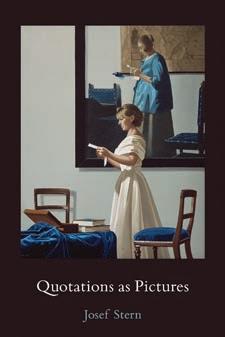
US $30.00X/$40.00 CAN paper 978-0-262-54373-6
Belfer Center Studies in International Security
111
mitpress.mit.edu | Spring 2022
Certifying China
The Rise and Limits of Transnational Sustainability Governance in Emerging Economies
Yixian Sun
A comprehensive study of the growth, potential, and limits of transnational eco-certification in China and the implications for other emerging economies.
hina has lon prioriti ed econo ic ro th over envi ron ental protection ut in recent ears the countr has beco e a lobal leader in the fi ht to save the planet b pro otin clean ener cuttin air and ater pollution and developin a s ste of reen finance
In Certifying China, Yixian Sun explores the potential and li its of transnational eco certification in ovin the orld s ost populous countr to ard sustainable consu ption and production e identifies the forces that drive companies from three sectors—seafood, palm oil and tea to e brace eco certification he success of eco certification he sa s ill depend on the e tent to hich it ins support of do estic actors in fast ro in emerging economies.
he assu ption of eco certification is that de and alon the suppl chain can drive businesses to adopt good practices for social, environmental, and economic sustainabilit b specif in rules for production third part verification and product labelin hrou h case studies dra n fro e tensive field ork and i ed ethods un traces the processes b hich certification programs originating from the Global North were intro duced in hina and raduall ained traction e finds that the rise of eco certification in the hinese arket is ainl driven b state actors includin overn ent sponsored industr associations ho seek benefits of transnational governance for their own development oals he book challen es the conventional isdo that the Chinese state has little interest in supporting transnational overnance o erin novel insi hts into the interaction bet een state and non state actors in earth s ste overnance in e er in econo ies
Yixian Sun is a Lecturer (Assistant Professor) in International Development at the University of Bath, UK.
political science | environment
February | 6 x 9, 224 pp. | 20 illus.
US $35.00X/$47.00 CAN paper 978-0-262-54369-9
Earth System Governance series
Virtually Amish Preserving Community at the Internet’s Margins
Lindsay Ems
How the Amish have adopted certain digital tools in ways that allow them to work and live according to their own value system.
he A ish are fa ous for their disconnection fro the odern orld and all its devices ut as indsa s sho s in Virtually Amish ld rder A ish toda are selectivel en a in ith di ital technolo he A ish need di ital tools to participate in the econo websites for ecommerce, for example, cell phones for co unication on the road but the have developed strate ies for akin li ited use of these tools hile still livin and orkin accordin to the values of their co unit he a the do this s su ests holds lessons for all of us about resisting the negative forces of hat has been called “hi h tech capitalis ” s sho s ho the A ish do not allo technolo to drive their behavior; instead the activel confi ure their sociotechnical world to align with their values and protect their co unit s autono ra in on e tensive ethno raphic field ork conducted in t o ld rder A ish settle ents in ndiana s e plores explicit rules and implicit norms as innovations for resist in ne ative i pacts of di ital technolo he describes the ingenious contraptions the Amish devise—including “the black bo phone ” a landline phone attached to a device that connects to a cellular net ork hen plu ed into a car’s cigarette lighter—and considers the value of hu an centered approaches to co unication on A ish technolo users ould do ell to take note of Amish methods of adopting digital technologies in a s that e po er people and ackno led e their shared hu anit
“The Amish—unlikely to be digital influencers—show us one way to draw on culture to regain control over our digital future. This compelling account of Amish resistance to digitization provides a surprising model for the rest of us.”
—Adam Fish, Scientia Associate Professor, University of New South Wales
science, technology, and society
June | 6 x 9, 208 pp. | 29 illus.
US $35.00X/$47.00 CAN paper 978-0-262-54363-7
Acting with Technology series
Lindsay Ems is Assistant Professor of Communication and Media Studies at Butler University.
112 Spring 2022 | mitpress.mit.edu
European Objects

The Troubled Dreams of Harmonization Brice Laurent
How interventions based on objects—including chemicals, financial products, and consumer goods—offer a path to rethink European integration.
Interventions based on objects, Brice Laurent claims, have beco e a do inant path for uropean polic akin n European Objects, aurent anal es the political consequences of these interventions and their de ocrati ation e uses the ter “ uropean objects” to describe technical entities that are re ulated and thereb transfor ed b uropean policies o uncover the bureaucratic and re ulator intricacies of uropean governance, Laurent focuses on a series of these objects, includin food products che icals financial products consu er oods drinkin ater and occupational environ ents aurent ar ues that takin uropean ob ects seriousl o ers a a to rephrase the drea s of har oni ation and eventuall rethink the constitutional stren th of uropean inte ration aurent doesn t ust clarif ho uropean re ulation orks but also e plores a s to reali e lon ter ob ec tives for uropean inte ration such as a har oni ed arket or an ob ective e pertise e ulation is best understood as “re ulator achiner ” brin in to ether various t pes of le al constraints aterial interventions on objects, and the imagining of desirable futures. Anal in uropean ob ects enables aurent to e plore hat re ulation has beco e after ears of evolution have ade it a central co ponent of the uropean polic orld e o ers practical illustrations of ho the re ulator achiner functions toda f urope succeeds at reinventin the ter s of its le iti ac ith ob ects that atter for the uropean publics it ill provide a telling demonstration that the opposition of expertise and populism is not the unavoidable fate of liberal democracies.
Brice Laurent is a researcher at Mines ParisTech, Centre de Sociologie de l’Innovation.
science, technology, and society
February | 6 x 9, 280 pp. | 2 illus.
US $65.00X/$86.00 CAN paper 978-0-262-54333-0
Inside Technology series
The Squares
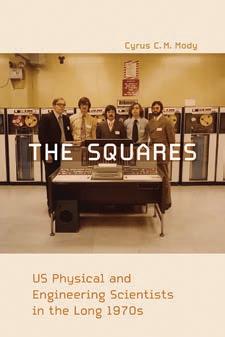
US Physical and Engineering Scientists in the Long 1970s
Cyrus C. M. Mody
When ungroovy scientists did groovy science: how non-activist scientists and engineers adapted their work to a rapidly changing social and political landscape.
In The Squares rus od sho s ho bet een the late s and the earl s so e scientists and en ineers who did not consider themselves activists, New Leftists, or members of the counterculture accom odated their ork to the rapidl chan in social and political landscape of the ti e hese “s uare scientists ” od sho s be an to do an of the things that the countercul ture ur ed turn a a fro ilitar industrial fundin become more interdisci plinar and focus their research on solvin proble s of civil societ urin the period od calls “the lon s ” un roov scientists ere doin roov science od o ers a series of case studies of so e of these collective e orts b non activist scientists to use their technical kno led e for the ood of societ e consid ers the re ion around anta arbara and the interpla of public universities think tanks established fir s ne companies, philanthropies, and social movement orga ni ations e looks at tanford niversit s transition fro old ar science to co erciali ed technoscience; A A s search for a post Apollo ission; the unsuccess ful fora into solar ener b obel laureate ack ilb ; the “civiliani ation” of the se iconductor industr ; and s ste s en ineer Arthur all s ill fated pro o tion of automated agriculture.
Cyrus C. M. Mody is Professor of the History of Science, Technology, and Innovation and Director of the Maastricht University Science, Technology and Society Studies program. He is the author of Instrumental Community: Probe Microscopy and the Path to Nanotechnology and The Long Arm of Moore’s Law: Microelectronics and American Science (both published by the MIT Press).
science, technology, and society July | 6 x 9, 416 pp.
US $65.00X/$86.00 CAN paper 978-0-262-54361-3
Inside Technology series
113
mitpress.mit.edu | Spring 2022
Technology of the Oppressed
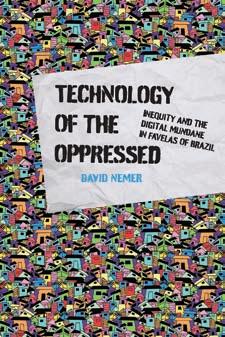
Inequity and the Digital Mundane in Favelas of Brazil
David Nemer
How Brazilian favela residents engage with and appropriate technologies, both to fight the oppression in their lives and to represent themselves in the world.
ra ilian favelas are i poverished settle ents usuall located on hillsides or the outskirts of a cit n Technology of the Oppressed avid Nemer draws on extensive ethno raphic field ork to provide a rich account of how favela residents engage ith technolo in co u nit technolo centers and in their ever da lives heir stories reveal the structural violence of the information a e ut the also sho ho those oppressed b technolo don t ust re ect it but consciousl resist and appropriate it, and how their experiences with digital technologies enable them to navigate both digital and nondigital sources of oppres sion and even at ti es to ourish
Nemer uses a decolonial and intersectional frame ork called undane echnolo as an anal tical tool to understand how digital technologies can simultane ousl be sites of oppression and tools in the fi ht for freedo uildin on the ork of the ra ilian educator and philosopher aulo reire he sho s ho the favela residents appropriate ever da technolo ies technolo i cal artifacts cell phones acebook operations repair and spaces elecenters and an ouses and use the to alleviate the oppression in their ever da lives He also addresses the relationship of misinformation to radicali ation and the rise of the ne far ri ht ontrar to the si plistic techno opti istic belief that technolo ill save the poor even ith access to technolo these ar inali ed people face nu erous sources of oppres sion, including technological biases, racism, classism, se is and censorship et the spirit love co unit resilience and resistance of favela residents ake possible their pursuit of freedom.
David Nemer is Assistant Professor of Media Studies at the University of Virginia.
technology | media studies
February | 6 x 9, 230 pp. | 3 illus.
US $35.00X/$47.00 CAN paper 978-0-262-54334-7
Information Society series
Seven Sublimes
David E. Nye
A reconception of the sublime to include experiences of disaster, war, outer space, virtual reality, and the Anthropocene.
e e perience the subli e over hel in a a e ent and e hilaration in at least seven di erent for s a in fro the top of a ountain at a a estic vista is not the sa e thin as lookin at a cit fro the observa tion deck of a sk scraper; lookin at i a es constructed fro ubble pace elescope data is not the sa e as livin throu h a po erful earth uake he varieties of sublime experience have increased during the last t o centuries and e need an e panded ter inolo to distin uish bet een the n this book avid e delineates seven for s of the subli e natural technological, disastrous, martial, intangible, digital, and environ ental hich e press seven di erent relation ships to space ti e and identit hese for s of the subli e can be e perienced at historic sites ruins cities national parks or on the co puter screen e find the in beautiful landscapes and i antic da s in battle and on battlefields in i a es of black holes and icroscopic particles he older for s are tan ible hen e are ph sicall present and our senses are full en a ed; increasin l others are intan ible ediated throu h technolo e e a ines each of the seven subli es fra ed b philosoph but focused on historical examples.
E. Nye is Senior Research Fellow at the University of Minnesota’s Charles Babbage Institute and Professor Emeritus of American Studies at the University of Southern Denmark. The author of twelve books with the MIT Press, including American Technological Sublime, he was awarded the Leonardo da Vinci Medal in 2005 and was knighted by the Queen of Denmark in 2013.
science, technology and society May | 6 x 9, 208 pp. | 19 illus. US $35.00X/$47.00 CAN cloth 978-0-262-04692-3
David
114 Spring 2022 | mitpress.mit.edu
Art, Science, and the Politics of Knowledge
Hannah Star Rogers
How the tools of STS can be used to understand art and science and the practices of these knowledge-making communities.
In Art, Science, and the Politics of Knowledge, Hannah Star o ers su ests that art and science are not as di erent from each other as we might assume. She shows how the tools of science and technolo studies can be applied to artistic practice o erin ne a s of thinkin about people and ob ects that have lar el fallen outside the scope of research Ar uin that the cate ories of art and science are labels ith specific po ers to order social worlds—and that art and science are best under stood as net orks that produce kno led e o ers shows, through a series of cases, the similarities and overlappin practices of these kno led e co unities he cases hich ran e fro nineteenth centur artisans to conte porar bioartists illustrate ho art can provide the basis for a new subdiscipline called art science and technolo studies A o erin h brid tools for investi atin art science collabora tions o ers s sub ects include the ork of father and son lassblo ers the laschkas hose lass odels produced in the nineteenth centur for use in biolo ical classification are no displa ed as orks of art; the ph sics photo raphs of docu entar photo rapher erenice Abbott; and a bioart lab that produces ork functionin as both art ork and scientific output inall o ers an scholar and conte porar art science curator dra s on her o n ork to consider the concept of curation as a for of critical anal sis
Hannah Star Rogers is Visiting Scholar at the University of Edinburgh in Science, Technology, and Innovation Studies (STIS) and lead editor of the Routledge Handbook of Art, Science, and Technology Studies

science, technology and society
May | 6 x 9, 304 pp. | 42 illus.
US $50.00X/$66.00 CAN paper 978-0-262-54368-2
115 mitpress.mit.edu | Spring 2022
Isa Genzken
Fuck the Bauhaus André Rottmann

A strikingly original analysis of Isa Genzken’s move toward merging sculptural and architectural morphologies into the critique of commodity culture.
Fuck the Bauhaus ade in the ear out of uotidian ob ects and cheap aterials fora ed fro e ork it b the er an artist sa en ken arked a poetic and provocative departure fro en ken s earlier ork ince the s en ken s “post ini alist” orks had been like ruins in reverse, conjuring the haunting specters of recent catastrophe, destruction, and failure in the United States, while also pla full su estin a de ree of freedom and elevation. Anal in ho this ode ave a to a ne penchant for appropriation colla e and onta e Andr ott ann o ers a strikin l ori inal anal sis of en ken s ove to ard merging sculptural and architectural morphologies into the criti ue of co odit culture n this ne addition to the ne ork series ott ann dra s on the ritin s of eleu e and uattari runo atour and other contemporaneous theorists of “assemblage” to illu inate en ken s ork as a po erful rei a ination of social relations in u
Helen Chadwick
The Oval Court Marina Warner
An illustrated exploration of Helen Chadwick’s erotic, playful, and fierce 1986 installation.
n the nstitute of onte porar Arts in ondon sho ed a ne co ission b the artist elen had ick hat had ick conceived for the ICA exhibition explored her characteristic themes—the fe ale bod her o n the aesthetics of pleasure, the aterial variet and onder of pheno ena but took the in a ne a bo ant direction. In this illustrated volume, Marina Warner examines one part of had ick s installation The Oval Court his ork as erotic pla ful and fierce; it showed imaginative ambition on an exceptional scale and a uni ue pi uant sensibilit both raunch and delicate.
espite the ork s reco nition as a fe inist onu ent of rare intensit it has rarel been sho n or discussed since the author s catalo ue essa for the ori inal e hibition arner here reconsiders had ick s in uence as an artist ho helped to shift conventional aesthetics and transvalue despised, even abominated for s plorin the ork s richl la ered co position in li ht of intervenin ears arner sho s ho had ick s i a ination has shaped an artists ideas and ethics, and emboldened their adventures with materials.
art
April | 6 x 8 1/2, 96 pp. | 32 color illus.
US $19.95T/$25.95 CAN paper 978-1-84638-253-6

One Work series
Distributed for Afterall Books
Marina Warner is a celebrated novelist and critic. She is the author of the National Book Critics Circle Award–winner Stranger Magic and many other books. Awarded the Holberg Prize in the Arts and Humanities and made a DBE in 2017, she is Professor of English and Creative Writing at Birkbeck College, University of London, President of the Royal Society of Literature, and an Honorary Fellow of the Royal Academy.

art
February | 6 x 8, 1/2, 96 pp. | 32 color illus. US $19.95T/$25.95 CAN paper 978-1-84638-251-2
One Work series
Distributed for Afterall Books
Distributed
by the MIT Press
André Rottmann is a Research Fellow and Lecturer in the Department of Art History at Freie Universität, Berlin, and the editor of the October Files volume John Knight
116 Spring
2022 | mitpress.mit.edu
Rethinking Law
 edited by Amy Kapczynski
edited by Amy Kapczynski
Some of today’s top legal thinkers consider the ways that legal thinking has bolstered—rather than corrected—injustice.
rin in to ether so e of toda s top le al thinkers this volu e rei a ines la in the t ent first centur eroin in on the ost vibrant debates among le al scholars toda oin be ond constitutional uris prudence as conventionall understood, contributors sho the a s in hich le al thinkin has bolstered rather than corrected injustice. If conservative approaches have been well served b court centered change, contributors to Rethinking Law consider how pro ressive ones i ht rel on ove ent centered le islative and institutional chan e n other ords the believe that the proble s e face toda are vastl bi er than can be addressed b liti ation he courts still atter of course but the should be less central to questions about social justice. ontributors describe ho constitutional la sup ported a s ste of econo ic ine ualit ; ho e i ht rethink the irst A end ent in the a e of the internet; ho deepl racial bias is e bedded in our la s; and hat kinds of chan es are necessar he ask hich is ore i portant the la s or ho the are enforced Rethinking Law considers these uestions ith an e e to ard a le al s ste that trul supports a ust societ
Contributors include
Jedediah Purdy, David Grewal, Jamal Greene, Reva Siegel, Jocelyn Simonson, Aziz Rana
political science | law June | 6 x 9, 176 pp.
US $15.95T/$21.95 CAN paper 978-1-946511-72-0 Distributed for Boston Review

Repair

edited by Kali Fajardo-Anstine, Ed Pavlić, Ivelisse Rodriguez, and Sonia Sanchez
How we can recover from terrible ruptures, the pandemic, toxic politics, racist horrors, class warfare, gendered violence, and ecological brinksmanship.
ndividuall and collectivel e bear deep ounds o e of these are enerations old; all have been ors ened b a destructive period of p rrhic politics that have left us ill e uipped to respond to a global health catastrophe. As we struggle to recover our footing and grieve our dead, Boston Review believes that the arts must have a voice in the conversation about how we heal n this ne antholo of poetr fiction and essa s from renowned writers and newcomers, writers explore whether and how we can repair terrible ruptures, life threatenin illnesses and the pande ic to ic politics racist horrors, class warfare, gendered violence, and ecolo ical brinks anship
Kali Fajardo-Anstine is the author of Sabrina & Corina, finalist for the National Book Award. Ed Pavlić is the author of Live at the Bitter End; Who Can A ord to Improvise? James Baldwin and Black Music, the Lyric and the Listener; Let’s Let That Are Not Yet: Inferno; and other books. He is Distinguished Research Professor of English and African American Studies at the University of Georgia. Ivelisse Rodriguez’s short story collection, Love War Stories, was a 2019 PEN/Faulkner finalist and a 2018 Foreword Reviews INDIES finalist. Sonia Sanchez—poet, activist, scholar—is a Robert Frost Medal recipient, and winner of the 1985 American Book Award and the 1999 Langston Hughes Poetry Award. One of the most important writers of the Black Arts Movement, Sanchez is the author of sixteen books, including Does Your House Have Lions?, a finalist for the National Book Critics Circle Award.
literature
March | 6 x 9, 224 pp.
US $19.95T/$25.95 CAN paper 978-1-946511-68-3
Distributed for Boston Review
Distributed by the MIT Press
Amy Kapczynski is Professor of Law at Yale Law School and cofounder of the Law and Political Economy blog.
117 mitpress.mit.edu | Spring 2022
Unprecedented?
How COVID-19 Exposed the Politics of Our Economy
William Davies, Sahil Jai Dutta, Nick Taylor, and Martina Tazzioli
A critical and evidence-based account of the COVID-19 pandemic as a political–economic rupture, exposing underlying power struggles and social injustices.
Unprecedented? tells the stor of the pande ic as one of political econo ic rupture here the basic fabric of economic and political rules was torn up and underl in po er stru les and social in ustices ere e posed ocusin on the case of ritain but ith lessons for all countries this book o ers a critical and evidence based account of unprecedented events n earl an of the ost basic buildin blocks of capitalis ere transfor ed in a atter of eeks thanks to the novel coronavirus orkplaces and schools ere closed overn ents took on unprecedented debt and ne technolo ies had to be rapidl procured and rolled out in an e ort to achieve control over the pande ic ean hile lurkin ine ualities of class race ender and eo raph ere deepened and e posed in ne a s and populations beca e depen dent on urk alliances bet een states and corporate contractors ceptional profits ere reaped b so e hile lar e sections of societ teetered on the ed e of destitution and despair.
William Davies is Codirector of the Political Economy Research Centre at Goldsmiths, University of London and a Co-Investigator in the ESRC-sponsored Centre for Understanding Sustainable Prosperity. Sahil Jai Dutta is Lecturer in Political Economy and has published with the Institute for Public Policy Research, Transnational Institute, Open Democracy, and New Socialist Nick Taylor is a Research Fellow for the ESRC-sponsored Centre for the Understanding of Sustainable Prosperity, working in the Political Economy Research Centre at Goldsmiths.
Martina Tazzioli is part of the editorial collective of Radical Philosophy and a member of the Euro-African network Migreurop.
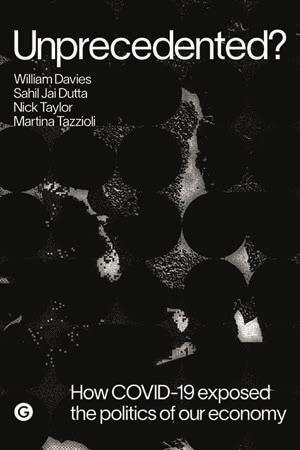
political science
March | 5 1/4 x 8, 304 pp.
US $24.95T/$33.95 CAN paper 978-1-913380-12-0
PERC Papers
Distributed for Goldsmiths Press
118 Spring 2022 | mitpress.mit.edu
Distributed by the MIT Press GOLDSMITHS PRESS
Passport to Peckham

Culture and Creativity in a London Village
Robert
Hewison
An entertaining and engaging social and cultural history of the London community of Peckham that offers lessons in urban living.
“ s there life in eckha ” asks a pop son of the s eckha has been treated as a oke and a place to be avoided. It has been celebrated in television comedies, and denigrated for its levels of crime. It is a center for the arts and the creative industries et it also su ers fro social deprivation and racial tension. Passport to Peckham is a uide to an unofficial part of London—social and cultural histor ritten fro the ground up.
In this entertaining and engaging account, Robert Hewison invites readers to e plore eckha s streets and presents the portrait of a co unit e periencin the stresses of odern livin ld and ne residents rub a ainst each other as the tr to ad ust to the challen es created b urban re eneration and the ore subtle process of entrification Artists have lived and orked in eckha for ore than a centur and no aribbean and est African co unities are addin their o n avors in ter s of usic dra a poetr and fil ocused on a fe s uare iles Passport to Peckham raises issues of urban polic plannin culture and creativit that have a far ider application As London and other major cities recover from the crisis are there lessons in urban livin to be learned fro the pleasures and pains of eckha he answer from one of Britain’s most distinguished cultural critics is an e phatic es
World’s End
Charlie Gere
A memoir and cultural history of World’s End, a West London area once home to bohemian artists and punk rock and now an outpost of neoliberalism.
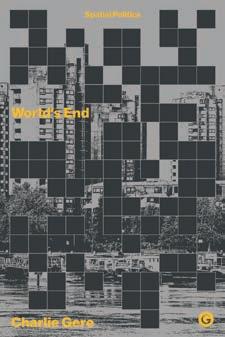
harlie ere s account of ro in up in the orld s nd area of West London during the Cold War combines local histor cultural histor memoir, and a strong sense of the apocal ptic nce a rundown part of Chelsea at the wrong end of the King’s Road, the World’s nd has lon been a place for bohemian writers and artists includin urner histler eckett acon and Bacon’s muse Henrietta Moraes, all of whom evinced an appropriate apocal ptic sensibilit After World War II, in which the area su ered severe bo bin it beca e a center of the counterculture that e er ed fro hat e uttall called “ o b ulture ” for ed b the threat of nuclear annihilation.
he fa ous bouti ue rann akes a rip opened there in oined later on b un n ou uss eber s l in ra on ea oo and the co une andalf s arden he area also featured trepannin aristocrats and pet lions, among other eccentricities. In the s the orld s nd as the center of punk rock ere s parents arrived as part of a ave of entrifica tion, and Gere, born and brought up there, witnessed its social and cultural evolution. As an adolescent, he was trau ati ed b the prospect of nuclear ar e has lived lon enou h to see the orld s nd no bearin the arks of out of control neoliberalis and its rotes ue acco pan in ine ualit ut this too shall pass as worlds end.
history
March | 6 x 9, 224 pp. | 20 illus.
US $34.95T/$45.95 CAN cloth 978-1-913380-06-9
Spatial Politics
Distributed for Goldsmiths Press
Robert Hewison is Honorary Professor at the Ruskin Research Centre at Lancaster University and Adjunct Professor at the Graduate School of Architecture, Planning, and Preservation at Columbia University.
| 5 x 7 1/2, 208 pp.
$29.95T/$39.95 CAN cloth
119 mitpress.mit.edu | Spring 2022 Distributed by the MIT Press GOLDSMITHS PRESS
Charlie Gere is Professor of Media Theory and History at Lancaster Institute for the Contemporary Arts at Lancaster University and author of I Hate the Lake District (Goldsmiths Press) and other books.
history February
US
978-1-913380-00-7 Spatial Politics Distributed for Goldsmiths Press
Decolonial Imaginings
Intersectional Conversations and Contestations
Avtar Brah
A transdisciplinary study of the ways in which mobilities assume social forms and result in multiple belongings.
In Decolonial Imaginings Avtar rah o ers a transdisci plinar stud of the a s in hich obilities assu e social forms and result in multiple belongings. ituated ithin the con u ence of decolonial feminist theor border theor and diaspora studies, the book e plores borders and boundaries and how the politics of connectivit are produced in and through stru les over “di erence ” Brah examines multiple formations of power embedded in the intersec tions between gender, race, class ethnicit and se ualit iscussin the crossin s of i pervious borders rah fore rounds the econo ies of abandon ent particularl the plight of people in boats in the Mediterranean, a number of whom perished because of a catalogue of failures b A arships and uropean coast uards he revisits illes eleu e and eli uattari s notion of “no ad thou ht” and raidotti s fe inist re orkin of it and seeks to assess this fra e ork s value toda he anal es the politics of “ lack” in ritain ith a focus on fe inis constituted b o en of African aribbean and outh Asian back round e plores stereot pic representation of Muslim women in the context of sla ophobia and anti usli racis and considers the co ple ities of the e oo ove ent and ho hiteness is confi ured in these contestations

The Future of Media Joanna Zylinska with Goldsmiths Media
An investigation of the future of various media industries and technologies that considers how media shape our future.
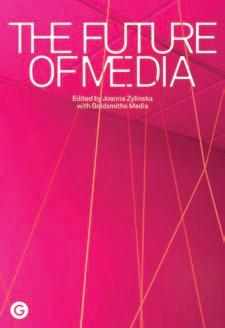
o do e co bat post truth in the ne s Are social edia in uencers the ournalists of toda hat obs will be left in the media once A takes over his volume investigates the future of various media industries and technologies ournalis fil photo raph radio publishing, and social edia hile e plorin ho media shape our future. ssues of truth diversit media reform, activism, and art take the discussion into a wider social context. he book celebrates the i portance and vitalit of edia in the odern orld and of the academic discipline of media studies, which o ers a ri orous stud of edia The Future of Media is an e peri ent in collaborative odes of thinkin and ork in oauthored b theorists and practitioners fro one of the world’s most established media departments, it o ers a radical creative and critical “ olds iths take” on edia industries and on orld a airs hrou h their ti el diverse and often passionate anal ses alon ith the practice orks featured on the co panion ebsite the authors de onstrate both ho to think about the media and how to produce relevant and challenging edia he book serves as an invitation to all edia scholars students and industr practitioners to ork to ether on tr in to shape a better edia future and a better world for us all.
cultural studies
June | 5 1/4 x 8, 264 pp.
US $30.00T/$40.00 CAN paper 978-1-913380-08-3 Distributed for Goldsmiths Press
Avtar Brah is Professor Emerita in Sociology at Birkbeck College, University of London. She has published numerous books, chapters, and articles, and is a member of the Editorial Collective of Feminist Review and a member of the International Editorial Board of Identities
including
she
and
publishing projects. media studies February | 6 x 9, 400 pp. | 30 illus. US $30.00T/$40.00 CAN paper 978-1-913380-14-4 Distributed for Goldsmiths Press 120 Spring 2022 | mitpress.mit.edu Distributed by the MIT Press GOLDSMITHS PRESS
Joanna Zylinska is Professor of New Media and Communications at Goldsmiths, University of London. The author of a number of books,
AI Art: Machine Visions and Warped Dreams, The End of Man: A Feminist Counterapocalypse, and Nonhuman Photography (MIT Press),
is involved in experimental
collaborative
Black Mass

Aria Dean
Essays by critic, artist, and curator Aria Dean that articulate her theory of “blaccelerationism.”
Black Mass brin s to ether a roup of previousl uncol lected essa s b critic artist and curator Aria ean ritten over the past five ears these ti el ide ran in te ts deftl consider aterial culture s intersec tions ith race technolo and politics pannin themes that range from trauma and necropolitics to e es and selfies these essa s o er frank ori inal assessments of the production and circulation of images in our accelerated media landscape. ean dra s fro rankfurt chool philosoph lack studies and conte porar art to articulate her theor of “blaccelerationis ” hich places the lack sub ect at the center of the coming end of the world—as both the a ent of its de ise and its inheritor ith one e e on the recent past and another anticipating the near future, Black Mass o ers a lance in the rear vie irror fro a vehicle ovin to ard a ne realit at breakneck speed
Aria Dean is an artist, writer, and curator whose work engages questions of Blackness within internet culture, examining the generative and gratuitous workings of online cultural production. Her writings have been published in Artforum, Art in America, Texte zur Kunst, and elsewhere.
From 2016 to 2019, Dean served as assistant curator of net art and digital culture at Rhizome, and then, from 2019 to 2020, as editor and curator there, overseeing the blog at rhizome.org and Net Art Anthology. Dean has shown her works widely in solo and group exhibitions at such venues as the Hammer Museum, Los Angeles; Het Hem, Amsterdam; Institute of Contemporary Art, Philadelphia; and Albright-Knox Gallery, Bu alo.
art
February | 6 x 8, 112 pp. | 28 illus. US $20.00T/$27.00 CAN paper 978-1-949484-07-6
Distributed for no place press

121
| Spring 2022
mitpress.mit.edu
Distributed by the MIT Press
An Oblique Autobiography

Yve-Alain Bois
Essays and reminiscences by one of the preeminent art historians of our time, spanning more than four decades.
An Oblique Autobiography assembles a new collection of essa s and re iniscences b one of the pree inent art historians of our time. Spanning more than four decades of ve Alain ois s ork as a scholar ournal editor, and occasional curator, this volume traces a deepl personal itinerar through an important era of art histor in hich the discipline—in part occasioned b ois s o n ourne fro rance to the United States—was si nificantl refor ulated b new methodologies. etailin ois s earl relationships ith fi ures such as oland arthes ubert a isch ia lark and ac ues errida as ell as his e tended en a e ents ith osalind rauss lls orth ell and artin arr these essa s track ois s intellectual co it ents a ainst the backdrop of an evolvin acade ic field ith te ts that ran e fro acade ic ournal articles to obitu aries ritten fro to An Oblique Autobiography reveals the ran e of ois s authorial voice and o ers a re arkable self portrait of one of art histor s pri ar protagonists.
Yve-Alain Bois, widely recognized as an expert on twentieth-century art, is the coauthor (with Rosalind E. Krauss) of Formless: A User’s Guide and the author of Painting as Model (MIT Press), and an editor of October. His other publications include Ellsworth Kelly: Catalogue Raisonné of Paintings, Reliefs, and Sculpture, vols. 1 and 2 and Art Since 1900 (with Benjamin Buchloh, Hal Foster, and Rosalind E. Krauss). Currently Professor in the the School of Historical Studies at the Institute for Advanced Study in Princeton, New Jersey, he has taught at Johns Hopkins and Harvard universities and has curated or cocurated exhibitions worldwide. art February | 6 x 8, 304 pp. | 38 illus. US $20.00T/$27.00 CAN paper 978-1-949484-08-3 Distributed for no place press
After the Bauhaus, Before the Internet

A History of Graphic Design Pedagogy edited by Geoff Kaplan foreword by Tim Barringer
A history of design teaching from the mid-1950s to the mid-1990s told through essays, interviews, remembrances, and primary materials.
ith contributions b ore than fort of the ost in uential voices in art architecture and desi n After the Bauhaus, Before the Internet traces a histor of design teaching from the id s to the id s throu h essa s intervie s re e brances and pri ar aterials eo aplan has athered a ulti en erational group of theorists and practitioners to explore hat desi n thinkin and interdisciplinarit ean for desi n and its peda o and ho the can be placed within a conceptual and historical context.
At a time when all our choices and behaviors are putativel curated and hen “desi n thinkin ” is recruited to solve problems from climate change to social edia opti i ation this volu e looks at ho desi n s self understandin s as a discipline have chan ed and ho the a ect the a s it rites its o n histories and theories.
Geo Kaplan of General Working Group has produced projects for a range of academic and cultural institutions, including the Museum of Modern Art, Harvard University, and the Museum of Contemporary Art, Los Angeles. His work is included in SFMoMA’s and MoMA’s permanent collections and he has exhibited internationally. Kaplan teaches in the graduate design program at Yale University and was the Frank Stanton Chair in Graphic Design at Cooper Union. He wrote, edited, and designed Power to the People: The Graphic Design of the Radical Press and the Rise of the Counter-Culture, 1964–1974
art | design
March | 6 1/2 x 9 1/4, 368 pp. | 175 illus.
US $45.00T/$60.00 CAN paper 978-1-949484-09-0
Distributed for no place press

122 Spring 2022 | mitpress.mit.edu Distributed by the MIT Press
Walking Through Clear Water in a Pool Painted Black Collected
Stories
Cookie Mueller
edited by Hedi El Kholti, Chris Kraus, and Amy Scholder new edition
introduction by Olivia Laing
A new edition of legendary writer, actress, ex-biker, and columnist Cookie Mueller’s only story collection, featuring additional writings.

irst published in Walking Through Clear Water in a Pool Painted Black as the onl stor collection that the le endar riter actress e biker and colu nist ookie ueller co piled in her lifeti e eaturin a ne introduction b livia ain this ne edition collects all of ueller s fiction to ether ith her Details a a ine colu ns and other ritin s he additional stories ere discovered b A cholder ho edited the antholo Ask Dr. Mueller for i h isk erpent s ail books in As cholder writes, the new stories were “written around the same time she wrote the stories in Walking Through Clear Water, but for so e reason ookie decided not to include the he are darker than ost of her other stories; the are the uotidian ookie and that is h especiall love the ” ueller s life and ork ere celebrated in hloe riffith s oral bio raph Edgewise, which brought her ork to a ne eneration of readers
Cookie Mueller (1949–1989), née Dorothy Karen Mueller, played leading roles in John Waters’s Pink Flamingos, Female Trouble, Desperate Living, and Multiple Maniacs. She wrote for the East Village Eye and Details magazine, performed in a series of plays by Gary Indiana, and wrote numerous stories that would only be published posthumously. She died in New York City of AIDS-related complications at age 40.
fiction
April | 5 3/8 x 8, 392 pp.
US $17.95T/$23.95 CAN paper 978-1-63590-166-5
Native Agents series Distributed for Semiotext(e)

123
| Spring 2022
mitpress.mit.edu
Distributed by the MIT Press
Indivisible new edition
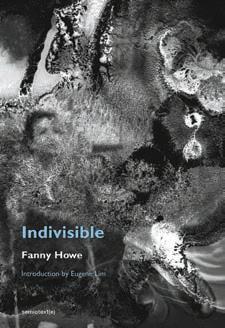
Fanny Howe
introduction by Eugene Lim
Last of a series of philosophical and personal Fanny Howe novels animated by questions of race, spirituality, childhood, transience, resistance, and poverty.
irst published b e iote te in Indivisible concludes a radicall philosophical and personal series of ann o e novels ani ated b uestions of race spiritualit child hood, transience, wonder, resistance and povert epictin the te pestuous multiracial world of artists and activists who lived in orkin class oston during the 1960s, Indivisible begins when its narrator, enn locks her husband in a closet so that she might better discuss things with od n the ver e of a reli ious conversion enn atte pts to ake peace ith the dead b tellin their stories
Fanny Howe is the author of more than twenty books of poetry and prose. Professor Emerita in Literature at the University of California, San Diego, she has mentored a generation of American poets, activists, and scholars working at the intersection of experimental and metaphysical forms of thinking. Eugene Lim is the author of four novels, including Dear Cyborg, and the founder of Ellipsis Press.
fiction
February | 5 3/8 x 8, 320 pp.
US $16.95T/$22.95 CAN paper 978-1-63590-155-9
Native Agents series Distributed for Semiotext(e)
Diego Garcia
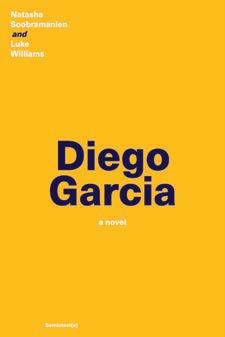
A Novel Natasha Soobramanien and Luke Williams
Sad and funny and bitter and true, a novel about grief, discovering your own story, and trying to listen for those stories that are not yours to tell. Edinburgh 2014. Independence for Scotland, codependence for us! N. and L., two sad and stupid writers, one Scottish, one ritish auritian arrive in dinbur h tr in to ork out if hat killed s brother aniel is also hat is killin the ho ever softl ver da the ake up and the don t kno hat the re oin to et hat the ant is to et to the librar hat the ant is to rite their books ut instead the spend their da s bickerin over whether or not it is going to rain, over whether or not it matters that Bitcoin is tankin heir ni hts are spent drinkin pints s okin tubes eatin auritian food and readin books so e of the aniel s so eti es aloud to one another.
ad and funn and bitter and true this collaborative autofiction set in dinbur h ondon and russels is a novel about rief; about discoverin our o n stor and about tr in to listen for those stories that are not ours to tell; about books that can kill ou and books that can help ou find a a to live ut in the end this is both a novel about friendship, and a performance of it.
Natasha Soobramanien and Luke Williams are the authors of Genie and Paul and The Echo Chamber, respectively. They used to live in Edinburgh but now live in Brussels, across the park from one another, where they meet up every day for a walk.
fiction
May | 5 3/8 x 8, 240 pp.
US $17.95T/$23.95 CAN paper 978-1-63590-162-7
Native Agents series Distributed for Semiotext(e)

124 Spring 2022 | mitpress.mit.edu Distributed by the MIT Press
The Cinema House and the World
The Cahiers du Cinema Years, 1962–1981 Serge Daney translated by Christine Pichini foreword by A. S. Hamrah

One of the greatest film critics of his generation on topics ranging from the auteur approach of the French New Wave to a more structural examination of film.
ne of the reatest fil critics of his eneration er e ane rote for Cahiers du Cinéma before becoming a ournalist for the dail ne spaper Libération he ritin s collected in this volu e re ect ane s evolvin interests fro the auteur approach of the rench e ave to a ore structural e a ination of fil ps choanal sis and popular culture.
penl a throu hout his lifeti e ane rarel rote e plicitl about ho ose ualit but his ritin s re ect a ueer sensibilit that ould in uence future generations. In regular intellectual exchanges with Gilles eleu e li uattari and oland arthes ane rote about cine a autobio raphicall hile l ricall anal in the transition fro odern cine a to post odern edia A noted pol ath ane also published books about tennis and aiti s notorious uvalier re i e is criticis is open and challen in pol vocal and co pulsivel readable
Serge Daney became the editor of Cahiers du Cinéma in 1974. In 1981, he left Cahiers and wrote about visual culture for Libération, turning his attention to television and coverage of the Gulf War. He collaborated with Claire Denis on a documentary film, Jacques Rivette, le veilleur (1990). He died of AIDS-related causes in 1991. A. S. Hamrah is a writer living in Brooklyn. He contributed a column on film to n+1 from 2008 to 2019, and his essays and reviews have appeared in Harper’s, Bookforum, Cineaste, and other publications. He is the author of The Earth Dies Streaming: Film Writing, 2002–2018
performing arts
February | 6 x 9, 600 pp.
US $34.95T/$45.95 CAN cloth 978-1-63590-161-0
Foreign Agents series Distributed for Semiotext(e)
mitpress.mit.edu | Spring 2022

125
Distributed
the
by
MIT Press
American Magus Harry Smith
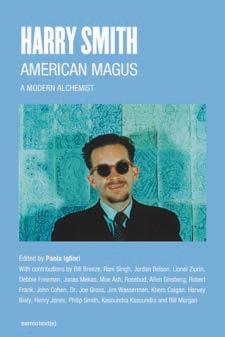
A Modern Alchemist revised and expanded edition edited by
Paola Igliori
A privileged look into the life and artistic practice of the experimental filmmaker, music anthologist, and enigmatic polymath Harry Smith. est kno n durin his lifeti e as an e peri ental fil aker and olk a s ecords usic antholo ist arr ith as a spiritual outsider and one of the ost ori inal in uential artists of the id centur A erican avant arde An avid, inspired collector of old blues and hillbill recordin s durin his outh he beca e a fan of such bebop a as harlie arker and i illespie and be an akin avant arde fil ani ations featuring patterns painted directl onto the ne atives as visual accompaniments to a perfor ances ith crossed paths ith nearl ever one central to the cultural avant arde; he lived for art and nosis ith little thou ht for practical conse quences. In 1991, he received a Lifetime Achievement A ard at the ra A ards in e ork ive ears after ith s death the poet aola liori be an conductin inti ate intervie s ith the fil ak ers usicians poets and artists ho kne hi best he result American Magus Harry Smith o ers a privile ed look not onl into ith s life and artistic practice but also into his era and the infor al econo of in uence that operated durin that ti e his e panded edition includes photos of ith and an other color photos and images, as well as two important interviews with Smith from Film Culture.
Paola Igliori is the founder of Inandout Press, which produced books of art, culture, and poetry between 1990 and 1996, and is the author of Entrails, Heads & Tails. She was a close friend of Harry Smith’s and has written and spoken extensively on his importance.
performing arts
May | 6 x 9, 328 pp. | 8 color illus., 80 b&w illus.
US $19.95T/$25.95 CAN paper 978-1-63590-164-1
Native Agents series Distributed for Semiotext(e)
Spring 2022 | mitpress.mit.edu
Clinic of Phantasms
Writings 1994–2002

Giovanni Intra edited by Robert Leonard

Artist, gallerist, and writer Giovanni Intra’s inventive approach to art writing provides a guide to the New Zealand and Los Angeles art scenes of his era. efore his earl death in iovanni ntra en o ed a rollercoaster ride through the art world. He was an artist and gallerist— cofounding two le endar alleries the artist run space eststrip in Auckland and China Art b ects alleries in Los Angeles—as well as a writer. Clinic of Phantasms provides a guide to the New ealand and os Angeles art scenes of the da includin te ts on ke artists fro e ealand ohn urrell iona ardin ton enise u Ava e our Ann helton avin ipkins aniel alone and lave ianos and os An eles harles a ike elle aul c arth ave uller van ollo a ohn c racken and ulia cher hat akes ntra s ork of endurin si nificance is his inventive approach to art writing, which was infor ed b his interest in punk surrealis and aniel aul chreber the fa ous case stud in paranoia and hallucination his volu e features ritin on ntra fro hris raus and ark von chle ell Andre erardini oberta ith essa aird ill radle oel Mesler, and Robert Leonard.
Giovanni Intra (1968–2002) was a cofounder of the artist-run Teststrip Gallery in Auckland (1992–1997). He was a regular contributor to Art and Text Robert Leonard is Chief Curator at City Gallery Wellington, New Zealand, and former director of the Institute of Modern Art, in Brisbane, Australia. He curated Simon Denny: Secret Power for the 2015 Venice Biennale. His City Gallery shows include Colin McCahon: On Going Out with the Tide (2017), John Stezaker: Lost World (2017), and Iconography of Revolt (2018).
art
March | 7 x 9, 224 pp. US $18.95T/$24.95 CAN paper 978-1-63590-165-8 Distributed for Semiotext(e) Published by Bouncy Castle and Semiotext(e).
126
Distributed by the MIT Press
Up Your Ass
Or From the Cradle to the Boat Or The Big Suck Or Up from the Slime
Valerie Solanas
Valerie Solanas’s legendary play explodes social and sexual mores and the hypocritical, patriarchal culture that produces them.
alerie olanas s le endar pla Up Your Ass—never published during her lifetime but full of her signature irreverence and wit, incisiveness, and camp—explodes social and se ual ores and the h pocritical patriarchal culture that produces the he pla the full title of which is Up Your Ass Or From the Cradle to the Boat Or The Big Suck Or Up from the Slime arches out a cast of scre stereot pes the unkno in ohn the froth career irl the borin ale narcissist t o catt dra ueens the se depraved house ife and a pair of raciali ed pickup artists, among others.
At the center is prota onist on i ere a thinl veiled olanas a sardonic ender bendin hustler ho escorts us throu h the back alle s of her street life he fictionali ed predecessor to olanas s SCUM Manifesto, the pla shares the sa e rand subversive i plicative lan ua e e uall spittin and inkin e bracin the ar ins the scu and sellin a trick alon the a
Valerie Solanas (1936–1988) was a writer and artist. She completed SCUM Manifesto in 1967 and her play Up Your Ass in 1965; the latter was never published in her lifetime. As a result of her attempt to assassinate Andy Warhol in 1968, Solanas was involuntarily committed to psychiatric hospitalization. She was institutionalized a number of times in the years that followed, always living radically on the fringes of society.

performing arts | drama
February | 4 1/2 x 7, 96 pp.
US $15.00T/$20.00 CAN paper 978-3-95679-605-0
Montana Distributed for Sternberg Press Not for sale in UK and Europe
127
mitpress.mit.edu | Spring 2022
Distributed by the
Press
MIT
Custody of the Eyes
Diamela Eltit
 translated by Helen Lane and Ronald Christ
translated by Helen Lane and Ronald Christ
An unnamed woman—a mother—struggles to survive in the face of state repression, neighborhood surveillance, extreme weather, and familial control.
Alienation and dire frustration mount as an unnamed woman—a mother—struggles to survive in the face of state repression, neighbor hood surveillance, extreme weather, and familial control old throu h one side of an epistolar exchange, Custody of the Eyes Los Vigilantes presents letters bookended b dense ra blin s b the other s son ho stru les to speak and write and spends most of his da s in lockdo n rearranging his “vessels,” h stericall lau hin drooling, writhing, and ithdra in a state that ill ulti atel consu e his mother as well.
his is a stor that e plores ho po er is enacted on and throu h the bod the ph sical the social and the political. Custody of the Eyes reconfir s the essential constitutive nature of language and expression in power and freedom.
Diamela Eltit is a Chilean writer and artist. She began producing works during the Pinochet dictatorship, staging actions as part of the artist collective CADA and publishing her first novels, Lumpérica and El Cuarto Mundo. She has received many literary prizes, including Chile’s National Prize for Literature in 2018. She is a Distinguished Global Professor of Creative Writing in Spanish at New York University. Helen Lane (1917–2004) was a translator who worked primarily with French, Italian, Portuguese, and Spanish literature. Ronald Christ is the cofounder of Lumen Books and SITE magazine and Professor Emeritus of English at Rutgers University.
fiction
February | 4 1/2 x 7, 112 pp.
US $15.00T/$20.00 CAN paper 978-3-95679-606-7 Montana
Distributed for Sternberg Press Not for sale in UK and Europe
Curating Capitalism
How Art Impacts Business, Management, and Economy

Pierre Guillet de Monthoux
How art and the artist inspire business: an examination of the origins of this relationship from Joseph Beuys and Andy Warhol.
Curation has evolved into much more than just creating interesting exhibitions, promoting artists, and selling art ork Art orlds have fused with business worlds and transformed capitalism from the inside out. “Curating capitalism” i plies ne a s of management that go far be ond the si ple co er ciali ation of art and artist oda art and the artist inspire business.
Curating Capitalism traces this relationship back to er an artist oseph eu s s declaration that Art apital as ell as to A erican artist And arhol s vision of a capitalistic usiness Art he book dra s fro the insi hts of internationall reno ned conte porar curators artists critics and philosophers to articulate these ideas.
Pierre Guillet de Monthoux directs the Stockholm School of Economics Art Initiative where he is Professor at its Center for Arts, Business, and Culture. He has held professorships in general management at Stockholm University, Sweden, and in philosophy and management at Copenhagen Business School, Denmark. He is docent at Åbo Akademi, Finland, and currently teaches at Artem Nancy in France.
art
February | 5 x 7 1/2, 360 pp. | 20 illus.
US $19.95T/$25.95 CAN paper 978-3-95679-577-0
Experiments in Art and Capitalism
Distributed for Sternberg Press
Not for sale in UK and Europe
128 Spring 2022 | mitpress.mit.edu
Distributed by the MIT Press
Unannounced Voices of Change

Situated Curatorial and
Zdenka Badovinac
Institutional Practices
Alternative forms of curatorial and institutional work suitable to our novel conditions, when the relationship between physical and online work must be revised.
ever before has the entire orld been cau ht up nearl si ultaneousl in such a si ilar e perience as in this era of the pandemic, which has onl accelerated the spiralin crises of our ti e he e peri ences that artists and curators now address, and even the ver sense of e perience itself are more situated than local, e tendin be ond de arcated localities and individual communities, and resonating in precise et e panded contexts of culture, space, and ti e his book proposes alternative forms of curatorial and institutional ork suitable to our novel conditions, when the relationship between ph sical and online ork ust be revised in the na e of a new sense of the situated, and as various economies of solidarit are alread developin he predo inant for s of curatorial production e hibitions conferences publications etc have lon considered and even depended on eo raphical di er ence on di erent localities and the fra ilit of social roups et the al a s translate these conditions into their own dominant language. What gets lost in transla tion is the bod of the one bein translated the situation of each voice each bod t is possible to retrieve these vulnerable bodies of people art orks and e hibitions but onl if curatorial ork and institutions be in to develop this crucial sense of the situated that b necessit b a ne ur enc of distance and closeness ust transfor the idea of the local in the age of pandemic relations. Zdenka Badovinac is a curator and writer. Since 1993 she has been the Director of the Moderna galerija in Ljubljana. She is the author of Body and the East: From the 1960s to the Present (MIT Press).
Between the Material and the Possible Infrastructural Re-examination and Speculation in Art
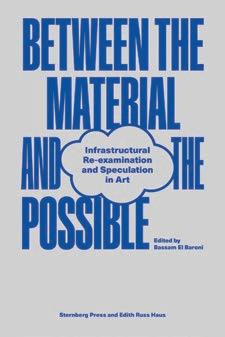 edited by Bassam El Baroni
edited by Bassam El Baroni
The revisioning of our infrastructural futures, local and global relationalities, and historical and political legacies.
ro uestions around space settle ents to the possibilit of repurposin blockchain infrastructures and financial instru ents for redistributive purposes, and from the diagrammatic potential of infrastructural thinkin in artistic practices to scenario planning and econo ic strate i in this collection of essa s brin s to ether critical anal sis from a broad group of contributors engaged in the revisioning of our infra structural futures heir interrogations span local and global relationalities, historical and political le acies as ell as future oriented infrastructural h potheses or in a co prehensive picture of the ultiple processes, regulations, institutions, technologies, net orks and operations that e have co e to understand as the distributed infrastructural arena in which we act, ield and plot is a perennial challen e ver the past decade, a growing number of artists, theorists, curators, and researchers have moved from “institutional critique” to “infrastructural critique,” or toward “infrastructural speculation ” in hich the e plore the potential of creative infrastructure related visions and scenarios
El
is Assistant Professor in Curating at the School of Arts, Design and Architecture, Aalto University, Finland. He is the author of various essays on artists, art, and curating, editor of Fifteen Ways to Leave Badiou, and coeditor, with Ida Soulard and Abinadi Meza, of Manual for a Future Desert
| 6 illus. US $19.95T/$25.95 CAN paper 978-3-95679-584-8 Thoughts on
Distributed for Sternberg Press Not for sale in UK and Europe
art February | 4 3/8 x 7 1/2, 96 pp.
Curating
art February | 6 1/2 x 9, 256 pp. | 35 color illus. US $29.95T/$39.95 CAN paper 978-3-95679-600-5 Distributed for
Press
for sale in
and
129 mitpress.mit.edu | Spring 2022 Distributed by the MIT Press
Bassam
Baroni
Sternberg
Not
UK
Europe
Design Support / Öffentliche Gestaltungsberatung 2016–2021
Jesko Fezer and Studio Experimentelles Design edited by Jesko Fezer and Claudia Banz
Studio Experimentelles Design’s politically and socially committed approach through lectures, research, conversations, and project documentation.
ith toda s increasin inco e disparit forced global division of labor, and neoliberal expansion of precariousness, a critical discussion about ork is loo in even in the field of design. Since 2011, the tudio peri entelles esi n at the niversit of ine Arts in a bur has experimented with local design support as a conte porar practice n the summer of 2020, the Kunstgewerbemuseum erlin esi n ab hosted tudio peri entelles esi n s online research festival he studio invited friends e perts and activists to discuss self or ani in acade ia artistic collectivis care ork and creative self e ploitation his co pendiu chronicles tudio peri entelles esi n s politicall and sociall co itted approach through lectures, research, conversations, and project docu entation fro the online festival and five ears of studio ork

Jesko Fezer is a designer. In cooperation with ifau he realizes architecture projects. He is cofounder of the bookstore Pro qm and part of the exhibition design studio Kooperative für Darstellungspolitik. He is Professor for Experimental Design at the HFBK Hamburg. Claudia Banz is an art and design scientist and since 2017 curator for design at the Kunstgewerbemuseum Berlin.
design
March | 5 3/8 x 8.25, 528 pp. | 200 color illus., 100 b&w illus. US $26.00T/$35.00 CAN paper 978-3-95679-604-3
Distributed for Sternberg Press Not for sale in UK and Europe
Oceans Rising

A Companion to Territorial Agency: Oceans in Transformation edited by Daniela Zyman and TBA21 Forty-one thoughtful contributions by artists, scholars, scientists, and ocean activists in response to the rapidly changing oceans.
he ocean is risin and ith it sea level ater te pera ture acidit al al bloo s and stor sur es Also on the rise are the metrics of accelerated hu an activit o are we to fathom the political, aesthetic, and epistemological rise of the oceans fro centuries lon invisibili ation and forgetting? What ideas and memories do the oceans hold in their depth and reanimate, when the earth s ecos ste s su er Askin di erent uestions and using multiple registers of sensing expand the possibilities to engage with the oceanic at this precarious o ent and rethink its relations to the terrestrial Oceans Rising is a co panion reader to erritorial A enc ceans in ransfor ation an independent oceanic research initiative co issioned b A Acade and operatin out of cean pace in enice t o ers fort one thou htful contributions b artists scholars, scientists, and ocean activists in response to the rapidl chan in oceans
Daniela Zyman is the artistic director of Thyssen-Bornemisza Art Contemporary (TBA21). Her research into the ocean began when she worked with TBA21–Academy, ocean-archive.org, and Ocean Space in the former Church of San Lorenzo in Venice. Before joining TBA21 in 2003, she was chief curator of MAK-Austrian Museum of Applied Art in Vienna and MAK-Center for Art and Architecture, Los Angeles. TBA21–Academy is a contemporary art organization and cultural ecosystem fostering a deeper relationship to the ocean through the lens of art to inspire care and action. art
February
(How) do we (want to) work (together) (as (socially engaged) designers (students and neighbours)) in neoliberal times)?
| environment
130 Spring 2022 | mitpress.mit.edu Distributed by the MIT Press
| 9 x 11 1/2, 272 pp. | 40 color illus. US $32.95T/$43.95 CAN paper 978-3-95679-609-8 Distributed for Sternberg Press Not for sale in UK and Europe
Leslie Thornton
edited by Natalie Bell, Dan Kidner, and Milan Ther
The first monograph on the artist and filmmaker Leslie Thornton offers essential, foundational scholarship on her influential work.
roduced on the occasion of eslie hornton s a or solo e hibition at the ist isual Arts enter as well as a recent solo exhibition at Kunstverein urnber this richl illustrated volume is the first ono raph on this important artist and fil aker o erin essential foundational scholarship on hornton s in uential ork in fil and video hornton s earl encounters with experi mental, structuralist, and cinéma vérité traditions fueled her iconoclastic take on the ovin i a e and gave shape to her practice of weaving together her o n foota e and voice ith archival fil and audio n part throu h her forceful and d na ic use of sound hornton e poses the li its of lan ua e and vision in her orks hile ackno led in the a s that lan ua e and vision nevertheless re ain central to scientific discourse and narrative in eneral er ork consistentl interrogates modes of representation and the violence of lookin pushin be ond criti ues of the a e to consider biases in perception or the a voice and sound can undermine an otherwise dominant visual narrative.
Natalie Bell is curator at the MIT List Visual Arts Center. She was previously Associate Curator at the New Museum, New York, where she organized over a dozen solo exhibitions and cocurated several major group exhibitions. Dan Kidner, a curator and critic based in London, is a Senior Lecturer in the School of Art at Kingston University. Milan Ther is a curator and writer who since 2018 has served as Director of Kunstverein Nürnberg—Albrecht Dürer Gesellschaft, where he recently organized Leslie Thornton’s exhibition GROUND (2020).
art
February | 6 1/2 x 9 1/2, 208 pp. | 150 color illus.
$35.00T/$47.00 CAN
978-3-95679-598-5
Amazonia
Anthology as Cosmology edited by Kateryna Botanova and Quinn Latimer
Amazonia as a place, a subject, a point of view, and a socio-ecological world.
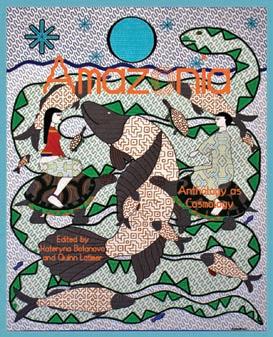
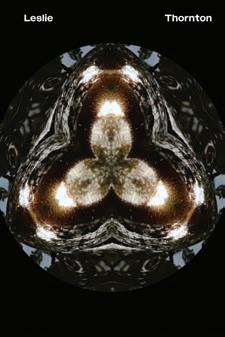
he riters thinkers elders artists and activists contrib utin to this book are all concerned ith A a onia as a place, a subject, a point of view, and a socio ecolo ical world. A collection of voices, images, lands, waters, and spirits both hu an and nonhu an this book atte pts to understand language in an extended sense—where ritin thinkin and art akin take the for of essa s poetr i a es testi onies and h bridi ed other he antholo co prises t o distinct narrative sections te poral structures and points of vie the iver and the orest he river is a kind of ti eline a sentence a thread of ater indin its a throu h the book e plorin indi enous thou ht and histories issues of e or erasure ri hts and cultural practice as ell as the notion of ancestors and activis he space of the forest, meanwhile, is represented as one of oral testi on and conversation of voices speakin inside the present in a kind of circular ti e in hich past and future both impress upon and constitute the current uncertain o ent hese voices include recorded conversations ith elders sha ans artists and thinkers as ell as poetr oral testi on and artistic orks fro A a onia that use the forest as both round and cover
Kateryna Botanova is a Basel-based cultural critic and curator from Kyiv, Ukraine. She is a cocurator of the multidisciplinary cultural festival Culturescapes (Basel, Switzerland). Quinn Latimer is a writer and editor. Her books include Like a Woman (Sternberg Press), Sarah Lucas, and Film as a Form of Writing
art
February | 8 1/4 x 10 1/4, 352 pp. | 136 color illus., 10 b&w illus. US $29.95T/$39.95 CAN paper 978-3-95679-611-1
Distributed for Sternberg Press Not for sale in UK and Europe
US
paper
Copublished with MIT List Visual Arts Center and Kunstverein Nürnberg Distributed for Sternberg Press Not for sale in UK and Europe
131 mitpress.mit.edu | Spring 2022 Distributed by the MIT Press
I Can’t Sleep
Lionel Ruffel

An attempt to feel and investigate the quality of time, with references
Jonathan Crary, Paul B. Preciado, Charles Baudelaire, and Walter Benjamin.
Lionel Ru el is a literary scholar, publisher, and author. Chair and Professor of Comparative Literature at University of Paris 8, he is the founding director of the creative writing program there.
art | February | 4 3/4 x 7 1/2, 56 pp.
US $12.00T/$16.00 CAN paper 978-3-95679-603-6
The Contemporary Condition Distributed for Sternberg Press
Not for sale in UK and Europe
Whose Time Is It?
Asocial Robots, Syncholonialism, and Artificial Chronological Intelligence
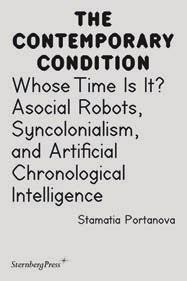
Stamatia Portanova
Following the “emerging life adventures and experiences” of Sophia, a robot animated by blockchain and AI, to present a study in temporal automation.
Stamatia Portanova is Research Fellow at the Department of Human and Social Sciences, Università degli Studi di Napoli “L’Orientale” (Naples) and the author of Moving without a Body: Digital Philosophy and Choreographic Thoughts (MIT Press).
technology | February | 4 3/4 x 7 1/2, 104 pp.
US $12.00T/$16.00 CAN paper 978-3-95679-608-1
The Contemporary Condition
Distributed for Sternberg Press
Not for sale in UK and Europe
by the MIT Press
Assuming Asymmetries
Conversations on Curating Public Art Projects of the 1980s and 1990s edited by CuratorLab
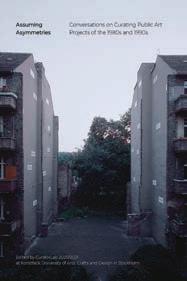
Conversations from some of the most complex and yet underresearched European and US public art exhibitions of the 1980s and 1990s.
art | February | 7 x 9, 304 pp. | 80 illus.
US $25.00T/$34.00 CAN paper 978-3-95679-612-8
Distributed for Sternberg Press Not for sale in UK and Europe
Archeology of a Profession in Sweden
Curating Beyond the Mainstream with Carlos Capelán, Elisabet Haglund, Gunilla Lundahl, and Jan-Erik Lundström
edited by CuratorLab
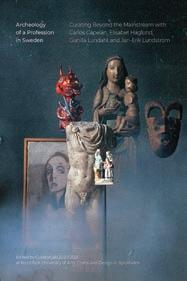
Four case studies bring to the fore decolonial and other non-hegemonic approaches to the profession of curating in Sweden from the 1960s to the early 2000s.
CuratorLab is a curatorial course at Konstfack University of Arts, in Stockholm, which is expanding the ideas of curating and the curatorial beyond the exhibition format, exploring radical approaches to engagement, debating pertinent issues of our times, having collective fun, and practicing horizontal learning.
art | February | 7 x 9, 200 pp. | 40 illus.
US $25.00T/$34.00 CAN paper 978-3-95679-613-5
Distributed for Sternberg Press Not for sale in UK and Europe
to
132 Spring 2022 | mitpress.mit.edu
Distributed
Death Lines
Walking London Through Horror Cinema Lauren Jane Barnett
The first walking guide to London’s role in the evolution of horror cinema, inspired by the city’s dark histories and labyrinthine architectures.
Death Lines is the first alkin uide to ondon s role in the evolution of horror cine a inspired b the cit s dark histories lab rinthine architectures at ospheric streetscapes and uncann deni ens ts ei ht alks lead ou on a series of richl researched et undeniabl chilling tours through Chelsea, Notting Hill, Westminster, loo sbur ovent arden and the ast nd alon the haunted banks of the river ha es and do n into the depths of the ondon nder round rail a ach tour eaves to ether ondon s stories and takes the reader to a nificent eerie and so eti es discon certin l ordinar corners of the cit unearthin the literature le ends and histor behind classics like Peeping Tom and An American Werewolf in London and lesser kno n orks such as the ind control elodra a The Sorcerers;
Gorgo, Britain’s answer to Godzilla; tube terror Death Line; and Bela Lugosi’s mesmeric vehicle The Dark Eyes of London in ed ith hu or social criti ue and ore than a few scares, Death Lines delights in revealing the hidden and often surprisin relationship bet een the cit and the dark cine atic visions it has evoked hether read on the streets or from the comfort of the grave, Death Lines is a treat for all cinephiles, horror fans, and lovers of London lore.
Lauren Jane Barnett is a writer, lecturer, and London horror film walking guide.
travel | performing arts

April | 5 x 7 1/2 240 pp. | 30 illus.
US $19.95T/$25.95 CAN paper 978-1-913689-38-4
Distributed for Strange Attractor Press
133
mitpress.mit.edu | Spring 2022
Distributed by the MIT Press STRANGE ATTRACTOR PRESS
The Neon Hieroglyph
Tai Shani introduction by Amy Hale afterword by Caspar Heinemann
A series of painterly and poetic considerations on a feminized history of the rye fungus Ergot, the chemical basis of LSD, from the author of Our Fatal Magic .

ro the cellular to the alactic via aleolithic cave arkin s to the trace i pressions left b drone photo raph on our ind s e e incorporatin dancin pla ues co unist ps chedelic itches h per se ual fun i chthonic descents and sk ard ascents The Neon Hieroglyph eaves to ether a series of painterl and poetic considerations on a fe ini ed histor of the r e fun us r ot the che ical basis of The Neon Hieroglyph constructs a house of l rical re ections for our hosts to inhabit a place here the othic and the hallucinator collide here othic a ect and fractal dread for a ausoleu for ps chedelic specters And also the un he un is a host that haunts the ni ht ra ed ith ne essa s b artist and riter aspar eine ann and anthropolo ist A ale ai hani s The Neon Hieroglyph continues a ourne into the post patriarchal fictions that ani ated her first collection, Our Fatal Magic
Tai Shani is a Tutor in Contemporary Art Practice at the Royal College of Art. Shani’s multidisciplinary practice, comprising performance, film, photography, and installation, revolves around experimental narrative texts. Amy Hale is an anthropologist who specializes in contemporary occult and Pagan history, religions, and culture in the United States and the United Kingdom. Caspar Heinemann is a poet, artist, and academia-adjacent independent researcher based in London and Berlin. His research interests include critical mysticism, gay biosemiotics, illegitimate communisms, and professional irreverence.
art
March | 6 x 8 1/2, 72 pp. | 10 color illus.
US $22.95T/$29.95 CAN paper 978-1-913689-49-0
Distributed for Strange Attractor Press
134 Spring 2022 | mitpress.mit.edu
Distributed by the MIT Press STRANGE ATTRACTOR PRESS
Dreams and How to Guide Them
The Legendary Dream Control Manual Marquis d’Hervey de Saint-Denys
 introduction by Phil Baker
introduction by Phil Baker
The first unabridged English translation of a classic work on dreams by an author regarded as the father of lucid dreaming.
irst published anon ousl in Dreams and How to Guide Them is the lost classic of lucid dreaming—that is, the art of becoming aware that one is dreaming and then continuing to dream, hether to have erotic encounters, or just explore the dream world further. It has long been a rare and le endar ork reud kne of it, but never managed to find a cop and surrealist André Breton begins his o n book The Communicating Vessels b discussin it his is the first co plete n lish translation—there was a heavil abrid ed edition in uch loved and also rare and it is no published to celebrate the th anniversar of the birth of erve de aint en s his ne edition is edited and introduced b hil aker ho traces the author s life and connects his ork ith ibetan uddhist drea practices and surrealis as well as to more recent research in lucid dreaming.
The Marquis d’Hervey de Saint-Denys (1822–1892) was a French sinologist also known for his research on dreams. He is today regarded as the father of lucid dreaming. Phil Baker is a writer based in London. His books include The Devil Is a Gentleman: The Life and Times of Dennis Wheatley, and Austin Osman Spare: The Life and Legend of London’s Lost Artist (Strange Attractor), called by Alan Moore “little short of marvelous.”
Postcards for Mia

Michael Taussig
A picture book to be shared and savored by both children and adults: a journey into a wondrous world colored by the stories we might choose to tell about it.
A full moon after a wasp attack poppies from a train, panning for gold in the River Cesecito, a bountiful pu pkin harvest . . . .
Postcards for Mia is a o ful collection of hand dra n and painted postcards sent b anthropolo ist ichael aussi to his randdau hter ia ro airports in e ork to cemeteries in Colombia, confrontations with wild boars to conversations ith ell dressed koalas Postcards for Mia is a picture book to be shared and savored b both children and adults a ourne into a ondrous orld colored b the stories e i ht choose to tell about it Anthropolo ist ichael aussi is reno ned for his visionar e plorations of color a ic and th founded upon over fort ears e perience ith co unities in olo bia and ene uela as ell as research visits to alestine urdish ria abul Alice prin s dne enice and aris his his first full illustrated picture book provides a re arkabl personal insi ht into aussi s uni ue a of seein and respondin to the orld ra in observation and reverie into vibrant and hu orous acts of vivid stor tellin this deli htful scrapbook docu ents the ar th and e cite ent of an inter enerational e chan e inspired b the si ple pleasure of recounting the excitement of one’s travels.
Michael Taussig is a writer and an anthropologist. He is the author of several books, including The Magic of the State, I Swear I Saw This, and most recently, Mastery of Non-Mastery in the Age of Meltdown
body, mind, and spirit May | 6 x 8 1/2, 352 pp. 1 color illus., 20 b&w illus. US $25.00T/$34.00 CAN paper 978-1-913689-40-7 Distributed for Strange Attractor Press
May | 8 1/2 x 6, 72 pp. | 40 color illus. US $25.00T/$34.00 CAN cloth 978-1-913689-42-1 Distributed
Strange
Press 135 mitpress.mit.edu | Spring 2022 Distributed by the MIT Press STRANGE ATTRACTOR PRESS
art
for
Attractor
Purgatory

The Trash Project: Towards The Decay Of Meaning
Ken Hollings
A series of essays modeled on the Purgatorio of Dante Alighieri—personal reflections, historical incidents, and unexpected mythological correspondences.
In this sequel to 2020’s Inferno, Hollings shifts his attention a a fro A erica in the A e of op to take a close look at uropean decadence and deca at the end of the nineteenth centur Purgatory follows the twin fates of all ard and ancock as the are dra n like so an artists before them, towards the cit of aris t as here that e iled edish pla wright August Strindberg struggled to turn iron and carbon into gold, while the aesthete Sâr Péladan staged his sumptuous Salons de la ose roi ver a series of thirt three essa s directl odeled on the Purgatorio of ante Ali hieri personal re ections historical incidents and une pected tholo ical correspondences are co bined to uncover a restless under round lab rinth of alche ists poets painters and philosophers o ether their co bined in uence ould shape not onl the events of a but the e er ence of a uni uel uropean for of rash cine a devoted e clusivel to beaut se and despair.
o celebrate the th anniversar of ante s death en ollin s o ers the reader a radical retellin of the middle part of the Divine Comedy ell a be a tou h act to follo but as olu e o of the rash ro ect reveals, Purgatory can be just as weird and dangerous.
Ken Hollings is a writer, broadcaster, and cultural theorist based in London and the author of
Everything Keeps Dissolving
Conversations with Coil edited by Nick Soulsby
Core members of the legendary British experimental band Coil tell its story in the present tense, as events unfold across its twenty-year history.
et een and the le endar ritish e peri ental band oil established itself as a shape shiftin do en of esoteric usic hose in uence has ro n spectacularl in the ears since its unti el end ith usic that could be dark ueer and difficult but often retained a warped pop sensibilit oil s albums were multifaceted repositories of esoteric kno led e l ser ic isdo and acerbic humor. In Everything Keeps Dissolving, core members John Balance and Peter Christopherson tell oil s stor in the present tense and fro their personal perspectives, as events unfold across the band’s t ent ear histor
Acco panied b their various collaborators the describe the fertile eruption of ideas, inspirations, and stra tan ents that infor ed their l rical and usical visions as ell as those dead paths and casto concepts that didn t take root ot onl a or s e e vie of oil these interviews provide insight into the late twentieth centur s evolvin ritish cultural under round as chan neled throu h t o of its ost astutel ercurial inds
Nick Soulsby is the author of Swans: Sacrifice and Transcendence, Thurston Moore: We Sing a New Language, and Cobain On Cobain: Interviews and Encounters
and The Bright Labyrinth (both published by
to
performing arts

Press).
Royal College of Art. art April | 5 3/4 x 8, 400 pp. | 20 illus. US $19.95T/$25.95 CAN paper 978-1-913689-23-0 Distributed for Strange Attractor Press
April | 6 x 8 1/2, 240 pp. | 20 illus. US $22.95T/$29.95 CAN paper 978-1-913689-43-8
Distributed for Strange Attractor Press
Distributed by the
STRANGE ATTRACTOR PRESS
Welcome
Mars
Strange Attractor
He teaches at the
136 Spring 2022 | mitpress.mit.edu
MIT Press
England’s Hidden Reverse
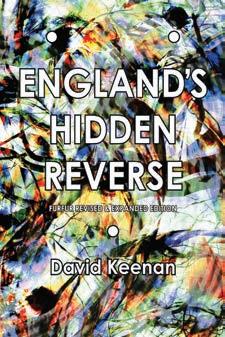
A Secret History of the Esoteric Underground revised and expanded edition
David Keenan
An expanded edition of the classic exploration of the English esoteric musical underground—with the first biographies of Coil, Current 93, and Nurse With Wound.
his ne l e panded edition of England’s Hidden Reverse, the classic e ploration of the n lish esoteric usical underground that includes the first and onl bio ra phies of Coil, Current 93, and Nurse With Wound, is based on exclusive inter views and unprecedented access to all three bands’ personal archives o ether these enre def in bands and their circles represent the n lish under round in all its cultural, artistic, and se ual variet ver four decades, the three intertwined groups have aintained a s biotic et uneas relationship ith the ainstrea of popular culture, even as their music, beliefs, and practices have repelled the fro it heirs as a clandestine scene hose ork accents the an occulted peculiarities of n lishness that o throu h enerations of outsiders channelin personalities as diverse as Aleister ro le Arthur achen oe rton hirle ollins rk and arc Al ond he stor of this idden everse has necessaril re ained a secret ntil no his ne volu e contains al ost pa es of e tra aterial culled fro urfur a collection of intervie s ith musicians and artists whose careers intersected with the bands initiall published alon side tran e Attractor s first li ited edition of the book
Bone Music
Soviet X-Ray Audio edited by Stephen Coates
Stories of the secret underground Cold War–era Soviet music subculture that distributed forbidden music on used hospital x-rays.

urin the old ar era the son s that oviet citi ens could listen to ere ruthlessl controlled b the state ut a secret under ground subculture of music lovers and bootleggers defied the censors building recording machines and akin their own records of forbidden a rock n roll and Russian music, cut onto used hospital ra fil Bone
Music is the follow up the acclaimed X-Ray Audio: The Strange History of Soviet Music on the Bone, delving deeper into a forgotten era when being a music fan could mean a len th prison sentence or orse ho ade these records h did the do it and ho as it even possible ore roundin intervie s and oral testi onies athered over five ears Bone Music presents the stories of the original bone bootleggers, their customers, musicians, record collectors, and com entators evokin a spirited resistance to a repressive culture of prohibition and punishment. It reveals that althou h estern a and rock n roll ere i portant to the til a i outh culture the true rebel usic as that of forbidden ussian i r s ps ro ances and cri inal tunes the soul son s of a societ brutall cut o from its culture.
ichl illustrated ith do ens of ne i a es of oviet ra discs and sound letters
performing arts
February | 9 1/4 x 8 3/4, 208 pp. | 85 color illus., 22 b&w illus.
US $33.95T/$44.95 CAN paper 978-1-913689-47-6
Distributed for Strange Attractor Press
David Keenan is the author of the novels This is Memorial Device, For The Good Times, and Monument Maker
April | 6 1/2 x 8 1/2, 456 pp. | 113 color illus., 113 b&w illus. US $33.95T/$44.95 CAN paper 978-1-913689-45-2 Distributed for Strange Attractor Press
performing arts
Stephen Coates is the editor of X Ray Audio (Strange Attractor Press), a music producer, and director of the arts company Antique Beat.
137 mitpress.mit.edu
STRANGE ATTRACTOR PRESS
| Spring 2022 Distributed by the MIT Press
Another Love Discourse
Edie Meidav
A lyric novel about the play of grief, empathy, new and old love, and the quest to overcome blindness in human relations.

au ht in the cross currents of a frau ht divorce and a new love, the death of her mother, and a global pandemic, a writer plunges into an obsession with the ork of s rench philosopher Roland Barthes. er stru les to ake sense of his ork and life and of what can happen to a woman’s settled life in a sin le harro in ear result in an engrossing, funn earth and innovative l ric ork he uest for authenticit in otherhood se ualit and tenanc on the earth and in the home, as ell as the unusual l ric for ake the novel unified in spirit et transdisciplinar in approach
Edie Meidav, called an “American original,” is the author of the novels Crawl Space, The Far Field and Lola, California. Her previous work has been recognized by the Bard Fiction Prize and the Kafka Prize and has received support from the Fulbright Program, the Howard Foundation, the Lannan Foundation, and the Whiting Foundation. A senior editor at the journal Conjunctions, she teaches in the MFA program at the University of Massachusetts Amherst.
“An alchemist of empathy, of nuanced observation and unexpected truths, Edie Meidav is a writer whose every magical story probes human experience from triumphs to tragedies and all the terrain between.”
—Bradford Morrow
biography | memoir
April | 5 1/2 x 8 1/4, 184 pp. | 15 illus.
US $23.95T/$31.95 CAN paper 978-1-949597-20-2
Distributed for Terra Nova Press
Spring 2022 | mitpress.mit.edu
Overtone Singing
Harmonic Dimensions of the Human Voice Mark van Tongeren
foreword by Trân Quang Hai
An indispensable guide to a deeper understanding of the nature of the human voice and its harmonic possibilities from East to West.
Overtone Singing is the ost co prehensive book ever written on the hidden harmonies of the human voice. thno usicolo ist and vocalist ark van on eren o ers fascinatin insi hts into the timeless and universal aspects of sound and vibration. Grounded in the author s decade lon stud of Asian usic the book dra s upon field ork intervie s ith astern and Western musicians, and copious scholarship to present a ultidisciplinar vision of sound that runs from global music to the science of acoustics and perception, onward to the philosophical and spiritual dimensions of music. Written in a nontechnical st le this enerousl illustrated book is an indispensable guide for musicians, listeners, and perfor ers seekin a deeper understandin of the nature of the human voice and its harmonic possibilities from ast to est

Mark van Tongeren is best known for his work as an overtone/throat singer. He was a performer with the Amsterdam-based experimental group Silo Theatre and the seven-piece improvisation band Oorbeek. His recent work includes the performance Incognito Ergo Sum with Superstringtrio, and the Overtone Singing Marathon based upon his cycle of compositions “Zeropoint,” performed in collaboration with composer Paul Oomen. He lives in Taiwan.
“Has interesting things to teach to everyone who is intrigued by the mysteries of sound.”
—Trân Quang Hai
performing arts
May | 6 x 9, 352 pp. | 30 b&w illus. US $27.95T/$36.95 CAN paper 978-1-949597-22-6
Distributed for Terra Nova Press
138
Distributed by the MIT Press TERRA NOVA PRESS
Revolutionary Demonology
Gruppo di Nun foreword by Amy Ireland
An anthology of occult resistance: unpredictable and fascinating, at times hallucinatory, sullying politics, philosophy, cybertheory, religion, and music.

he nd i es are here he i ital iddle A es approaches the pla ue reaps its deadl harvest cli ate apocal pse is around the corner and fanaticis fascis and adness are ra pant he idea that e i ht ain the upper hand over the dark ab ss into hich the planet is tu blin is a for of a ical thinkin laborin under the delusion that e can subdue eternit ith relentless bloodlust, brutish exploitation, abuse of power, and violence. Revolutionary Demonology responds to this ritual of control t pical of hat esoteric tradition calls the “ o a of the i ht and ” b reactivatin the occult forces of a Left Hand Path that strives for the entropic disinte ration of all creation so as to ake peace ith the darkness and nourish the reat east that ill finall break the seals of os ic ove npredictable and fascinatin enuinel bi arre at ti es hallucinator sull in politics philosoph c bertheor reli ion and usic alike ith its fevered touch this “antholo of occult resistance” collects together the communiqués of an arcane group who are alread bein hailed as the first orbid blosso in of “ talian eird heor ” a ro ue contin ent of theorists itches and sorcerers ho hereticall re i othic accelerationism with satanic occultism and insurrectional necro anc
Gruppo di Nun is a collective of psycho-activists based in Italy, dedicated to organizing forms of covert resistance to heteropatriarchal dogma. Amy Ireland is a theorist and experimental writer based in Melbourne, Australia.
cultural studies | occult
February | 5 3/4 x 8 1/4, 320 pp. | 10 illus.
US $24.95T/$33.95 CAN paper 978-1-913029-90-6
Distributed for Urbanomic
139
2022
mitpress.mit.edu | Spring
Distributed by the MIT Press
Parallel Minds
Discovering the Intelligence of Materials
Laura Tripaldi
preface by Matteo de Giuli
Insights into the intelligence throughout the natural and technical environment, in the fabric of our devices and dwellings, in our clothes, and under our skin.
s there a a to understand the aterials that surround us not as passive objects, but as other intelligences interacting with our own?
In Parallel Minds, expert in materials science and nanotechnolo aura ripaldi delivers not onl detailed insights into the properties and emergent behaviors of matter as revealed b state of the art che istr s nthetic biolo and nanotech, but also a rich philosophical re ection that crosses the frontier between nature and culture, here the ost cuttin ed e scientific s ntheses resonate ith ancient th he result is a techno aterial bestiar full of une pected encounters with “strange minds”—from cobwebs to kevlar and carbon fibre fro centaurs to a oebas to arachnids fro pol cephalic sli e to resonatin plasmons, from viruses to golems.

Parallel Minds reveals the intelligence at large through out the natural and technical environment, in the fabric of our devices and dwellings, in our clothes, and even under our skin ull of lateral ideas and une pected i a es ripaldi s book i bues the stud and s nthesis of ateri als ith a ne ur enc or not onl do the aterials that surround us participate activel in the construction of the orld in hich e live but harnessin their abilit to interact intelli entl ith their environ ent could be the ke to the future of our species
The Revenge of Reason
Peter Wolfendale
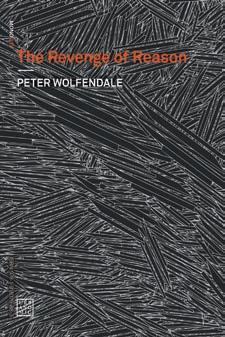
foreword by Ray Brassier and Reza Negarestani
Neorationalism as a distinctive philosophical trajectory, exploring the outermost possibilities of Prometheanism, Inhumanism, and Enlightenment.
hat is the fate of eason in the t ent first centur oda ore than ever in the face of disinfor ation memetic plagues, and neuroactive media, if we are to resist not just the continual solicitation of our co nitive re e es but also the unearned authorit of endless ever an rational ists and self appointed secular priests of rationalit then we have no choice but to obili e eason to continuall dissect the responsibilities the shirk and to embrace the future demands of thought. Peter Wolfendale has long been dedicated to this philosophical task and The Revenge of Reason la s out his vision for eorationalis as a distinc tive philosophical tra ector e plorin the outer ost possibilities of Prometheanism, Inhumanism, and nli hten ent his volu e collects intervie s and ritin s on various philosophical fi ures and topics addressin the deepest uestions of h sis o os and thos all ith e e plar clarit and peda o ical enerosit A ainst those ho ould chain the fate of hu anit to its ani al nature olfendale s ork akes the case for unbindin our rationalit fro ever pett naturalis and ever fi ed i a e of thou ht heraldin an inhu an destin unleashed b the reven e of eason
Peter Wolfendale, an independent philosopher living in the North East of England, is the author of Object-Oriented Philosophy: The Noumenon’s New Clothes (Urbanomic). Ray Brassier is a British philosopher and the author of Nihil Unbound: Enlightenment and Extinction Reza Negarestani is a philosopher and the author, most recently, of Intelligence and Spirit (Urbanomic / Sequence Press).
philosophy
March | 4 1/2 x 7, 308 pp.
US $24.95T/$33.95 CAN paper 978-1-913029-87-6
Mono
Distributed for Urbanomic
140 Spring 2022 | mitpress.mit.edu Distributed by the MIT Press
Laura Tripaldi is a PhD student in Materials Science and Nanotechnology at Università degli Studi di Milano-Bicocca. Matteo De Giuli is a writer for TV and radio, and Senior Editor of the online journal Il Tascabile
philosophy | science February | 5 1/4 x 7 1/2, 160 pp. | 5 illus. US $18.95T/$24.95 CAN paper 978-1-913029-93-7 Distributed for Urbanomic
Also available
Body without Organs, Body without Image
Ernesto Neto’s Anti-Leviathan (Undoing the Image 1)
Éric Alliez
with Jean-Claude Bonne translated by Robin Mackay
US $24.95T/$33.95 CAN paper 978-0-9954550-2-3
Becoming-Matisse
Between Painting and Architecture (Undoing the Image 2)
Éric Alliez
with Jean-Claude Bonne translated by Robin Mackay
US $31.95T/$41.95 CAN paper 978-1-9164052-0-2
Duchamp Looked At (From the Other Side)
(Undoing the Image 3)
Éric Alliez
with Jean-Claude Bonne translated by Robin Mackay
US $35.95T/$47.95 CAN paper 978-1-913029-67-8
Three Entries in the Form of Escape Diagrams
An Instruction Manual for Contemporary Art (Undoing the Image 4)

Éric Alliez
with Jean-Claude Bonne translated by Robin Mackay
US $35.95T/$47.95 CAN paper 978-1-913029-97-5
Urbanomic / Art Editions
Boîte HO
Hélio Oiticica (Undoing the Image 5) Éric Alliez with
Jean-Claude Bonne
How Hélio Oiticica, one of the leading artists of Neo-Concretism, presaged the unique trajectory of Brazilian contemporary art with his intensive color-architectures.
At the turn of the s s one of the leadin artists of eo oncretis lio iticica presa ed the uni ue tra ector of ra ilian conte porar art ith his intensive color architectures n the ake of this vivência of “ti e color ” hich subordinates the aesthetic to the sensorimotor powers of color, iticica s transcate orial trans edia orks criticall and clinicall under ine ph sical and social architecture hile se ioticall subvertin the for s of do ination e erted b the i a e
In this culmination of their reassessment of the relation a on art philosoph and the conte porar ric Allie and ean laude onne sho ho these orks are e e plar not onl of a trul dia ra atic thou ht and practice, but also of the South’s resistance against the coldl indi erent lobalis ende ic to the pacified institutions of conte porar art iticica s tropicalization of the commonplaces of sixties art signals the latent potential of a marginal dissidence from both the aesthetic form of art and the conceptual for of anti art
Éric Alliez is a philosopher and Professor at Université Paris 8 and at the Centre for Research in Modern European Philosophy at Kingston University, London. He is author of Capital Times, The Signature of the World: Or, What is Deleuze and Guattari's Philosophy?, and other books. Jean-Claude Bonne is an art historian and Director of Studies at the École des Hautes Études en Sciences Sociales, Paris. He is author of L’Art roman de face et de profil: Le tympan de Conques, Le Sacre royal à l’époque de Saint-Louis (with Jacques Le Go ), and, with Éric Alliez, La Pensée-Matisse
art
February | 7 x 9 3/4, 72 pp. | 10 color illus., 13 b&w illus.
US $24.95T/$33.95 CAN paper 978-1-913029-98-2
Art Editions
Distributed for Urbanomic
141 mitpress.mit.edu | Spring 2022
Distributed by the MIT Press
ARTMargins
Sven Spieker, Karen Benezra, Octavian Eșanu, Pedro Erber, Angela Harutyunyan, and Saloni Mathur, editors
ARTMargins publishes scholarly articles and essays about contemporary art, media, architecture, and critical theory. The journal is devoted to art practices and visual culture in the emerging global margins, from North Africa and the Middle East to the Americas, Eastern and Western Europe, Asia and Australasia.

Triannual, ISSN 2162-2574 | February/ June/October | 128 pp. per issue | 6 x 9, illustrated https://direct.mit.edu/artm
Dædalus

Phyllis S. Bendell, managing editor
Drawing on the nation’s most prominent thinkers in the arts, sciences, humanities, and social sciences,as well as the professions and public life, Dædalus Journal of the American Academy of Arts and Sciences, explores the frontiers of knowledge and issues of public importance.
Quarterly, ISSN 0011-5266 | Winter/ Spring/Summer/Fall 144 pp. per issue | 7 x 10 https://direct.mit.edu/daed

PAJ: A Journal of Performance and Art
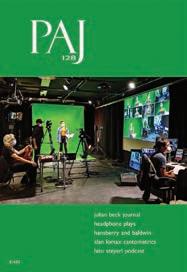
Bonnie
Marranca, editor
PAJ explores innovative work in theatre, performance art, dance, video, writing, technology, sound, and music, bringing together all live arts in thoughtful cultural dialogue.
Triannual, ISSN 1520-281X January/May/September 128 pp. per issue | 7 x 10, illustrated https://direct.mit.edu/pajj
October
Rosalind Krauss, Annette Michelson (1922–2018), George Baker, Yve-Alain Bois, Benjamin H. D. Buchloh, Leah Dickerman, Devin Fore, Hal Foster, Denis Hollier, David Joselit, Carrie Lambert-Beatty, Mignon Nixon, Malcolm Turvey, Huey Copeland, and Pamela M. Lee,
editors
At the forefront of art criticism and theory, October focuses critical attention on the contemporary arts—film, painting, music, media, photography, performance, sculpture, and literature—and their various contexts of interpretation.
Quarterly, ISSN 0162-2870 | Winter/Spring/Summer/Fall 160 pp. per issue | 7 x 9, illustrated https://direct.mit.edu/octo
African Arts
edited by the African Arts Consortium: UCLA, University of Florida, and University of North Carolina at Chapel Hill
African Arts presents original research and critical discourse on traditional, contemporary, and popular African arts and expressive cultures. Since 1967, the journal has reflected the dynamism and diversity of several fields of humanistic study, publishing richly illustrated articles in full color, incorporating the most current theory, practice, and intercultural dialogue.
Quarterly, ISSN 0001-9933 | Spring/Summer/Autumn/Winter 88-100 pp. per issue | 8 1/2 x 11, illustrated https://direct.mit.edu/afar
Published by the James S. Coleman African Studies Center, UCLA, and distributed by the MIT Press

arts & humanities arts & humanities
142 Spring 2022 | mitpress.mit.edu Journals
science and technology
Design Issues
Bruce Brown, Richard Buchanan, Carl DiSalvo, Dennis P. Doordan, Kipum Lee, and Ramia Mazé, editors
The first American academic journal to examine design history, theory, and criticism, Design Issues provokes inquiry into the cultural and intellectual issues surrounding design. Regular features include theoretical and critical articles by professional and scholarly contributors, extensive book and exhibition reviews, and visual sequences.
Quarterly, ISSN 0747-9360 112pp. per issue | 7 x 10, illustrated https://direct.mit.edu/desi
Leonardo
Nicholas Cronbach, senior editor
Leonardo is the leading international peer-reviewed journal on the use of contemporary science and technology in the arts and music and, increasingly, the application and influence of the arts and humanities on science and technology.

Five issues per year, ISSN 0024094X February/April/June/August/October 112 pp. per issue | 8 1/2 x 11, illustrated https://direct.mit.edu/leon
Grey Room
Zeynep Çelik Alexander, Lucia Allais, Eric C.H. de Bruyn, Noam M. Elcott, Byron Hamann, John Harwood, and Matthew C. Hunter, editors
Grey Room brings together scholarly and theoretical articles from the fields of architecture, art, media, and politics to forge a cross-disciplinary discourse uniquely relevant to contemporary concerns. Publishing some of the most interesting and original work within these disciplines, Grey Room has positioned itself at the forefront of the most current aesthetic and critical debates.

Quarterly, ISSN 1526-3819 | Winter/Spring/Summer/Fall 128 pp. per issue | 6 3/4 x 9 5/8, illustrated https://direct.mit.edu/grey
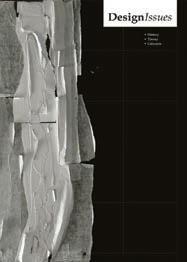
Neurobiology of Language
Steven L. Small and Kate E. Watkins, editors-in-chief
Neurobiology of Language provides a new, high-integrity venue for articles across a range of disciplines addressing the neurobiological basis of human speech and language. O ering open access publishing, rigorous double-blind peer review, and quick turnaround times for authors, the journal aims to facilitate the replicability of experimental findings through modern open science requirements such as sharing of raw data and detailed methods.
Open Access | Quarterly | Founded: 2018 | E-ISSN 2641-4368 https://direct.mit.edu/nol
Data Intelligence

A key resource for industry leaders and researchers engaged in sharing and reusing data, metadata, knowledge bases, and data visualization tools.
Open Access | Quarterly | Founded: 2018 E-ISSN 2641-435X https://direct.mit.edu/dint
Quantitative Science Studies
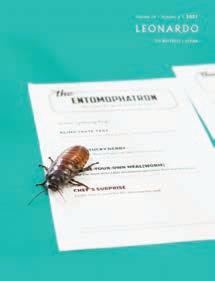
Ludo Waltman, editor-in-chief Quantitative Science Studies is the o cial open access journal of the International Society for Scientometrics and Informetrics (ISSI). It will publish theoretical and empirical research on science and the scientific workforce. Emphasis will be placed on studies that provide insight into the system of science, general laws of scientific work, scholarly communication, science indicators, science policy, and the scientific workforce.
Open Access | Quarterly | E-ISSN 2641-3337 https://direct.mit.edu/qss
Transactions of the Association for Computational Linguistics

Ani Nenkova and Brian Roark, editors-in-chief
Disseminating work of vital relevance to academic and industry computational linguists, natural language processing experts, artificial intelligence and machine learning investigators, cognitive scientists, speech specialists, as well as linguists and philosophers.
Open Access | Annual | Founded: 2013 | E-ISSN 2307-387X https://direct.mit.edu/tacl
arts & humanities
143 mitpress.mit.edu | Spring 2022
Open Mind: Discoveries in Cognitive Science
 Edward Gibson, editor
Edward Gibson, editor
Open Mind provides a new venue for the highest quality, most innovative work in cognitive science, o ering a ordable open access publishing, concise and accessible articles, and quick turnaround times for authors. The journal covers the broad array of content areas within cognitive science using approaches from cognitive psychology, computer science and mathematical psychology, cognitive neuroscience and neuropsychology, comparative psychology and behavioral anthropology, decision sciences, and theoretical and experimental linguistics.
Open Access | Annual volume with articles published upon acceptance
680 pp. per issue | 8 1/2 x 11 | Founded: 2017 | E-ISSN: 2470-2986 https://direct.mit.edu/opmi
Network Neuroscience
Olaf Sporns, editor
Network Neuroscience features innovative scientific work that significantly advances our understanding of network organization and function in the brain across all scales, from molecules and neurons to circuits and systems.
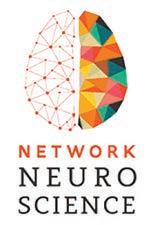
Quarterly | E-ISSN 2472-1751 Winter/Spring/Summer/Fall 330 pp. per issue | 8 1/2 x 11 Founded: 2017 https://direct.mit.edu/netn
Global Environmental Politics
Steven Bernstein, Matthew Ho mann, and Erika Weinthal, editors
GEP examines the relationships between global political forces and environmental change, with particular attention given to the implications of local-global interactions for environmental management as well as to the implications of environmental change and environmental politics for world politics.
Quarterly, ISSN 1526-3800 | February/ May/August/November | 164 pp. per issue | 6 x 9 https://direct.mit.edu/glep
International Security
Steven E. Miller, editor-in-chief
Sebastian Rosato, executive editor (pro tem)
Amanda Pearson, managing editor
Owen R. Coté Jr., editor
International Security, the #1 journal in International Relations based on 2019 impact factor, publishes lucid, welldocumented essays on the full range of contemporary security issues, including the growing importance of environmental, demographic, and humanitarian issues, transnational networks and emerging technologies.
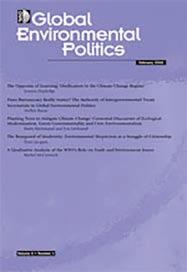
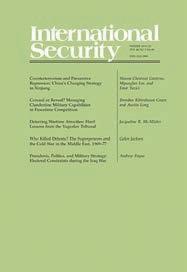
Quarterly, ISSN 0162-2889 | Summer/Fall/Winter/Spring | 208 pp. per issue | 6 3/4 x 10 https://direct.mit.edu/isec
Published by the MIT Press for the Belfer Center for Science and International A airs, Harvard University
The Journal of Interdisciplinary History
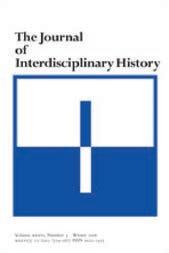
Anne E. McCants, editor
Robert I. Rotberg, founding editor
Theodore K. Rabb (1937–2019), founding editor
Reed Ueda, coeditor emeritus
The Journal of Interdisciplinary History features substantive articles, research notes, review essays, and book reviews that relate historical study to other scholarly disciplines such as economics and demography. Topics span all geographical areas and periods of study.
Quarterly, ISSN 0022-1953 | Summer/Autumn/Winter/Spring 192 pp. per issue | 5 3/4 x 9 https://direct.mit.edu/jinh
science
economics
and technology
| political science | international affairs | history
144 Spring 2022 | mitpress.mit.edu
The MIT Press Direct
eBook Collections

MIT Press Direct is the best way for libraries to o er the full range of MIT Press eBooks to their patrons. Libraries can access the complete collection, more than 3,000 eBooks and at least 150 added each year, or subject-specific collections.
Key subject areas covered in the complete collection include art and architecture, biomedical sciences, business and finance, computer science, cognitive science, design, education, environment, game studies, humanities, information science, linguistics, neuroscience, new media, philosophy, and social sciences. Available subject collections include: economics; environmental science; philosophy; and science, technology, and society.
Stay in touch with the MIT Press Newsletter
Sign up for our e-newsletter to hear about new books and to receive exclusive discounts and o ers: mitpress.mit.edu/ subscribe Podcast
Hear directly from our authors through our Author Podcasts: mitpress.mit.edu/podcasts

Blog

The MIT Press blog chronicles news about MIT Press authors and books: mitpress.mit.edu/blog
MIT Press Reader
MITCogNet
From the MIT Press
CogNet is an indispensable resource for cutting-edge primary research on the human mind. With an expanding collection of over 780 books, 9 journals, and 12 major reference works, CogNet provides unparalleled access to over 490,000 pages of DRM-free content.
Drawing on our rich archive and family of authors, the Reader showcases thought-provoking excerpts, interviews, and other original works by Press-a liated authors, past and present. thereader.mitpress.mit.edu
MITCogNet
From the MIT Press
Find out for yourself what scholars at Caltech, Princeton, Tufts, and the National Institutes of Health already know: CogNet is the essential tool for research in the brain and cognitive sciences. With DRM-free content, counter-compliant usage reporting, and a beautiful responsive website.
cognet.mit.edu
follow us @mitpress


mitpress.mit.edu

The Digital MIT Press
145 mitpress.mit.edu | Spring 2022
NORTH AMERICA
How to order:
By Phone: 1-800-726-0600 or 1-800-733-3000 in the U.S. 1-888-523-9292 in Canada, or 1-410-848-1900 for international inquiries (Business Hours: Monday–Friday from 8:30 A.M.-5:00 P.M. EST)
By Fax: 1-800-659-2436 in the U.S., 1-888-562-9924 in Canada, or 212-572-6045 for international inquiries
By Mail:
Customer Service
Penguin Random House Distribution Center 400 Hahn Road Westminster, Maryland 21157 USA
For Domestic returns inquiries: Penguin Random House Returns Department 1019 N State Road 47 Crawfordsville, Indiana 47933
For Canadian returns inquiries:
Penguin Random House of Canada Limited 6971 Columbus Road Mississauga, Ontario CANADA L5T 1K1
By toll-free electronic orders (EDI): 1-800-726-0600; ask for the Electronic Ordering Department
For more information, contact: The MIT Press One Broadway, 12th floor Cambridge,MA 02142 USA e-mail: mitpress_sales@mit.edu
INTERNATIONAL SAL ES
United Kingdom & Ireland Publishers Group UK 63-66 Hatton Garden London EC1N 8LE
Phone: +44 (0)20 7405 1105 Fax: +44 (0)20 7242 3725 Email: sales@pguk.co.uk
Australia
Penguin Random House Australia Level 3, 100 Pacific Highway North Sydney NSW 2060 Phone: +61 2 9954 9966 Fax: +61 2 9954 4562 Email: orders@unitedbookdistributors.com.au
New Zealand
Penguin Random House New Zealand Ground Floor, Air New Zealand Building Smales Farm 74Taharoto Road Takapuna, Auckland 0622 Phone: +64 (0)9 442 7400 Email: orders@unitedbookdistributors.co.nz
India
Penguin Random House India 7th Floor, Infinity Tower C
DLF Cyber City, Gurgaon – 122 002, Haryana Phone: +91-124-4785615 Email: PRH_Business@penguinrandomhouse.in
Rest of world
International Sales
Penguin Random House 1745 Broadway, New York, NY 10019 USA
Email: internationalsales@penguinrandomhouse.com
146 Spring 2022 | mitpress.mit.edu Order Information and Rights Representation | Book Division
Examination copies are available at the discretion of the MIT Press to qualified instructors of appropriate courses.
Please address inquiries to: e-mail: mitpress_textbooks@mit.edu
Review Copy Requests: Please submit review copy requests on the letterhead of the publication to the Publicity Department. e-mail: mitpress-publicity@mit.edu
Subsidiary and International Rights: For information on subsidiary and international rights, please contact: Bill Smith
Director of Business Development and Trade Strategy
One Broadway, 12th floor Cambridge, MA 02142 USA
Tel: 617 253 0629 e-mail: smithwmj@mit.edu
For Permissions and Subsidiary Rights (Europe):
Pam Quick
Subsidiary Rights Manager
One Broadway, 12th floor Cambridge, MA 02142 USA
Tel: 617 253 0080 e-mail: quik@mit.edu
Discount Codes: T: Trade Discount X: Text Discount
THE MIT PRESS IS REPRESENTED THROUGHOUT THE WORLD BY THE FOLLOWING OUTSTANDING RIGHTS REPRESENTATION:
Agência Ri | Brazil
Joao Paulo Ri | joaopaulo@agenciari .com.br
Bulgaria, Serbia, Croatia, Macedonia, Czech Republic, Slovenia, Slovakia, and Hungary
Diana Matulić | diana@cortoliterary.com
Bardon Media Agency | China Ivan Zhang| ivan@bardonchinese.com
Bardon Media Agency | Taiwan Luisa Yeh | luisa@bardonchinese.com
Anna Jarota Agency | France Anna Jarota | ajarota@ajafr.com
The Berlin Agency | Germany Frauke Jung-Lindemann | jung-lindemann@berlinagency.de
O.A. Literary Agency | Greece Michael Avramides | amichael@otenet.gr
Maxima Creative Agency | Indonesia Santo Manurung | santo@cbn.net.id
Deborah Harris Agency | Israel Efrat Lev | efrat@thedeborahharrisagency.com
Reiser Literary Agency | Italy Roberto Gilodi | roberto.gilodi@reiseragency.it
The English Agency | Japan Tsutomu Yawata | tsutomu_yawata@eaj.co.jp
Korea Copyright Center | Korea Korea | Joeun Lee, jelee@kccseoul.com
Sebes & Bisseling Literary Agency | Netherlands, Sweden, Finland, Norway, Denmark, Iceland Jeanine Langenberg | langenberg@sebes.nl
Graal Ltd. | Poland Lukasz Wrobel | lukasz.wrobel@graal.com.pl
Ilidio Matos Agencia Literaria | Portugal Gonçalo Gama Pinto, goncalo.gamapinto@ilidiomatos.com
The Kessler Agency | Romania Andreea Focsaneanu | andreea@kessler-agency.ro
Alexander Korzhenevski Agency (AKA) | Russia Igor Korzhenevski | igor.akagency@gmail.com
Agencia Literaria Carmen Balcells | Spain Andrea Quesada | international@agenciabalcells.com
The Kayi Agency | Turkey Fusun Kayi | fusun@nkliteraryagency.com
For all other translation rights queries, please contact: Bill Smith Director of Business Development and Trade Strategy The MIT Press One Broadway, 12th floor, Cambridge MA 02142 Tel: 617-253-0629 smithwmj@mit.edu
147 mitpress.mit.edu | Spring 2022 Order Information and Rights Representation | Book Division
Action, Mind, and Brain, Rosenbaum 93
Active Inference, Parr 97
Advanced Microeconomics for Contract, Institutional, and Organizational Economics, MacLeod 90
After the Bauhaus, Before the Internet, Kaplan 122
Agron, Perspecta 54 50
Aït-Touati, Terra Forma 31
Allen, Logic Primer, third edition 92
Alliez, Boîte HO 141
Amazonia, Botanova 131
American Magus Harry Smith, revised and expanded edition, Igliori 126
An Experiential Introduction to Principles of Programming Languages, Rajan 87
An Infinity of Worlds, Kinney 19
Anderson, University Chemistry 83
Andrews, The Polyhedrists 44
Another Love Discourse, Meidav 138
Aragon, Human-Centered Data Science 95
Archeology of a Profession in Sweden, CuratorLab 132
Art Demonstration, Grace 73
Art of Abduction, Douven 109
Art, Science, and the Politics of Knowledge, Rogers 115 Artificial Communication, Esposito 39
Assuming Asymmetries, CuratorLab 132
Astroquizzical, Scudder 18
Atlas of Perfumed Botany, Ellena 14
Baber, Embodying Design 100
Badovinac, Unannounced Voices of Change 129
Baggio, Neurolinguistics 54
Barnes, Prosodic Theory and Practice 106
Barnett, Death Lines 133
Bauer, Climates. Habitats. Environments. 41
Bécoulet, Star Power 17
Bell, Leslie Thornton 131
Bellemare, Doing Economics 76
Benninga, Financial Modeling, fifth edition 82 Beresford, A World of Women 20
Bers, Beyond Coding 67
Bethune, Reimagining Design 23
Between the Material and the Possible, El Baroni 129
Beyond Coding, Bers 67
Beyond Heaven and Earth, Levy 110
Bhandari, Computational Imaging 88
Bingham, Productive Tensions 26
Black Mass, Dean 121
Blaylock, Parallel Public 47
Bois, An Oblique Autobiography 122
Boîte HO, Alliez 141
Bone Music, Coates 137
Born in Cambridge, Weintraub 2 Botanova, Amazonia 131
Bounded Rationality, Dhami 101
Brachman, Machines like Us 35
Brah, Decolonial Imaginings 120
Buchanan, The New Fire 6
Buchloh, Gerhard Richter 51
Buderi, Where Futures Converge 1
Buy Now, West 66
Cangelosi, Cognitive Robotics 99
Carbon Queen, Weinstock 3
Carter, Treacherous Play 71
Case against Death, Linden 110 Century, Northern Sparks 107
Certifying China, Sun 112
Chomsky, The Secrets of Words 29 Cinema House and the World, Daney 125 Climates. Habitats. Environments., Bauer 41 Clinic of Phantasms, Intra 126 Clockwork Man, Odle 21 Coates, Bone Music 137 Cognitive Robotics, Cangelosi 99 Colomina, Radical Pedagogies 45 Computational Imaging, Bhandari 88 Computational Thinking Education in K–12, Kong 103 Content, Eichhorn 52
Convergent Evolution of Agriculture in Humans and Insects, Schultz 96 Cormen, Introduction to Algorithms, fourth edition 80 CRISPR People, Greely 59
Curating Capitalism, Guillet de Monthoux 128 CuratorLab, Archeology of a Profession in Sweden 132 CuratorLab, Assuming Asymmetries 132 Custody of the Eyes, Eltit 128 d’Hervey de Saint-Denys, Dreams and How to Guide Them 135 Daney, The Cinema House and the World 125 Davies, Unprecedented? 118
De Brigard, Neuroscience and Philosophy 108
De Koven, The Infinite Playground 63 Dean, Black Mass 121 Death Lines, Barnett 133
Decolonial Imaginings, Brah 120 Design after Capitalism, Wizinsky 22 Design as Democratic Inquiry, DiSalvo 69 Design in Motion, Frahm 108 Dhami, Bounded Rationality 101 Diego Garcia, Soobramanien 124
Digital Closet, Monea 38 Digital Multinational, Nambisan 24
Digital Work in the Planetary Market, Graham 101 DiSalvo, Design as Democratic Inquiry 69 Discard Studies, Liboiron 105
Dogma, Living and Working 42 Doing Economics, Bellemare 76 Douven, The Art of Abduction 109 Dreams and How to Guide Them, d’Hervey de Saint-Denys 135 Drouin, Out of Touch 7 Echo, Pinchevski 54
Edelman, Life, Death, and Other Inconvenient Truths 64 Eichhorn, Content 52
El Baroni, Between the Material and the Possible 129 Ellena, Atlas of Perfumed Botany 14
Eltit, Custody of the Eyes 128
Embodying Design, Baber 100 Ems, Virtually Amish 112 Enfield, Language vs. Reality 28
England’s Hidden Reverse, revised and expanded edition, Keenan 137 Esposito, Artificial Communication 39
European Objects, Laurent 113
Everything Keeps Dissolving, Soulsby 136
Fajardo-Anstine, Repair 117
Fasano, Gut Feelings 60
Fezer, (How) do we (want to) work (together) (as (socially engaged) designers (students and neighbours)) in neoliberal times)? 130
148 Spring 2022 | mitpress.mit.edu Index
Financial Economics, Mele 102
Financial Modeling, fifth edition, Benninga 82
Findlay, Transforming Nuclear Safeguards Culture 111
Fischman, The Real World of College 4
Folch, Hidden in Plain Sight 104
Fontenot, Notes from Another Los Angeles 43
Four Shades of Gray, Rowberry 107
Frahm, Design in Motion 108
From Big Oil to Big Green, Grasso 104
Future of Media, Zylinska 120
Gandy, Natura Urbana 70
Garcia, Teach Truth to Power 68
Gardner, A Synthesizing Mind 62
Gehl, Social Engineering 65
Gere, World’s End 119
Gerhard Richter, Buchloh 51
Gilbert, Literature’s Elsewheres 32
Gillard, Women and Leadership 56
Ginsburg, Picturing the Mind 34
Glenn, Voices from the Radium Age 21
Global Fintech, Shrier 97
Goel, Reason and Less 98
Grace, Art Demonstration 73
Graham, Digital Work in the Planetary Market 101
Grasso, From Big Oil to Big Green 104
Gratton, Redesigning Work 23B
Graur, Supernova 53
Greely, CRISPR People 59
Gruppo di Nun, Revolutionary Demonology 139
Guillet de Monthoux, Curating Capitalism 128
Gut Feelings, Fasano 60
Health Design Thinking, second edition, Ku 40
Heinze, The Most Human Right 8
Helen Chadwick, Warner 116
Henz, Structure and Interpretation of Computer Programs 86
Hewison, Passport to Peckham 119
Hidden in Plain Sight, Folch 104
High-Performance Big Data Computing, Panda 99
Hilger, The Parent Trap 13
Hollings, Purgatory, Volume 2 136
Hollis Frampton, Zryd 50
(How) do we (want to) work (together) (as (socially engaged) designers (students and neighbours)) in neoliberal times)?, Fezer 130
Howe, Indivisible, new edition 124
Hoy, Mathematics for Economics, fourth edition 89
Hoy, Student Solutions Manual for Mathematics for Economics, fourth edition 89
Human-Centered Data Science, Aragon 95
Huxley, The Individual in the Animal Kingdom 96
I Can’t Sleep, Ru el 132
Igliori, American Magus Harry Smith, revised and expanded edition 126 Imaginary Languages, Yaguello 30
Inclusion on Purpose, Tulshyan 27
Individual in the Animal Kingdom, Huxley 96 Indivisible, new edition, Howe 124
Inequality, Lalueza-Fox 37
Infinite Playground, De Koven 63
Intermittent Fasting Revolution, Mattson 12
Intra, Clinic of Phantasms 126
Introduction to Algorithms, fourth edition, Cormen 80
Introduction to Modeling Cognitive Processes, Verguts 85
Iskenderian, There’s Nothing Micro about a Billion Women 9
James, Paper Revolutions 46
Jepson, Rewilding 16
Jesuthasan, Work without Jobs 25
Jones, London Couture and the Making of a Fashion Centre 74
Kapczynski, Rethinking Law 117
Kaplan, After the Bauhaus, Before the Internet 122 Karl Brunner and Monetarism, Moser 102
Kazako , Persuading with Data 84
Keenan, England’s Hidden Reverse, revised and expanded edition 137 Keil, Wonder 72
Kinney, An Infinity of Worlds 19 Kong, Computational Thinking Education in K–12 103
Ku, Health Design Thinking, second edition 40 Lalueza-Fox, Inequality 37
Language vs. Reality, Enfield 28
Laurent, European Objects 113 Leslie Thornton, Bell 131
Levy, Beyond Heaven and Earth 110 Liboiron, Discard Studies 105
Life, Death, and Other Inconvenient Truths, Edelman 64 Linden, The Case against Death 110
Literature’s Elsewheres, Gilbert 32
Living and Working, Dogma 42 Logic Primer, third edition, Allen 92
London Couture and the Making of a Fashion Centre, Jones 74 Machines like Us, Brachman 35
MacLeod, Advanced Microeconomics for Contract, Institutional, and Organizational Economics 90 Macrine, Movement Matters 103 Marder, Philosophy for Passengers 33
Mason, The Next 500 Years 58 Mastering Quantum Mechanics, Zwiebach 94
Mathematics for Economics, fourth edition, Hoy 89 Mattson, The Intermittent Fasting Revolution 12 Meidav, Another Love Discourse 138 Mele, Financial Economics 102
Memories of a Theoretical Physicist, Polchinski 77 Miyagawa, Syntax in the Treetops 106
Mody, The Squares 113 Monea, The Digital Closet 38 Monsoon Economies, Roy 75 Montoya, Power of Position 105 Moser, Karl Brunner and Monetarism 102 Most Human Right, Heinze 8 Movement Matters, Macrine 103 Mueller, Walking Through Clear Water in a Pool Painted Black, new edition 123
Murphy, Probabilistic Machine Learning 79 Nambisan, The Digital Multinational 24 Natura Urbana, Gandy 70
Nemer, Technology of the Oppressed 114 Neurolinguistics, Baggio 54
Neuroscience and Philosophy, De Brigard 108 New Fire, Buchanan 6
Next 500 Years, Mason 58
Nexus, Ottino 5
Northern Sparks, Century 107
Notes from Another Los Angeles, Fontenot 43 Nuclear Weapons, Wolverton 53 Nye, Seven Sublimes 114
Oblique Autobiography, Bois 122
Oceans Rising, Zyman 130
Odle, The Clockwork Man 21
On Bramante, Tamburelli 49
Ottino, The Nexus 5
Out of Touch, Drouin 7
Overtone Singing, van Tongeren 138
Panda, High-Performance Big Data Computing 99 Paper Revolutions, James 46
Parallel Minds, Tripaldi 140
149 mitpress.mit.edu | Spring 2022 Index
Parallel Public, Blaylock 47
Parent Trap, Hilger 13
Parr, Active Inference 97
Passport to Peckham, Hewison 119
Perspecta 54, Agron 50
Persuading with Data, Kazako 84
Philosophy for Passengers, Marder 33
Picturing the Mind, Ginsburg 34
Pinchevski, Echo 54
Polchinski, Memories of a Theoretical Physicist 77 Polyhedrists, Andrews 44
Portanova, Whose Time Is It? 132
Postcards for Mia, Taussig 135
Pouydebat, Sexus Animalis 15
Power of Position, Montoya 105 Power On!, Ryoo 10
Probabilistic Machine Learning, Murphy 79
Productive Tensions, Bingham 26
Prosodic Theory and Practice, Barnes 106
Purgatory, Volume 2, Hollings 136
Quotations as Pictures, Stern 111
Radical Pedagogies, Colomina 45
Rajan, An Experiential Introduction to Principles of Programming
Languages 87
Real World of College, Fischman 4
Reason and Less, Goel 98
Reimagining Design, Bethune 23
Repair, Fajardo-Anstine 117
Redesigning Work, Gratton 23B
Rethinking Law, Kapczynski 117
Revenge of Reason, Wolfendale 140
Revolutionary Demonology, Gruppo di Nun 139
Rewilding, Jepson 16
Rogers, Art, Science, and the Politics of Knowledge 115
Rosenbaum, Action, Mind, and Brain 93
Rowberry, Four Shades of Gray 107
Roy, Monsoon Economies 75
Ruberg, Sex Dolls at Sea 100
Ru el, I Can’t Sleep 132
Ryoo, Power On! 10
Salter, Sensing Machines 36
Schultz, The Convergent Evolution of Agriculture in Humans and Insects 96
Scudder, Astroquizzical 18
Secret Life of Literature, Zunshine 98
Secrets of Words, Chomsky 29
Sensing Machines, Salter 36
Seven Sublimes, Nye 114
Sex Dolls at Sea, Ruberg 100
Sex Sounds, Sofer 109
Sexus Animalis, Pouydebat 15
Shrier, Global Fintech 97
Social Engineering, Gehl 65
Sofer, Sex Sounds 109
Solanas, Up Your Ass 127
Soobramanien, Diego Garcia 124
Soulsby, Everything Keeps Dissolving 136
Squares, Mody 113
Stalin’s Architect, Sudjic 48
Star Power, Bécoulet 17
Stern, Quotations as Pictures 111 Stoknes, Tomorrow’s Economy 61
Structure and Interpretation of Computer Programs, Henz 86
Student Solutions Manual for Mathematics for Economics, fourth edition, Hoy 89
Sudjic, Stalin’s Architect 48 Sun, Certifying China 112 Sunstein, Too Much Information 57 Supernova, Graur 53
Syntax in the Treetops, Miyagawa 106 Synthesizing Mind, Gardner 62 Tamburelli, On Bramante 49 Taussig, Postcards for Mia 135
Teach Truth to Power, Garcia 68 Technology of the Oppressed, Nemer 114 Terra Forma, Aït-Touati 31
There’s Nothing Micro about a Billion Women, Iskenderian 9 Tomorrow’s Economy, Stoknes 61
Too Much Information, Sunstein 57 Torts!, third edition, Zittrain 91
Transforming Nuclear Safeguards Culture, Findlay 111 Treacherous Play, Carter 71
Tripaldi, Parallel Minds 140 Tulshyan, Inclusion on Purpose 27 Unannounced Voices of Change, Badovinac 129 University Chemistry, Anderson 83 Unprecedented?, Davies 118 Up Your Ass, Solanas 127 van Tongeren, Overtone Singing 138 Verguts, Introduction to Modeling Cognitive Processes 85 Virtually Amish, Ems 112
Voices from the Radium Age, Glenn 21 Walking Through Clear Water in a Pool Painted Black, new edition, Mueller 123 Warner, Helen Chadwick 116 Weinstock, Carbon Queen 3 Weintraub, Born in Cambridge 2 Wells, The World Set Free 20 West, Buy Now 66
Where Futures Converge, Buderi 1 Whose Time Is It?, Portanova 132 Wizinsky, Design after Capitalism 22 Wolfendale, The Revenge of Reason 140 Wolverton, Nuclear Weapons 53 Women and Leadership, Gillard 56 Wonder, Keil 72
Work without Jobs, Jesuthasan 25 World of Women, Beresford 20 World Set Free, Wells 20 World’s End, Gere 119
Yaguello, Imaginary Languages 30
Zittrain, Torts!, third edition 91
Zryd, Hollis Frampton 50
Zunshine, The Secret Life of Literature 98
Zwiebach, Mastering Quantum Mechanics 94
Zylinska, The Future of Media 120
Zyman, Oceans Rising 130
150 Spring 2022 | mitpress.mit.edu Index

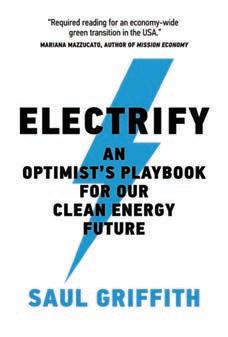

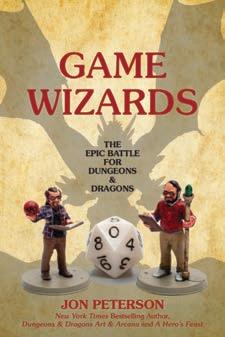



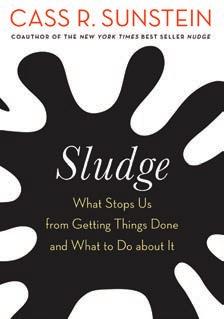
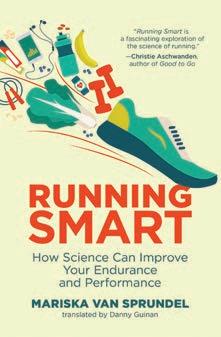

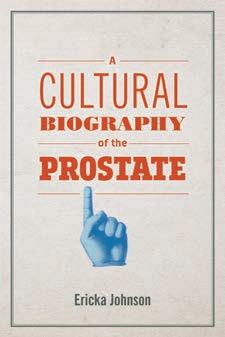
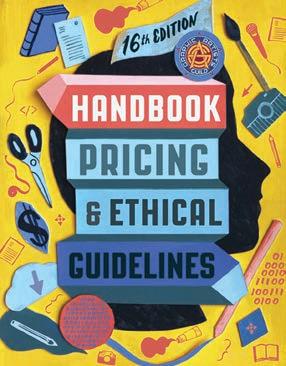
US $24.95T/$33.95 CAN cloth 978-0-262-04610-7 US $34.95T/$45.95 CAN cloth 978-0-262-04584-1 US $27.95T/$36.95 CAN paper 978-0-262-54304-0 US $39.95T/$53.95 CAN cloth 978-0-262-04624-4 US $49.95T/$65.95 CAN paper 978-0-262-54239-5 US $24.95T/$33.95 CAN cloth 978-0-262-04578-0 US $44.95T/$59.95 CAN cloth 978-0-262-04489-9 US $24.95T/$33.95 CAN cloth 978-0-262-04623-7 US $24.95T/$33.95 CAN paper 978-0-262-54244-9 US $39.95T/$53.95 CAN cloth 978-0-262-04608-4 US $24.95/33.95 CAN paper 978-0-262-54295-1 US $29.95T/$39.95 CAN cloth 978-0-262-04587-2 151 mitpress.mit.edu | Spring 2022 Recent Highlights


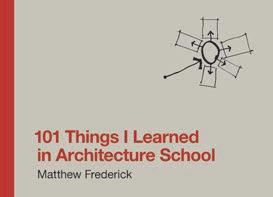
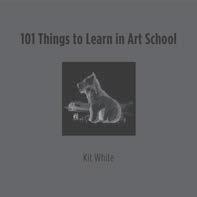



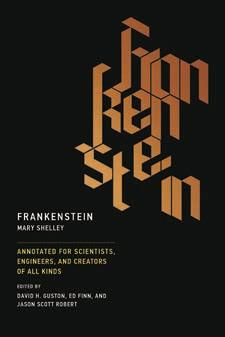



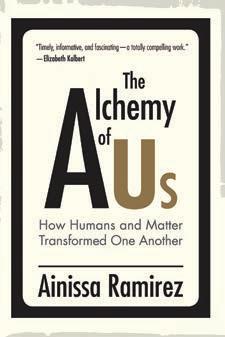
Backlist Highlights US $39.95T/$53.95 CAN cloth 978-0-262-02760-1 US $39.95T/$53.95 CAN cloth 978-0-262-03736-5 for sale in US and Canada only US $18.95T/$24.95 CAN paper 978-0-262-53994-4 US $17.95T/$23.95 CAN cloth 978-0-262-06266-4 US $17.95T $23.95 CAN cloth 978-0-262-01621-6 US $17.95T/$23.95 CAN paper 978-0-262-53964-7 US $19.95T/$25.95 CAN paper 978-0-262-53608-0 US $21.95T/$28.95 CAN paper 978-0-262-52713-2 US $29.95T/$39.95 CAN paper 978-0-262-72006-9 US $19.95T/$25.95 CAN paper 978-0-262-53328-7 US $44.95T/$59.95 CAN paper 978-0-262-01520-2 US $17.95T/$23.95 CAN paper 978-0-262-54226-5

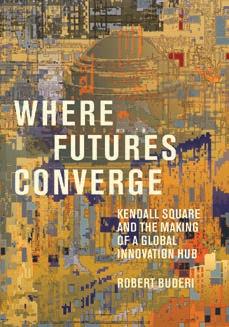
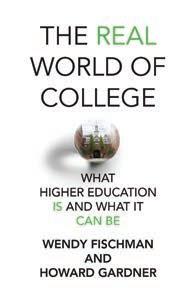
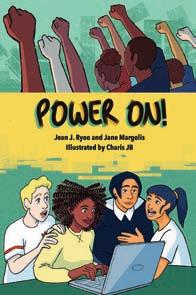
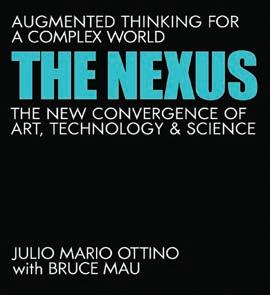
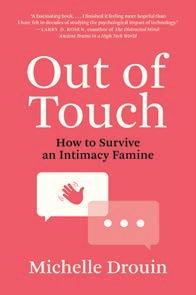


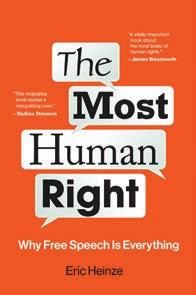

NONPROFIT ORG. US POSTAGE PAID PERMIT NO. 54518 BOSTON,
The MIT Press One Broadway, 12th Floor Cambridge MA 02142 USA
MA 02142









 with Bruce Mau
with Bruce Mau


 Eric Heinze
Eric Heinze


 J. Ryoo
J. Ryoo


























 Nate G. Hilger
Nate G. Hilger












 Paul Jepson and Cain Blythe
Paul Jepson and Cain Blythe


















































 edited by Anthony Fontenot
edited by Anthony Fontenot

 edited by Beatriz Colomina, Ignacio G. Galán, Evangelos Kotsioris, and Anna-Maria Meister
edited by Beatriz Colomina, Ignacio G. Galán, Evangelos Kotsioris, and Anna-Maria Meister


 Pier Paolo Tamburelli
Pier Paolo Tamburelli










 Christopher E. Mason
Christopher E. Mason









 Marina Umaschi Bers
Marina Umaschi Bers






















 Tom Verguts
Tom Verguts



 W. Bentley MacLeod
W. Bentley MacLeod







 edited by Jonathan Barnes and Stefanie Shattuck-Hufnagel
edited by Jonathan Barnes and Stefanie Shattuck-Hufnagel
 edited by Felipe De Brigard and Walter Sinnott-Armstrong
edited by Felipe De Brigard and Walter Sinnott-Armstrong









 edited by Amy Kapczynski
edited by Amy Kapczynski

















 translated by Helen Lane and Ronald Christ
translated by Helen Lane and Ronald Christ


 edited by Bassam El Baroni
edited by Bassam El Baroni










 introduction by Phil Baker
introduction by Phil Baker





















 Edward Gibson, editor
Edward Gibson, editor











































